HIGHLIGHTS
The Americanist Bauhaus and Photography
Interspecies Interactive Art
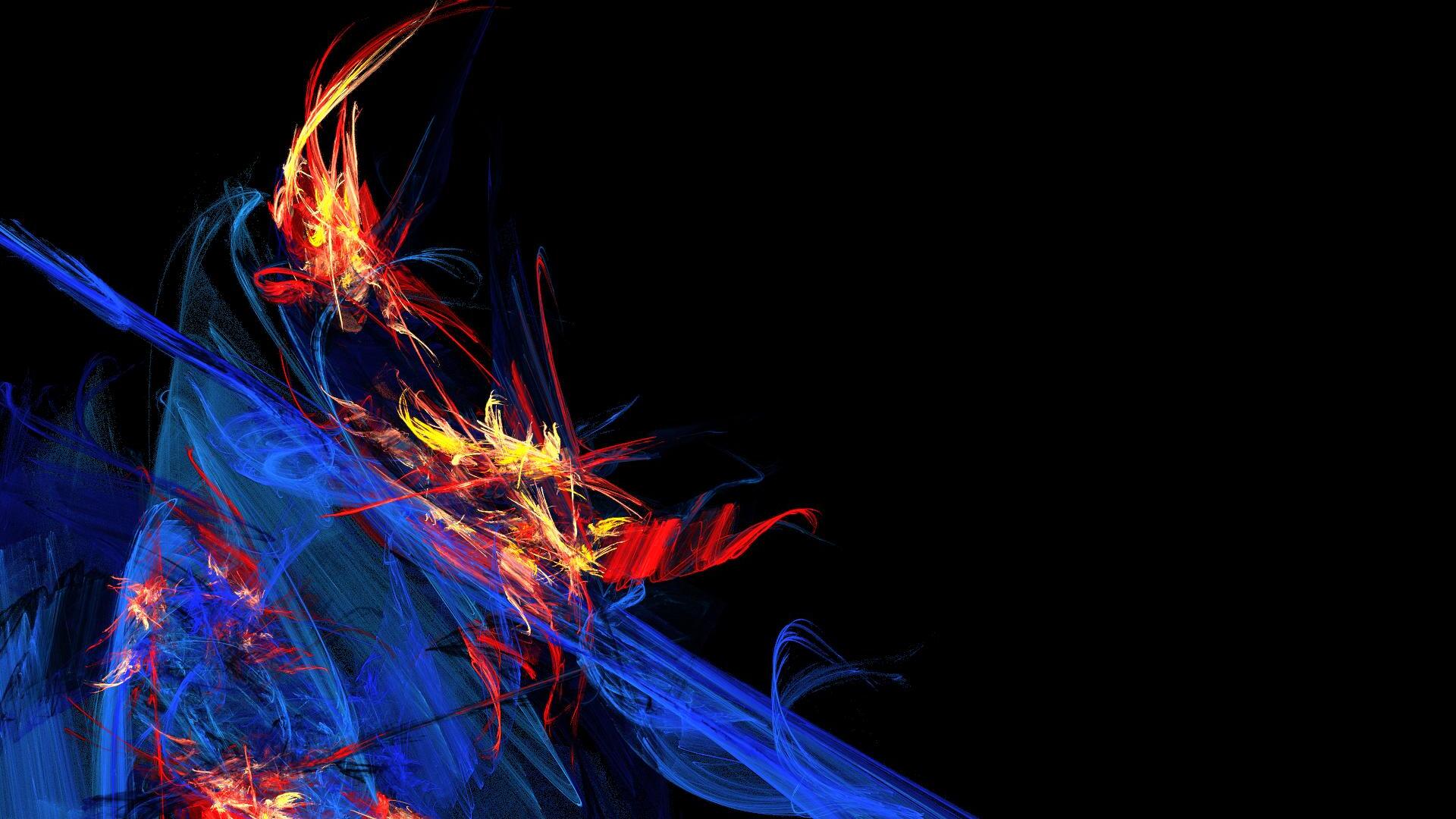
Fashion in the Museum
Cinematographic Opera
Aesthetic Judgment
Contemporary Art
Film Festivals
Visual Culture
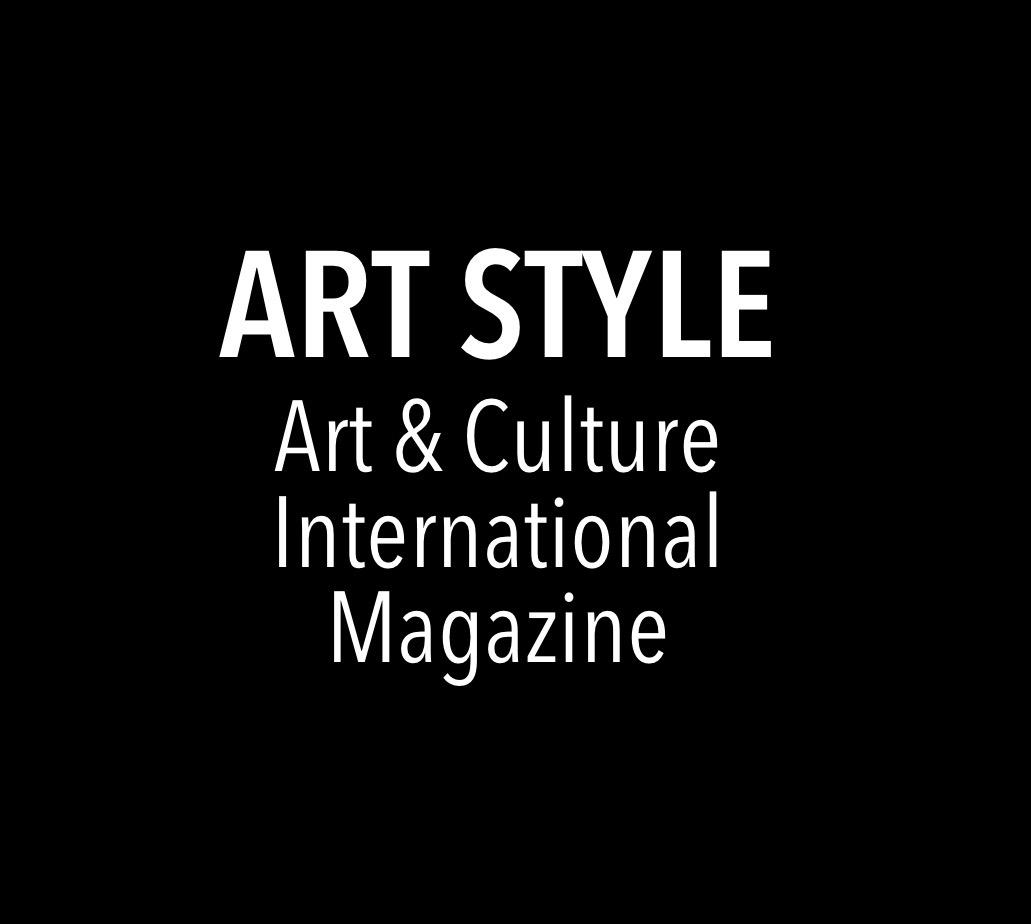
artstyle.international Volume 12 | Issue 12 | September 2023
© 2023 Art Style
Academic Editors
Design by Art Style Communication & Editions

Editor-in-Chief and Creative Director
Christiane Wagner
Senior Editor
Martina Sauer
Associate Editors
Laurence Larochelle
Katarina Andjelkovic
Natasha Marzliak
Tobias Held
Collaborators
Denise Meyer
Marjorie Lambert
Art Style | Art & Culture International Magazine editorial@artstyle.international
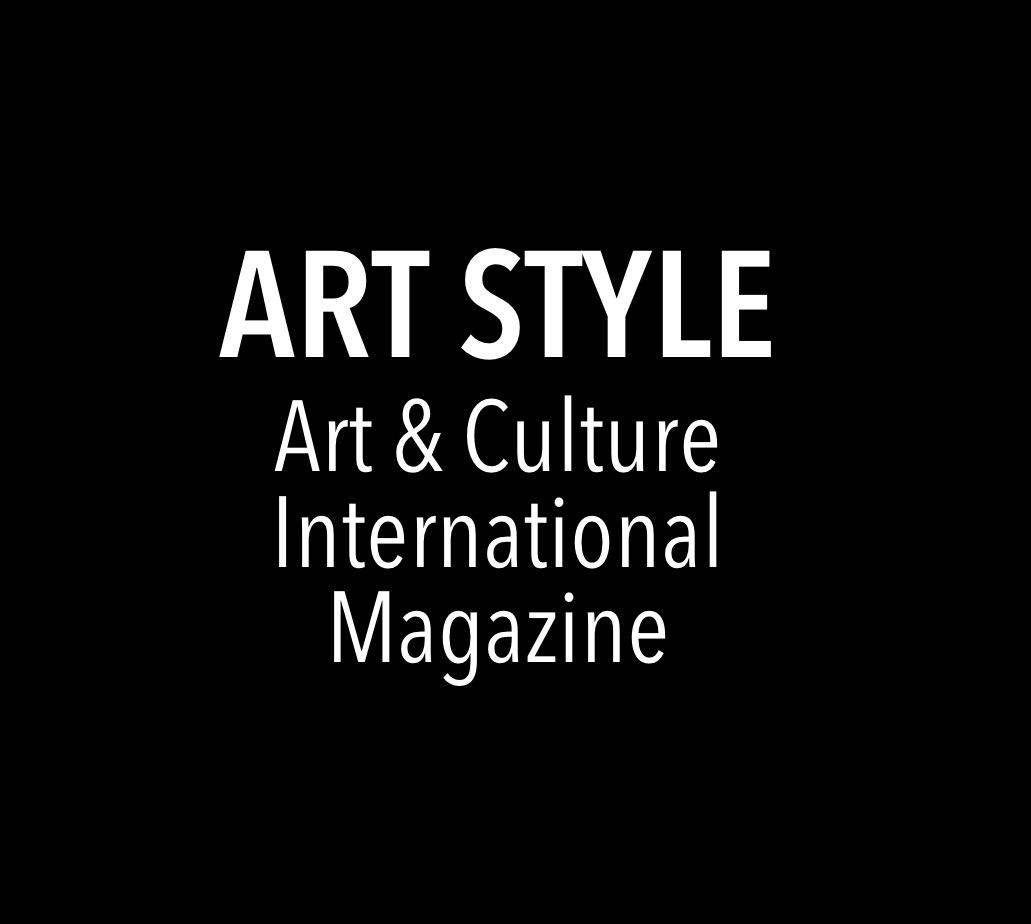
+1 347 352 8564 New York
+55 11 3230 6423 São Paulo
The magazine is a product of Art Style Communication & Editions. Founded in 1995, the Art Style Company operates worldwide in the fields of design, architecture, communication, arts, aesthetics, and culture.
ISSN 2596-1810 (online)
ISSN 2596-1802 (print)
Theodor Herzi, 49 | 05014 020 São Paulo, SP | CNPJ 00.445.976/0001-78
Christiane Wagner is the lead designer, editor, and registered journalist in charge: MTB 0073952/SP
© 1995 Art Style Communication & Editions
Art Style | Art & Culture International Magazine is an open access, biannual, and peer–reviewed online magazine that aims to bundle cultural diversity. All values of cultures are shown in their varieties of art. Beyond the importance of the medium, form, and context in which art takes its characteristics, we also consider the significance of sociocultural and market influence. Thus, there are different forms of visual expression and perception through the media and environment. The images relate to the cultural changes and their time-space significance the spirit of the time. Hence, it is not only about the image itself and its description but rather its effects on culture, in which reciprocity is involved. For example, a variety of visual narratives like movies, TV shows, videos, performances, media, digital arts, visual technologies and video game as part of the video’s story, communications design, and also, drawing, painting, photography, dance, theater, literature, sculpture, architecture and design are discussed in their visual significance as well as in synchronization with music in daily interactions. Moreover, this magazine handles images and sounds concerning the meaning in culture due to the influence of ideologies, trends, or functions for informational purposes as forms of communication beyond the significance of art and its issues related to the socio-cultural and political context. However, the significance of art and all kinds of aesthetic experiences represent a transformation for our nature as human beings. In general, questions concerning the meaning of art are frequently linked to the process of perception and imagination. This process can be understood as an aesthetic experience in art, media, and fields such as motion pictures, music, and many other creative works and events that contribute to one’s knowledge, opinions, or skills. Accordingly, examining the digital technologies, motion picture, sound recording, broadcasting industries, and its social impact, Art Style Magazine focuses on the myriad meanings of art to become aware of their effects on culture as well as their communication dynamics.

Content Editorial
Christiane Wagner Editor-in-Chief and Creative Director
Essays and Articles
The Americanist: An American Cultural Myth to Partner with the Album, The Americanist by Elizabeth
Newkirk
“Photography is Light Design:” Photographic Experimentation in bauhaus by J.
Philippe Thompson
The Possibility of Interspecies-Interactive Art: What Can Human Artists Create for Chimpanzees?
by Akihisa Iwaki
Fashion in the Museum: The Patrimonialization of the Textile Art Collection of the São Paulo Museum of Art (MASP) by
Cybelle Lima
An Aesthetics Path: From Giorgione’s Joie de Vivre to Callas’ Cinematographic Opera by Iria-Friné
Rivera Vázquez
The Aesthetic Judgment over the Boundary between Originality and Plagiarism in Korean Contemporary Art: Four Litigation Cases Related to Artistic Plagiarism by Byungkil
Choi
155 169
11 25 41 75 101 127 189
Film Festivals as Aesthetic Experiences: Theories of Affect and the Collective by Peter
Virginas
Evolution of Visual Culture by Yakup
Uzun
Scientific Committee
Editorial Board & Information

Editorial
Greetings, welcome to the latest edition of Art Style Magazine!
This edition of Art Style Magazine’s academic publication is making significant strides in meeting scholarly journal standards and improving the quality of our work. Art Style, an online magazine with a vast readership, has gained social and cultural significance among its readers due to its coverage of contemporary themes and commitment to publishing high-quality content. Consequently, we are proud to announce that Art Style is recognized in several prestigious indexes, including the Directory of Open Access Journals (DOAJ), the Web of Science Core Collection, the Emerging Sources Citation Index™ (ESCI), the European Reference Index for the Humanities and Social Sciences (ERIH PLUS), and Latindex, illustrating our dedication to maintaining excellence. The magazine’s articles are of interest to academics and individuals from various fields who desire to stay up to date with the art, culture, and socio-political concerns of the globalized world.
For this outcome, we are grateful to the professors, academics, and authors who share our dedication to providing exceptional content and knowledge, leading to outstanding accomplishments. We understand that funding agencies, research institutions, and artists in the social sciences and humanities seek to assess the value and impact of intellectual production. That is why we are fully committed to conducting thorough assessments of our publications, focusing on quality rather than metrics or impact factors.
Further, Art Style Magazine regularly offers opportunities for researchers and academics to present their work and is always happy to accept new contributors. The upcoming issues will prioritize various topics in response to numerous requests from researchers, readers, and artists worldwide. Additionally, we are open to considering special editions and guest editors, as per the guidelines outlined on our website.
At Art Style Magazine, we are dedicated to offering easily accessible online publications free of charge. In addition to this, we also provide high-definition files of each issue on our website for our readers to download, order, and print at their convenience from their preferred print shop. For Art Style Magazine, design should not only focus on the product itself but also consider the environment by conserving and reusing energy and recycling materials like paper in alignment with sustainable development principles. As responsible publishers, we strive to promote eco-friendly practices and encourage our readers to be environmentally conscious when printing their copies. We are committed to positively impacting the environment and believe small changes can make a big difference. Working together can create a more sustainable future for future generations.
Art Style | Art & Culture International Magazine 7
The Art Style has been published regularly since March 2019. Renowned researchers and professors have contributed articles, as evidenced by the previous volumes available to readers. Our commitment is publishing high-quality papers and ensuring that Art Style Magazine is well-indexed. To achieve this, we pay close attention to formal issues and maintain clarity about our publication criteria. We will also continue to adhere to the necessary protocol.
Art and culture involve a deep understanding of humanity, encompassing diverse practices and historical contexts. Each new release allows this magazine to enhance its approach to this intricate and diverse field by delving into many topics that highlight diversity. Fostering social responsibility through the arts is of paramount importance. Art Style Magazine promotes intercultural understanding by offering an insightful representation of the world’s art and cultural landscape. When it comes to art, exhibitions, and visual culture on a global scale, the narrative and history of contemporary art are shaped. That requires a combination of different areas of knowledge and methods, including inter- and transdisciplinary approaches. The complexity of the subject is heightened by the aesthetic, ethical, and political differences between Western and non-Western cultures and arts. The focus is on analyzing the diversity of contemporary cultural practices and artistic performances. An interdisciplinary approach in the humanities and social sciences should be taken to approach this subject.
The most recent release of Art Style Magazines presents an essay by Elizabeth Newkirk discussing The Americanist album. The essay offers valuable insights into the cultural achievements of North America during the interwar period. Newkirk utilizes myths to communicate philosophical perspectives and emphasizes the significance of coordination in promoting civic attitudes and cultural output. The essay explores an “American cultural myth,” delving into the emotions and contradictions of a cultural heroine and the American Dream.
We can also read “Photography is Light Design: Photographic Experimentation in bauhaus” by J. Philippe Thompson. The author emphasizes the innovative design of Bauhaus, which led to a timeless aesthetic that embodies modernism and defines the function of photography in Bauhaus publications exploring design, photography, and technological advancements that resulted in ideas and a new era known as Moholy-Nagy’s New Vision.
Akihisa Iwaki, in “The Possibility of Interspecies-Interactive Art: What Can Human Artists Create for Chimpanzees?” writes how the Kyoto City Zoo hosted interactive art exhibitions and research projects for chimpanzees in collaboration with artists and experts in science and engineering. The exhibitions, led by Kazuki Hitoosa, Ryoko Aoki, and Zon Ito, explored questions of aesthetics and emotions in nonhuman beings. The project was a first step toward a deeper understanding of aesthetics beyond the human perspective.
Art Style | Art & Culture International Magazine 8
In the context of a museum exhibition, Cybelle Lima presents her research results in “Fashion in the Museum: The Patrimonialization of the Textile Art Collection of the São Paulo Museum of Art (MASP).” The author discusses the significance of clothing and textile artistic artifacts preserved in museum collections and how they serve to showcase art and fashion culture. Specifically, Lima presents the research findings on the importance of the clothing collection at the São Paulo Museum of Art Assis Chateaubriand (MASP). The focus is on the textile artifacts on display in the museum, which play a crucial role in promoting art and fashion culture.
Another significant contribution is the paper “An Aesthetics Path: From Giorgione’s Joie de Vivre to Callas’ Cinematographic Opera” by Iria-Friné Rivera Vázquez. The author explores how aesthetics can be considered the highest form of human expression and how art can create a profound and spiritual experience. Vázquez examines artistic patronage and splendor from the Renaissance to the present day, noting the continued importance of various art forms, such as cinema and opera.
In addition to the previous articles, there is also the matter of appropriation in contemporary art globally and in Korea. Byungkil Choi explores this topic by analyzing four legal disputes related to artistic plagiarism in Korea. The author examines the legal cases within the context of modern Western art theories and concludes by making some aesthetic judgments regarding the line between originality and plagiarism.
The full complexity of aesthetic experiences and art cannot be covered here. Nevertheless, we would like to highlight Peter Virginas’s article on film festivals, known for their packed schedules of movie screenings and events that honor and connect filmmakers. These festivals create a unique atmosphere comprising various elements. The author believes that, by understanding these elements, we can better comprehend the role of film festivals and our experiences there. Virginas’s article highlights how film festivals become aesthetic environments, enabling shared and meaningful aesthetic experiences.
Completing another issue of Art Style Magazine is Yakup Uzun’s exploration of visual culture. The author explores how art, film, and television affect culture and are influenced by it. The article employs ideas from various disciplines to examine how images, media, and cultural narratives impact our perceptions. Uzun describes the complex connections between representation, power, and identity by analyzing how visual media shape our identities and promote social and political change.
That is all for the moment I hope this publication will be valuable to your research and spark your intellectual curiosity. Enjoy your reading!
Christiane Wagner Editor-in-Chief and Creative Director
Art Style | Art & Culture International Magazine 9
The Americanist An American Cultural Myth to Partner with the Album, The Americanist
Elizabeth Newkirk
Abstract
The Americanist is a musical album and essay. Set in the interwar period, the album features orchestral works arranged for solo piano by George Gershwin, William Grant Still, and Maurice Ravel. The partnering essay places the composers within a larger context of American cultural aims and production. More importantly, it credits the cultural brilliance of the age, as well as the success of a globally recognized American sound, to the guidance and inspiration of the philosophies of the transcendentalist and New Negro movements. Confirming this achievement was the positive reception from the American public, in which this ‘American accent’ was widely accepted as a sonic representation of a shared American identity. The works of Gershwin and Grant Still utilize a range of popular idioms which serve to express a personal and authentic sentiment within a general expression of Am erican optimism and character. Yet, the European acknowledgment and utilization of this contribution were equally important. Ravel provides this affirmation both through his tour of the United States in 1928, as well as with a quasi-American compositional style that he employed following La Valse. Crucial to this development was the cultivation of local inspiration as it was assimilated into a global expression. Among many of the tools that could illuminate philosophical insight, I called forth the myth to articulate this story. The implicit inquiries within this narrative showcase the necessity of the myth; how vital philosophical coordination is for virtuous civic attitudes; and the startling differences in cultural production when that philosophical coordination is present versus when it is not. In the essay, I compose an “American cultural myth,” capturing the sentiments and dualities of an American cultural heroine, as she stands alongside the sole American myth, the American Dream.
Art Style | Art & Culture International Magazine 11
Preface
One might fancy a story to accompany an album of music from the interwar period. With a title like the Americanist, one would presume the story to be American in accent, topic, and scope. And indeed it is. The story I wish to tell is neither historical nor fictional. It lies between, in the mythical. To the modern ear, “myth” can ring of falsity, fabrication, or simply a lie. But here I am calling forth the classical myth. The legend. It is the story told from a bird ! s-eye view, not an impression from high above the clouds nor a laborious account from the ground. The sway of the myth is its ability to transcend our sins and errors while enlarging the promise of our deeds and character. At a bird ! s-eye view, it lifts our gaze above the woes of daily toil, sowing the seeds of our highest aspirations as articulated by our most talented members of lettered and artistic genius.
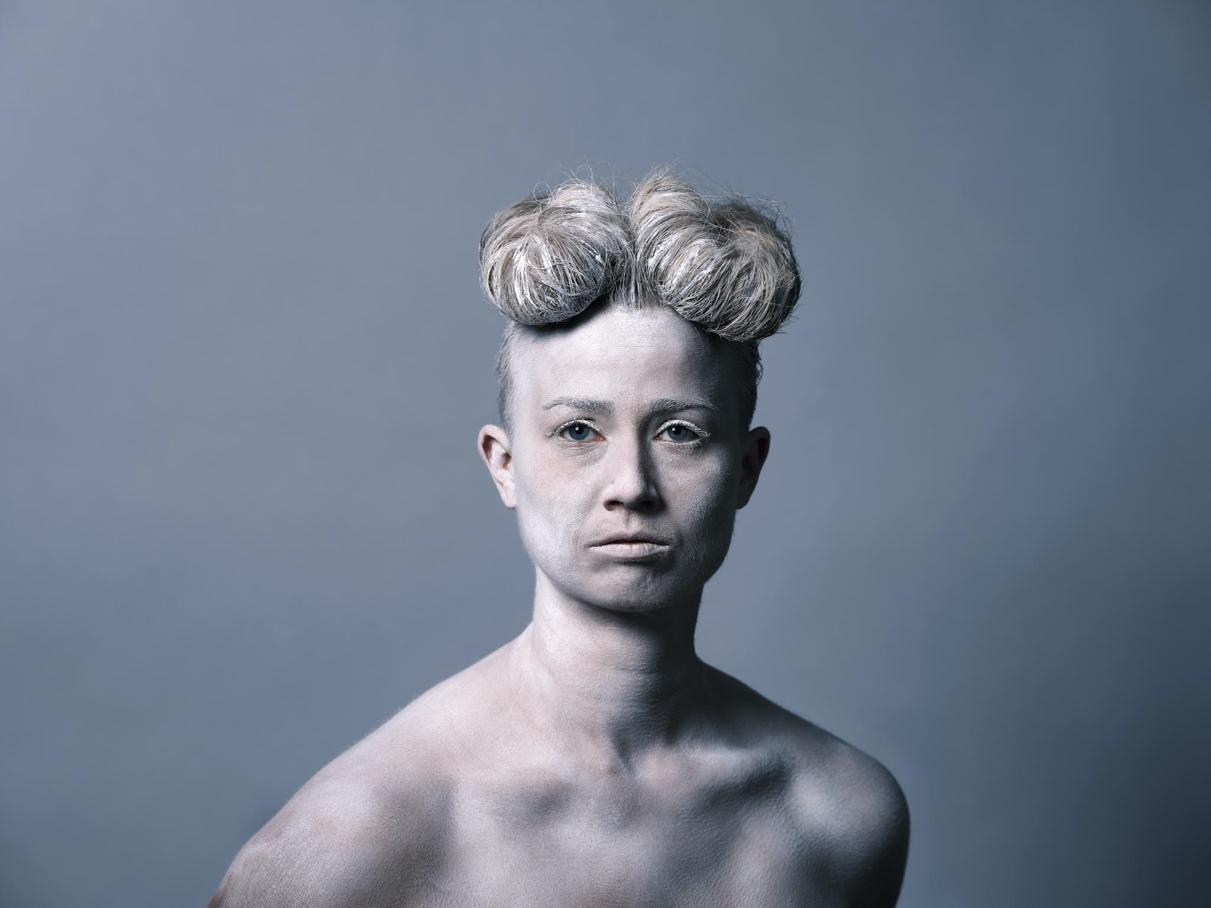
Art Style | Art & Culture International Magazine 12
My preoccupation with myth is the philosophical function it serves. If effectively implemented, it allows for an appropriate caucus of academic research and detailed critical thought. If thoroughly circulated, it harnesses the wild creativity and energy of the masses to lasting channels of progress and expression. Without this invisible hand, communication between the realms of the learned and the populace is frustrated, often carelessly misconstrued. Stunted and idled, the efforts of both become highly susceptible to commercial manipulation, expended on fleeting goals and short -sighted ends. If equipped with an emblematic philosophy, myth articulates our fundamental ethos in such a way that it is useful, stirring, and a source of pride for all. The philosophical layer of this conceptual cake is far more important than often acknowledged. It binds our various social groups, clarifying function and range of responsibility, so that the ends may be achieved to our expectation and fulfillment. The trouble we encounter when our efforts are confused or conflated deconstructed, even is that our cake is no longer a cake. And the more time that passes, we begin to forget the recipe, leaving us without dessert altogether.
The American Myth
The American myth is one you surely know. It is the American dream. Whether personified in Uncle Sam and Rosie the Riveter or narrated through stories like Homeless to Harvard and collections of immigrant stories, the underlying theme celebrates individual drive, the reward of effort and frugality, and a selfdetermination aimed at the stars. These stories are all in large part true, but with the fine details of reality left to the footnotes, if mentioned at all. The goal of this myth is to inspire, to elevate, and to enlist an attitude that fulfills our civic credo, one that you, dear reader, probably display much more outwardly than you know.
The American dream is political in nature and historical in tone. It is no doubt vital to a country that is pluralistic and bears no mark of homogeneous expression. The credo of the American rests in the action, freedom, and dignity of the individual. And while the execution of these ideals has required an ever-evolving process, they nonetheless stand as the significant characteristics of the American personality. For a country as large and as diverse as the United States, the unsurpassed levels of creativity, innovation, and productivity of our citizenry speak to its coordinating power. Its historical tone attempts to circulate these values as our shared heritage; thus the native-born citizen or the newly arrived immigrant are united in this common ground of motivation and spirit.
Art Style | Art & Culture International Magazine 13
The shortcomings of the American myth are not in its historical gloss-over, or even in its often-inherent conflict with everyday lived experience. The deficiency lies in that it is our only myth. In cold, sterile terms, the American dream can be drearily reduced to economic gain, middle-class status, or material comfort. The human, even the American, requires more. Typically, a community will draw additional inspiration from its culture, historically directed by religion or close-knit traditions. The pluralism of the United States provides a wealth of cultural input, yet its scope has made traditional leadership, religious or otherwise, an unfit steward of national culture. The most promising examples of cultural leadership can be found among our philosophers.
Two major American philosophical movements have profoundly encapsulated American identity, while generating a highly cohesive and productive outpouring of American cultural expression: the transcendentalist and New Negro movements. As they sketched the blueprint for an American cultural philosophy, they generously provided more than enough capital for a compelling cultural myth to exist alongside the American dream. Thus I present my telling of an American cultural myth: an ongoing journey of growth and duality.
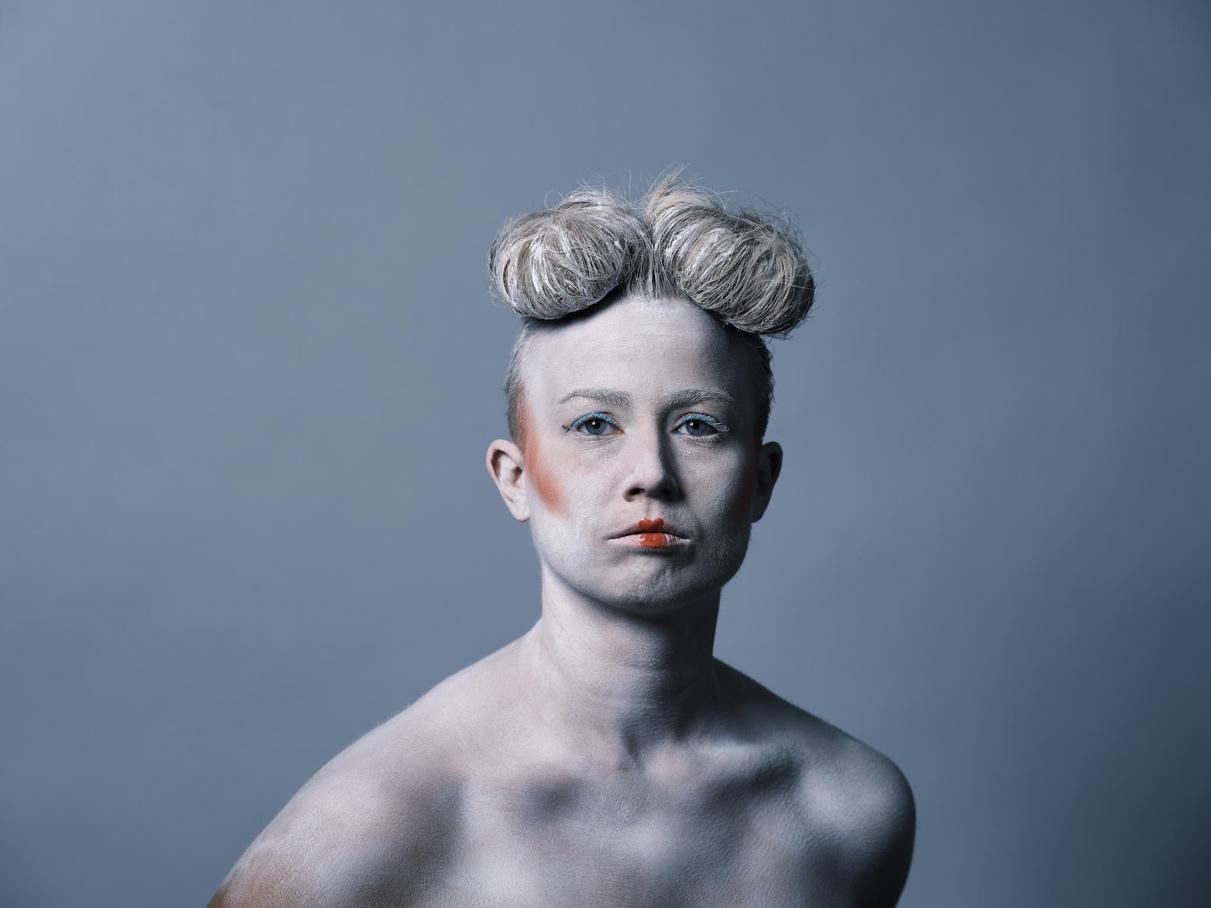
Art Style | Art & Culture International Magazine 14
An American Cultural Myth
We begin, in true American style, with the individual. This individual rugged and self-reliant first receives her legs from the transcendentalists of the nineteenth century: Walt Whitman, Ralph Waldo Emerson, Henry David Thoreau, Margaret Fuller, Nathanial Hawthorne, and Henry Wadsworth Longfellow. Within her, the dueling forces of nature and machine, spirituality and civic duty, internal genius and external inspiration, demand her persistent contemplation. Only in the solitude of nature can she do this, working with her hands and communing with raw resources, for the distraction of the city, the noise of the machine, and the monotony of tireless toil threaten her spiritual cultivation and artistic genius. Her poetry, stories, and speeches air dignity to the raw individual, relegating all external influence to the shelf for sparing use. To serve her family and community, she must better herself. Education in letters as well as in nature provide the grounds for her self-realization, where her creativity and originality rest, awaiting release.
Her self-reliance finds communal expression in the civic institutions she supports and the schools she establishes. To educate her fellow citizen is her moral duty. Founded in her time are public schools, universities, orchestras, opera houses, publishing houses, museums, journals, newspapers, and public parks. New England in tone and perhaps Victorian in manner, her poetry and literature promulgate a prideful American ethos, one of independence and novelty. And yet her sister arts music and visual art lag behind, imitative of styles and trends from across the sea.
As the twentieth century dawns, our gal’s vision grows considerably in scope, both local in flavor and cosmopolitan in appeal. Her poetry gives voice to the unheard cries of her community; her music expresses the depths of her soul as she dances freely to the beat of the city. The philosophers and artists of the New Negro movement Alain Locke, W. E. B. Du Bois, Langston Hughes, Zora Neale Hurston, James Weldon Johnson, and Claude McKay guide her in the modern duality between rural and urban, local and global, popular and serious. The technology brought by the machine age blurs distinctions, as inspiration becomes too enigmatic to be located, limited, or restricted. Pluralism in theory finds expression in reality from migration waves within and immigration ripples abroad.
The cultural scene bursts with energy, as opposites discover similarities and productivity soars from collaboration. The contradictions behind the scenes or perhaps center stage deter the momentum very little. Tin Pan Alley, Broadway, Hollywood, dime novels, the phonograph, and the radio all infuse the atmosphere with raucous rhythm and Rabelaisian racket. Yet all circle around the phenomenon of jazz. Rooted in the Afro-American spiritual and drawing shape and form from the blues, jazz constructs an American accent that becomes universally accepted, cherished, and symbolic. She plays jazz. She speaks jazz. She is jazz.
Art Style | Art & Culture International Magazine 15
Our leading lady takes pride in her roots while considering ideas that transcend her own identity and time. The cultural continuum she sees is both revolutionary and fleeting, as the commercial roller coaster lifts and drops without warning. She is very critical, as are her colleagues, for the cultivation of American artistic genius is not furthered by ego. The fertile landscape across the arts engages in dynamic criticism that encourages steadfast progress while also sometimes stunting early stages of promise. Niche specialization amid mass popularity, group identity against national citizenship, and civic aspirations versus the lived experience become even more powerful dichotomies as our dame lives on through the twentieth century.
The philosophical achievements of the New Negro movement continued to find expression in later generations of writers, poets, musicians, and activists. Yet the cohesion and dynamic collaboration of the New Negro movement remains an anomaly. Our American femme, for the remainder of the twentieth century and to this day in the twenty-first, has had ample opportunity to specialize, to obsess, to react. Her focus and complete attention fully enter into the rigid bounds of the group, discipline, or cause. There have been numerous movements social, artistic, environmental, and political. Singular in focus and specialized in form, they have lacked the interconnectedness needed for a larger, longer-lasting vision. While each movement may have enlisted the talents and energies of the artist, sociologist, philosopher, activist, or public, the absence of philosophical coordination and direction is broadly felt. As our nineteenth- and twentiethcentury cultural forefathers warned: distraction is a menace; technology can destroy as much as it creates; and above all, good faith in the individual, and from the individual toward the group, is fundamental. An American cultural philosophy would be accumulative, perpetually hungry for the talents and perspectives of our best. An effective cultural intelligentsia must collectively understand our historical and philosophical foundations while championing critical dialogue with one another. Required of each member is an authentic bond to the ground, rigorous study and discipline, and most importantly, a direct connection to cultural expression. Our cultural myth awaits a twenty-first-century telling in order to lift our heroine out of the daily muck and inspire her to achieve beyond her time.
Art Style | Art & Culture International Magazine 16
Postscript

A few words in regard to American music specifically. The descriptors “popular” and “serious” imply no inherent value but rather reference origin, preparation, and the formality of the circumstances under which they are experienced. Popular music can be referred to in many ways, “folk” music or “simple tunes” for instance. The fundamental distinction worth consideration is that popular songs have long been able to circulate without prior requirements of literacy. Serious music, as it was commonly called in the early twentieth century, is synonymous with “classical” music or “art” music. It implies a prerequisite of technical and cognitive abilities to perform and interpret such compositions. There has been a considerable lag to which cultural, philosophical, and social developments find expression in serious music. The stunning achievement of the interwar period is the remarkable exchange and reciprocity between the serious and the popular.
The transcendentalist philosophy was only incidentally expressed in the compositions of the Second New England School. The “Boston Six” Edward MacDowell, Amy Beach, Arthur Foote, George Chadwick, Horatio Parker, and John Knowles Paine marked the very beginning of American classical music. Their styles were in complete alignment with German Romanticism, not only in order to prove their mastery of such technique and form, but also in accord with their education abroad. As the desire grew to compose in an independently
Art Style | Art & Culture International Magazine 17
American idiom, defining the requirements of such an idiom would prove to be awkward and ridden with contradictions. While there are hints of folk inspiration, much of the provincial attitudes toward folk sources limited their scope and perspective. Furthermore, popular music at that time was subservient to other mediums like variety shows, vaudeville, and rather crude entertainments. The boundary to separate serious music from the questionable character of popular music was resolute and intentional. The result, perhaps unintentional, left American composers and their compositions in a neglected interim. Their compositions were not adopted as a na tional expression by their American audience, and conductors and orchestras, who heavily prioritized the European canon, would only on occasion feature American works.
In many ways, the New Negro movement streamlined the process laid out by the transcendentalists, yet with a much more modern and forward-thinking philosophy that captured the attention of a wider net of artists and enlisted productivity at every level of the spectrum. They invited an authentic and positive discovery of the self, a pride for one ! s past, and an empowerment to develop that inspiration into sophisticated, criticizable art. It is important to acknowledge the magnitude of cultural content within this very short time. The range is indeed of the utmost importance, and, unfortunately, is the point most often discounted.
The leaders of the movement viewed this spectrum as completely essential to progress, not only for the art forms themselves but for palpable forms of expression for the entire American public. That is why their praise and criticism included the works of Bessie Smith, Langston Hughes, Louis Armstrong, Duke Ellington, Marian Anderson, and William Grant Still; Paul Whiteman, George Gershwin, Carl Van Vechten, Bix Beiderbecke, Benny Goodman, Aaron Copland, and Leopold Stokowski. Despite the often-immovable barricades insulating serious music cliques, the inspiration, energy, and insatiable demand from the public generated from this outpouring of music was too sizable to ignore. European composers and listeners alike were just as captivated. It was an opportunity of unprecedented potential for the American scene to express its distinct character and accent, while showcasing its immense creativity, technical brilliance, and capacity to uniquely contribute to the broader canon.
The Second World War and the subsequent Cold War brought an incredibly dispiriting rift between the popular and serious. Not only did collaboration halt, serious music turned discriminately inward so as to thwart any inhibition toward public pleasure or popularity. The intellectual pursuit for originality, new forms and structures, and an almost sterile rigor of discipline, ironically, imposed an unwavering conformity among composers. And yet, time moved on. Serious music ! s abandonment of the American public has resulted in our national cultural expression to primarily habituate within popular music and entertainment. Despite the incredible diversity and brilliance of popular music, without the thoughtful and
Art Style | Art & Culture International Magazine 18
slower undercurrent of the serious, commercial interests step in to dictate its trajectory and success. An ideal cultural ecosystem would encourage the youthful zeal and dynamic energy of popular music while balancing it with the complexity and reflection of serious music. Inspiration being circular, it starts with fresh ideas and natural expression while rounding to full maturity with the wisdom of age and more nuanced emotional understanding. Separated, popular music risks superficiality and perpetual youth, as the egoism of serious music becomes deadly insular and academic. Artists, of all genres, are not in short supply; the need is for the next group of philosophers who can guide, inspire, and direct our cultural outpouring to emotionally nurture the American public.
A final remark connecting the music from the Americanist to our cultural myth. In my view, the interwar works on the album illustrate this history as they realize the ethos articulated by the New Negro movement. The three works distinctively locate the three composers within or adjacent to the movement. The composers and their works were undoubtedly aware of each other, exploitive of each other, and, while expressing similarity in style and aim, continued onward toward independent developments. This interwar period, a meeting of the minds, simply showcases the beauty of pluralism and the potential of collaboration.
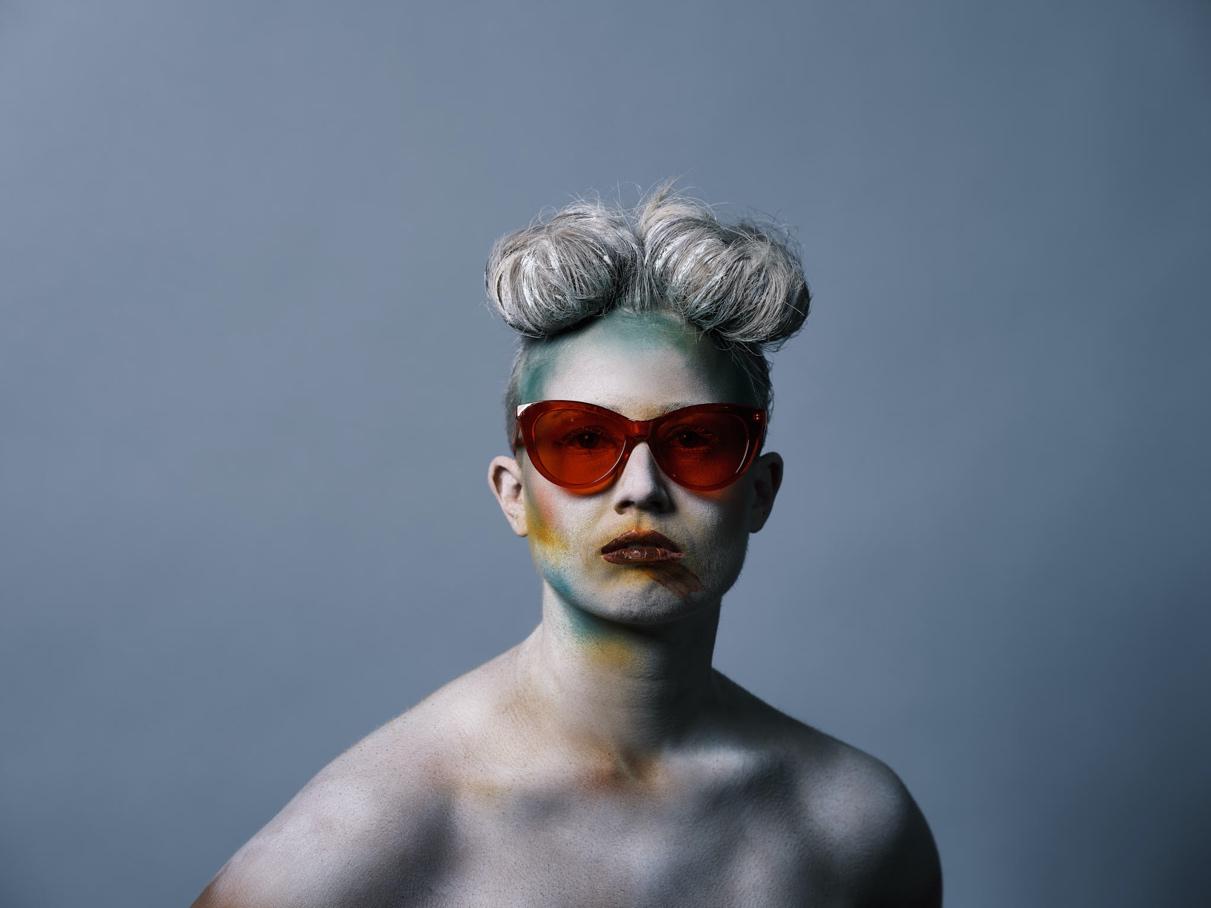
Art Style | Art & Culture International Magazine 19
Maurice Ravel, La Valse (1920)
Maurice Ravel, noted Frenchman and impressionist, creates in La Valse a fantastical soundscape of the Viennese waltz. This whirlwind of nostalgia and sentiment twirls with modern energy and vigor. As many have connected the imagery in La Valse to Ravel! s noted affinity with Edgar Allan Poe, his subsequent compositions parti cularly engage with American musical idioms. There is his Sonata for Violin and Piano, for which he composed a blues-inspired second movement; his opera, L’Enfant et les sortilèges (The Child and the Spells), in which he structurally organizes the work like an American musical comedy; and lastly, his Piano Concerto in G, with strong nods to the harmonic writing and orchestration of George Gershwin. Ravel visited the United States in 1928. He toured the country giving concerts, premieres, and lectures. Among his sentiments were most notably his enthusiasm for the blues and jazz, along with his advisements for his American colleagues to embrace this highly original American resource.
George Gershwin, An American in Paris (1928)
Boy wonder George Gershwin was undoubtedly the most commercially successful and socially ambitious American composer of his time. Getting his start as a song plugger for Tin Pan Alley, his songs are the essence of his style: stereotypically New York, an effortless buffet of ethnic inspiration, and characteristically optimistic, charming, and confident. His commercial success and lasting popularity can easily convolute the multiple groups in which he was neither apart from nor wholeheartedly accepted by. Forging a space between the popular and the serious, he was often resented by both. An American in Paris is a touristy tale in which Gershwin rhythmically determines nationality by the meter of one ! s gait. Referencing his trip to Europe in 1926, he assigns the walking patterns of the New Yorker, Londoner, and Parisian to time signatures of four-four, six-eight, and twofour respectively. A whimsical sound poem, the work is cosmopolitan in flavor, while its American references are personal, effective, and widespread. The premature death of George Gershwin has left his style and vast achievements (both musical and commercial) in a continual purgatory. The attempt to create a fluid interstate between the serious and the popular has been considerably discouraged by both external and internal forces. Despite his various “firsts,” many of his initiatives remain undeveloped and abandoned, a sizable void to this day.
Art Style | Art & Culture International Magazine 20
William Grant Still, Africa (1930)
The dean of Afro -American music, William Grant Still was a member of the New Negro intelligentsia. He, too, built a career that balanced the serious and the popular, less with a motive for fusion and more out of practical necessity. Working on the commercial side as an arranger, orchestrator, band member, and film scorer, he also studied under the modernist Edgard Varèse, worked with conductors Leopold Stokowski and Howard Hanson, was the recipient of multiple Guggenheim fellowships, and composed a prolific body of work. Africa, similar to the works above, is a collection of memories and presents another opportunity to travel by sound. In line with the sentiment of the New Negro movement, Africa sought to express a pride, an homage to Still! s ancestral past while asserting his voice to be confidently and unquestionably American. In form and in content, Africa effortlessly encompasses soulful moments of the spiritual, the electricity of modern dance, poetic narratives, and rhythmic punctuations that describe a time and a place. Africa, along with the “Afro-American” Symphony and the ballet Sahdji, mark his “racial” period in which he compellingly achieves the philosophy of the intelligentsia: local in inspiration, universal in expression. Like his colleagues, Still engaged in active criticism, publishing essays, critiques, and commentary on the progression of the movement as well as the overall development of the American composer.
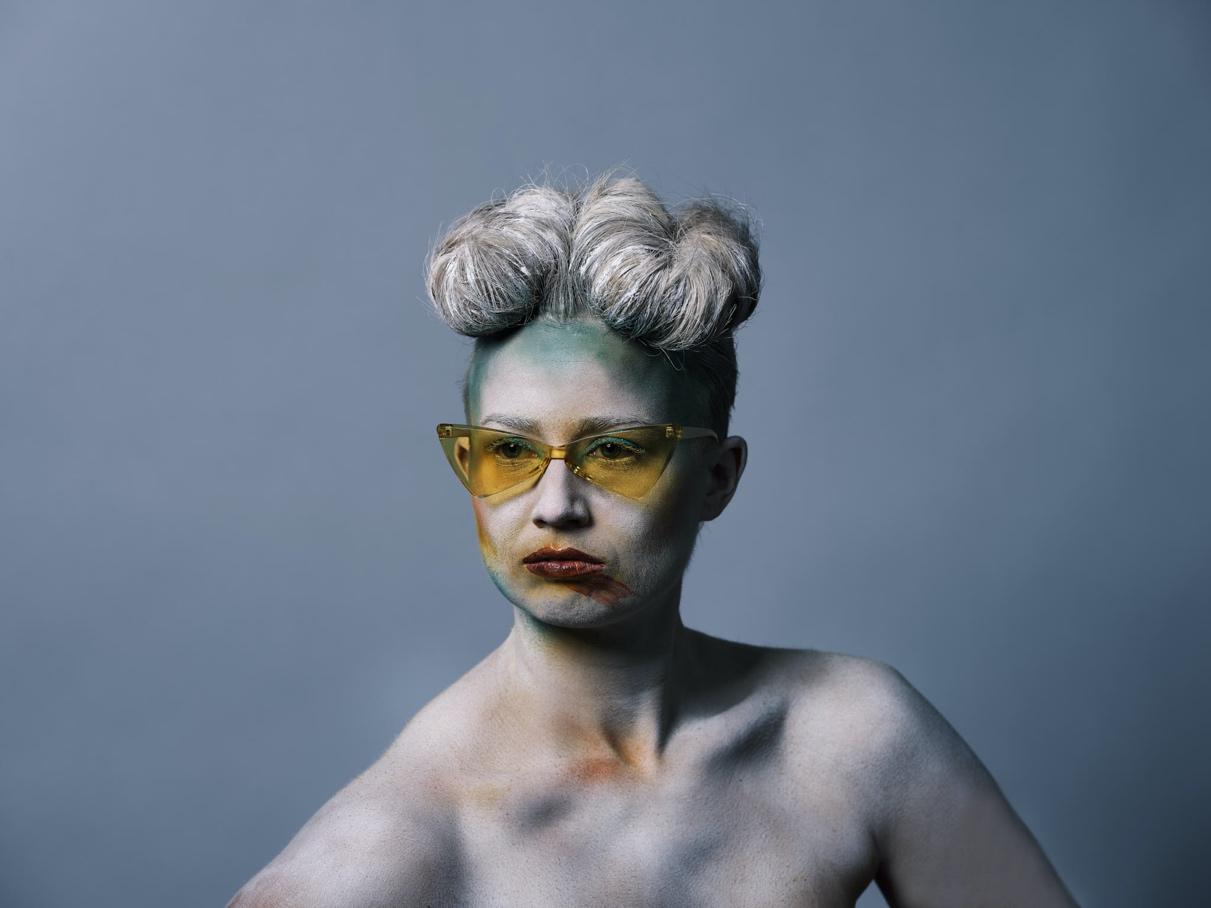
Art Style | Art & Culture International Magazine 21
Author Biography
Elizabeth Newkirk is an American classical pianist and writer. She specializes in music of the early 20th century as exemplified in her debut release, the Americanist Her research and essays focus on American culture, mannerisms, and archetypes. With a passion for history and philosophy, a central narrative can be found underlying her musical and written work. Educated in Chicago, Newkirk! s training included a wide array of experiences that have shaped her career. She completed her Master’s degree under Bartók aficionado Ludmila Lazar at Roosevelt University, while working with opera coach Scott Gilmore and soprano Judith Haddon with the Chicago Opera Theatre. She trained with long-time keyboardist for the Chicago Symphony Orchestra, Mary Sauer, as an associate pianist for the Civic Orchestra. Last but not least, she studied jazz with Dennis Luxion while working primarily with pianist/composer Sebastian Huydts at Columbia College. Upcoming presentations, recordings, and essays can be found at www.elizabethnewkirk.com
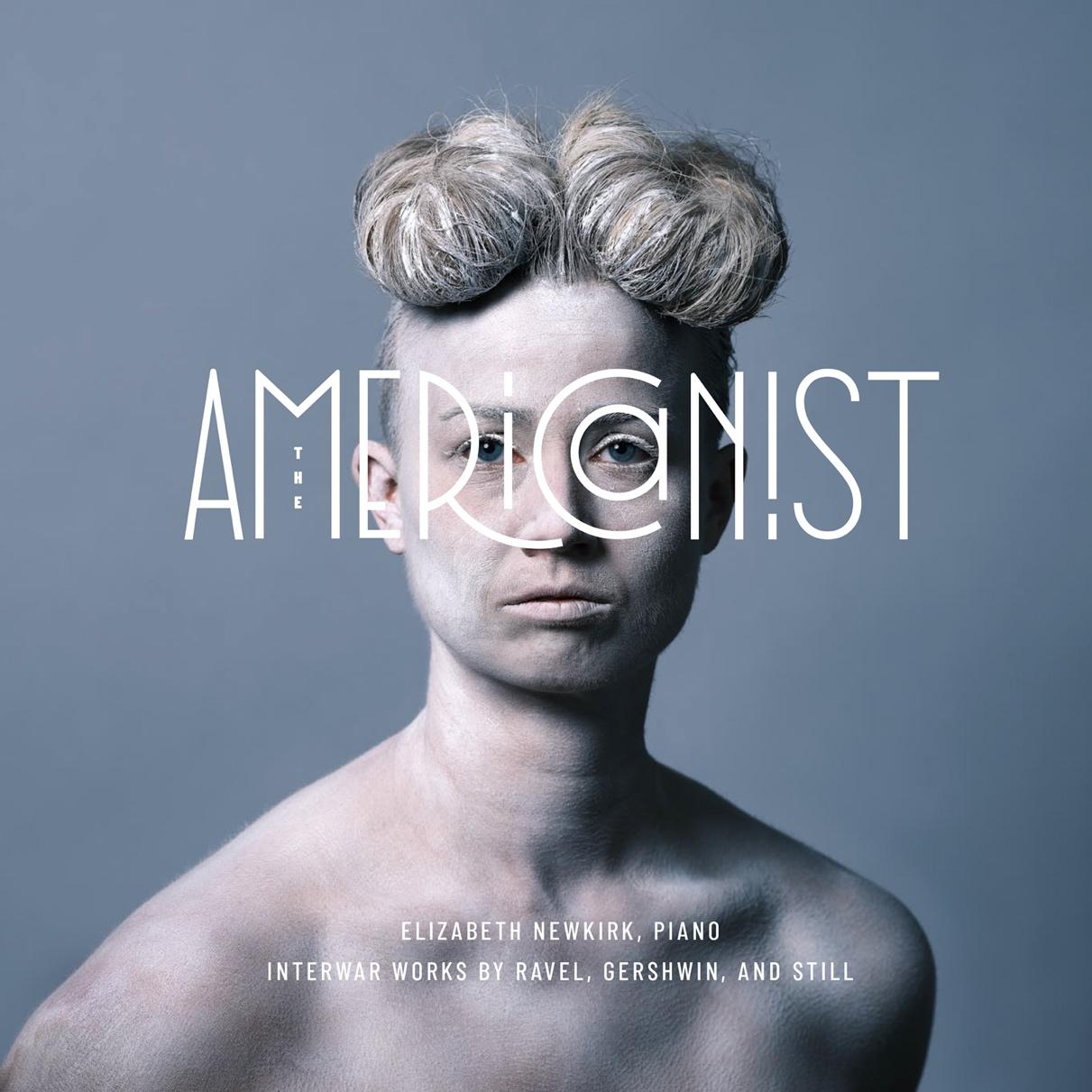
Art Style | Art & Culture International Magazine 22
“Photography is Light Design” Photographic Experimentation in bauhaus
J. Philippe Thompson
Abstract
In the early years of bauhaus’s publication life (Bauhaus Journal of Design), namely from 1926 to 1928, as Walter Gropius, László Moholy-Nagy, and many other contributors left the Bauhaus State School in 1928 to explore other opportunities as they came under increased scrutiny and fiscal undermining as theNazi party took root in postwar Deutschland, the bauhaus’s conscious disregard of publishing guidelines and even German grammar rules, in addition to its bold design, created a lasting aesthetic, in the face of opposition, that signifies modernity at Gropius’s intersection of the artist and craftsman, where the “artist is an exalted craftsman.” The content and form of bauhaus anticipated today’s filmic and photocentric society a society where, as László Moholy-Nagy predicted, “the illiterate of the future will not be one who cannot write but who does not know photography.” While there are a number of little magazines that make compelling use of photographs, like Le Corbusier’s L’Esprit Nouveau or even Duchamp and Man Ray’s New York Dada, this article concentrates critical considerations to the bauhaus to answer the following: How do the changes to the technology of photography alter what a magazine can do? And specifically, how is bauhaus an object of experimentation? Dubbed the “New Vision” by Moholy-Nagy, aspects of the new aesthetic began to be featured in magazines, camera annuals, and exhibitions. Moholy-Nagy argued that “new discoveries could not be confined to the mentality of bygone periods” because such an approach arrests all productive activity, a hundred-year arrest that yielded little results except in the science and journalism where photography proved significant, but unconcerned with whether it was called art or not. Moholy-Nagy’s thoughts on photography represent a new era of photography and help define photography’s function in little magazines.
Art Style | Art & Culture International Magazine 25
Introduction
Why should not the camera throw off the shackles of contemporary representations? Why…need we go on making commonplace little exposures that may be sorted into groups of landscapes, portraits, and figure studies? Think of the joy of doing something which it would be impossible to classify, or to tell which was the top and which was the bottom...I do not think we have begun even to realize the possibilities of the camera. (Alvin Langdon Coburn, Photographer)1
Within the landscape of modernist little magazines, bauhaus zeitschrift für gestaltung (Bauhaus Journal of Design), the magazine of das Staatliches Bauhaus (the Bauhaus School) which ran from 1926 to 1931, functioned as the mouthpiece for, as Bauhaus founder and magazine co-editor Walter Gropius stated, the school’s creation of “the new structure of the future, which will embrace architecture and sculpture and painting in one unity.”2 Bauhaus reflected Gropius’s ideas on the union of art and technology vis-à-vis a utopian craft guild that combined architecture, sculpture, painting, and photography into a single creative expression or Gesamtkunstwerk. Bauhaus, whose emergence immediately followed the Great War amidst the gestation of twentieth-century consumer culture, pursued a minimalist efficiency in terms of graphic design and typography, care of Herbert Bayer and Joost Schmidt, with the experimental photography and layout of co-editor László Moholy-Nagy juxtaposed against architectural drawings and furniture designs of Marcel Breuer and Georg Muche, so too the abstract art of Wassily Kandinsky and Paul Klee, and the theatre/dance of Oskar Schlemmer. In fact, the coverage of Schlemmer’s costume parties and theatre productions from the pages of bauhaus (Bauhaus Journal of Design) offers a unique presentation of bauhaus style captured in a series of frames as a mixture of technology, pantomime, and dance on stage, as well as the silent screen with the in-magazine comparisons of man in a mechanized environment with the iconic Fritz Lang science-fiction film Metropolis (1927) Within the alternative formatting of bauhaus, we also find the overlapping of visual content with tactile texture in the presentation of material related to applied arts like the metalworking of Johannes Itten, Gunta Stölzl’s textiles and weaving, and even cabinetmaking under Marcel Breuer
Discussion of the aforementioned individuals will focus our considerations of bauhaus to the early years of its publication life, namely 1926 to 1928, as Gropius, Moholy-Nagy, and many other contributors left the Bauhaus State School in 1928 to explore other opportunities as they came under increased scrutiny and fiscal undermining as the Nazi party took root in postwar Deutschland. Yet, bauhaus’s conscious disregard of publishing guidelines and even German grammar rules, in addition to its bold design, created a lasting aesthetic, in the face of opposition, that signifies modernity at Gropius’s intersection of the artist and craftsman, where
Art Style | Art & Culture International Magazine 26
the “artist is an exalted craftsman.” The content and form of bauhaus anticipated today’s filmic and photocentric society a society where, as László Moholy-Nagy predicted, “the illiterate of the future will not be one who cannot write but who does not know photography.” While there are a number of little magazines that make compelling use of photographs, like Le Corbusier’s L’Esprit Nouveau or even Duchamp and Man Ray’s New York Dada, we will limit our critical considerations to the bauhaus to answer the following: How do the changes to the technology of photography alter what a magazine can do? And specifically, how is bauhaus an object of experimentation?
In the years after World War I, photography broke free from exhausted traditions and centered on Pictorialism, sentimental genre imagery, or picturesque landscape photography that held mass appeal.3 In artistic photography, Pictorialism remained a mainstay of the salons and camera annuals into the late 1920s, but more and more photographers were discovering new and exciting viewpoints related to the experimentation with optical vision. Dubbed the “New Vision” by Moholy-Nagy, aspects of the new aesthetic began to be featured in magazines, camera annuals, and exhibitions. 4 In his book Vision in Motion, László Moholy-Nagy states that photography is “a new medium of expression” and that “since working rules have not been frozen into unalterable dogmas,” photography has “experimental potentialities ”5 Moholy-Nagy further explains that in the official history of art, “photography was for a long time considered only a mechanical means of recording” and that being mechanical, photography “could not produce art” as any “interpretation that tried to elevate photography to art was framed through esthetic-philosophic concepts customary in the definition of painting ”6 Moholy-Nagy argued that “new discoveries could not be confined to the mentality of bygone periods” because such an approach arrests all productive activity, a hundred-year arrest that yielded little results except in the science and journalism where photography proved significant, but unconcerned with whether it was called art or not.7 Moholy-Nagy’s thoughts on photography represent a new era of photography and help define photography’s function in little magazines.
In her chapter “The Haptics of Optics: Weaving and Photography,” T’ai Smith explains that the cultural landscape of popular illustrated magazines fostered a saturation of photographs in the pages of the bauhaus’s own mouthpiece, the bauhaus zeitschrift für gestaltung, which featured a special issue on photography in 1928, heralding the experimental work of Moholy-Nagy and citing photography’s privileged role within modern culture 8 Before we directly discuss photography in bauhaus, let us first see how scholar’s view Moholy-Nagy’s photography as experimental. In Bauhaus 1919-1933, Michael Siebenbrodt states the “self-taught photographer” Moholy-Nagy was
Art Style | Art & Culture International Magazine 27
the one to decidedly influence the development of photography at the Bauhaus from 1923 onwards, and to contribute to the fact that the art steadily gained importance as an independent means of expression. In the centre of his own individually creative vision was a fascination with light, which culminated…[from] the intellectual and controversial Light-Space-Modulator. From 1925 Moholy-Nagy turned towards camera photography after he had applied his “Painting with Light”…Moholy-Nagy’s achievements were among the best created at the Bauhaus in the area of photography 9
Siebenbrodt’s commentary brings out Moholy-Nagy’s emphasis on visuality and his defining photography as the gestaltung des lichtes or design of light. MoholyNagy’s concentration on light, versus an absolute realism, is a primary reason why scholars deem his “photography,” particularly in Bauhaus, experimental. MoholyNagy’s frequent use of the adjective optisch in his writings demonstrate his attention to “the optical apparatus of the eyes but also to the technique whose very existence depends on the capturing of light and shadow.”10 In several essays published in bauhaus zeitschrift in the late 1920s, Moholy-Nagy claimed that photography was the quintessential, indeed prototypical, medium for the modern world one in which human perception had been radically altered by the proliferation of images in magazines and on cinematic screens. 11
Scholar Robin Schuldenfrei explains why Moholy-Nagy’s position is significant post-World War I as “issues of production and reproduction of art, architecture, and objects were a subject of period concern among theorists and critics,” including Walter Benjamin,12 the architectural critic Adolf Behne, artists such as Moholy-Nagy, and architects like Walter Gropius.13 Benjamin identified the loss of authenticity and aura and the turn to mass reproduction as inevitable consequences of the modern transformation in conditions of production, which nonetheless bore great artistic and political potential, while Moholy-Nagy actively endorsed mass reproduction as an art, and photographic, practice.14 Benjamin’s concerns for the loss of authenticity and Moholy-Nagy’s embrace of mass reproduction bear witness to the transformative role little modernist magazines play coming out of the 1890’s through to the 1920’s. In The Public Face of Modernism: Little Magazines, Audiences, and Reception, 1905-1920, Mark Morrisson observes that the reaction of modernists to the mass press has shaped critical understandings of modernism today and notes Andreas Huyssen’s characterization of the modernist author’s relation to mass culture as “an anxiety of contamination” in After the Great Divide 15 Artists like Moholy-Nagy did not see modernism and mass culture as polar opposites, but as a simpatico relationship that could be fostered through the little magazine apparatus. Or in Fredic Jameson’s words, modernism “would then not so much be a way of avoiding social content,” but as a means “of managing and containing it, secluding it out of sight in the very form itself, by means of techniques of framing
Art Style | Art & Culture International Magazine 28
and displacement ”16 Experimentation or “estrangement” from the norm, as Jameson states, “allows a triumphant reappropriation and a materialist regrounding of the dominant ideology of modernism” or substantiates Pound’s imperative to ‘make it new,’ or even better, the Russian formalist slogan to make it ‘strange’.17 As we have passed through the gates of critical context and photographic examination, we are ready to enter the world of the modern magazine bauhaus to see how the changes to photographic technology altered what photographs the bauhaus could showcase within its pages.
Fotogramms: The Camera-less Recording
One shaft of light that shows the way No mortal man can win this day
The bell that rings inside your mind Is challenging the doors of time
It’s a kind of magic Queen, “A Kind of Magic”
In the first issue of volume 2 of bauhaus 18 in 1928, Moholy-Nagy offers a solid argument that photography is a modernist medium in his article “Fotografie ist Licht Gestaltung ” In the article, Moholy-Nagy asserts that representative significance is not important for photography For Moholy-Nagy, “the photographer is a light artist; photography is the design of light” and “the essential tool of the photographic process is not the camera, but the lightsensitive layer.”19 With these guiding principles in mind, how does one create a fotogramm (photogram)? Moholy-Nagy explains his creative process:
if one places an object on some copying paper in sunlight or diffused daylight, one can observe that after a short time, the outlines of the shape of the object and its associated silhouette will form in bright areas on a dark background…there is no possibility of comparison with the materials of other areas of design. The organizing laws arise from practical work here: in the meeting of human organism with the newly found substance…the cameraless recordings display a wonderful softness as negatives through the gradation of gray values, the positives…their very odd nature only comes into effect little by little…the photogram attempts are of fundamental importance to laymen and photographers…anyone who has conquered the art of light-writing through the creation of cameraless photograms will also be able to work with the camera in the most meaningful ways 20
Art Style | Art & Culture International Magazine 29
Fotogramms and other innovative photography types fill the pages of bauhaus, not your average photographs These featured fotogramms in a design magazine like bauhaus are appealing to professional and design-curious types, but to normal folk as well T’ai Smith goes as far to say that under the impact of MoholyNagy’s experimental photograms, the bauhaus magazine became a site of photographic display 21 We see sprinkled through the pages of the first issue of bauhaus in 1926 and juxtaposed against architectural drawings or artist sketches, photograms quickly came to dominate the magazine’s overall aesthetic, almost eclipsing the boldly designed and modern typeface.22 There are a pair of prominent fotogramms in the bauhaus Volume 2, issue 1, from 1928 that demonstrate Moholy-Nagy’s experimentation on display in the magazine. Both images are just titled “fotogramm” and do not provide a date reference.
Moholy-Nagy describes the first featured fotogramm as a primitive attempt. In the adjoining caption, he further explains that the image “was not created by placing and exposing the hand, but by arranging differently assorted light sources in several phases” and that we should “note the distribution of the lightest white tones.”23 Yet, the anonymous nature of this “primitive” and abstract detachedhand fotogramm is intentional as Moholy-Nagy was known for employing strategies of unnaming as part of his writing on production-reproduction. We learn from Louis Kaplan’s László Moholy-Nagy: Biographical Writings that the fotogramm “institutes the supplement at the origin of production-reproduction in the form of a photogrammatology” where “the photogram reveals how visual experience owes its constitution to the writing, recording, and tracing of light” and even “captures how photogrammatology contaminates even the Kantian categories of space and time.”24 For certain, fotogramms exist in space and time, but without a date stamp, time marker, or signature, we cannot be sure, can we? In his writings on fotogramms, Moholy-Nagy saw these images creating, for the first time, space without existing space structure only on the plane with the advancing and radiating contrasts and gradations. As a result, fotogramms open the space in how we articulate subject and object.25
If we compare the covers of the very first issue of bauhaus (Vol. 1 in 1926) with the first issue of Vol. 2 in 1928, we will encounter another way technological progress alters what bauhaus can do with photography The 1926 cover features a series of four photographs. The first photograph is an aerial shot of the Bauhaus School in Dessau which is then followed by a side profile second shot of the school taken from the ground. These two shots are then set over plans of the lower and upper floors of the school. There is nothing exceptional about the photographs or the accompanying copy just to their right. They are just matter of fact information to present the architectural design of the school. Claire Zimmerman makes an interesting observation regarding the interplay of the various images on this cover in that “each genre of information commands its own sphere of action but contributes to the other two, acting as a reinforcement of, but also as a check on, the other.”26 The 1928 cover is a completely different situation.
Art Style | Art & Culture International Magazine 30
With Moholy-Nagy as the Layout Editor, the 1928 issue reflects important graphic changes, not just to the magazine cover, but to the overall look and format of the publication, particularly in regard to the use of photography. For example, the 1928 cover features a photograph27 that, as T’ai Smith describes, “presents the graphic design process as a kind of still life, where a sphere, cone, cube, pencil, and drafting triangle cast shadows over a folded version of issue number 2 from 1927 ”28 Certainly, one can see a palpable difference between architectural photographs and graphic design found in the issues as described previously. Moholy-Nagy was also the layout editor of the magazine’s first issue in 1926, but this issue’s use of photography was mostly limited to a show-and-tell construct that maintained a more traditionalist approach in terms of architecture photography until, of course, you see the back cover which showcased photographs of products from Bauhaus workshops that include, among others, an incredible tapestry by Ruth Hollos, a light fixture from Brandt and Przyrembel (photo taken by Moholy-Nagy’s wife Lucia), and a scene from the triadic ballet of Oskar Schlemmer. In his approach as Layout Editor, Moholy-Nagy foresaw the artistic direction depending more and more on mechanical effects, and favored projected images, including photographs and slides, over old-fashioned static paintings ”29 The first bauhaus issue in 1928 is a fotogramm tour de force where one or more of these images appear on almost every page. The fotogramms and photographs are “carefully composed, printed in high contrast, and reveal formal experiments with light, shadow, mirrors, and reflections produced through subtle contrasts in light ”30 Fotogramms were not unique to just bauhaus. Yet, the pervasive inclusion of fotogramms in the magazine during the 1920’s demonstrated what a little magazine could do in light of the changes to the technology of photography and also how was bauhaus an object of experimentation. As Beatriz Colomina notes in Clip, Stamp, Fold: The Radical Architecture of Little Magazines 196X to 197X, many magazines, like Nueva Vision in Buenos Aires, were based on the photographic and theoretical framework of László Moholy-Nagy.31
Art Style | Art & Culture International Magazine 31
Fotoplastik (photomontage)
Run, rabbit, run Dig that hole, forget the sun And when at last the work is done Don’t sit down, it’s time to dig another one Pink Floyd, “Breathe (In the Air)”
We now turn our attention to another experimental photograph type to appear in bauhaus: the fotoplastik. Moholy-Nagy coined the term fotoplastik (or photoplastic) which was his take on the photomontage. The fotoplastik combined existing images with drawing to create compelling visual compositions. MoholyNagy’s fotoplastiks delighted in “visual puns, biting social commentary and not least a readiness to ridicule the imperial pretensions and narrow-mindedness of Weimar Germany, these images show the lasting influence of Dada on Moholy’s work.”32 As he explains in his article on the fotoplastik in bauhaus, for MoholyNagy, the fotoplastik was a way to show how the imitative photographic process can be converted into a targeted, formative work and there was no better place to showcase this experimentation than in bauhaus Moholy-Nagy explained that the fotoplastik drew on “the naive but very skillful procedure by which photographers create a new image from individual parts” as the “Dadaists expanded the meaning of the photomontage; they pasted together different parts of photographs, sometimes in order to confound, sometimes to demonstrate and sometimes to create visual poetry” where “some hard-todecipher meaning would arise that was often quite rebellious ”33 These images, according to Moholy-Nagy, were “far from giving a false image of reality; they brutally revealed the formation process, the separation of individual photos, the raw cut of the scissors.”34
Fotoplastiks do not feature as prominently in bauhaus as fotogramms, but they are certainly, for me, the most experimental and creative uses of photography in the magazine. Each fotoplastik has a unique attitude and uses photographs of people removed from the context of their scenes to create a collage-drawing combo. As was the case with his fotogramms, Moholy-Nagy would also blur the lines between what was the original photograph and his replications. MoholyNagy also differentiates between a typical photomontage and his fotoplastik. In his article on fotoplastiks, he explained that the difference between a photomontage and a fotoplastik is in the technology where an artist tapes/retouches/pastes together a photoplastic out of different photographs, brought together on a surface, but it tries to be moderate in the representation of simultaneity.35 Moholy-Nagy also found fotoplastiks as “bitter fun, often blasphemy, often the evil side of a creature; but often also the rebellion against the inadequate: clownish and funny, tragic and serious.”36 He also titled every photoplastic, sometimes even giving the image several titles, and hoped the
Art Style | Art & Culture International Magazine 32
viewer would also come up with some of their own titles for the piece. MoholyNagy thought that a “good title can turn a grotesque or absurd image into meaningful convincing truth,” that jokes of the future would not be “graphical illustrations, but photoplastic work,” and that movie posters will also be created through photoplastic methods in the future, and noted that since the evaluation of these new areas has only just begun, “it will soon become apparent that every rough-seeming material becomes malleable once its unique nature has slowly been felt out ”37
We will now analyze the fotoplastik Mein Name ist Hase, ich weiß von nichts from bauhaus Vol. 2, Issue 1, in order to better understand the nature of Moholy-Nagy’s unique photographs and how the bauhaus served as a creative sandbox for Moholy-Nagy’s experimentation. We learn from Louis Kaplan’s László MoholyNagy: Biographical Writings that this fotoplastik is a “self-portrait that has to do with nothing, with knowing nothing” that “denotes an ignorant person or, paradoxically, one who might be able to affirm the effects of unknowledge which are implicit in the (mis)recognition of the self.”38 Hence, Mein Name ist Hase, ich weiß von nichts must say something, or nothing, about the artist thinks of himself, right? The first part of the title, Mein Name ist Hase, translates to “my name is Hase.” Is Moholy-Nagy Hase? What is a Hase?
Kaplan found a translator who explained that Hase means “to have,” the verb of possession.39 Before we continue on Hase, we need to translate the second half of the title ich weiß von nichts which translates to “I know nothing.” So, if we put both parts together, “My name is Hase, I know nothing,” we see a contradiction if “Hase” is “to have” but knows “nothing.” If you consult a German dictionary and look up hase (hasen plural) you will notice there is no mention of “to have,” only a pair of definitions: a hare or a rabbit. As Kaplan notes, “in the difference of a letter, the signifier moves interlinguistically and slides in significance from Hase to ‘have’ to ‘hare’” and if we assume “the actions of this name have significance, the reader would expect the word Hase to move around very quickly.”40 In looking at the very recent translation of the bauhaus, by Eva Gaida, Jana Meinel, and Karen Williams, they translate Mein Name ist Hase, ich weiß von nichts as “My name is Bunny, I know nothing of this ”41 The variety of translations may derive from the colloquial nature of the title expression and therefore suggest that Mein Name ist Hase, ich weiß von nichts is making, as Kaplan suggests, a pun or a visual literalization out of the idiom.42 Our analysis of the title in turn helps the viewerreader better interpret this fotoplastik, but understanding the full visual significance of the image still proves a challenge.
Art Style | Art & Culture International Magazine 33
Given our discussion, you might expect to find some sort of rabbit in the work. There is none, unless the rabbit is hiding or moving so fast that we cannot see it. The absence of the rabbit seems to be part of Moholy-Nagy’s intent behind the visual pun in Mein Name ist Hase, ich weiß von nichts. For Moholy-Nagy, the fotoplastik “is a kind of organized haunting” on that does not have a “distinct center to its meaning and imagery although this is often comprised of different visual and conceptual overlays and interconnections which allow a clear overview of the situation as a whole ”43
Typofotos
I can’t light no more of your darkness
All my pictures seem to fade to black and white I’m growin’ tired, and time stands still before me Frozen here on the ladder of my life. Elton John, “Don’t Let the Sun Go Down On Me”
The final experimental photograph type we will discuss from bauhaus is the typofoto. What is a typofoto you ask? Moholy-Nagy explained typofotos as the union of typography with photography, the medium of modernity In his manifesto on typofoto, published in 1926 in the Leipzig journal Offset Buch and Werbekunst, Moholy-Nagy defines typography as “communication composed in type,” photography as “the visual presentation of what can be optically apprehended,” and typofoto as “the visually most exact rendering of communication ”44 Within the pages of bauhaus, Moholy-Nagy displayed typofotos, photos blended with typeface, created through a camera-less technique by placing object directly on photographic paper and exposing it to light. Moholy-Nagy’s exposition of typofoto laid out how text and image could work in dialogue, performing different functions and relaying different kinds of information.45 Our Hungarian born artist felt that the photographic medium held “endless secrets” and that to get the right feeling for the idiosyncrasies of its means, one had to perform “practical experiments ”46 Moholy-Nagy’s experiments with typofoto saw these photographs as structures, textures, and fractures, focused on the effect light has on them (absorption, reflection, scattering, etc.), and featured unusual shots: uncommon views, oblique, upward, downward, distortion, shadow, effects, tone contrasts, magnification, and micro images, photographs using new lens systems, concave and convex mirrors, stereo shots on a plate 47 Moholy-Nagy was convinced that the limits of photography were unknown, that everything was still so new that creative results could readily be found by looking for them, and that technology served as the obvious enabler of the format.48
Art Style | Art & Culture International Magazine 34
In “Narrating in Three Dimensions: László Moholy-Nagy’s ‘Vision in Motion,’” Patrizia McBride ponders whether “there is something substantive to the typophoto’s mélange of language and visual devices that would justify the assertion of its superiority as a new visual literature.”49 We can see the assertion about the typofoto’s semantic and representational straightforwardness served the rhetorical function of setting the new visual literature off from traditional literary practice, which for Moholy-Nagy was limited by the subjectivism and interpretive ambiguity of verbal language 50 Moholy-Nagy saw that typofotos created a new dimensionality through the photographic process that built on the old typography of Gutenberg and propelled it into the modern age. McBride also asks whether
1) Moholy’s productivist aesthetics ultimately aim at the visual simulation of space and its dynamic experience, even if not one abiding by the canons of illusionism? and 2) How deep and innovative is the perceptual amplification elicited by these compositions in the end?51 The 1925 Pneumatik (Tire), which was an early illustration of his typofoto concept, may serve as a perfect case study for answering McBride’s questions. This typofoto features a speeding car driving over increasingly larger black letters that spell out the word pneumatik. The car driving over the letters creates a sense of movement coupled with the other linear flourishes in the image. Moholy-Nagy found the typofoto to “[govern] the new tempo of the new visual literature”52 In Pneumatik (Tire), we see that his aesthetics do aim at the visual simulation of space and its dynamic experience. McBride herself offers the answer to her second question as she believes the typofoto “deploys illusionistic representation in varying registers, it also goes beyond the illusionistic rendering of space and time by more abstractly thematizing the permutations of perception in the interplay among different technologies and objects ”53 In examining the typofoto, we see that MoholyNagy’s goal is to experiment to determine photography’s optical significance that bears out in the pages of bauhaus
“The Mind-Diversions of Technology”54
Having reached the end of his journey, the author must ask his readers’ forgiveness for not having been a more skilful guide and for not having spared them empty stretches of road and troublesome detours. There is no doubt that it could have been done better. I will, attempt, late in the day, to make some amends. (Sigmund Freud, Civilization and Its Discontents)55
In The Mirror: A History, Sabine Melchior-Bonnet explains that subject and object positions diverge, though optically collocated in the picture plane, for the sitter in the mirror that Lacanian “matrix of the symbolic” that divides the unified subject between self and object, between recognition and misrecognition, securing identity for the beholder while disavowing experiential interiority.56 Hence, we can
Art Style | Art & Culture International Magazine 35
see the identification of the self. Moholy-Nagy saw the photograph as a flat mirror or optical device that “extends our perceptual apparatus and generates an impression of mastery.”57 Thanks to his experimentation with photography, particularly the variant forms of fotogramms, fotoplastiks, and typofotos, MoholyNagy created not records on the pages of bauhaus, but revelations. Most faculty at the Bauhaus School were upset an untrained Hungarian was hired to join them in the first place and then found Moholy-Nagy’s work to be mechanistic, labeling him as a techno-mad anti-humanist. Yet, his revelations still make their way onto the pages of bauhaus and, in turn, have a profound influence not just on the readers of the magazine in the 1920’s, but on future generations of photographers, graphic designers, artists, and more. Moholy-Nagy valued his work more for being successful experiments than as works of art. So why was Moholy-Nagy so prone to photographic experimentation and by extension the bauhaus magazine? Given everything we know about his fractured childhood and upbringing in a Jewish family, his name change, his military service in World War I, and his leaving Hungary for Germany (and later Germany for England, and England for Chicago, Illinois), he may have been desperately trying to find his artistic voice or identity and the magazine bauhaus affords him the platform to do so given his role as layout editor and faculty member at the Bauhaus School. While bauhaus was originally created to showcase industrial design products from a small German architectural school, the magazine clearly punches above its weight class in terms of influence, outside the avant-garde arena of its age, and innovation of which new modes of photography played a significant role
Author Biography
J. Philippe Thompson is a Visiting Instructor of Humanities at Pepperdine University and a Senior Adjunct Professor of English at California Lutheran University with interests in modernism, world literature, art history, visual culture, and science fiction. Before arriving at CLU and Pepperdine, Thompson taught at the Graziadio Business School, AMDA College and Conservatory of the Performing Arts (in Hollywood), and Florida Gulf Coast University. He is currently completing a Ph.D. in English from Claremont Graduate University. ORCID ID: 0000-0002-7616-8681 Email: j.philippe.thompson@gmail.com
Art Style | Art & Culture International Magazine 36
Notes
1 Qtd. in Roswitha Fricke’s Bauhaus Photography (1985).
2. From the Programm des Staatlichen Bauhauses in Weimar (1919).
3 Olivia Lahs-Gonzales, “Photography in Modern Europe” (St. Louis Art Museum Bulletin, Spring 1996), 3.
4 Ibid, 3
5. László Moholy-Nagy. Vision in Motion (Wisconsin Cuneo Press, 1947), 177.
6 Ibid, 177.
7 Ibid, 177.
8 T’ai Smith, “The Haptics of Optics: Weaving and Photography” (Bauhaus Weaving Theory: From Feminine Craft to Mode of Design. U of Minnesota P, 2014), 87-88.
9. Michael Siebenbrodt, and Lutz Schöbe. Bauhaus 1919-1933 Weimar-Dessau-Berlin (Parkstone International, 2015), 205-206.
10. T’ai Smith, “The Haptics of Optics: Weaving and Photography,” 88.
11 Ibid, 88.
12 For Benjamin-Moholy-Nagy interactions, as well as Moholy-Nagy’s influence upon Benjamin, see “Walter Benjamin and the Avant-Garde,” in Frederic J. Schwartz, Blind Spots: Critical Theory and the History of Art in Twentieth-Century Germany (Yale UP, 2005), 42–50.
13. Robin Schuldenfrei, “The Irreproducibility of the Bauhaus Object” (Bauhaus Construct: Fashioning Identity, Discourse, and Modernism. Routledge, 2009), 53.
14 Ibid, 53.
15 Mark Morrisson, The Public Face of Modernism: Little Magazines, Audiences, and Reception, 1905-1920 (U of Wisconsin P, 2001), 5.
16. Fredric Jameson, “Reflections in Conclusion” (Aesthetics and Politics. Verso, 1980), 202.
17. Ibid, 206.
18 Issues of Bauhaus were not translated into English until 2019-2020 in honor of the hundred-year anniversary of the founding of the Bauhaus School.
19 László Moholy-Nagy, “fotografie ist licht gestaltung.” bauhaus zeitschrift für gestaltung, Vol. 2, #1. 1928. 32.
20 Ibid, 3.
21 T’ai Smith, “The Haptics of Optics: Weaving and Photography,” 105.
22. Ibid, 105.
23. László Moholy-Nagy, “fotografie ist licht gestaltung,” 32.
24 Louis Kaplan, László Moholy-Nagy: Biographical Writings (Duke UP, 1995), 37.
25 A time-space construct that even Marcel Proust and Virginia Woolf could appreciate!
26 Claire Zimmerman, “Aura Deferred Bauhausbauten Dessau.” Photographic Architecture in the Twentieth Century. U of Minnesota P, 2014. 165
27. Leslie Wakeford notes that the 1928 cover exemplifies the creative design principles of the Bauhaus through the use of “typofoto,” which we will discuss further, that was the integration of photography, type, and collage developed by Moholy-Nagy (54).
28 T’ai Smith, “The Haptics of Optics: Weaving and Photography,” 105.
Art Style | Art & Culture International Magazine 37
29 Nicholas Fox Weber, The Bauhaus Group: Six Masters of Modernism (Knopf, 2009), 352.
30. Smith, T’ai. “The Haptics of Optics: Weaving and Photography,” 105.
31. Beatriz Colomina, Craig Buckley, and Urtzi Grau, editors. Clip, Stamp, Fold: The Radical Architecture of Little Magazines 196X to 197X (Actar, 2010), 88.
32 “Albers and Moholy-Nagy: from the Bauhaus to the New World, Room Guide, Room 3.” Tate Gallery Exhibition. https://bauhaus.tate.org.uk/whats-on/tatemodern/exhibition/albers-and-moholy-nagy-bauhaus-new-world/albers-and-moholy-nagy-2
33 László Moholy-Nagy, “fotografie ist licht gestaltung,” 33. 34
37. Ibid, 34.
38 Louis Kaplan, László Moholy-Nagy: Biographical Writings, 103.
39 Ibid, 103.
40 Ibid, 103.
41 László Moholy-Nagy, “fotografie ist licht gestaltung,” 34.
42. Louis Kaplan, László Moholy-Nagy: Biographical Writings, 103.
43. László Moholy-Nagy, “fotografie ist lichtGestaltung.” 34.
44 qtd. in Roswitha Fricke, editor. Bauhaus Photography (Translated by Harvey Mendelsohn and Frederick Samson. MIT Press, 1985), 137.
45. Claire Zimmerman, “Aura Deferred Bauhausbauten Dessau,” 169.
46. Qtd. in Roswitha Fricke, editor. Bauhaus Photography, 127.
47 Ibid, 127.
48 Ibid, 127.
49 Patrizia McBride, “Narrating in Three Dimensions: László Moholy-Nagy’s ‘Vision in Motion.’” The Chatter of the Visible: Montage and Narrative in Weimar Germany. U of Michigan P, 2016, 97.
50. Ibid, 97.
51. Ibid, 98.
52 Qtd. in Roswitha Fricke, editor, Bauhaus Photography, 138.
53. Patrizia McBride, “Narrating in Three Dimensions: László Moholy-Nagy’s ‘Vision in Motion,’” 98.
54 From Moholy-Nagy’s article “Straightforwardness of the Mind-Diversions of Technology” that appeared in bauhaus Vol. 1, Issue 1 (1926).
55. See Chapter 8, page 131.
56. Sabine Melchior-Bonnet, The Mirror: A History (Routledge, 2001), 4.
57 Ibid, 4.
Art Style | Art & Culture International Magazine 38
Ibid, 33. 35 Ibid, 33. 36 Ibid, 33.
Bibliography
“Albers and Moholy-Nagy: from the Bauhaus to the New World, Room Guide, Room 3.” Tate Gallery Exhibition. https://bauhaus.tate.org.uk/whats-on/tatemodern/exhibition/albers-and-moholy-nagy-bauhaus-new-world/albers-andmoholy-nagy-2. Accessed 1 May 2021.
Colomina, Beatriz, Craig Buckley, and Urtzi Grau, editors. Clip, Stamp, Fold: The Radical Architecture of Little Magazines 196X to 197X. Actar, 2010.
Fricke, Roswitha, ed. Bauhaus Photography. Translated by Harvey Mendelsohn and Frederick Samson. MIT Press, 1985.
Freud, Sigmund. Civilization and Its Discontents. 1930. Norton, 2010.
Gropius, Walter. “Program of the Staatliche Bauhaus in Weimar.” The Bauhaus: Weimar, Dessau, Berlin, Chicago. MIT Press, 1981.
Jameson, Fredric. “Reflections in Conclusion.” Aesthetics and Politics. Verso, 1980.
Kaplan, Louis. László Moholy-Nagy: Biographical Writings. Duke UP, 1995.
Lahs-Gonzales, Olivia. “Photography in Modern Europe.” St. Louis Art Museum Bulletin, Spring, 1996.
McBride, Patrizia. “Narrating in Three Dimensions: László Moholy-Nagy’s ‘Vision in Motion.’” The Chatter of the Visible: Montage and Narrative in Weimar Germany. U of Michigan P, 2016.
Melchior-Bonnet, Sabine. The Mirror: A History Routledge, 2001.
Moholy-Nagy, László. Vision in Motion. Wisconsin Cuneo Press, 1947. . “fotografie ist lichtgestaltung.” bauhaus zeitschrift für gestaltung, vol. 2, #1. Translation 1928.
Morrisson, Mark. The Public Face of Modernism: Little Magazines, Audiences, and Reception, 1905-1920. U of Wisconsin P, 2001.
Müller, Lars, ed. Bauhaus Journal 1926-1931 Facsimile Edition. Lars Müller Publishers, 2019.
Schuldenfrei, Robin. “The Irreproducibility of the Bauhaus Object.” Bauhaus Construct: Fashioning Identity, Discourse, and Modernism. Routledge, 2009.
Siebenbrodt, Michael, and Lutz Schöbe. Bauhaus 1919-1933 Weimar-DessauBerlin. Parkstone International, 2015.
Smith, T’ai. “The Haptics of Optics: Weaving and Photography.” Bauhaus Weaving Theory: From Feminine Craft to Mode of Design. U of Minnesota P, 2014.
Wakeford, Leslie. “Partnerships in Print: Avant-Garde Periodical Design.” Art Institute of Chicago Museum Studies, vol. 34, no. 2, 2008.
Weber, Nicholas Fox. The Bauhaus Group: Six Masters of Modernism. Knopf, 2009.
Zimmerman, Claire. “Aura Deferred Bauhausbauten Dessau.” Photographic Architecture in the Twentieth Century. U of Minnesota P, 2014.
Art Style | Art & Culture International Magazine 39
The Possibility of Interspecies-Interactive Art: What Can Human Artists Create for Chimpanzees?
Akihisa Iwaki
Abstract
Traditionally, art works have been created for human beings. In this milieu, an interdisciplinary project titled “Art × Science in Kyoto City Zoo: Sensing the Feelings of a Chimpanzee Through Art” (first period, 2018-2019; second period, 2019-2020; and third period, 2020-2022), is one of the challenging projects that presupposes a nonhuman audience. From the second period of this project, “Interactive Art and Environmental Enrichment” two relatively new research fields in human history collaboration began with a new twist to the project. Although the original project started with the question, “What do chimpanzees feel about human art?” it would be better to say that the main focus of the project changed to “What can human artists create for chimpanzees?” from the second period. It is estimated that the divergence between human and chimpanzee occurred more than 5 million years ago. If sensibility is the faculty of receptivity of external/internal stimuli, then how is sensibility different among species? According to Henri Bergson’s argument about intelligence and instinct in his work Creative Evolution (1907), can it be assumed that sensibility also diverged and evolved from a common ancestor? Do segments or linkages of perceptionaffection-action that are targeted by interactive art play a common role in human beings and chimpanzees? How about interaction based on sexual selection? From the perspective of environmental enrichment, can human artists’ creativity contribute in some way to enrich other species in the zoo? The research and interactive art exhibitions for chimpanzees at Kyoto City Zoo, organized collaboratively by artists (second period, Kazuki Hitoosa; third period, Ryoko Aoki + Zon Ito), scientists, and engineers, guided us through the various questions. The aim of this study is to take first step toward a more than human aestheticskanseigaku while learning from the project.
Art Style | Art & Culture International Magazine 41
Traditionally, art works have been created for human beings. Art practice with living organisms, known as bioart, is no exception as it presupposes a human audience. In this milieu, an interdisciplinary project titled “Art × Science in Kyoto City Zoo: Sensing the Feelings of a Chimpanzee Through Art” (first period, 2018–2019; second period, 2019–2020; and third period, 2020–2022), is one of the challenging projects that presupposes a nonhuman audience. From the second period of this project, “Interactive Art and Environmental Enrichment” two relatively new research fields in human history collaboration began with a new twist to the project. Although the original project started with the question, “What do chimpanzees feel about human art?” it would be better to say that the main focus of the project changed to “What can human artists create for chimpanzees?” from the second period.
It is estimated that the divergence between human and chimpanzee occurred more than 5 million years ago. If sensibility is the faculty of receptivity of external/internal stimuli, then how is sensibility different among species? According to Henri Bergson’s argument about intelligence and instinct in his work Creative Evolution (1907), can it be assumed that sensibility also diverged and evolved from a common ancestor? Do segments or linkages of perceptionaffection-action that are targeted by interactive art play a common role in human beings and chimpanzees? How about interaction based on sexual selection? From the perspective of environmental enrichment, can human artists’ creativity contribute in some way to enrich other species in the zoo? The research and interactive art exhibitions for chimpanzees at Kyoto City Zoo, organized collaboratively by artists (second period, Kazuki Hitoosa; third period, Ryoko Aoki + Zon Ito), scientists, and engineers, guided us through the various questions.
Since the 1980’s, aesthetics has undergone “the aisthetic turn” based on the Greek word aisthesis (Otabe 2012, 2015). “Kanseigaku (感性学)” is the one of the Japanese translations of aesthetics which can express the meaning “science of sensitive cognition” (while traditional Japanese translation word of aesthetics
“Bigaku ( 美学 )” has strong connection with beauty and arts). Since aestheticskanseigaku aims to analyze the conditions of sensible experiences in a wider sense, by definition, it’s research subjects should not be limited to human. However, even after aisthetic turn, we had not have enough discussion about it. The aim of this study is not only to analyze the above mentioned project but also to take first step toward a more than human aesthetics-kanseigaku while learning from the project.
Art Style | Art & Culture International Magazine 42
Introduction
Feelings of Chimpanzees?
Art × Zoo × Science
“Art × Science in Kyoto City Zoo: Sensing the Feelings of a Chimpanzee Through Art,” one of the projects of the “KYOTO STEAM International Arts × Science Festival” was held in three phases: from April 2018 to March 2019; from April 2019 to March 2020 (Figs. 1, 2, 3, 11); and from April 2020 to March 2022 (Figs 5,6,7,8, 12,13,14,15). This study focuses mainly on the second and third periods, when researchers and artists explored the possibility of environmental enrichment for six chimpanzees using interactive art. A project member, primatologist, and principal researcher of Kyoto City Zoo, Yumi Yamanashi, wrote about the 2019 attempt as follows:
Chimpanzees are curious creatures; however, to a different extent, they live in a limited space in captivity. Kyoto City Zoo is also making an effort to create a natural habitat for the animals, such as planting trees and building towers outside. However, this environment is much less diverse than that in the wild. In this study, we introduced images of chimpanzee forests that changed in sync with chimpanzee movement. This ambitious program aimed at bringing changes into the lives of chimpanzees, eliciting a variety of actions, and allowing visitors to learn about the animals. (KYOTO STEAM International Arts × Science Festival English version report 2020, 27)
The classification of Homo Sapiens (the Wise Man), Homo Fabre (Man the Maker), and Homo Ludens (Man the Player) gives an impression that it attempts to highlight the differences between humans and other life forms, and it does not work well. Chimpanzees are intelligent social animals that make tools and laugh while playing. In addition, it is said that “[dogs] are actually much better at reading human intentions than their closest relatives, the chimpanzees and gorillas” (Francis 2015, 12) and such statement brings up a valid point. When we meet chimpanzees face-to-face, we feel the distance between chimpanzees and us is much greater than we had imagined, although it is said that they are genetically closest to us. I imagine that this is the impression of people who have met chimpanzees for the first time through this project and who have learned about them.
There are many art universities in Kyoto, and sketching classes are also held at the Kyoto City Zoo. Artists have long approached animals using their own techniques and not just sketching. However, in this project, artists approached the animals through scientists and zookeepers. With zoos as a medium, new connections among humans and between humans and animals have emerged.
Art Style | Art & Culture International Magazine 43
In contrast, I think that one of the difficulties of this project from the artist’s perspective was this exact point. Certainly, many attempts have been made to be regarded as art × science, including bioart and space art recently. However, in most cases, it was the artists who constructed questions for such projects. It may be later that each artist asks their own questions based on their experiences and feeds them back into the artworld, which is their main battlefield. However, even if we consider this, there is no doubt that this project brought new experiences to participants and had a positive effect.
With many people involved,1 the project included six chimpanzees: Koiko (female, estimated to be 43 years old at the time of the exhibition in March 2020), Takashi (male, 31 years old), Laura (male, 29 years old), James (male, 26 years old), Niini (male, 7 years old), and Roger (male, 1 year old). The exhibition regarding the results of 2019 was conducted from March 21 to 29, 2020. However, just before it started, the spread of the coronavirus disease began, changing the world completely. I would like to add the project was ongoing during that time.
Emotion and Feeling
The title of the project was “ アートで感じる?チンパンジーの気持ち (Sensing the Feelings of a Chimpanzee Through Art).” “Feelings of a Chimpanzee.” Many of those who encountered the exhibition at the zoo may not have been so skeptical of its title. However, Cartesian intellectuals from the 17th century to the first half of the 18th century might have looked suspiciously at it. The proponents of animal medicine did not admit that animals have sensations, let alone minds (Kanamori 2012).
Thinking about it again, do animals have different minds? What about fish and insects? What about plants? What about the microorganisms? Matter? What about us? According to Frans de Waal, a leading primate researcher, even in the 1970s, focusing on emotions was not popular in the scientific community. Darwin’s pioneering work on the Expression of the Emotions in Men and Animals, published in 1872, was well received at the time, but was quickly forgotten, and the “emotions” of animals were not considered the subject of scientific study for a century. Scientific research on emotions has gradually increased recently.
De Waal distinguishes between “emotions” and “feelings” in the mentioned book as follows: The Japanese word “気持ち(Kimochi)” includes both “emotion” and “feeling,” and may be an even broader term. What was verified in the project is the “emotion” that is mentioned here, so let us check it first.
Art Style | Art & Culture International Magazine 44
We are constantly in touch with our feelings, but the tricky part is that our emotions and our feelings are not the same. We tend to conflate them, but feelings are internal subjective states that, strictly speaking, are known only to those who have them. I know my own feelings, but I don’t know yours, except for what you tell me about them. We communicate about our feelings by language. Emotions, on the other hand, are bodily and mental states from anger and fear to sexual desire and affection and seeking the upper hand that drive behavior. Triggered by certain stimuli and accompanied by behavioral changes, emotions are detectable on the outside in facial expression, skin color, vocal timbre, gestures, odor, and so on. Only when the person experiencing these changes becomes aware of them do they become feelings, which are conscious experiences. We show our emotions, but we talk about our feelings (de Waal 2019, 4)
De Waal never claims that researchers can capture the “feeling” (inner subjective states) of animals. Rather cautiously, he says: “Anyone who claims to know what animals feel doesn’t have science on their side” (de Waal 2019, 7). In contrast, an “emotion is a temporary state brought about by external stimuli relevant to the organism” (de Waal 2019, 85), and they are expressed by physical reactions and actions, so they can be detected. For example, fear can cause tremors, increased heart and breathing rates, muscle tension, and adrenaline release, leading to behaviors such as running away, stepping back, and fighting. This way of thinking about emotions is linked to the way of thinking of neuroscientist Antonio Damasio and others; de Waal also mentions Damasio’s research in his book2. The project researchers have also published research results related to the emotions referred to here (cf. Matsuzawa 2010)
Art Style | Art & Culture International Magazine 45
How Do Artists Understand Animal’s Emotions?
Table 1 illustrates how is supposed to see Science; Technology; Engineering; Mathematics (STEM) and various arts (Arts): STEM
Table 1. The public often sees STEM and art as having opposite characteristics. (Sousa and Pilecki 2018)
Interestingly, images of reason versus sensibility or emotion in the popular sense were divided into left (STEM) versus right (Arts). It may be true that science values data that can be retested (repetition), and art values unique experiences (one-off) In general, “feelings” have the properties of the right-hand side, and we have an image that we perceive other people’s feelings subjectively, intuitively, and sensuously as a one-time event. However, the difficulty is that when we try to intuitively understand the feelings of animals in the same way, we are often mistaken. For example, chimpanzees’ facial expressions for fear grimaces are often misunderstood as happy smiles from an ordinary human viewpoint.
Artists cannot understand animals’ “Kimochi” (emotion/feeling) intuitively. In a project titled “Sensing the Feelings of a Chimpanzee Through Art,” artists who were good at working in the realms of subjectivity, intuition, and sensation (according to the image of the general public) would have to work while having a mysterious experience where their specialty is sealed from the beginning. In that sense, the environment of this project, in which an artist with no prior knowledge was able to work while listening to the opinions of experts, was a unique experience from the artist’s perspective. Specialists in the zoo are sandwiched between artists and chimpanzees as a medium, and artists indirectly exercise their intuition through that medium. Such images can be captured.
Art Style | Art & Culture International Magazine 46
Subjective Logical Intuitive Analytical Sensual Reproducible Unique Useful Frivolous
Arts Objective
How Far Does Emotion/Feeling Extend?
At the end of this chapter, we would like to confirm briefly that “Kimochi” also implies something extremely important in relation to the philosophy of environmental enrichment. In the background of the idea of environmental enrichment is the concept of animal welfare, and it is said that the starting point of today’s “animal welfare theory” and “animal rights theory” was Peter Singer’s Animal Liberation (1975) and Tom Regan’s Rationale for Animal Rights (1983) (cf. Kanamori 2012, 206–210). One of Singer’s references is the utilitarian thought of Jeremy Bentham (1748–1832), known for “the greatest happiness for the greatest number.” There, “equality” becomes the most important principle, and the center of “happiness” for sentient beings is reducing pain and suffering and increasing joy. It is said that the boundary that determines the ethical object of “happiness” is the presence or absence of emotions such as pain, suffering, and joy, not whether it is human or animal. Bentham wrote: “The question is not, Can they reason? nor Can they talk? but, Can they suffer?” (Bentham [1789] 2012, note 329) We can see that at the root of the debate over the welfare and rights of animals is the issue of “Kimochi” (emotion/feeling) in the broad sense. So where are the boundaries of “whether they can suffer”? While it is not possible to resolve the issues that experts have been debating for years, let us consider de Waal’s thinking as an example. De Waal organizes the problem using the word “sentience,” 3 which expresses sensibility in a broad sense, and distinguishes “sentience” into the following three levels:
(1) Sentience in the broadest sense: sensitivity in a broad sense to the environment and one’s own internal state so as to maintain homeostasis and safeguard one’s existence. Selfpreserving sentience, which may be fully unconscious and automated, characterizes every plant, animal, and other organism and may be the basis of all higher forms.
(2) Sentience in the narrow sense: relating to experiencing pleasure, pain, and other sensations to the point that they can be remembered. This form of sentience, which permits learning and the modification of behavior, is best assumed in every animal with a brain, regardless of brain size.
(3) Conscious sentience: where internal states and external situations are not just remembered but evaluated, judged, and logically connected …Conscious sentience serves both feelings and problem solving (de Waal 2019, 255)
Art Style | Art & Culture International Magazine 47
Sentience in the broadest sense of (1) is thought to operate in all life (it seems possible that Kant’s “sensibility” also operates from this level), where it is assumed that no subjective experience has yet occurred. The so-called feeling, the germination of the subjective experience, is thought to start at level (2). De Waal probably also drew on Damasio’s discussion, so I quote it here:
Life would not be viable without the traits imposed by homeostasis, and we know that homeostasis has existed ever since life began. But feelings the subjective experiences of the momentary state of homeostasis within a living body did not emerge when life did. I propose that they emerged only after organisms were endowed with nervous systems, a far more recent development that began to occur only about 600 million years ago. (Damasio 2018, 27-28)
According to Damasio, feelings are “deputies of homeostasis” (Damasio 2018, 26) and arise from interaction of brains and bodies. De Waal also observed the existence of the nervous system, especially the brain, in parallel with subjective experience. From this standpoint, he presents the view that “reacting to environmental changes” is not the same as “experiencing them” and that plants probably do not have subjective experiences. If so, it is unlikely that bivalves will have a subjective experience. On the contrary, he presents the hypothesis that fish, arthropods, insects, and so on, which are often cited in this kind of discussion, have a subjective experience at level (2). If you do not accept it, you should understand that it should not be accepted for other animals. In any case, de Waal emphasized the importance of constructing coherent hypotheses without being overwhelmed by feelings.
The above is just one example, but unlike “emotions” that are expressed/expressed as observable things from a third-person point of view, scientists also make inferences from circumstantial evidence about whether “feelings” are experienced in the first person. There is no choice but to repeat the process. However, these discussions are important because they support the spread of animal welfare awareness and behavior and force us to reflect on human-centered thinking. De Waal concludes the chapter by saying:
And so we have drifted here from a discussion of sentience to one on how we ought to treat the animals in our care. This transition is natural and timely, now that both science and society are ready to abandon the mechanistic view of animals. As long as we took this view, no one needed to worry about ethics, which sadly may have been part of its appeal. If, on the other hand, animals are sentient beings, we have an obligation to take their situation and suffering into account. This is where we are now. We behavioral
Art Style | Art & Culture International Magazine 48
scientists urgently need to get involved, not only because we are users of animals, which would be reason enough, but also because we are at the forefront of the changing perceptions of animal intelligence and emotions. We are pushing for a new appreciation of animals, so we’d better help implement the needed changes. We have instruments by which to know specifically which conditions are beneficial or harmful for animals. We can offer animals a choice of different environments to see which ones they prefer: Will chickens seek out a hard surface or dirt? Do pigs really like mud? Animal well-being is measurable, and its study is becoming a science in and of itself, which of course would never have happened if we were still convinced that animals feel nothing. (de Waal 2019, 274)
It can be said that there was a philosophical shift behind the project to question the feelings of chimpanzees at the zoo. “Sensing the Feelings of a Chimpanzee Through Art” may have been an opportunity to broadly turn our attention to the state of life and sentience within a technological environment.
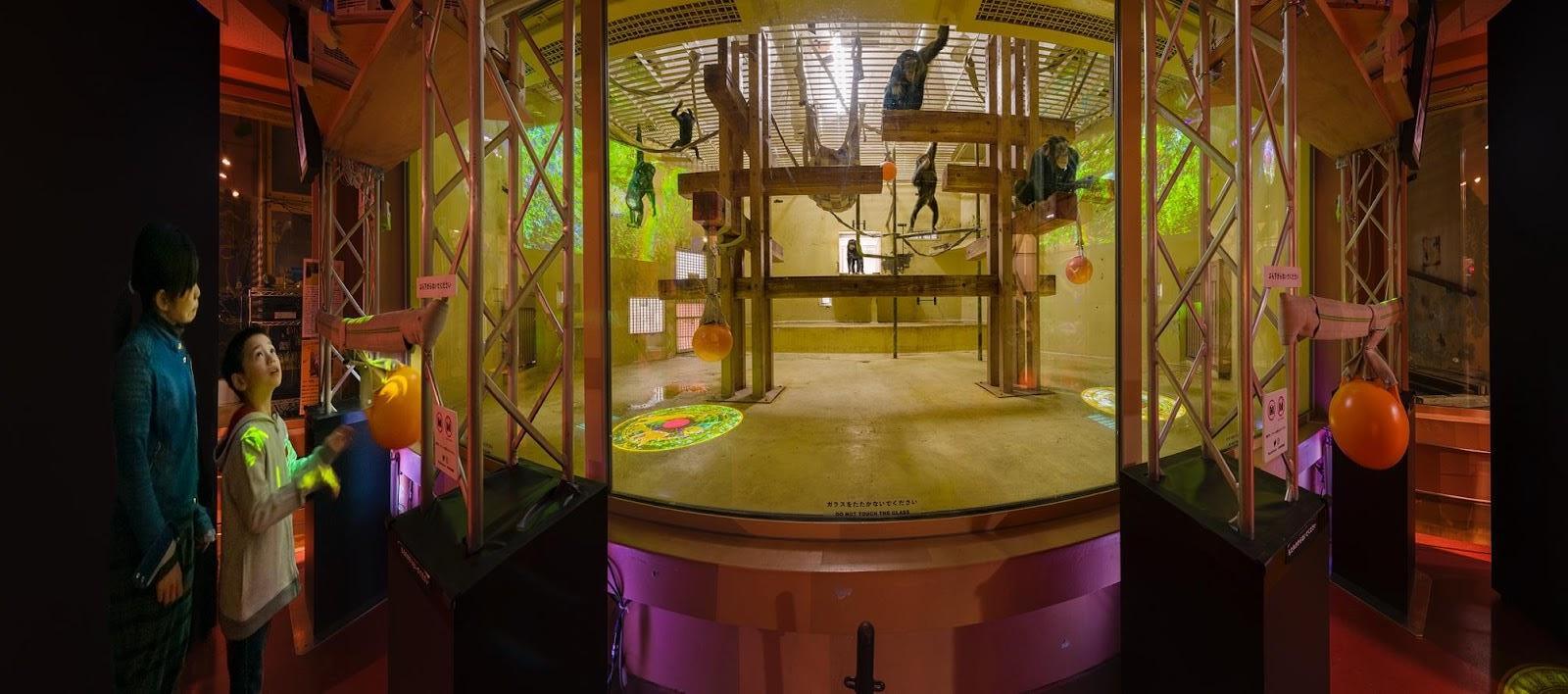
Art Style | Art & Culture International Magazine 49
Figure 1 Kazuki Hitoosa, Actant: Forest of Chimpanzees (2020/Interactive video installation) Photographed and edited by Tomas Svab (composite photograph) ©2020 Tomas Svab
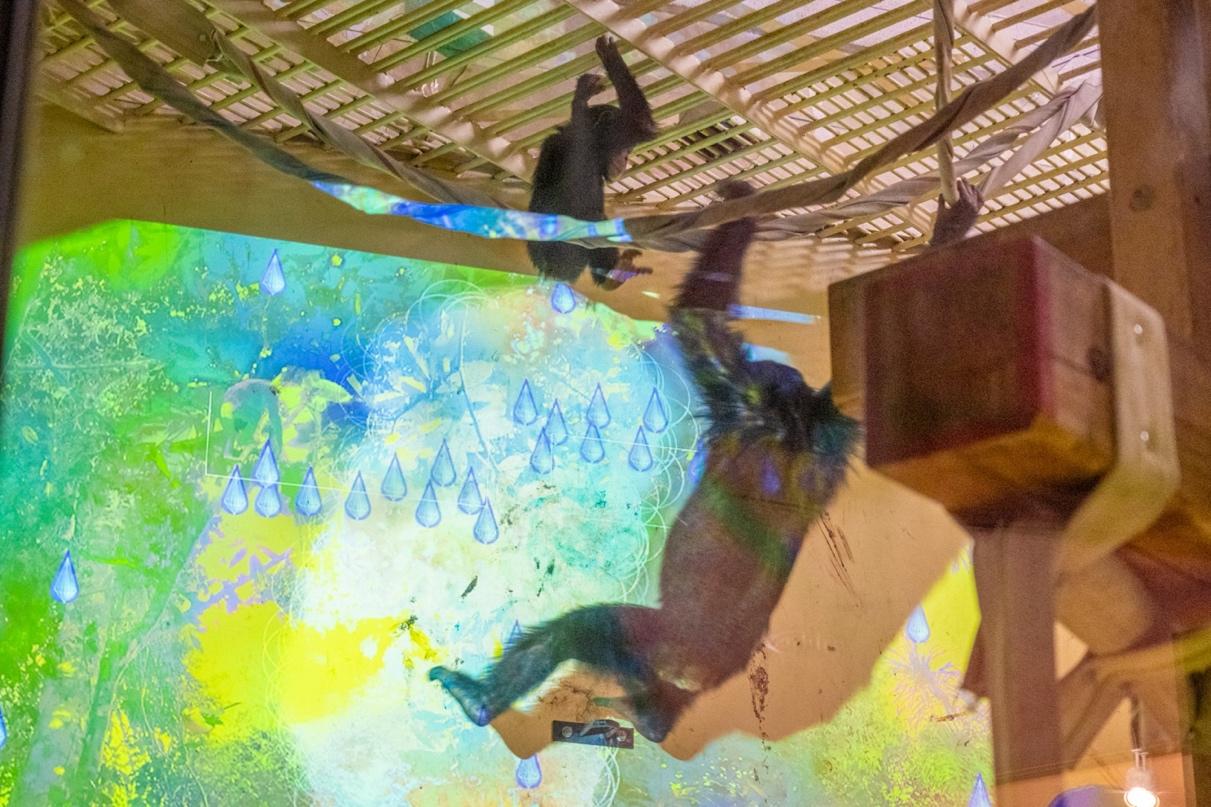
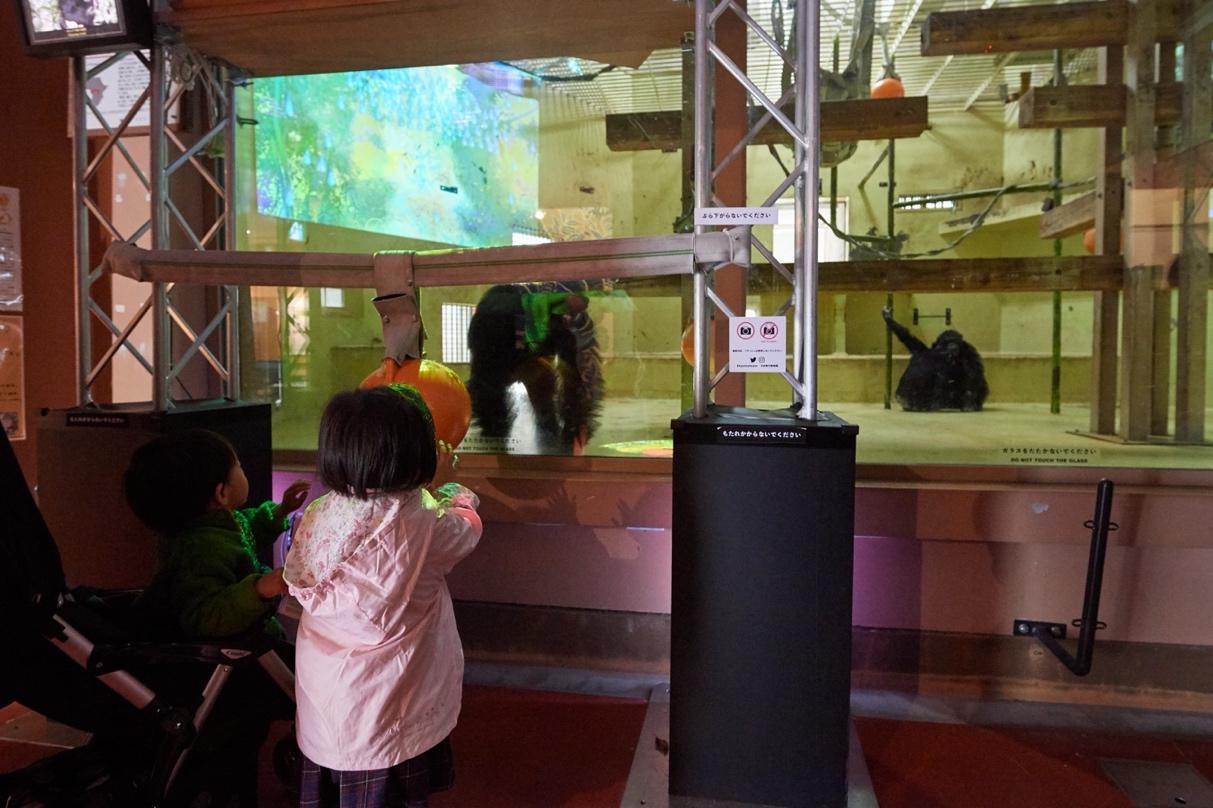
Art Style | Art & Culture International Magazine 50
Figure 2 Two young chimpanzees (Niini and Roger) interacting with the artwork (Exhibition in March 2020) Photo: Kazuki Hitoosa
Figure 3 Human visitors touching the buoy (Exhibition in March 2020)
Photo: KYOTO STEAM International Cultural Exchange Festival Executive Committee
Art for Animals? Artwork?
“Art is something you show people…” This statement left an impression, as artist Zon Ito expressed it multiple times while exchanging opinions. Kazuki Hitoosa, the artist participating in the second period (from April 2019 to March 2020), along with Ryoko Aoki and Zon Ito, the artists participating in the third period (from April 2020 to March 2022), dedicated themselves so earnestly to the project that thoughts of the chimpanzees occupied their minds constantly. At the same time, it seemed that they carefully contemplated their work and whether the final output could be called their own “artwork.”4 This is because they were contemporary professional artists who had been recognized within the artworld.5 The situation might have been slightly different if the designer had worked on the project.
Both “science” and “art” have rules and cultures that are tacitly shared within the community (in the world of art, defrauding the rules from a meta-perspective is also evaluated. However, if the rules are not shared, they cannot be outwitted). 6 Each concept of STEAM (Science; Technology; Engineering; Art(s);7 Mathematics) tends to be understood simplistically when viewed from outside the realm in which it is applied. “Art” is one of the concepts where there is a large gap in understanding. It may be that “art,” defined by scientific research, is often difficult for people who are involved in art-related work to understand. The difficult point is that there is no definitive definition of art, not even within the artworld. However, it can be said that both groups of artists deeply comprehended the project’s purpose and worked earnestly toward its goal. It was impressive to hear from both Aoki and Ito that they could have worked more smoothly if they had not used the word “art” (perhaps the act of working toward a goal itself might not have suited their artistic approach). It may be possible to position science and art on the side of creating questions and engineering and design on the side of creating solutions as a tendency (Fig. 4). Based on the above, I will try to provide the minimum necessary supplementary explanation in the following sections.
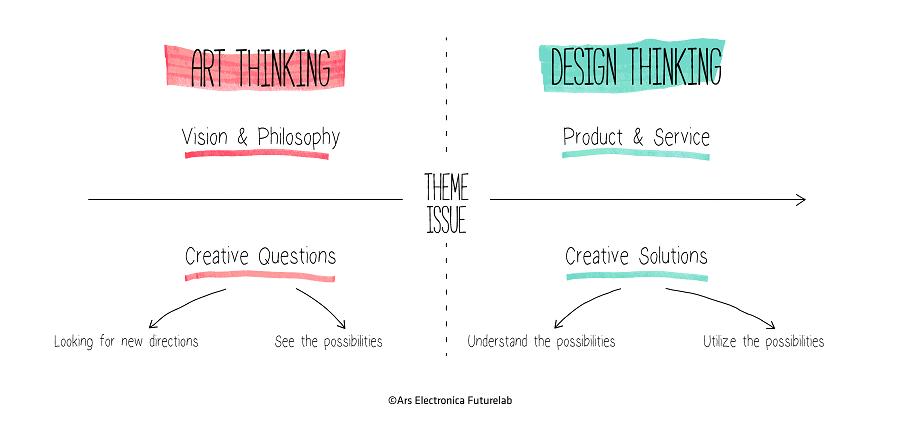
Art Style | Art & Culture International Magazine 51
© Ars Electronica Futurelab
Who are the Recipients of Art? Institutional Theory of Art
“Art is something you show people.” Looking back on Ito’s words again, it is true that in many cases, even in various definitions of art, “human beings” are both creators (sometimes only conceptions) and receivers.
In his 1964 paper, when he saw Andy Warhol’s Brillo box that was indistinguishable from the real thing, Arthur Danto argued as follows: “To see something as art requires something the eye cannot decry an atmosphere of artistic theory, a knowledge of the history of art: an artworld” (Danto 1964, 580). From this perspective, art becomes art only in relation to the knowledge about art theory and art history “widely shared by a specific era, ethnic group, society, and culture” (Nishimura 2015, 412-413, my translation) The reason why Marcel Duchamp’s Fountain (1917) and Warhol’s Brillo box (1964) Danto’s favorite examples are considered art are evidently rooted in particular art theories and histories that primarily developed in the Western context. Doubts may arise about the necessity and significance of people outside this community learning this (is it appropriate to offer it as an elective course?). Based on this viewpoint, the question of whether animals other than humans can appreciate “art” parallels the same degree of ambiguity and difficulty as the question of whether animals other than humans can appreciate “science.”
George Dickey borrows the concept of the artworld from Danto, even though Danto distances himself from Dickey’s theory. The following are definitions from “the later version of the institutional theory” revised in 1984 (Carroll 2000, 93):
(1) An artist is a person who participates with understanding in the making of a work of art
(2) A work of art is an artifact of a kind created to be presented to an artworld public.
(3) A public is a set of persons the members of which are prepared in some degree to understand an object which is presented to them
(4) The artworld is the totality of all artworld systems
(5) An artworld system is a framework for the presentation of a work of art by an artist to an artworld public (Carroll 2000, 96, number added by the author)
Art Style | Art & Culture International Magazine 52
According to these definitions, the creation of artwork is premised on the existence of the public, who are the recipients, as shown in (2) and (3). Dickey explains, “A public as such is just a set of persons who understand and know how to deal with a particular kind of situation” and “A member of an artworld public has characteristics that parallel those of an artist: (1) a general idea of art and (2) a minimal understanding of the medium or media of a particular art form” (Carroll ed. 2000, 100). In other words, artists consciously or unconsciously presuppose that the recipient has at least some degree of art education.
Beneath Ito’s casual remark, “Art is something that is shown to the public,” we can see the conventions of the art world as envisioned by Danto and Dicky. The artists (particularly those who participated in the project) deeply embodied such systems, given their established recognition within the art world. Now, we can understand that artists had to undergo a deep transformation at the physical level, which could not be achieved simply by changing the recipient from a human to a chimpanzee.
During discussions, the artists reflected on their impressions. Faced with chimpanzees, they realized that they usually created works unconsciously, assuming an unspecified number of human recipients. Conversely, in this project, they worked with specific recipients (i.e., chimpanzees) in mind than usual.
Who Creates Art: From Culturalistic Art Theory to Naturalistic Art Theory Frame
Regarding the question of whether nonhuman animals can be creators of art8, the answer seems negative from the perspectives of Danto and Dicky, among others. Danto writes, “It is the role of artistic theories, these days as always, to make the artworld and art, possible. It would, I should think, never have occurred to the painters of Lascaux who were producing art on those walls. Not unless there were neolithic aestheticians” (Danto 1964, 581). For Danto, the creators of the Lascaux murals may have been painters but not artists. Moreover, Dickey discusses the paintings of Besty, a chimpanzee from the Baltimore Zoo. “Please note that although paintings such as Besty’s would remain her paintings even if exhibited at a museum, they would be the art of the person responsible for their exhibited. Besty would not (I assume) be able to conceive of herself in such a way as to be a member of the art world and, hence, would not be able to confer the relevant status” (Dickie 1974, 46).
Art Style | Art & Culture International Magazine 53
From the perspective of Danto and Dicky, the concept of “art” only holds meaning for members who share a specific context during a limited period of human history. Thus, there is a high possibility that the members are limited to human beings and, furthermore, a specific group of human beings.
However, Dickey later argued that art theories can be categorized as “culturalkind activities” and “natural-kind activities,” showing a somewhat tolerant attitude even toward the latter (Dickie 1997). Borrowing from Dickey’s distinctions, we can label the art theory represented by Danto’s 1964 account and Dicky’s institutional theory of art as “Culturalistic Art Theory” and its opposite as “Naturalistic Art Theory.”
If we leap forward from the standpoint of a “naturalistic theory of art,” then <art>9 is no longer an exclusively human activity but a concept that represents expressive acts found in the wider animal world(s). The Japanese versions of Winfried Menninghaus’s Aesthetics after Darwin (Menninghaus 2021) and Elizabeth Grosz’s Chaos, Territory, Art (Grosz 2008) were published in 2020 during the project period. Here, we quote a passage from Gilles Deleuze and Félix Guattari’s What Is Philosophy?
Perhaps art begins with the animal, at least with the animal that carves out a territory and constructs a house (both are correlative, or even one and the same, in what is called a habitat). The territory-house system transforms a number of organic functions sexuality, procreation, aggression, feeding. But this transformation does not explain the appearance of the territory and the house; rather it is the other way around: the territory implies the emergence of pure sensory qualities, of sensibilia that cease to be merely functional and become expressive features, making possible a transformation of functions.
(Deleuze and Guattari 1994, 183)
The term “art” in the project title “Art × Science in Kyoto City Zoo: Sensing the Feelings of a Chimpanzee Through Art” would not be <art> as defined by culturalistic art theory. However, we could consider it the “art” discussed by Deleuze and Guattari. Art refers to an expression of “sensory qualities” present in both animal world(s) and human world(s) (given that humans are part of the animal kingdom). “Sensation is the zone of indeterminacy between subject and object, the bloc that erupts from the encounter one with the other” (Grosz 2008, 73).
Art Style | Art & Culture International Magazine 54
Chimpanzees likely do not know, nor need to know, the theory and history of human art, which Danto considers a prerequisite for art’s existence 10 Looking at the project title through the lens of culturalistic art theory, it might seem problematic. However, if we use “art” to denote the act of expression mentioned above, the issue takes on a different aspect. If the term “art” proves inconvenient, the issue we can explore alternative words for expressing the sensory qualities widely observed in the living world. Whether such a sensory expression is the origin of contemporary human <art> may not matter much, but the fact that sensory expressions are spreading beyond the human world remains intriguing.
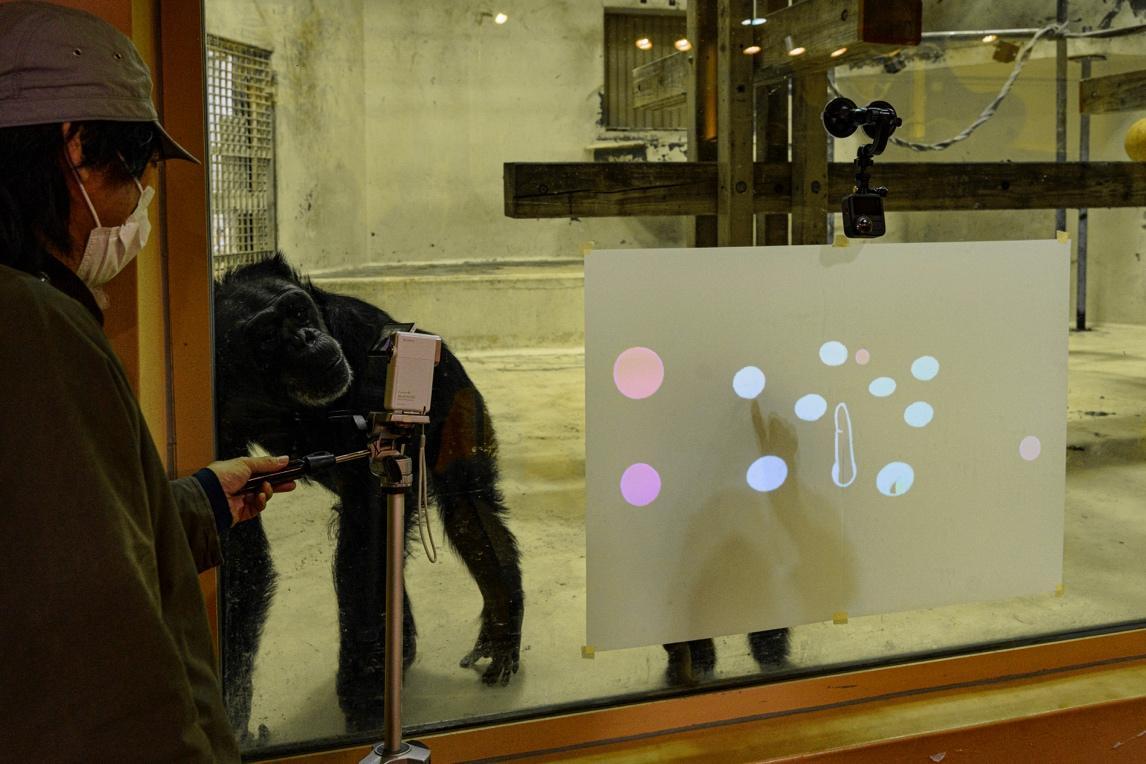
Instead of having chimpanzees observe <art> created by humans for humans, the artists enter the chimpanzee world and discover the logic of the senses unique to chimpanzees. Artists Hitoosa and Aoki+Ito intuitively changed direction during discussions with the researchers and zoo staff. They were unknowingly dragged out of the artwork as defined by culturalist art theory into the artwork as defined by naturalistic art theory and made a groping effort to express themselves as much as possible within that world.11
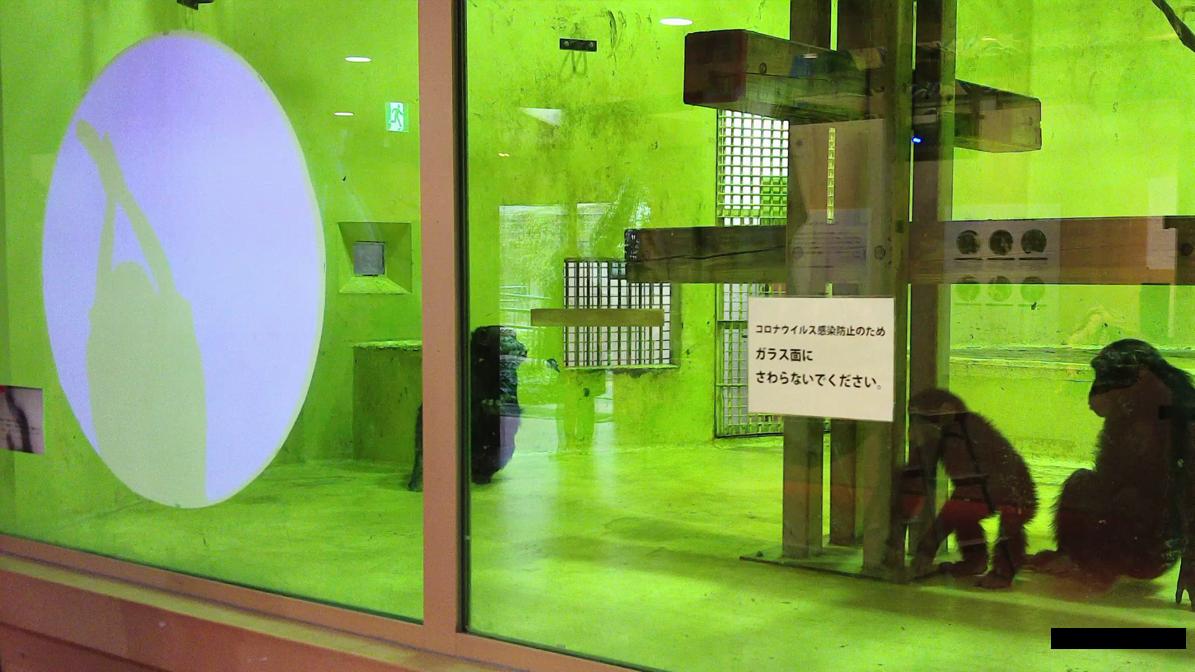
Art Style | Art & Culture International Magazine 55
Figure 5 Shadow picture trial (2020) Shooting (Excerpt from recorded video): Akihisa Iwaki
Photo: KYOTO STEAM International Cultural Exchange Festival Executive Committee
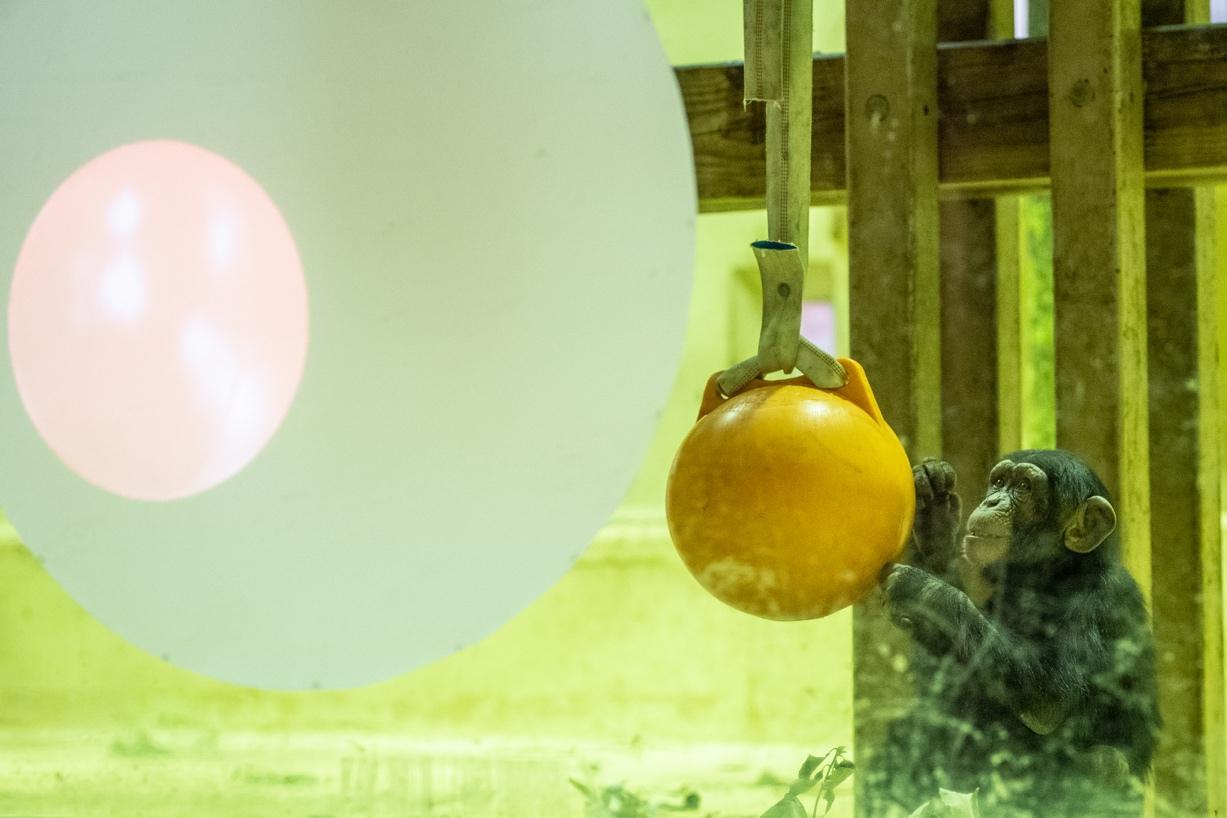
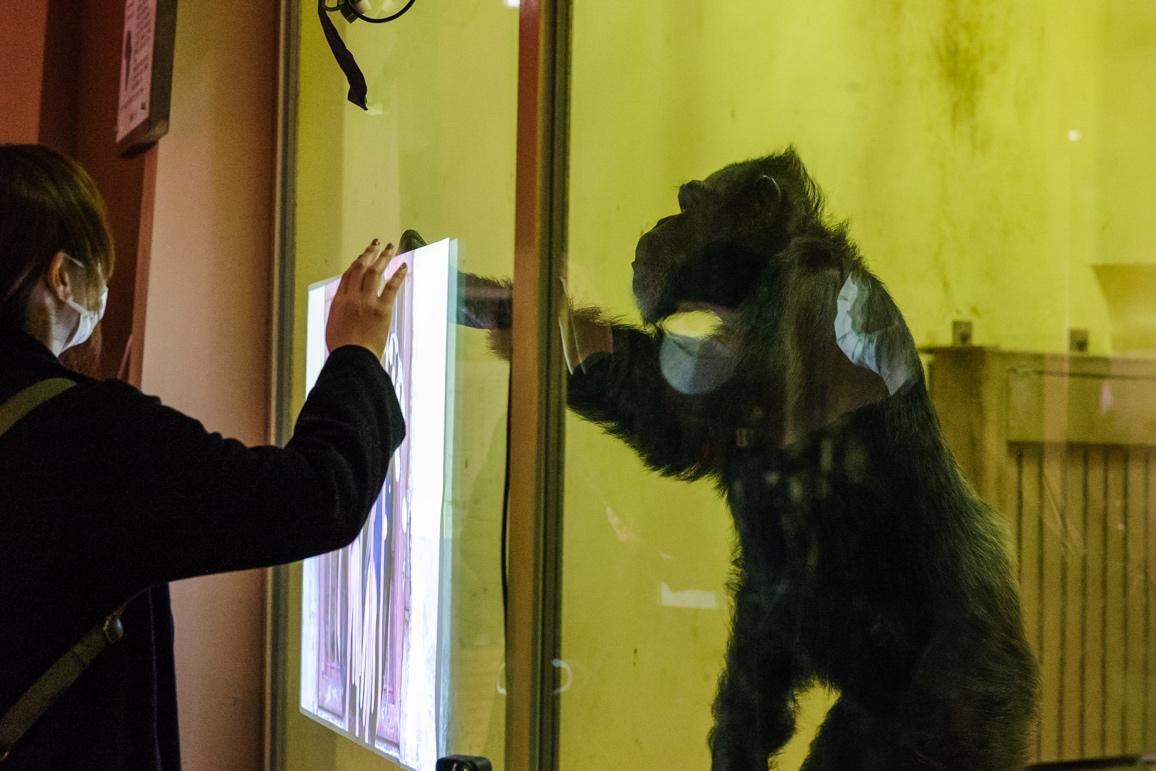
Art Style | Art & Culture International Magazine 56
Figure 7 Touching the buoy (2021) Photo: Itsumi Okayasu
Figure 8 Touching the video (2021) Photo: Itsumi Okayasu
Interspecies-Interactive Art
Simultaneous Attempts at Digital Enrichment Around the World
The concept of KYOTO STEAM Art × Science in Kyoto City Zoo began in 2017; research on videos was conducted in 2018, and the concept of art x environmental enrichment began in 2019. In my short report for attempts in 2019, I wrote:
If sensibility is first defined as the capacity to receive something from outside/inside of our body, what are the commonalities and differences among species? Has sensibility diverged and evolved from the same common ancestor? This project leads us into the vast questions of aesthetics and arts that traditionally focus on the sensibility of humans. In this project, we encounter Interactive Art and Environmental Enrichment, two fairly new fields in human history. The purified perceptual modality of looking to see is a very specific mode cultivated in the history of human art. However, segments or linkages of the perceptionaffection-action targeted by the interactive art are supposed to have a common part shared among human beings and other species. From the aspect of environmental enrichment, we are looking forward to viewing the analysis results, and determining how much value the art created for chimpanzees had. We hope that this program will be an inspiration for the interdisciplinary development of a wide variety of Interspecies-Interactive Arts such as art for bats or microorganisms, and so on, and help deepen our knowledge of the sensitivity of all kinds of creatures.
(KYOTO STEAM – International Arts × Science Festival English version report 2020, 27, some revisions have been made).
As a side note, Myron Kruger, who has been using the term “artificial reality” since the mid-1970s to mean “the ultimate form of interaction between human and machine,” (Kruger 1991, xii) is a pioneer of interactive art of the “unencumbering” and “environmental” type (Kruger 1991, xv) (not the type the participants sit and look at with goggles, but that they experience while moving their body) and worked from the perspective of what is now called STEAM from an early age. We expect that many of Kruger’s ideas, including interactive works that project visitors’ silhouettes into the digital environment, will contribute to the environmental enrichment of zoos.
Art Style | Art & Culture International Magazine 57
Interactive art became active in the 1990s, when computers became common in ordinary households. The concept of environmental enrichment was proposed in 1920s but systematized in zoos in the 1980s; such efforts were active in the 1990s (Hosey, Melfi, and Pankhurst 2009, chapter 8; Ishida 2010, 131-133).
The Kyoto City Zoo project, art × environmental enrichment began in 2019, and similar attempts were being made around the same time elsewhere around the world. For example, Melbourne Zoo in Australia explored the possibility of enriching orangutans using Microsoft’s Kinect and other technologies (Webber et al. 2017; 2020; See also, Scheel 2018). Recently, the Animal-Computer Interaction System for Zoos (ZACI) has been announced (Schmitt 2018). This trend can be referred to as “digital enrichment.” According to a survey paper (Kim-McCormack et al. 2016), digital enrichment is comprised of two types: “passive participation,” such as watching videos and photographs, and “active participation,” which accompanies physical interaction. We would like to have a term that expresses the latter clearly. Perhaps “Interactive digital enrichment”? According to Clark et al. (2019), among the survey papers on digital enrichment research up to 2016 (Perdue et al. 2011; Kim-McCormack et al. 2016), nine were primate-related papers, six of which focused on orangutans. A total of three are about chimpanzees (including Art × Science in Kyoto City Zoo project member Yamanashi’s paper), and none focused on bonobos and gorillas. Of these papers, six were published in animal behavioral and other scientific journals, and the remaining three were Animal-Computer-Interaction (ACI)12 or Human-ComputerInteraction (HCI) proceedings. Given this situation, the author highlighted that it may be difficult to grasp information on the progress of related technology for the zoo community. If that is the case within the zoo community, for outsiders like me and artists and designers, the situation is hopeless. In addition, there are also language barriers.
The chimpanzees at Kyoto City Zoo differ from wild chimpanzees in that they are already familiar with touch panels. The Zoo sets “primate study times” using touch panels, which are aimed at research and (cognitive) enrichment at the same time13 Kyoto City Zoo is a pioneering zoo that implements enrichment. In contrast to studies that target chimpanzees’ intelligence, the target of KYOTO STEAM Art × Science at Kyoto City Zoo was the chimpanzees’ sensibility and feeling.
Art Style | Art & Culture International Magazine 58
Art for Environmental Enrichment
The actual creation of the art works for chimpanzees proceeded through discussions mainly among the artists, engineers in charge of the sensor, scientists, and coordinator who coordinated between them.
Chimpanzees are very curious and strong, and they can easily destroy equipment. Relatedly, the risk of injury must be thoroughly eliminated. Chimpanzees are initially frightened and wary of new things, followed by a surge of curiosity, and then a quick habituation and boredom. The needs of chimpanzees must come first. Interactive art should be one of the options that chimpanzees can freely choose. Chimpanzees should not be anthropomorphized. Visitors should not be given this impression or misunderstanding. Starting with learning such topics, artists confronted chimpanzees’ sensibility, among other things. One of the features of this project was that it was implemented without food rewards, so it became an increasingly hard task for artists. In a way, it was an attempt to challenge interspecies communication and environmental enrichment using an interdisciplinary approach and interactive art works. It was extremely interesting to see what kind of works could be created while skillfully adjusting the balance between what artists can do and what the people at the zoo want. One of the interspecies-interactive arts, Actant: Forest of Chimpanzees (artist Kazuki Hitoosa) was exhibited from March 21 to 29, 2020, at Kyoto City Zoo (Figs. 1, 2, 3).14
Finally, artist Kazuki Hitoosa completed a 15-minute interactive movie consisting of three scenes. A moving image was projected on the top of walls on both sides of the chimpanzee indoor enclosure, where infrared sensors were installed. In addition, two circular projections on the floor interacted with the buoys above. Additionally, two buoys were also installed in the space for humans outside the enclosure, and when visitors touch these, the image on the wall inside of the enclosure changes (Fig. 3).
When we describe this work from a human perspective, this is an interactive artwork including chimpanzees and human visitors as indeterminable elements of the development of the moving image. Chimpanzees rarely come to the image and move it, but if someone waits for a long time, they may encounter such a rare opportunity. When a chimpanzee interacted, the interaction was also superimposed from the human side. The observer watching this moment as a third person may be very impressed.
How did chimpanzees feel about this interactive artwork? A zoo researcher states, “Visitors will be pleased if the animals are moving and looking happy, but that is not always enough. The results must be evaluated according to a zoological criterion” (Ishida 2010, 132, my translation). Under these conditions, most artists may not be able to evaluate the quality of their work on animal spectators by
Art Style | Art & Culture International Magazine 59
themselves. Fortunately, our project was led by primatologists and a scientific paper that evaluated this exhibition has already been published (Yamanashi et al. 2022). Primatologist, specialist of animal welfare and environmental enrichment, Yumi Yamanashi and other authors concluded, [the] “results demonstrate, first, that the interactive art did not negatively affect chimpanzee behavior, and second, that some of the chimpanzees indeed displayed positive responses to the art. Therefore, this study introduces a novel possibility for environmental enrichment in zoos, involving a collaboration between science and art” (Yamanashi et al. 2022).
Among the six chimpanzees living in the zoo, “two young chimpanzees frequently actively interacted with the interactive art …The adult chimpanzees rarely exhibited interest in the movie, except for one female (Lora)” (Yamanashi et al. 2022). During the period of the exhibition, we observed “two young chimpanzees (Niini and Roger) interacting with the videos and playing together, an adolescent chimpanzee (Niini) interacting with the video and sometimes showing play face, an adult female (Lora) approaching and exploring the video, an adolescent chimpanzee (Niini) watching and touching the ‘raindrop’ in the video, an infant chimpanzee (Roger) touching and moving his arm toward a butterfly in the video,” and “an adolescent chimpanzee (Niini) shaking the buoy that can move the red circle of the floor movie,” among others. These behaviors are cited from the supporting information in Yamanashi et al. (2022), and the author inserted the chimpanzee’s name.
Mapping Interspecies-Interactive Art
As I discussed before in reference to Henri Bergson, we can clarify features of two opposite tendencies regarding interaction between humans (and other species?) and environments.15 We could also classify the types of interactive art based on these tendencies: in the Figure 9, the left-hand side shows interactions of perception–body–action, while the right-hand side shows interactions of perception–body–memory.
And this is just my subjective impression as an aesthetician who is not a specialist in animal research: interestingly, a female chimpanzee (Lora)’s movements suggested that she enjoyed the artwork. Lora barely interacted with the work but gave me the impression that she was staring at the work. In contrast, I had the impression that the oldest male chimpanzee (Takashi) was not interested in the work but was sitting quietly, daydreaming.
For further research on interspecies-interactive art, we propose the inclusion of the axis of interaction related to sexual selection in addition to the sensory-motor interaction of the previous map (Fig. 10). In fact, we observed that a male chimpanzee (James) watched and touched a sexual swelling of a female chimpanzee in the movie projected on the wall during the habituation period
Art Style | Art & Culture International Magazine 60
(interaction regarding sexual selection?). The image was projected slightly larger than life size at the time. On the same occasion, he also touched the moving branches, leaves, and infant chimpanzees that appeared in the projected movie (interaction regarding natural selection?), although he rarely interacted with the artwork during the exhibition. A male chimpanzee (Takashi), who was originally not interested in the opposite sex, and two female chimpanzees (Koiko and Lora) did not seem interested in the buttocks of female chimpanzee in the movie.
On the other hand, the discourse on animal aesthetics has been overly associated with sexual selection under the influence of Darwin. However, the scope of interspecies-interactive art is much wider. During the exhibition, younger individuals Niini and Roger interacted with artworks many times. They may enjoy sensible qualities, but it seems unconnected to the sexual selection. Rather, it is connected to play in general. The “play face” (the relaxed open mouth face) was also observed (Yamanashi et al. 2022) What acts as a “sensible quality” for each organism, and in what context does it act? It is worth exploring without deciding yet.
Our proposed map is only an idea as a first step. The relationship or overlapping among natural selection, sexual selection, and play is quite complex. In addition, natural selection is a concept applicable only to life, and sexual selection is a concept applicable only to life that reproduces sexually. At its foundation, there are interactions of action and reaction that penetrate from matter to life. These blueprints can be refined in solidarity with animal research specialists.
Art Style | Art & Culture International Magazine 61

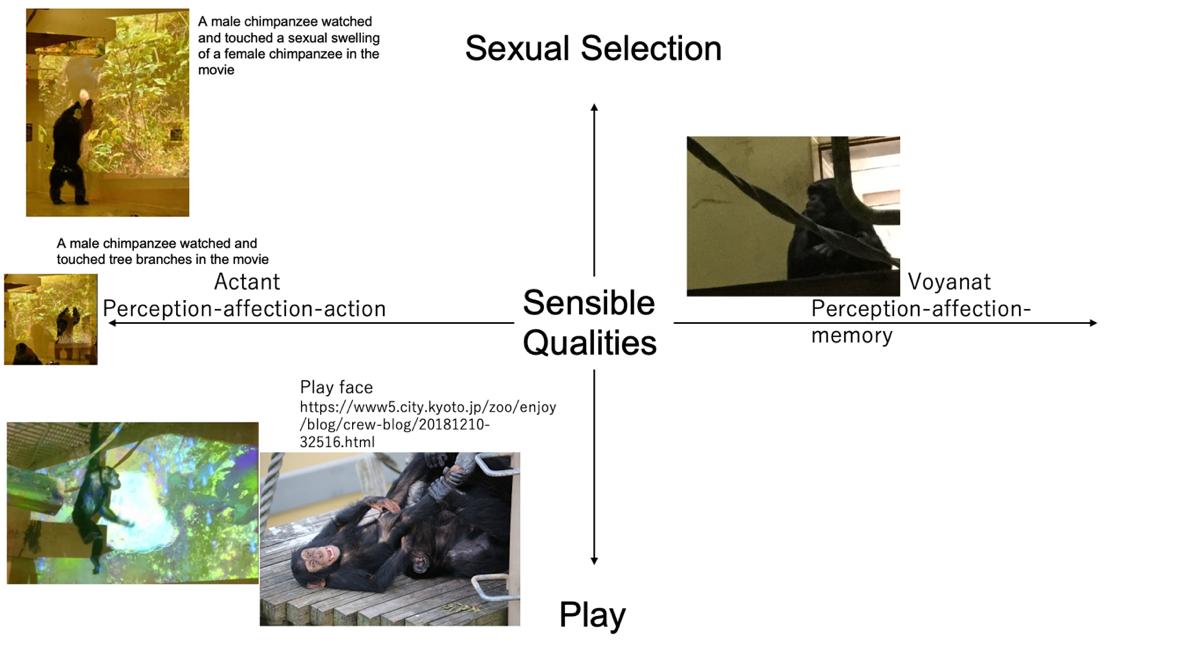
Art Style | Art & Culture International Magazine 62
Figure 9. Mapping of Interaction between humans (and other species?) and environment (Myron Krueger, Videoplace, 1974-; Jeffrey Shaw, Legible City, 1989; Towata+Matsumoto, Divina Commedia, 1991.)
Figure 10 Mapping of Interaction for Interspecies-interactive art
Sense of Beauty
There have been several reports of chimpanzees watching the sunset.16 This leads to an aesthetically interesting question as to whether animals have a sense of beauty. Darwin and his followers would recognize the sense of beauty in animals in the context of sexual selection 17 On the other hand, the beauty of sunsets is an example that is often used to explain Kantian aesthetics.
Inspired by that story, Hitoosa tried to create a prototype for the above video (Fig. 11) but the demonstration with chimpanzees was not realized. This was because there was concern that brightly colored surfaces might be too stimulating. There is a bit of resemblance to art experiments in space, and we will proceed with safety first (cf. Iwaki 2019). The artists had many ideas, some of which never materialized.
Although chimpanzees and beauty are interesting subjects, at the discussion in the zoo, I was told that it is “not known” whether chimpanzees have a sense of “beauty” (at least from a scientific perspective at this point). This is because it is not expressed as an emotion. Emotion can be measured but feeling or first-person experience cannot be so determined. The same is true for memory-related questions such as whether chimpanzees dream or not. Thus, there are still many unanswered stimulating questions for aestheticians. New research areas such as animal neuroaesthetics may soon emerge.

Art Style | Art & Culture International Magazine 63
Figure 11 Kazuki Hitoosa 2019. “Chimpanzees look at sunset?” One of the ideas that was not actually used. ©2019 Kazuki Hitoosa
Ambient Media
New research fields such as ACI have been established (Mancini 2017) and efforts are being made to improve animal welfare through interaction with digital technology. On the other hand, of course, environmental enrichment does not always require high tech. During the preparatory period in the third season (2020 and 2021), artists Ryoko Aoki and Zon Ito used various motifs to approach the tactile nature of chimpanzees (Figs. 12, 13). Such trials and errors may not immediately lead to scientifically valuable results, but may stimulate combined thinking with previous research in the field of science.
Finally, we would like to add one point. When interaction is an issue, we tend to expect that some actions take place too much. However, in the Kyoto City Zoo project, the time when nothing happens was also considered important. Having more options for chimpanzees is more important than whether an action occurs or not. In relation to this, when considering environmental enrichment, it is be not always necessary to work only on the foreground of animal consciousness, and approaches that include effects on the background of consciousness can also be considered (although it may be necessary to discuss whether all animals are conscious) We refer to such approaches as ambient media. In the human world, research is progressing on sounds and scents, for example. Soundscape and aroma space design are likely enriching the environment in which we live without realizing it. In the future, it may be possible to incorporate this perspective into the digital enrichment of zoos.
Artists Ryoko Aoki and Zon Ito presented the movie in three layers (Figs. 14, 15) in the third period exhibition from December 18 to 21, 2021. This can be viewed from the chimpanzee side as follows: 1) The smallest screen attached to the glass that is installed between the chimpanzee indoor enclosure and human visitor space. Chimpanzees can watch and touch projected images on this screen. 2) A middle-sized screen installed around the middle of human visitor space. 3) A large screen using the back wall of the human visitor space. Chimpanzees cannot touch images on the middle-sized and large screens, but can watch them. At this time, only the smallest screen was the target of scientific analysis. However, we can glimpse artists’ intention to open relatively closed chimpanzee living space through images. This suggests that the potential for environmental enrichment is not confined to such enclosures. This is because each of the five senses has its own characteristics, and our sensory world is multi-layered. For example, even glass that blocks the body (tactile sense), smells, and sounds can be overcome with vision. Conversely, although the farthest plane of vision is easily blocked by an obstruction such as a wall, other senses have the possibility to exceed this limit. Since the arrangement and spread of the five senses differ from species to species, understanding and considering them is also an important issue from the perspective of aesthetics-kanseigaku.
Art Style | Art & Culture International Magazine 64
when they
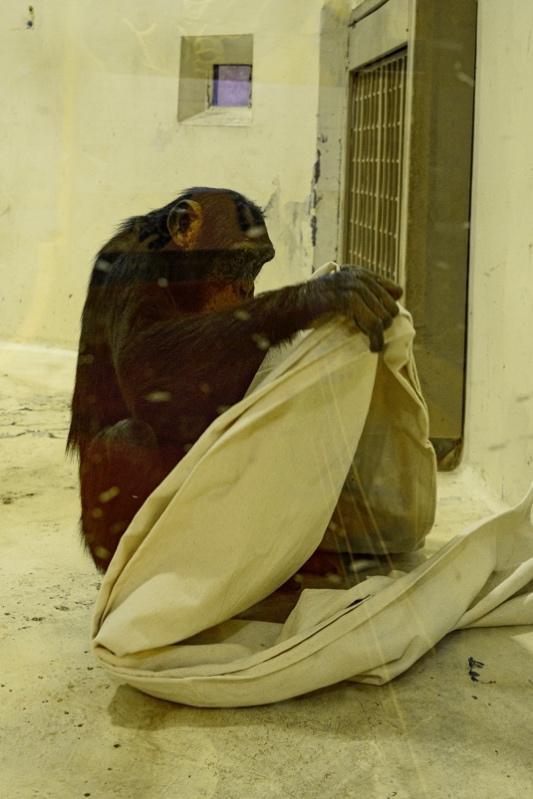
elements that change the movie when
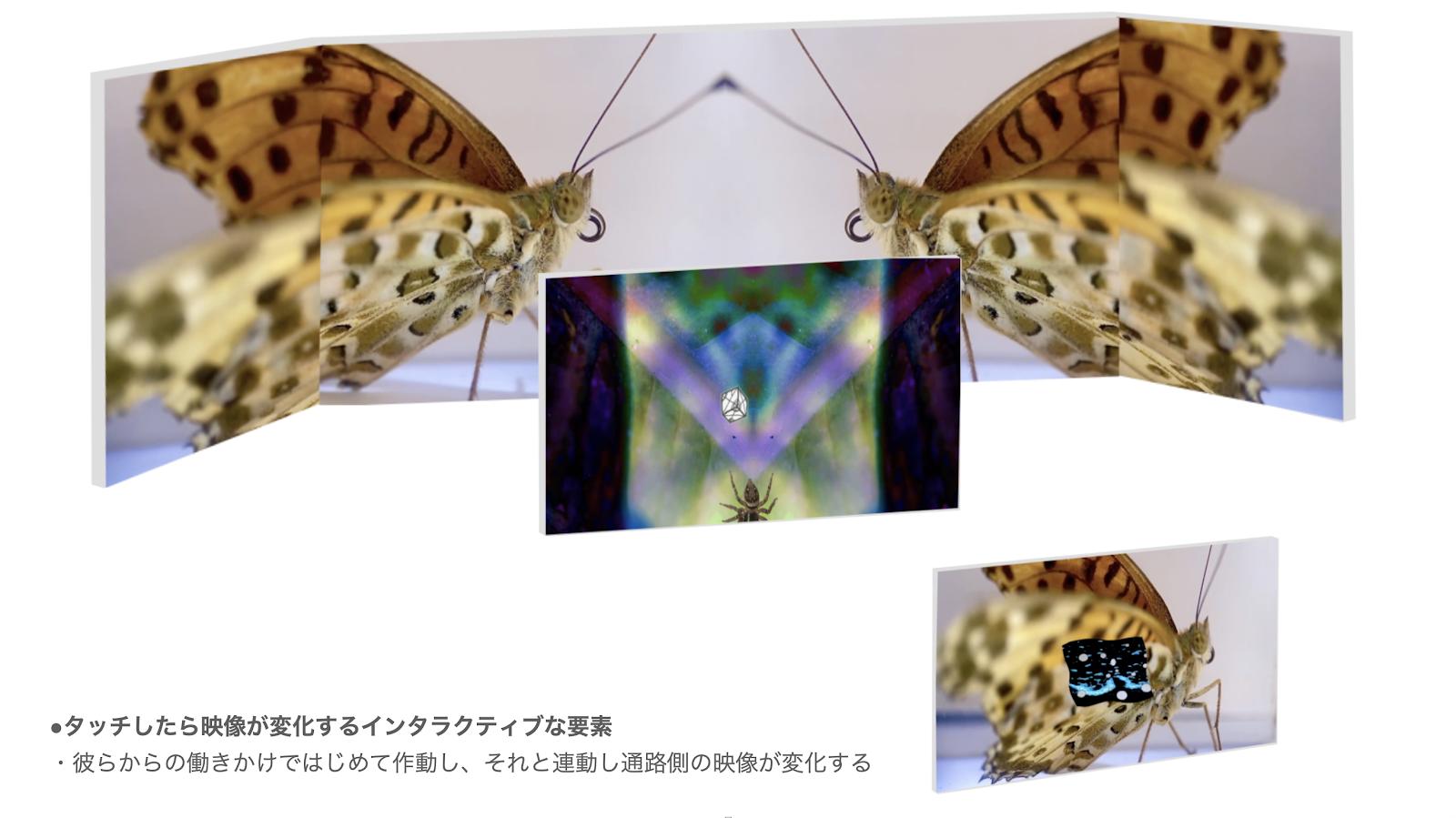
change in conjunction.”
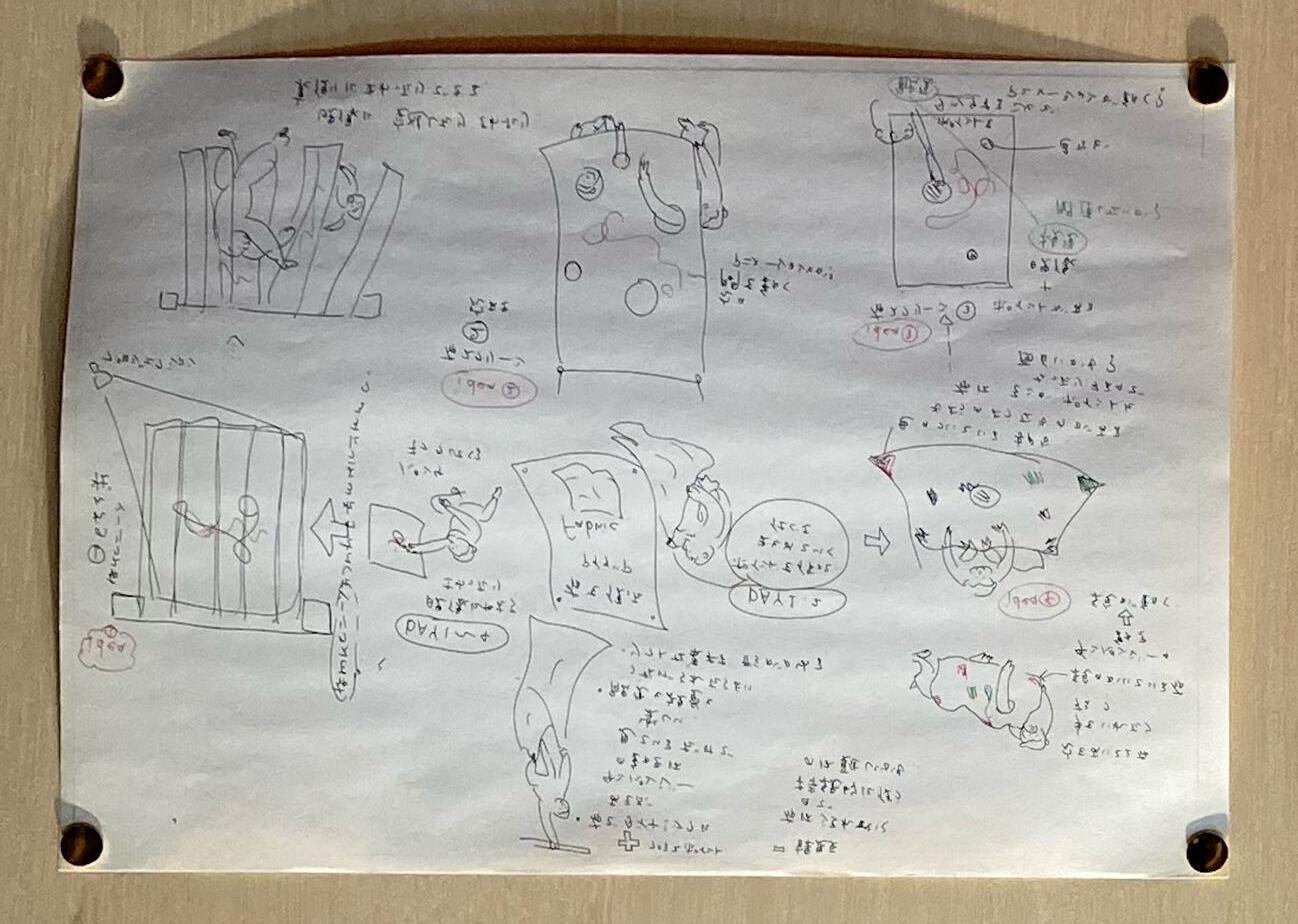
Art Style | Art & Culture International Magazine 65
Figure 12 Ryoko Aoki+Zon Ito 2020 “Part of the idea sketches exhibited in March 2021.”
Photo: Mu Tanimura Figure 13 Trial using cloth in 2020. Photo: KYOTO STEAM International Cultural Exchange Festival Executive Committee
Figure 14 Ryoko Aoki + Zon Ito “Interactive
Chimpanzees touch: The movie (smallest one) projected on the glass of Chimpanzee indoor enclosure only works
act, and the movies on the human visitor space
PDF material on the three-layer screen concept 2021 ©2022 Ryoko Aoki+Zon Ito
Conclusion
The experiment of “Art × Science in Kyoto City Zoo: Sensing the Feelings of a Chimpanzee Through Art” serves as a useful reference point for aestheticskanseigaku and art/design practices for animals that would contribute to realize more than human aesthetics-kansegaku. Aesthetics-kanseigaku should start from concrete experiences. Art and design along with science and engineering for animals would be good partners, and provide us with such experiences. I submit the following three points, from among others:
1. Sensibility genesis: Chimpanzees and us diverged more than 5 million years ago. How similar are chimpanzees and how different are we? This project prompted us to ask such a question. In the future, aesthetics will require a theory of the genesis of sensibility. Where do our sensibility-kanesei come from and where do they go with technology? It is necessary to have a viewpoint that traces the branching and diversifying sensibilities from the common ancestor to the life on the earth that exists today. Aestheticskanseigaku will inevitably become an interdisciplinary research field. In this paper, we mentioned interactions based on natural selection, sexual selection, and play. In reference to Henri Bergson’s discussion (Fig.16), for example, it may be possible to add the classification of intelligence-based interaction and instinct-based interaction. Some chimpanzees make tools to expand their body image. This will be based on intelligence. On the other
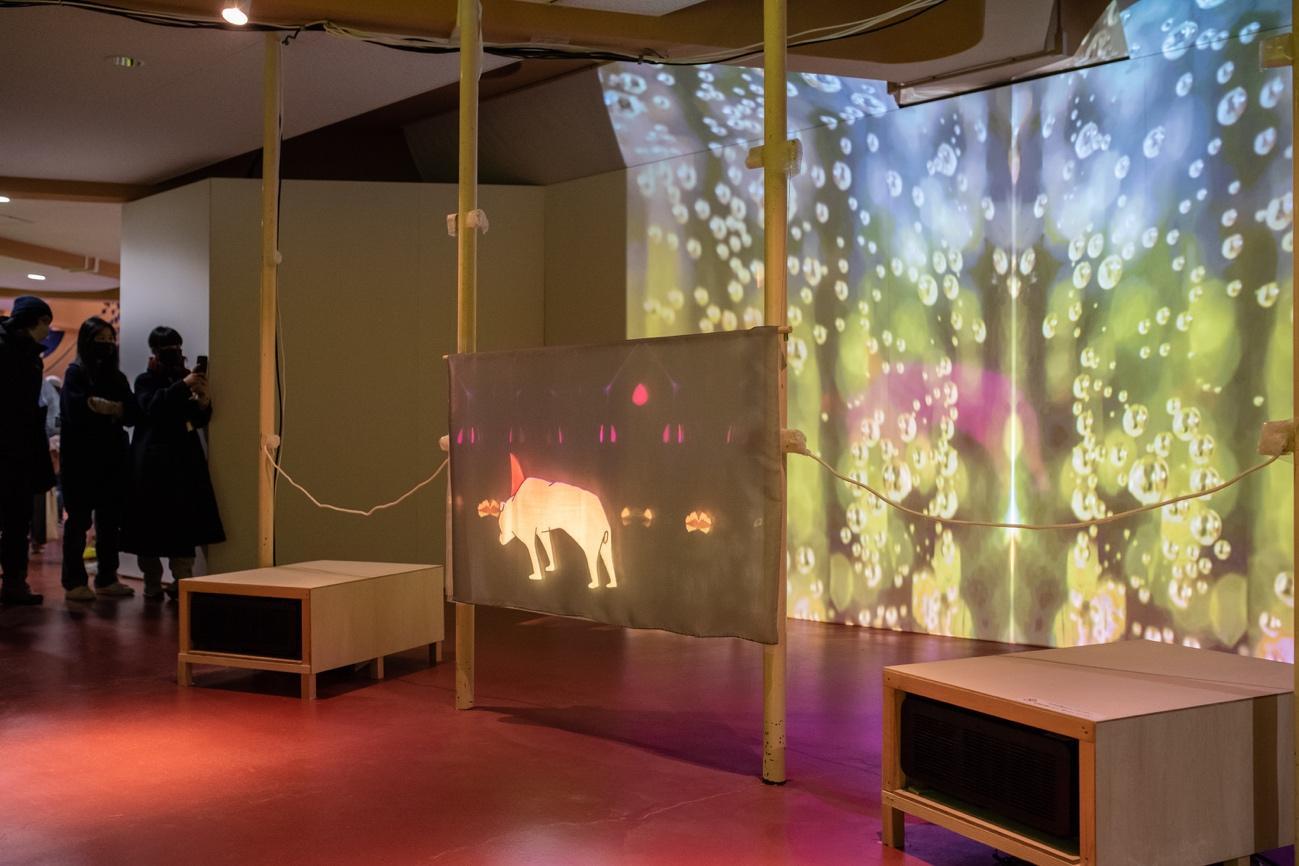
Art Style | Art & Culture International Magazine 66
Figure 15 Exhibition in December 2021 Photo: Itsumi Okayasu
hand, it has been reported that all wild chimpanzees make beds every day by combining tree branches, but not all captive chimpanzees do so (cf. Yamanashi et al. 2020). Is this based on intellect or on instinct? It seems that there are still many exciting questions remaining for aesthetics and art.
2. History of art and design for animals: If you look back on this project as a starting point, you will notice that there have been many designs for animals in zoos. For example, the tower for chimpanzees, which was first introduced in 1995 to the world at the Primate Research Institute of Kyoto University, is an excellent invention (Fig. 17). However, as long as we are in the field of aesthetics or art studies, we will not learn about such designs, and we will not have many opportunities to pay attention to them. The history of more than human art/design should be incorporated into aesthetics and art studies. Artifacts for animals would be a guide for understanding their sensibility 18
3. Education and environmental enrichment workshops: The artists who participated in this project learned to approach animals in a different dimension from traditional art techniques. The first thing that Hitoosa and Aoki + Ito worked on, was to keep in mind the whole life of chimpanzees and continue considering approaches that would attract them. Just as Ito tried knitting the same fire hose that was used in the living space of the chimpanzees, the approach of moving one’s own body and trying to understand the sensibility of others were effective as an educational program.
In fact, such educational programs are already in place. For example, in 2014, sophomore students from Stanford University’s medical school participated in an environmental enrichment workshop at the San Francisco Zoo. One of the advisors explained as follows: Animals in zoos are already in a good welfare state, so rather than trying to improve something, we aim to make some changes, help animals and keepers, and improve the visitor experience19 It might be quite difficult to create a setting that benefits the people who work at the zoo, including aspects such as labor and funding, but for university art students and so-called liberal arts students, having such an experience is very important. It should be a valuable experience to understand the life of animals living in the world at a physical level, to relativize the anthropocentric world view, and to review their own way of thinking. It is also possible that students, as participants in co-design, may contribute eccentric enrichment ideas that experts have never thought of.
We hope that the project will be an inspiration for the interdisciplinary development of a great variety of Interspecies-Interactive Arts such as art for bats or microorganism, etc., and help us deepen our understanding of the sensibility of all kinds of creatures.
Art Style | Art & Culture International Magazine 67
tendencies toward the emergence and differentiation of plant and animal, instinct and intelligence, and so on. Several evolutionary directions arise from one virtual multiplicity, that is to say, duration. Deleuze calls this “genetic dualism (dualism génétique, Deleuze 1991, 96) in addition, can we call it “real dualism” or “natural dualism”? (Iwaki, Masuda, and Matsutani 2019, 51)
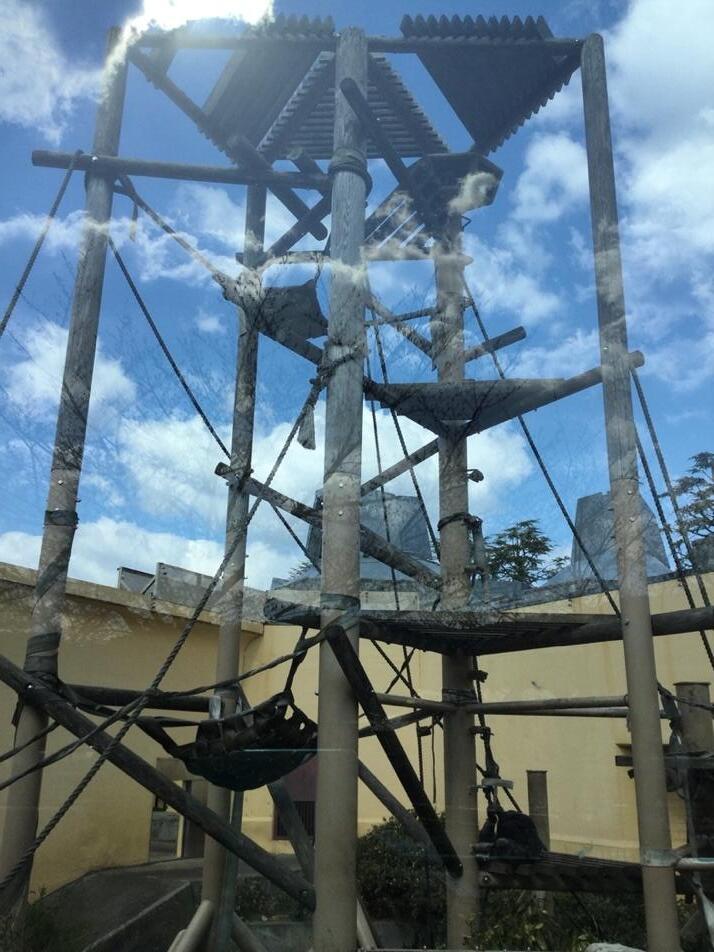

Art Style | Art & Culture International Magazine 68
Figure 17 Tower for Chimpanzees at the Kyoto City Zoo
Photo: Akihisa Iwaki
Author Biography
Akihisa Iwaki is an Associate Professor at the Section of Aesthetics-kanseigaku, Department of Cultural Design, Faculty of Literature, Arts and Cultural Studies at Kindai University, Japan. He obtained a Ph.D. in aesthetics from Kwansei Gakuin University in 2012. His dissertation was entitled “Cinema as Image Generation System: Bergson and Post-Bergsonian Image Theory.” His research interests include, among others, aesthetics of image, body, media, and technology. He currently undertakes research regarding more than human aesthetics, aesthetics of multi-sensory dining, inter-space aesthetics, and so on, to analyze the conditions of sensible experiences in a wider sense.
ORCID ID: 0009-0007-7945-760X. E-mail: akimaruiwaki@yahoo.co.jp
Acknowledgement
The author thanks the members of “Art × Science in Kyoto City Zoo: Sensing the Feelings of a Chimpanzee Through Art” for valuable suggestions and discussions. This work was supported by JSPS KAKENHI Grant Number 23H00579.
Notes
1 Project members other than artists after April 2019 (affiliation as of 2019) were Yumi Yamanashi (Principal Researcher, Kyoto City Zoo), Fumihiro Kano (Project-specific associate professor, Kumamoto Sanctuary, Kyoto University), Nobuaki Yoshida (Chief researcher, ASTEM RI/KYOTO), Yuko Ikkatai (Project researcher, Kavli IPMU, The University of Tokyo) , Akihsa Iwaki (Associate Professor, The Department of Cultural Design, Kindai University), Hidefusa Sakamoto (Vice Director, Kyoto City Zoo/Chief Director, Executive Committee of KYOTO STEAM – International Arts × Science Festival) and Keiko Yamamoto [until March 2020]; Eriko Kamimura [from April 2020 to September 2021]; Noriko Mizuno [from September 2021] (Art Coordinator, Executive Committee of KYOTO STEAM – International Arts × Science Festival) Part of this paper is based on my report of the project written in Japanese in 2022. https://kyotosteam.com/download/2022/news/220329/report.pdf
2 In contrast, de Waal questions the social constructivist understanding of emotion, especially the understanding that linguistic articulation precedes emotional articulation (de Waal 2019, 126). See below for a comparative study of the social constructivist argument that emotions are constructed by culture and the essentialist and universalist arguments represented by neuroscience (Plamper 2015).
3 “Sentience is defined as the capacity to experience, feel, or perceive ” (de Waal 2019, 246)
4 Hitoosa and Ito are from the Concept and Media Planning course at the Kyoto City University of Arts (Aoki graduated from the Visual Design course at the same university). The Concept and Media Planning course is likely a rare major in Japan that was deliberately established to consciously inherit the history of “Meta Art” and put its principles into practice.
Art Style | Art & Culture International Magazine 69
5 For more information on the artists, please refer to the following links, for example Kazuki Hitoosa, https://hitoosa.jp/works/; Ryoko Aoki + Zon Ito http://www.watarium.co.jp/exhibition/2003aoki_ito/index.html
6 The term “scientist” first appeared in the English language in 1834, and it was during the 19th century that an academic field specializing in the natural sciences was established in Europe. “From the Meiji period to today, Japan has consistently emphasized technology and engineering, resulting in thin barriers between science and technology. This has given rise to a complex situation” (Murakami 2010, 26)
7. Regarding STEAM, the A is perceived as Art, Art + Design, or Arts (liberal arts).
8 For further information and discussions of this subject, see, for example, Luty 2017; Urllich 2019.
9 In the following, when we would like to emphasize that art viewed from the standpoint of culturalistic art theory, it will be referred to as <art>.
10. It was not until the middle of the 18th century that various genres close to what we now envision as “art” finally came to be indicated collectively through the writings of the philosopher Charles Batteux, The Fine Arts Reduced to a Single Principle (1746) It is only recently that images of art such as “individuality”, “self-expression”, “creation” and “originality” have been formed in this way. Even Renaissance painters did not have such ideas (Cole 1983), although it is said chimpanzees and human beings diverged more than 5 million years ago.
11 For artists’ own talk, see following videos. Kazuki Hitoosa: https://youtu.be/9rOqJGF6_l8?si=X8UAH68-ERgqOmjW ; Ryoko Aoki + Zon Ito: https://youtu.be/MwH7xKR0_sc?si=8fpIjTHF2ezIZrQz
12 For Animal-Computer-Interaction, see, for example, Mancini 2011; Mancini et al. 2017; Hirskyj-Douglas et al. 2018.
13. For more details, please see: https://www5.city.kyoto.jp/zoo/crew/schedule/
14 See the video below for more details on the structure of the piece: https://youtu.be/vUlq9BMH02Q?si=4K_igzC7HQDG-SC6
15 “In Matter and Memory, Bergson describes two hypothetical figures located on opposite poles: the “man of impulse” and the “dreamer”. The former is a person who lives purely in the present and immerses himself or herself in the existing environment. The latter is a person who lives in the past, in the automatic association of recollections, and is detached from the existing environment. …Based on Bergsonian philosophy, Gilles Deleuze also developed his own perspectives regarding images in cinema. The comparison “agent (actant)” and “seer (voyant) in Deleuze’s Cinema gently correspond with those of “man of impulse” and “dreamer” above. However, it is interesting to note that while Deleuze positively treats the extremes, Bergson values a kind of balanced life,” (Iwaki 2021, 186,187).
16 See, for example: https://chimpsnw.org/2014/10/watching-the-sunset/
17. Aesthetician, Wolfgang Welsch writes as follows with expectation: “If we follow Darwin, animal aesthetics seems to arise exclusively in the context of sexuality and not, for instance, in that of cognition. According to recent research, however, some aesthetic preferences in animals, for instance the preference for regular shapes, refer rather to order, and hence to cognitive, not sexual interest. The context of their origin is environmental, and the preferences are concerned with typical properties of the animals’ habitat. So there are reasons for broadening the picture and to look also for further advancements of the aesthetic – in animals and beyond,” (Welsh 2004).
18. About moving image system for other species, see Iwaki, Masuda, and Matsutani 2019, 79-82.
Art Style | Art & Culture International Magazine 70
19 Ruthann Richter “Stanford students design “enrichments” for lions, giraffe and kinkajou at the San Francisco Zoo,” September 16, 2014, https://scopeblog.stanford.edu/2014/09/16/stanford-students-design-enrichments-forlions-giraffe-and-kinkajou-at-the-san-francisco-zoo/ ; See also, https://www.youtube.com/watch?v=LAzoJAxNsm0&t=3s
Videos
“Art × Science in Kyoto City Zoo: Sensing the Feelings of a Chimpanzee Through Art:”
Experiments in 2018: https://www.youtube.com/watch?v=IreaJTrczvU&t=2s
Documentary of 2018: https://www.youtube.com/watch?v=eFa3Hdyk7V0
Documentary of 2019: https://www.youtube.com/watch?v=GAUQx5Eo68Q&t=110s
Talk session of 2019: https://www.youtube.com/watch?v=9rOqJGF6_l8&t=257s
Documentary of 2020: https://www.youtube.com/watch?v=pXU2jBWOx04&t=3s
Documentary of 2021: https://www.youtube.com/watch?v=DS7jePOCXKI
Talk session of 2021: https://www.youtube.com/watch?v=MwH7xKR0_sc
Bibliography
Bentham, Jeremy. An Introduction to the Principles of Morals and Legislation. 1789. New York: Dover Publications, 2012.
Carroll, Noël, ed. Theories of Art. Madison: The University of Wisconsin Press, 2000.
Clark, Fay E., Stuart I. Gray, Peter Bennett, Lucy J. Mason, and Katy V. Burgess.
“High-Tech and Tactile: Cognitive Enrichment for Zoo-Housed Gorillas.” Frontiers in Psychology 10 (2019). https://doi.org/10.3389/fpsyg.2019.01574
Cole, Bruce. The Renaissance Artist at Work: From Pisano to Titian New York: Harper and Row, 1983.
Damasio, Antonio. The Strange Order of Things: Life, Feeling and the Making of Cultures. New York: Pantheon, 2018.
Danto, Artur. “The Artworld,” The Journal of Philosophy, vol. 61, no. 19 (1964): 571–84. https://doi.org/10.2307/2022937.
Deleuze, Gilles. Bergsonism. Translated by Hugh Tomilinson and Barbara Habberjam. New York: Zone Books, 1991.
Deleuze, Gilles and Félix Guattari. What Is Philosophy? Translated by Hugh Tomlinson and Graham Burchell. New York: Columbia University Press, 1994.
de Waal, Frans. Mama’s Last Hug: Animal Emotions and What They Tell Us about Ourselves. New York: W. W. Norton, 2019.
Dickie, Georges. “Art: Function or Procedure – Nature or Culture?” The Journal of Aesthetics and Art Criticism 55, no. 1 (1997): 19–28. https://doi.org/https://doi.org/431601
Art and the Aesthetic: An Institutional Analysis, New York: Cornell University Press, 1974.
Francis, Richard C. Domesticated: Evolution in a Man-Made World. New York: W. W. Norton, 2015.
Art Style | Art & Culture International Magazine 71
Grosz, Elizabeth A. Chaos, Territory, Art: Deleuze and the Framing of the Earth. New York: Columbia University Press, 2008.
Perdue, Bonnie M., Andrea W. Clay, Diann E. Gaalema, Terry L. Maple, and Tara S. Stoinski. “Technology at the Zoo: The Influence of a Touchscreen Computer on Orangutans and Zoo Visitors.” Zoo Biology 31, no. 1 (2011): 27–39.
https://doi.org/10.1002/zoo.20378
Hirskyj-Douglas, Ilyena, Patricia Pons, Janet Read, and Javier Jaen. “Seven Years after the Manifesto: Literature Review and Research Directions for Technologies in Animal Computer Interaction.” Multimodal Technologies and Interaction 2, no. 2 (2018): 1-29 https://doi.org/10.3390/mti2020030
Ishida, Osamu. ⽯⽥戢.『⽇本の動物園』[Zoos in Japan] 東京⼤学出版会, 2010.
Iwaki, Akihisa. “Immersion and Floating Sensation: Thinking with an Artistic Approach to the Virtual.” In Lars C. Grabbe, Patrick Rupert-Kruse and Norbert M. Schmitz, eds. Virtual Images: Trilogy of Synthetic Realities. Bamberg: BüchnerVerlag, 2021.
Iwaki, Akihisa. “Toward an Aesthetics of Inter-space: From Microgravity Environment to Multi-gravity Environment,” Art Style: Art & Culture International Magazine, v. 4, no. 4 (December 2019): 89-109. https://doi.org/10.5281/zenodo.4162483
Iwaki, Akihisa, Nobuhiro Masuda and Yosaku Matsutani. “Creative Evolution of Moving Images? Deleuze’s Cinema and Pre-cinema,” Bulletin of the School of Literature, Arts and Cultural Studies, Kindai University, no. 31, v.1 (2019): 47-84.
Hosey, Geoffrey R.., Vicky Melfi, and , Sheila Pankhurst. Zoo Animals: Behaviour, Management, and Welfare. New York: Oxford University Press, 2009.
Kanamori, Osamu. ⾦森修.『動物に魂はあるのか: ⽣命を⾒つめる哲学』[Do Animals Have Souls?] 中央公論新社, 2012.
Kim-McCormack, Nicky N.E., Carolynn L. Smith, and Alison M. Behie. “Is Interactive Technology a Relevant and Effective Enrichment for Captive Great Apes?”
Applied Animal Behaviour Science 185 (2016): 1–8.
https://doi.org/10.1016/j.applanim.2016.09.012
Krueger, Myron W. Artificial Reality II Boston: Addison-Wesley, 1991.
Luty, Jerzy. “Do Animals Make Art or the Evolutionary Continuity of Species: A Case for Uniqueness.” Avant 8, v.1 (2017): 107–16.
Https://doi.org/10.26913/80102017.0101.0008
Mancini, Clara. “Animal-Computer Interaction: A Manifesto.” Interactions 18, no. 4 (2011): 69–73.
https://doi.org/10.1145/1978822.1978836
Mancini, Clara, Shaun Lawson, and Oskar Juhlin. “Animal-Computer Interaction: The Emergence of a Discipline.” International Journal of Human-Computer Studies 98: (2017): 129–34.
https://doi.org/10.1016/j.ijhcs.2016.10.003
Matsuzawa, Tetsuro, ed. 松沢哲郎編 『⼈間とは何か:
きたこと』[What is Human Being?] 岩波書店, 2010.
Menninghaus, Winfried. Aesthetics After Darwin: The Multiple Origins and Functions of the Arts. Boston: Academic Studies Press, 2019.
Art Style | Art & Culture International Magazine 72
チンパンジー研究から⾒えて
Murakami, Yoichiro. 村上陽⼀郎 『⼈間にとって科学とは何か』[What is Science to Human Beings?] 新曜社, 2010.
Nishimura, Kiyokazu, ed. ⻄村清和監訳 『分析美学基本論⽂集』[Collection of Basic Papers on Analytic Aesthetics] 勁草書房, 2015.
Otabe, Tanehisa. ⼩⽥部胤久、「ライプニッツからの感性論=美学 微⼩表象論 の射程 」[Aesthetics-Kanseigaku from Leipniz]、第 62 回美学会全国⼤会「た そがれフォーラム@仙台」発表報告集, 2012.
Otabe, Tanehisa. “The Idea of ‘Common Sense’ Revisited: A Contribution to an ‘Aisthetic Turn’ of Aesthetics.” SAJ, Serbian Architectural Journal, v. 7 (2015): 37-46.
Plamper, Jan. The History of Emotions: An Introduction Translated by Keith Tribe: New York: Oxford University Press, 2015.
Scheel, Becky. “Designing Digital Enrichment for Orangutans.” Proceedings of the Fifth International Conference on Animal-Computer Interaction, 2018.
https://doi.org/10.1145/3295598.3295603
Schmitt, Vanessa. “Implementing New Portable Touchscreen-Setups to Enhance Cognitive Research and Enrich Zoo-Housed Animals,” bioRxiv, 2018.
https://doi.org/10.1101/316042
Sousa, David A., and Thomas Pilecki. From STEM to STEAM: Brain-Compatible Strategies and Lessons That Integrate the Arts Oaks, CA: SAGE Publications, 2018.
Ullrich, Jessica. “Animal Artistic Agency in Performative Interspecies Art in the Twenty-First Century.” Boletin de arte, 40 (2019): 69-83.
https://doi.org/10.24310/BoLArte.2019.v0i40.6126
Webber, Sarah, Marcus Carter, Sally Sherwen, Wally Smith, Zaher Joukhadar, and Frank Vetere. “Kinecting with Orangutans.” Proceedings of the 2017 CHI Conference on Human Factors in Computing Systems, 2017.
https://doi.org/10.1145/3025453.3025729
Webber, Sarah, Marcus Carter, Wally Smith, and Frank Vetere. “Co-Designing with Orangutans.” Proceedings of the 2020 ACM Designing Interactive Systems Conference, 2020.
https://doi.org/10.1145/3357236.3395559
Welsh, Wolfgang. “Animal Aesthetics ” Contemporary Aesthetics, v. 2, 2004.
Yamanashi, Yumi, Kazuki Hitoosa, Nobuaki Yoshida, Fumihiro Kano, Yuko Ikkatai, and Hidefusa Sakamoto. “Do Chimpanzees Enjoy a Virtual Forest? A Pilot Investigation of the Use of Interactive Art as a Form of Environmental Enrichment for Zoo-Housed Chimpanzees.” American Journal of Primatology, volume 84, issue10 (2022): e23343.
https://doi.org/10.1002/ajp.23343
Yamanashi, Yumi, Haruno Bando, Masayuki Matsunaga, Masayuki Tanaka, Etsuko Nogami and Stahoshi Hirata “Development of Bed-building Behaviors in Captive Chimpanzees (Pan troglodytes): Implication for Critical Period Hypothesis and Captive Management,” Primates, 61 (2020): 639–646.
https://doi.org/10.1007/s10329-020-00839-w
Art Style | Art & Culture International Magazine 73
Fashion in the Museum
The Patrimonialization of the Textile Art Collection of the São Paulo Museum of Art (MASP)
Cybelle Lima
Abstract
This paper presents the importance of the collections of clothing and textile artistic artifacts patrimonialized in museum spaces and, therefore, their representations, simultaneously, as vectors for the dissemination of art and fashion culture. This paper describes the research results on the significance of the clothing collection at the São Paulo Museum of Art Assis Chateaubriand (MASP). The focus is on the textile artifacts displayed in the museum, which serve as important means of disseminating art and fashion culture. This study also aims to encourage reflection on the process of preserving clothing as heritage. Although some scholars have been skeptical about fashion, many others have conducted research that has helped broaden our understanding of the multiple perspectives involved in fashion culture, thus reducing gaps in our knowledge. The analyzed collection, pertaining to the MASP, presents a trajectory of resignifications of these objects and highlights the reason for their patrimonialization as artistic goods. From this collection, three dresses were studied, which are stored in the MASP technical reserve, which were designed by Christian Dior, Salvador Dalí and Nelson Leirner, the latter being in partnership with Alceu Penna and Ugo Castellana. Three artists-stylists collaborated with three dresses to bring to life the important history of clothing. Today, these pieces are part of the technical reserve collection at the MASP and have been certified as works of art by the Italian art dealer Pietro Maria Bardi. The study focuses on the following procedures: processes of patrimonialization of clothing and analysis of cultural values that influence the patrimonialization of clothing in MASP’s artistic textile collection. The development of this research both guides the reflection on the processes and impacts of the patrimonialization of clothing and its belonging in museum spaces, as it highlights the intersection between art, fashion culture, museum, memory, patrimony and semiotics.
Art Style | Art & Culture International Magazine 75
Reflections on the Patrimonialization: Processes of Clothing and the Cultural Values Attributed to Clothing
Thus, as “art is an object of aesthetics”1 (Jimenez 1999, 9), clothing can be considered an object of art, due to its possibility as an artistic support, as fashion culture deals with the same formal and aesthetic issues as art. Just like a painter or sculptor, the stylist, when creating a model, has to resolve the issues of space, dimensions, lines, volumes, colors, rhythms, balance and harmony. “Like any artist, fashion creators are part of the world of forms. And, therefore, within art” (Souza 1987, 33-34). This reflection leads us to base clothing as, also, a kind of art, due to the same processes of creation, development, analysis of aesthetic value judgment and patrimonialization, in relation to other types of artistic objects.
From the process of identifying the value judgment of a garment or textile artifact as an object of possible patrimonialization, it will probably soon be musealized. For Schneid (2014), “… when the object leaves its place of origin and is transferred to memorial spaces, it takes on a new meaning and a new function. In this way, museums, too, can be seen as mediators and guardians of these sharing of memories and stories.” The process of patrimonialization of textile garments and artifacts in museums happens similarly to other types of art objects. In this sense, it is “uncontested that the attribution of value to goods that circulate in a given culture is the result of a decision closely linked to current ideas of patrimony and patrimonial value, and the historiography of textiles does not hide this premise”
(Neira 2015, 6)
Reflecting on the process of patrimonialization of clothing in museums and the cultural values attributed to costumes depends on analysis and narratives, for example, of lines: artistic, fashion culture, museological, memorial, patrimonial and semiological. In this way, we can both perceive the interrelationship between these means and better glimpse the textile artifacts patrimonialized in museum collections.
Art Style | Art & Culture International Magazine 76
Investigation of MASP’s Artistic Textile Collection and its Patrimonialization Processes
The analysis of the patrimonialization processes of the collections of clothing at the São Paulo Museum of Art Assis Chateaubriand guides the artistic and cultural values attributed to these pieces and, consequently, their influence on the use of analytical processes for judgment of aesthetic value that is, what motivates an outfit to become a patrimonialized object, safeguarded and exhibited in a museum. Investigating MASP and its artistic textile collection means realizing a noble attention given to the collection of clothing made by Pietro Maria Bardi, its creator and artistic director (1947-1988), since the appearance of this museum in the city of São Paulo at the end of the 40s. According to the museum’s own records, MASP was the first modern museum in the country. It was founded in 1947, at 7 de Abril Street, in the center of São Paulo, by Assis Chateaubriand who invited the Italian art dealer Pietro Maria Bardi to be his director and Lina Bo Bardi, architect and Bardi’s wife, to develop its architectural and expographic project. MASP worked provisionally at the city center address, while the project for the new museum, on Paulista Avenue, was being carried out. In 1968, MASP was transferred to its current address, on Paulista Avenue, with the inauguration of a new space not only as a museum, but also as a conceptual art space with the architectural signature of Lina Bo Bardi that presented an iconic project, which, soon, it would become a landmark of 20th century architecture (MASP).
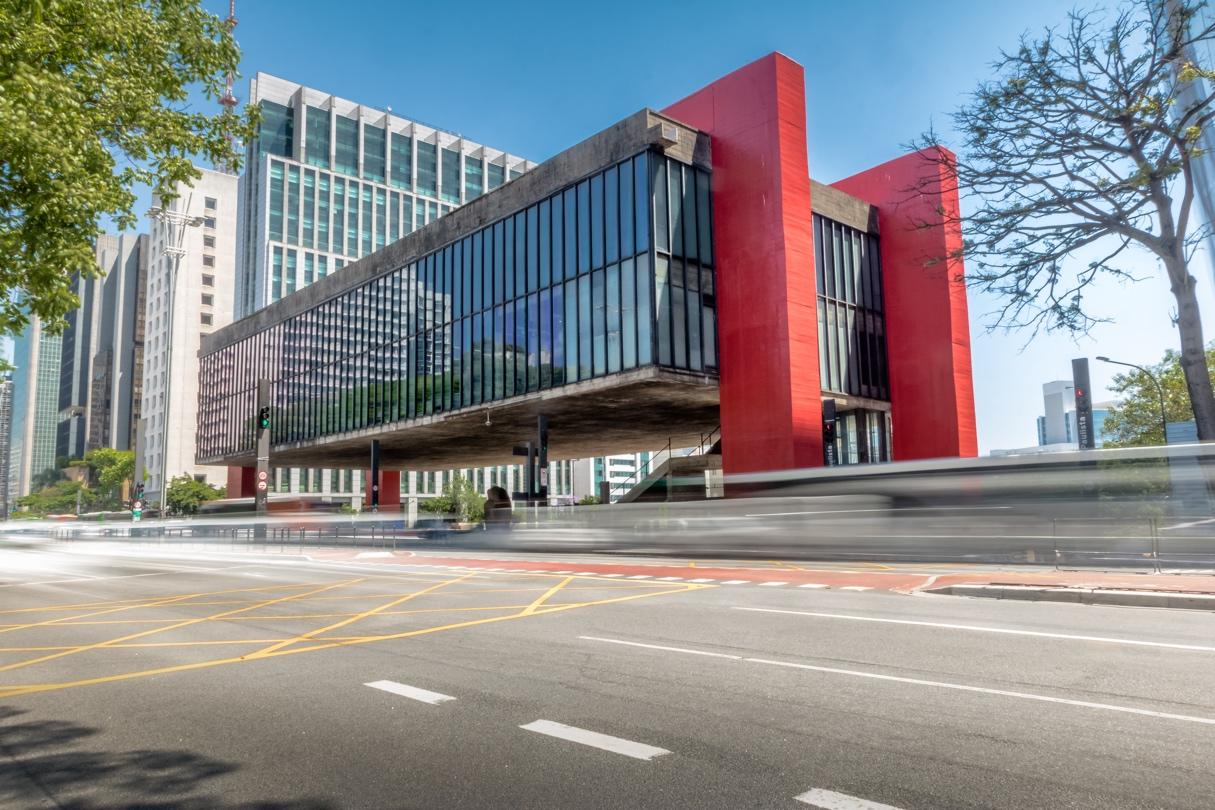
Art Style | Art & Culture International Magazine 77
Bardi, already envisioned a museum that would not only expand the Brazilian artistic territorialism, but also its borders by the possibility of becoming a “museum out of bounds,” as he, in addition to having a feeling for the arts, was also based on the concepts of the Bauhaus and the renowned architect Le Corbusier. In relation to the function of museums, Bardi had the assumption of establishing, together with Assis Chateaubriand, a new museum concept on Brazilian soil with the proposal of being a non-traditional museum and with the purpose of not only informing but forming a public that likes, understand and make art. Thus “to complete the didactic character of the art museum, the Institute of Contemporary Art (IAC) was created... the objective of forming an audience for the arts was fully achieved” (Bardi 1992, 84). In the IAC space, clothing would be one of the artifacts to be developed within a museum space for the purpose of commercialization.
Pietro Maria Bardi and Lina Bo Bardi, in addition to a couple, were partners in the creation and development of MASP. The repertoire of each, added together, resulted in the formula of the São Paulo Museum of Art. Together, they developed the museum’s form and content and implemented means of propagating art associated with design, such as the creation of the first school of industrial design (IAC) and magazines, such as Habitat, in which they spread new directions for artistic scientism. However, “if the museum collection, Habitat magazine and the IAC can be considered ‘the tripod that gave life to MASP’ in its first phase, two of the legs of this tripod were supported by the partnership Bardi and Lina” (Rubino apud Bonadio 2014, 43).
Art Style | Art & Culture International Magazine 78
What is latent in deepening the research on Pietro Maria Bardi’s performance at the head of artistic direction is his work for the visual construction of the MASP collection, specifically, for the inclusion and exhibition of clothing and textile artifacts, many of them selected through the eyes of the own. Bardi’s interest in inserting fashion culture articles in the collection of works at the São Paulo Museum of Art is due to his artistic philosophy, which considers fashion as one of the most important manifestations of art.
...Fashion is one of the important activities in the field of art, and even with its passing and variable times, it is linked with reciprocal influences that fashion brings to man’s life. ...The dress is for the body as style is for an age. On the other hand, it should be noted that a beautiful costume is worth as much as a good painting (Bardi apud Bonadio 2014)
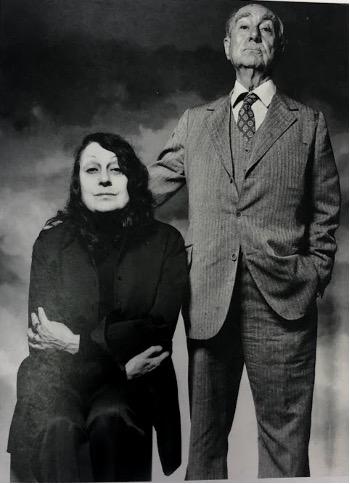
Art Style | Art & Culture International Magazine 79
Figure 2 Lina and P. M. Bardi, 1982 (Bardi 1992, 125).
In 1951, MASP’s collection of clothing began with the donation of some dresses created by Christian Dior and a dress created by Salvador Dalí, which were presented to the public at the great “Four Centuries of Fashion” show that was held at MASP’s Art Gallery. Institutional documents indicate that the donation was made by Paulo Franco, who was the owner of Casa Vogue, a significant luxury studio in the city of São Paulo. In this way, Paulo Franco would be an important partnership with MASP, both in the development of the fashion show and in the unfolding of the collection of clothing. The project for the fashion show would culminate not only in the much-desired collection of MASP clothing, but also in a pioneering act brought about by the initiative to present clothing as works of art in a museum space and then, to insert them as artistic objects through a process of patrimonialization. “For the first time, a museum hosts a fashion show; this initiative belongs to the São Paulo Museum of Art, which seeks by all means to distance itself from the field of traditional museography, in order to increasingly shorten the distance between the temple-museum and life” (Bardi 1993, 74).
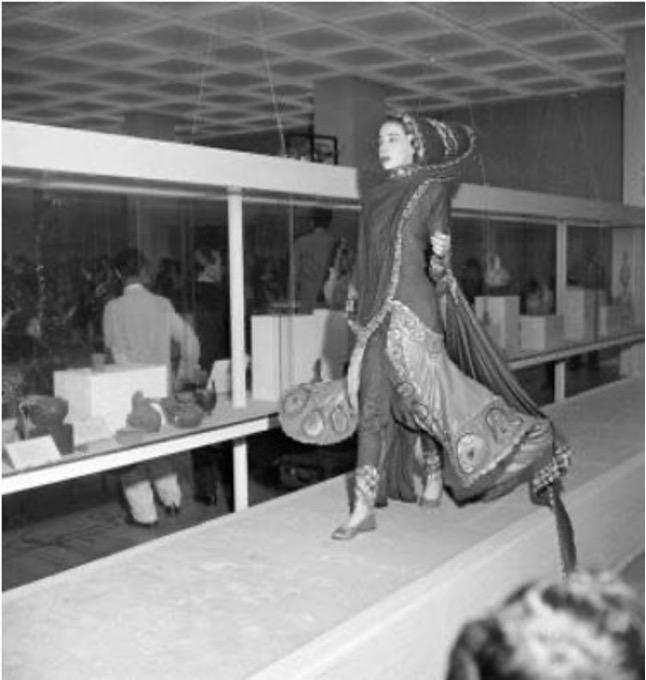
Art Style | Art & Culture International Magazine 80
Figure 3 Model of the Christian Dior dress in a fashion show that took place at the MASP Art Gallery, in 1951 (Instituto Moreira Salles apud Sales 2018)
The fashion show would also open up the possibility of new events of this kind, in the years 1952 and 1971, where clothes and art, again, would complete each other in the same space. In 1952, the fashion show Moda Brasileira took place, in which the proposal was to present a concept of national fashion, that is, inspired and produced in Brazilian territory. “From there, we decided to do nothing less than create a Brazilian Fashion... The inspiration was indigenous products, flora and fauna. And everything was produced in the museum, from the design to the manufacture of fabrics” (Bardi 1992, 17)

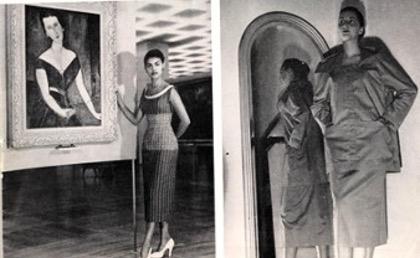
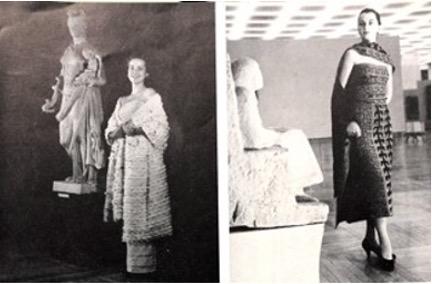
Art Style | Art & Culture International Magazine 81
Figure 4 Costume for the year 2045 of Salvador Dalí Dior Fashion Show, 1951, Box 04, Folder 22 (MASP Research Center Archive)
Figure 5 Images of the Moda Brasileira fashion show in the article in Américas Magazine, in December 1952 Moda Brasileira, 1952, Box 03, Folder 15 (MASP Research Center Archive)
Between November 17th and 30th, 1971, the exhibition Retrospectiva da Moda Brasileira was presented at MASP, as well as the costumes developed during the 60s, in partnership with artists and stylists, by the company Rhodia. During the exhibition period there were four fashion shows by the most influential Brazilian stylists of the time (MASP 2015, 6-7). From this partnership between MASP and the company Rhodia, in 1972, these pieces would be officially donated to the Art Museum of São Paulo. In 1975, the Rhodia collection would be exhibited again and, later, in 2015, it would be presented to the public with the title Art in Fashion: MASP Rhodia Collection
Today, when counting the time, we can see that almost seventy years ago started the Apparel collection with the astuteness of Bardi’s artistic direction. “Fashionclothing at MASP is treated as an object of artistic observation and an artifact of the universe of clothing that has aesthetic content for plastic fruition” (Sant’Anna 2010, 250).
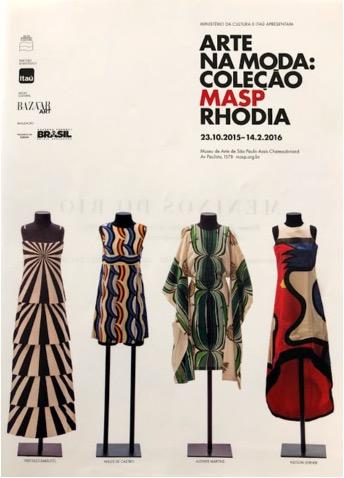
Art Style | Art & Culture International Magazine 82
Figure 6 Disclosure of the exhibition in Harper’s Bazaar magazine in October 2015. Art in Fashion Exhibition: MASP/RHODIA Collection, Box 471, 2015 (MASP Research Center Archive)
Analysis of the Christian Dior Dress-Work Pertinent to the MASP Collection
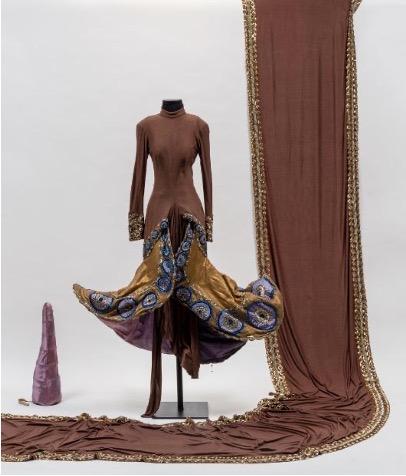
Dress-Work Through the Fashion Culture Perspective
Maison Dior appeared at the end of 1946 and already in 1947 it was established with the New Look style. Based on Christian Dior’s creative trajectory, which took place between 1947 and 1957, it is estimated that this dress, which was presented in a fashion show at MASP in 1951 and, sequentially, inserted as an object of the collection, has been developed in the late 40s and early 50s, that is, the investigated dress appears in a post-war panorama. According to “the atmosphere in Paris in the 50s was sophisticated: women should look like they took the time to look perfectly groomed. “Beauty” became a topic of great importance as soon as the post-war scarcity of cosmetics ended” (Laver 1989, 260) Thus, the analysis from the Culture of Fashion perspective points out that the Christian Dior dress:
Art Style | Art & Culture International Magazine 83
Figure 7 Dress created by Christian Dior MASP Research Center Archive
1. Features the following characteristics: “Material Type: Organic\Plant-based fabric: Satin” (MASP Research Center Archive), in colors: brown, gold and blue; modeling: dress with long sleeves, cuff details and long skirt with frame to generate movement.
2. It was developed in the late 1940s and early 1950s, in a post-World War II panorama.
3. It is inspired by the “Persian civilization” (MASP Research Center Archive), which is very different from the research sources of Christian Dior, who was used to creating referring to the French 18th and 19th centuries.
4. Has a conceptual appeal instead of commercial
5. The fashion show was used in 1951 as a means of expansion, both for Dior and for MASP
Dress-Work Through the Artistic Perspective
To create Dior was inspired by the memories of his former residence in Granville, the beauty of the French 18th century and Art Nouveau “Dior had an important career as a gallery owner and art collector, especially antiques and objects from the Art Nouveau period, as well as maintaining a great admiration for the French 18th century” (Sales 2018, 85).
Imagery Relationship Between Dress-Work and Art Nouveau
It is a dress predominantly in brown, gold and blue with circular images along the hem and details on the sleeves. The images suggest circles placed along the bar highlight a kinesis. Knowing Dior’s fascination with Art Nouveau, we can associate these images with the organic concept due to its shape, structure and curved lines. During the image analysis, it was possible to find an imagery and conceptual relationship between the Christian Dior dresses and the painting Dânae (1907) by Gustav Klimt, an artist who greatly benefited from the Austrian Secession Movement, an artistic current that similarly conceptually to Art Nouveau
Art Style | Art & Culture International Magazine 84
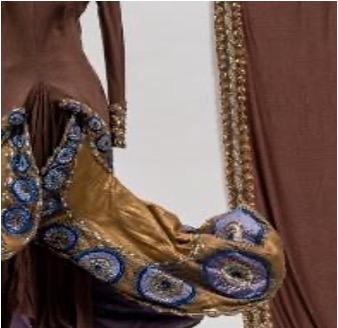
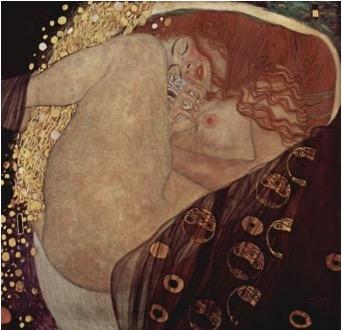
Art Style | Art & Culture International Magazine 85
Figure 8 Christian Dior dress detail MASP Research Center Archive.
Figure 9 Gustav Klimt, Dânae, 1907-1908. The Yorck Project (2002) 10,000 Meisterwerke der Malerei © DIRECTMEDIA Publishing GmbH. Licensed under CC-BY-SA
Dress-Work Through the Museological Perspective
The research points to the inclusion of the Christian Dior dress in the MASP collection, due not only to the museum’s political philosophy and its artistic director, Pietro Maria Bardi, but also to the fashion culture movement and its social influence. Another point to be highlighted is the fact that Christian Dior himself is adept at making donations of his creations to museums, “Christian Dior was a donor of dresses from his own collections and had the knowledge and insertion of fashion collecting in the institutions of his time” (Sales 2018, 110).
Dress-Work Through the Memory Perspective
Analyzing the memorial perspective of this Dior dress provides us with memories or knowledge of sometime (Persian civilization) and/or artistic associations (Art Nouveau), considering that “Christian Dior’s work is a treasured memory” (Martin and Koda 1996, 9)
Dress-Work Through the Patrimony Perspective
MASP’s interest in patrimonializing costumes denotes a national pioneering spirit and already anticipated a trend that was common, both in European and North American museums. Although Pietro Maria Bardi is a foreigner at the head of a Brazilian museum, the merit of his work in tirelessly seeking to insert clothing into the art world should be highlighted, giving it the status of an object-work of art. In this sense, the “question of patrimony raised a typology of objects whose range is constantly increasing, as if it responded to a universal repertoire in which it assumes the inclination of the moment” (Poulot 2011, 479)
Dress-work by Semiotic Analysis Approach
When analyzing the imagery load of the Christian Dior dress, we are faced with a universe of signs that direct us to a complex chain of meanings that “ can contribute a lot to the understanding of the phenomena that surround fashion and its relationship with the human being” (Castilho and Martins 2005, 21). For Barthes, fashion “could be singled out as one of the most significant objects of mass culture as it undoubtedly represents one of the greatest contemporary myths” (Werneck 2008, 109). Based on the Barthesian premise that fashion culture is permeated by elements of meaning, we can evidence in the Dior dress interpretive signs of art (Art Nouveau), time (Persian civilization) and fantasy (ethereal composition).
Art Style | Art & Culture International Magazine 86
Analyzes of the Salvador Dalí Dress Relevant to the MASP Collection
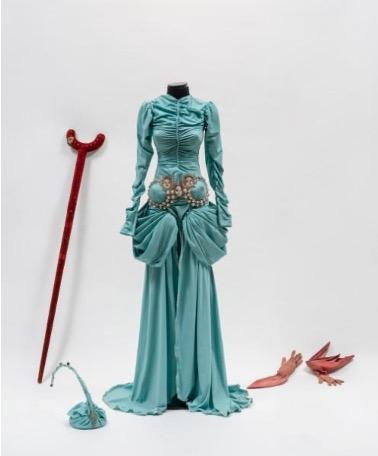
Art Style | Art & Culture International Magazine 87
Figure 10 Dress created by Salvador Dalí entitled Costume for the year 2045 MASP Research Center Archive
Dress-Work Through the Fashion Culture Perspective
The Salvador Dalí dress included in MASP’s clothing collection has genuinely surreal characteristics, both because its creator was a great artist of this artistic trend, and because the costume itself supports the surreal concept. The costume was designed by Dalí on the occasion of the fashion show that took place in 1951 at the MASP art gallery, but its sewing was carried out by the Russian seamstress Karinska at Casa Vogue (which included a headquarters of Casa Dior in Brazil), owned by Paulo Franc. “According to an article published in Jornal da Tarde in 1986, the Costume was designed especially for MASP, based on a request by Pietro Maria Bardi, director of the Museum, to Paulo Franco” (Crispi apud Bonadio 2014, 44-45). In addition to the Costume for the year 2045 and the costumes developed in partnership with the Italian stylist Schiaparelli, Dalí, throughout his artistic trajectory, has developed numerous products relevant to the Culture of Fashion, including: clothing, accessories, jewelry and prints. Thus, the analysis from the Culture of Fashion perspective points out that the Salvador Dalí dress:
1. Features: Dress: “Type of Material: Organic\Fabric of plant origin: Fiber” (MASP Research Center Archive), in color: blue; modeling: dress with long sleeves, silver details on the hips and long skirt with drapes in its composition; turban: the same material as the dress, that is, fiber of vegetable origin and crutch: solid structure covered with red fabric
2. It was developed in the late 40’s or early 50’s, in a post-World War II panorama
3. It is inspired by the surrealist artistic current, which is very similar to Dalí’s references
4. Has a conceptual appeal instead of commercial.
5. The fashion show was used in 1951 as a means of expansion, both for Dalí and for MASP.
Art Style | Art & Culture International Magazine 88
Dress-Work Through the Artistic Perspective
Dalí called himself the surrealism itself It is not impossible to disagree with an artist who has registered his own impressions of hyper-reality, often of a personal nature, in his works. His creative journey, which features autobiographical narratives, resembles a diary. Dalí, formidably, between “be and to be” surreal, eternally, is. The Costume for the year 2045 derives from a surrealist artist and, therefore, from the artistic current of Surrealism.
Imagery Relationship Between Salvador Dalí Dress and Surrealism
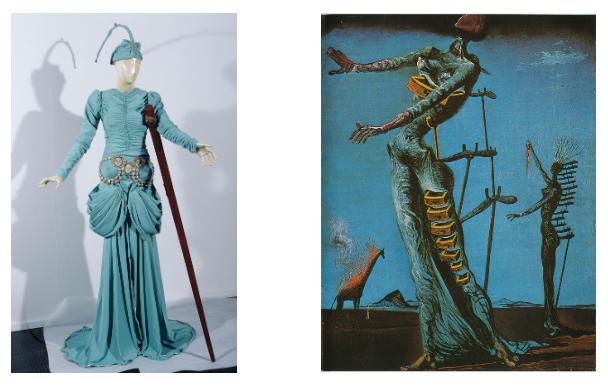
The Costume for the year 2045, developed by Salvador Dalí in the mid-1940s or early 50s, is by nature a surreal dress. When we observe the artistic features of this dress, one finds, of course, associations with Dalinian works and, therefore, with the concepts of Surrealism. Analyzing the works developed throughout Dalí’s career, it was possible to see similarities between the Costume for the year 2045 and the works The Burning Giraffe (1936-1937) and Portrait of Katharina Cornell (1951) by the artist himself. Coincidentally, or not, Dalí materializes these famous works in Costume for the year 2045. This analysis can be considered by the similarity of the set of garments (dress, turban and crutch) in the aforementioned works

Art Style | Art & Culture International Magazine 89
Figure 11. Salvador Dalí Dress, 1951 (MASP Research Center Archive) Figure 12. The Burning Giraffe, 1936-1937 (Gaillemin 2004, 75).
In The Burning Giraffe (1936-1937) the analogy occurs in the presence of a bluish long dress, both in the painting and in the dress made of fabric, as well as the inclusion of the crutch in the artist’s two representations. The work The Burning Giraffe has many significant elements of the surrealist oneiric concept, which Dalí used with great mastery.
In Portrait of Katharina Cornell (1951), there is a representation of a female figure wearing a long dress and turban, however, in red, very similar to the Costume for the year 2045. The crutch, too, is portrayed in this image. This work is made up of many figurative elements, in which a woman in profile serves as the background for other images. Thus, during the analysis of these images, it was possible to find an imagery and conceptual relationship between the Costume for the year 2045 and the surrealist artistic current.
Dress-Work Through the Museum Perspective
The inclusion of the Salvador Dalí dress in the MASP collection occurs similarly to the Christian Dior dress, as both derive from a fashion show that took place at the MASP gallery, in 1951. “The museum object is not the same thing as the object in the museum, so that its attribution of value is less linked to its institutional status and more determined by the social frameworks that gave them the museological status” (Brulon 2017, 412).
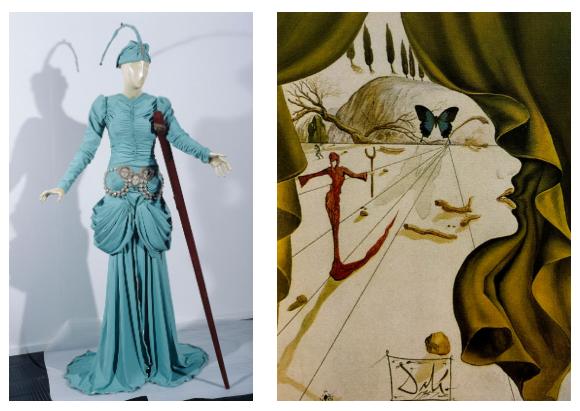

Art Style | Art & Culture International Magazine 90
Figure 13 Salvador Dalí Dress, 1951 Source: MASP Research Center Archive Figure 14 Portrait of Katharina Cornell (Borghesi 2009, 115).
Dress-Work Through Memory Perspective
Dalí’s life and memories of him are constantly revived and present in his creative process. He was an artist who made his innermost thoughts the raw material of his works. These works often have an autobiographical context. “Dalí, the mnemonic, cultivates memory with the prodigious ability to reuse at every moment “buried moments” that impose themselves with the intensity of an absolute present” (MNBA and MASP 1998, 11).
Dress-Work Through the Patrimony Perspective
The motivation for the patrimonialization of the Salvador Dalí dress is due to the fact that it was a dress idealized by the artist as a result of the fashion show that took place at MASP in 1951, as well as its donation, intermediated by businessman Paulo Franco, after the fashion show. Currently, the Costume for the year 2045 has a high patrimonial value, due to the importance of its creator. This value had already been perceived, in 1951, visionary, by Pietro Maria Bardi.
... the meaning of a patrimony is largely identified with the tradition of artistic literature and, very early on, it brought together renowned artists and artisans dedicated to the creation of a territory and a repertoire of its monuments, its collections and its masterpieces (Poulot 2011, 472)
Dress-Work by Semiotic Analysis Approach
In the Costume for the year 2045, as it is a surrealist costume, the signs are diverse and their imagery loads even greater, mainly because we have the possibility to glimpse imagery similarities between the Dalinian costume and his works The Burning Giraffe and Portrait of Katharina Cornell. Of all the signs present in the Costume for the year 2045 and in the aforementioned works, the element of the crutch was the most used by Dalí during his artistic trajectory. In the Dalinian concept, the crutch refers to “fantasy” (MNBA and MASP 1998,13), “impotence and senility”, as well as representing a sexual context by relating the elongated images to the sexual organ (Dali 2004, 179)
Art Style | Art & Culture International Magazine 91
Analysis of the Nelson Leirner Dress Relevant to the Collection
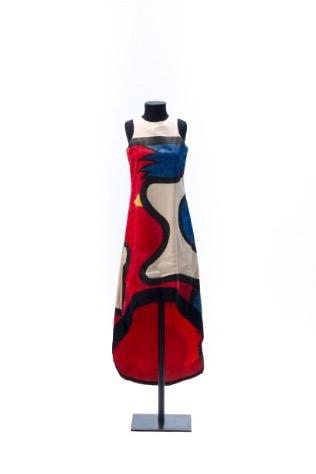
Dress-Work from the Fashion Culture Perspective
As it was already known that MASP, since the 50s, had been interested in packaging clothing for the development of a vast collection, thus, in 1972, the company Rhodia would donate a collection consisting of 79 outfits developed in common by the greatest stylists and artists of the time. The dress developed by artist Nelson Leirner in partnership with stylist Ugo Castellana and costume designer Alceu Penna was chosen for this research, exclusively due to the professional trajectory of each of those involved in this project, however, the questioning path prevailed as a decisive point for this choice by the artist Nelson Leirner on the Art Institution system, which comes to commune with some precepts of Pietro Maria Bardi. Nelson Leiner, together with Ugo Castellana and Alceu Penna, carried out a project, simultaneously, of an artistic nature and of fashion culture, with the purpose of industrializing the raw material of the company Rhodia. Today, in the eyes of MASP, the dress perpetuates as a faithful document on the trajectory of fashion and art in the country in the 60s Thus, the analysis from the Culture of Fashion perspective points out that the Nelson Leiner dress:
Art Style | Art & Culture International Magazine 92
Figure 15 Dress with print developed by Nelson Leirner; illustrated by Alceu Penna and stitched by Ugo Castellana MASP Research Center Archive
1. Features: “Type of Material: Organic\Organic of natural origin\Processed of natural origin\Tissue of plant origin” (MASP Research Center Archive); with print in black, white, yellow, red and blue “with abstract motifs (Pop Art)” (MASP Research Center Archive) and modeling: sleeveless dress, with a longer back, resembling a tail
2. It was developed in 1968, during a panorama of Tropicalism in Brazilian lands
3. The print is inspired by Pop Art and abstractionism, recurrent artistic concepts in Leirner’s trajectory
4. The dress modeling, despite presenting a conceptual appeal, proposes the sale of the raw material developed by the company Rhodia.
Dress-Work Through the Artistic Perspective
The investigated dress has in its print traces of Abstract art and Pop Art, artistic concepts, recurrently present in Nelson Leirner’s creative process.
Imagery Relationship Between the Nelson Leirner Dress, Abstract Art and Pop Art
Crossing the curatorial data inserted in the catalog card of the MASP Research Center with Nelson Leirner’s artistic trajectory, we can identify direct relationships with the abstract art and Pop Art currents. During this investigation, it was possible to promote the meeting imagery between the dress studied with the works of artists Mondrian and Andy Warhol.
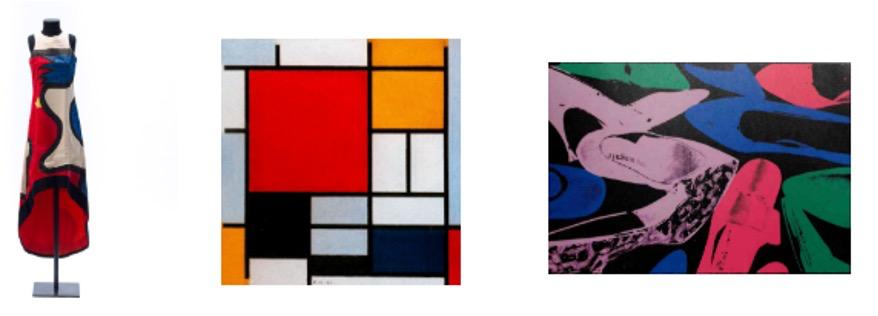
Art Style | Art & Culture International Magazine 93
Figure 16. Nelson Leiner dress: “Composition with Large Red Plane, Yellow, Black, Gray and Blue,” Mondrian (1921) and Diamond Dust Shoes, Warhol (1980). MASP Research Center Archive (Milner 1992, 160; Bolton 2002, 37)
Dress-Work from a Museological Perspective
MASP is a museum that, since its foundation and idealization, has proposed to store clothing in its museum space, therefore, the Rhodia collection enters this environment and becomes a collection of museum objects due to the characteristics of their developments, through the artistic and stylistic link of those involved in this great project. The discipline of museology is divided into two stages: “practice which could or may not be limited to the empirical universe of museums and theoretical reflection that would make professionals or museologists instead of technicians, thinking beings” (Brulon 2017, 408)
Dress-Work from the Memory Perspective
“Places of memory are born and live from the feeling that there is no spontaneous memory, that it is necessary to create archives, that it is necessary to keep birthdays, organize celebrations, pronounce funeral eulogies, notarize minutes, because these operations are not natural” (Nora 1993, 13). Through Nora’s narrative, we can associate the performance of Rhodia and MASP as guards of a memory that is protected in the technical reserve collection of this museum institution.
Dress-Work from Patrimony Perspective
The patrimonial value of the Nelson Leirner dress is given by the character of the link between the company Rhodia and MASP, betting together that the Rhodia collection should be stored in a museum space and exhibited as a significant set of works, noting that “the appropriation takes the form of an imaginary community, and the protection of patrimony is generally accompanied by a belief in progress” (Poulot 2008, 30)
Dress-Work by Semiotic Analysis Approach
In this dress, unlike, Leirner made clear the motto of his inspiration, that is, the roots of the artistic movements that generally lead him. The elements present in the composition of the print, derived from the abstract artistic currents and Pop Art, become the signs that validate the semiology invested here. “...real clothing is embarrassed by practical purposes: protection, modesty and adornment... image-clothing retains, however, a value that can considerably embarrass the analysis and that is its plastic” (Barthes 2009, 8).
Art Style | Art & Culture International Magazine 94
Discussion
This study sought to develop an analysis of the importance of the clothing collection of the São Paulo Museum of Art Assis Chateaubriand (MASP) by highlighting the textile artifacts inserted in its museum space as significant vectors for the dissemination of art and fashion culture as well as guide the reflection on the processes of patrimonialization of clothing. Despite the skepticism of some scholars in relation to fashion, many other theorists dedicated investigations that made it possible to broaden the repertoire regarding the various operating perspectives of fashion culture and, thus, reduce gaps in its understanding. From the work of these thinkers, a path of elucidation was made in the significant trajectory of fashion. However, it is not enough for clothing and textile artifacts to receive their proper certifications as artistic objects from the art system Unlike the disbelief and the classifying practice of art institutions, Pietro Maria Bardi, together with his wife Lina Bo Bardi, conceived the MASP with the purpose of being “ a museum out of bounds” so limitless that it would create a collection of clothing, in 1951, through a fashion show held at the museum’s own art gallery, where mannequins paraded designs developed by Christian Dior and Salvador Dalí, among renowned works of art, known as “major” In this way, Bardi would not recognize clothing and textile artifacts as an artistic object, but also as items that can be patrimonialized and musealized
Minds like Pietro Maria Bardi, who did not see inequalities in differences, should be a greater constant in the métier of those who have the challenge of stipulating the concept regarding whether objects are or are not art because “defining art is such an elusive task that the almost comical inapplicability of the philosophical definitions of art to art itself has been explained, by the few who perceived this inapplicability as a problem, as a result of the indefinability of art” (Danto 2005, 26). Thierry de Duve confronts the art system by proposing another possibility of encoding or recoding about the transit to the artistic universe, as “artistic practice would be nothing more than a social game whose codes and passwords would symptomatically signal that some rules should replace the métier for the fullness of the artist’s professional game (Duve 1998, 129). The use of clothing as an artistic support was a common practice until the mid-19th century, when “artists who until then were arbiters of taste lost their influence on the creation of costumes and were replaced, in this area, by seamstresses, today called of stylists (Costa 2009, 8). Despite this separation of functions, where seamstresses and/or stylists (according to the period analyzed) started to idealize customs, instead of artists,
Art Style | Art & Culture International Magazine 95
it is clear that both areas, simultaneously, “drink from their sources”, still nowadays, that is, art uses clothing as a support, while fashion culture is supplied with artistic resources as a creative repertoire. It is understood that “art and clothing are cognate, that is, languages related to a common root in their DNA, which often communicate or are merged” (Costa 2009, 75). The intersection between art and fashion culture is made explicit in the course of the analysis of the three dresses included in the MASP technical reserve collection, as when we detail the creators of these outfits and their trajectories as artists and stylists, we realize how directly related these two media are, art and fashion.
Christian Dior begins his career as an art dealer and, by life’s purpose, becomes a great stylist and icon of fashion culture by creating his garments inspired by Art Nouveau; Salvador Dalí, the ultimate representation of Surrealism, woos with the development of fashion culture products and inserts in his creative repertoire clothing not only with an artistic support, but also, such as consumer items and Nelson Leirner, heir of a textile company, makes his artistic production through questions about the art system; is inspired by Pop Art, which has consumerism and mass culture in its DNA and uses clothing as the basis of its artistic interventions In this way, three artists-stylists and three dresses-works together materialize the significant trajectory of clothing, today, heritage in the technical reserve collection of the São Paulo Museum of Art Assis Chateaubriand, through certification as a work of art by the art dealer Pietro Maria Bardi
Author Biography
Cybelle Lima is a researcher at CNPq/UNICAMP Research Group “Culture and Memory: Dialogues of Permanence and Innovation in the Research Field Space, Aesthetics and Memory, Transdisciplinary Articulations in Art, Architecture, and Design” under the supervision of Prof Dr. Haroldo Gallo. She is currently developing her research project as a doctoral candidate on the processes of preservation of the textile artistic heritage in museum collections. She holds a Master of Visual Arts from the Institute of Arts, in the research line History, Theory and Criticism (HTC), University of Campinas (UNICAMP), ranked as one of the best universities in Latin America. Also, she received a nomination for publication by the advisory committee of her UNICAMP master dissertation on Textile Artistic Heritage. She has a Bachelor of Arts degree in Fashion Stylism, Higher Course of Technology from the Catholic College of Ceará, and a specialization in Teaching and Vocational Education, Basic and Technical levels from the Federal Institute of Education, Science, and Technology of Ceará (IFCE). She worked as a teacher and advisor of the Technical Course in Clothing Design at the Center Technological Education Institute (CENTEC). Her recent works include her interest in the Design area, with an emphasis on Fashion Culture and its representativeness as Textile Artistic Heritage.
E-mail: cybelle.souzalima@gmail.com ORCID: https://orcid.org/0000-0001-7339-1370
Art Style | Art & Culture International Magazine 96
Note
1 Unless otherwise noted, all translations are my own.
Bibliography
Arquivo do Centro de Pesquisa do MASP. Documentos institucionais e curatoriais São Paulo: MASP.
Bardi, Lina Bo. Lina Bo Bardi São Paulo: Instituto Lina Bo e P. M. Bardi, 1993.
Bardi, Pietro Maria. História do MASP. São Paulo: Empresa das Artes, 1992. Instituto Quadrante.
Barilli, Renato. Os estilos na arte Art Nouveau. São Paulo: Martins Fontes, 1991.
Barthes, Roland. “Retórica da Imagem.” In O óbvio e o obtuso. Lisboa: Edições 70, 2009.
Bolton, Linda. Andy Warhol: Artists in their time Franklin Watts: 2002.
Bonadio, Maria Claudia. A moda no MASP de Pietro Maria Bardi (1947-1987). Anais do Museu Paulista, vol. 22, nº 2 (July-December), 2014.
http://www.scielo.br/scielo.php?script=sci_arttext&pid=S010147142014000200003
Borghesi, Silvia. Dalí. Salamanca: Electa, 2009.
Brulon, Bruno. “Provocando a Museologia: o pensamento geminal de Zbynek Zbyslav Stránský e a Escola de Brno.” Anais do Museu Paulista. v. 25. n. 1. (January-July) 2017: 403-425. http://www.scielo.br/pdf/anaismp/v25n1/19820267-anaismp-25-01-00403.pdf
Castilho, Kathia and Marcelo Martins. Discursos da Moda: semiótica, design e corpo. São Paulo: Editora Anhembi Morumbi, 2005.
Costa, Cacilda Teixeira da. Roupa de Artista: O vestuário na obra de arte. São Paulo: Imprensa Oficial do Estado de São Paulo: Edusp, 2009.
Dali, Salvador. Dali: 1904-2004. Barcelona: Península, 2004.
Danto, Arthur Coleman. A transfiguração do lugar-comum: uma filosofia da arte. São Paulo: CosacNaify, 2005.
Duve, De Thierry. “Kant depois de Duchamp.” Revista do Mestrado em História da Arte, 1998.
Gaillemin, Jean-Louis. Dalí: The Impresario of Surrealism. London: Thames & Hudson, 2004.
Jimenez, Marc. O que é estética? São Leopoldo: Unisinos, 1999.
Laver, James. A roupa e a moda: uma história concisa. São Paulo: Companhia das Letras, 1989.
Martin, Richard and Harold Koda Christian Dior. New York: The Metropolitan Museum of Art, 1996.
MASP. A arte na moda: Coleção MASP e Rhodia. São Paulo: MASP, 2015. . Museu de Arte de São Paulo Assis Chateaubriand. https://masp.org.br/
Art Style | Art & Culture International Magazine 97
MASP and MNBA. Dali monumental. Museu de Arte de São Paulo Assis Chateaubriand and Museu Nacional de Belas Artes. Rio de Janeiro/São Paulo, 1998.
Neira, Luz García. “Têxteis como patrimônio cultural.”Cultura Histórica & Patrimônio, v. 3, n. 1 (2015).
https://publicacoes.unifalmg.edu.br/...php/cultura_historica_patrimonio/...neira/ 262
Poulot, Dominique. Uma história do patrimônio no Ocidente, séculos XVIII-XIX. Do monumento aos valores. São Paulo: Estação da Liberdade, 2009. Sales, Milena Melo. “Desejos frustrados na formação de um colecionismo de moda no MASP: as aquisições dos vestidos de alta-costura Dior e Lanvin.” Master Dissertation, University of São Paulo, Museu de Arqueologia e Etnologia, Programa de Pós-Graduação Interunidades em Museologia, 2018.
http://www.teses.usp.br/teses/disponiveis/103/103131/tde-25092018143351/pt-br.php
Sant’Anna, Patricia. “Coleção Rhodia: arte e design de moda nos anos sessenta no Brasil.” PhD Thesis, UNICAMP, Instituto de Filosofia e Ciências Humanas, 2010.
Schneid, Frantieska Huszar, Lorenzon Manuela Gastal, Olívia Silva Nery and Tereza Cristina Barbosa Duarte. “Moda, arte e museu: a indumentária inserida em um espaço memorial.” 10º Colóquio de Moda, 7ª Edição Internacional, 1º Congresso Brasileiro de Iniciação Científica em Design e Moda 2014.
https://www.coloquiomoda.com.br/anais_ant/anais/10-Coloquio-deModa_2014/COMUNICACAO-ORAL/CO-EIXO3-CULTURA/CO-EIXO-3-Modaarte-e-museu.pdf
Souza, Gilda de Mello. O espírito das roupas: a moda do século dezenove. São Paulo: Companhia das Letras, 1987.
Werneck, Mariza. “Roland Barthes, a moda e as assinaturas do mundo.” IARA, Revista de Moda, Cultura e Arte. v.1 n. 1 (2008).
https://docplayer.com.br/7768858-Roland-barthes-a-moda-e-as-assinaturas-domundo
Art Style | Art & Culture International Magazine 98
An Aesthetics Path From Giorgione’s Joie de Vivre to Callas’ Cinematographic Opera
Iria-Friné Rivera Vázquez
Abstract
Aesthetics as a transcendental experience is a rare privilege of Art. It is the ultimate expression of Humanity, to the point that it was Stendhal who coined the impression he suggested. It was with him, and his own name, with whom the Stendhal Syndrome was coined precisely for this reason: the effects of the sublime of the work of Art in the spiritual and in the physical in equal parts. This was not an exclusive observation of the 19th century, nor was it a theorization of the 20th century. It is an element that is the fruit of genius and that has acquired a value of increasing dimensions throughout History, being studied, assimilated, considered and used in order to give ornament and splendor for prestige and interest in the public and social spheres. This article is focused precisely on that journey and on the values that were added over time to the concept of “aesthetics ” The decision to start this journey from the Renaissance is based on the fact that it was from the sixteenth century when the idea of artistic patronage, splendor and liberality linked to a city or surname, took on a new facet. Of course, this already appeared since Antiquity, but since the fifteenth century such issues began to play a proactive role in what was the birth of the Modern Era. This role was to create an aura that conveyed an idea of taste, but then it morphed into something more: a sense of style, of proceeding, of highmindedness. Such was its relevance that it maintained its validity, leaving its mark in new artistic media such as cinema and in those, such as opera, in which very different artistic branches meet.
Art Style | Art & Culture International Magazine 101
It was in the 19th century when some of the personalities appeared who, to a greater extent, elevated the term aesthetics to a lifestyle. It was no longer a philosophical concept as was the case with Kant, nor an idea of the State as with Augustus. Aesthetics now appeared from the pure perspective of Art. And this meant that, above all, Art was understood as a transforming element. For centuries, paintings, sculptures, illustrations or buildings had served to give a face to nations, kingdoms, governments and citizens as a society. But it was in this century when Art was discovered in another facet, which was no less impressive because it was new. It dealt with the idea of aesthetics in life, in the sense in which Art becomes the ultimate goal in shaping existence.
This idea, which at first can be isolating when concentrating above all on the nature of a single individual, nevertheless turned out to be the catalyst for one of the most notable aspects of contemporary times. It’s about individuality and personality. In the 20th and 21st centuries such a question would be taken to a Shakespearean level. But its origin, its seed, was in figures such as Oscar Wilde (1854-1900), Luisa Casati (1881-1957) and companies such as the Russian Ballets of Sergéi Diagheliev (1872-1929). In all of them, aesthetics acted as an epicenter, a catharsis or a liberation. The value that all of them gave to Art cannot and should not be underestimated. But this mentality was the result of crossing different ideas that were floating in the air. It was the moment when British Aestheticism and nineteenth-century German philosophy had raised the appreciation of Art to a new existential level. Romanticism had understood the potential that the artistic had in terms of individual projection. At the end of the century such a concept brought Art into life and life as an artistic element. And that included an education, an appreciation of the visual arts, often linked to collecting and public image.
This was by no means new. In Renaissance Italy patronage, public image and Art were a cultural paradigm that evolved over time. But this was also the time when, following the line of anthropocentrism of classical cultures, the individual began to be a value to be taken into account. The same can be said of understanding the experience of a lifestyle surrounded by the ornateness of Beauty, be it fantastic (as in Bomarzo’s Sacro Bosco or the Villa di Pratolino) or delicately regal elegance (Versailles). Those were years in which aesthetic impression was understood, cultivated and used. And it was done with such mastery, great works of art were achieved that even today continue to be visual references for very different branches. This article takes a tour of some of them, starting from the Venice of the 16th century to continue through the following centuries observing the way in which Aesthetics has not only been a way to see but also a content to experience.
Art Style | Art & Culture International Magazine 102
Introduction
Return to Venice: The Human in the Divine and the Divine in the Human
In 1510 the painting Country Concert was completed (fig 1). Giorgione (1477/78-1510) has been cited as his main hand, being Titian (1488/90-1576) his finisher. It is a beautiful work in which one of Giorgione’s great steps is captured. His career was distinguished by the use of the sfumatto to mold the figures. It is therefore not surprising that his meeting with Leonardo Da Vinci (1542-1519) in 1500 was of great importance, as Giorgio Vasari (1511-1574) testifies. Both had begun to explore the possibilities of the atmosphere. Their respective works served to mark the maturity of the Renaissance. The Quatroccento (1350-1464) was predominantly influenced by Florence. Cold colors, delimited outlines, mathematical perspectives, and definite figures are characteristic of the Florentine School. His opposition was the Venetian School. The Cinquecento (1500-1599) was its Golden Age. And Giorgione was the one who started the artistic empire of the Queen of the Seas. It is significant that the Country Concert, although not entirely by him, was completed by Titian. It would be this painter who would complete the triumphant quartet along with Tintoretto and Paolo Veronese (1528-1588).
Even with the difference in style of the three painters, Giorgione, Titian and Tintoretto (1518-1594) cultivated a sense of atmosphere that distinguishes them from Da Vinci. The Tuscan artist printed a classical lees stamp on his work. The Florentine influence is still well noticeable in it: balanced compositions and harmonious and proportionate figures. Its very atmosphere was mainly scientific His geographical studies and his observations of Nature made him see the way in which the air can modify the perception of people or landscapes at a long distance. La Gioconda (1503-1519) or Bacchus (fig. 2) show to what extent the atmosphere and perspective worked so that it was adjusted by the mechanisms of the human eye. But in the same way, he manages to externalize how enigmatic Nature was for the human being at that time. And even the mystery that lives within the human character itself.
Art Style | Art & Culture International Magazine 103
Copyright:
Copyright:
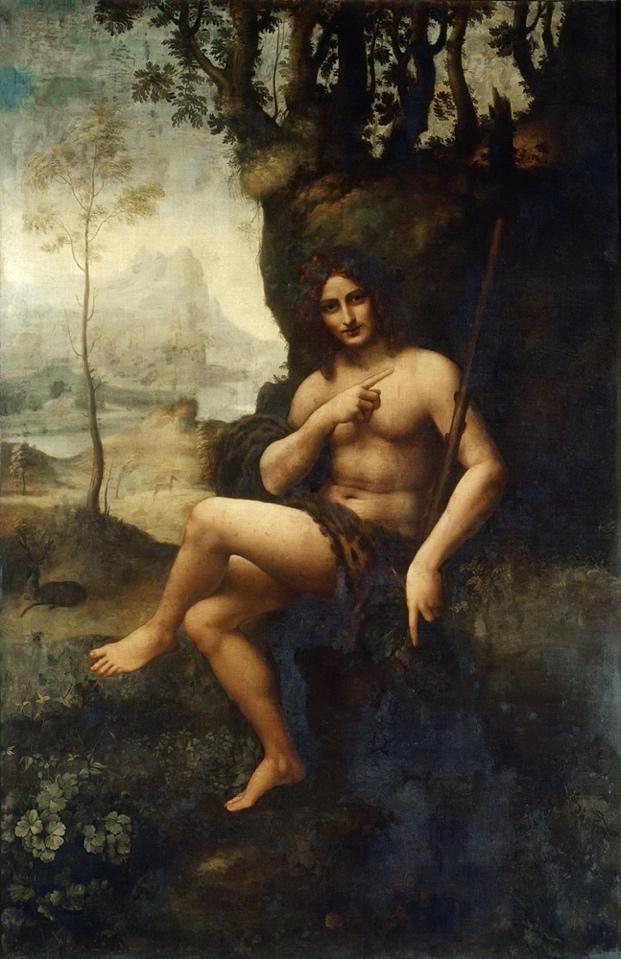
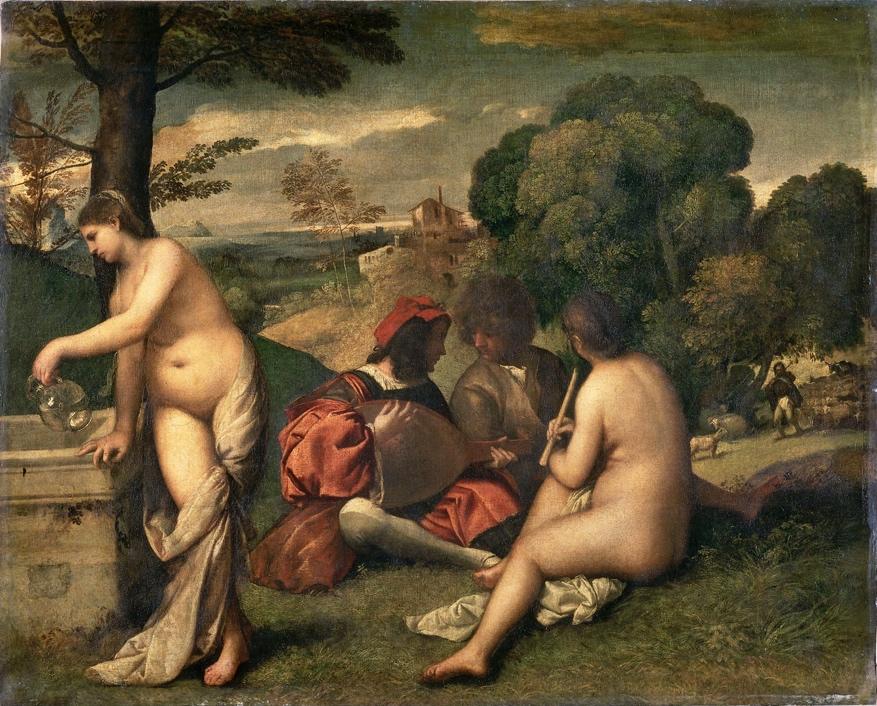
Art Style | Art & Culture International Magazine 104
Figure1. Giorgione – Titian. Country concert. 1510. Technique: Oil on panel. Measurements: 118 x 138 cm. Paris, Louvre Museum
U.S , public domain.
Figure 2. Leonardo Da Vinci. Bacchus. Technique: Oil on canvas. Measurements: 177 x 115 cm. Paris, Louvre Museum
U.S , public domain.
The Venetian triumvirate has the same humanist approach. But its atmosphere does not correspond to science. It corresponds to the Venetian atmosphere. On the streets, in the palaces, in the churches, rich fabrics from the Near East, sumptuous and exclusive shades, embroideries and rare jewels appear one after the other before the eyes of artists. The shine of the blond hair of the abundant manes of the ladies. The climates also educate the eyes. And this had a deep echo in them. As well as the influence of the Flemish artists from the North, from whom they learned to capture fresh and lively colours. But what differentiated Venetian painting already at the gates of Mannerism is its expressiveness. Da Vinci’s atmosphere was scientific. That of the Venetians projects the human spirit. The Country Concert is an image that celebrates life. Alludes to freedom and the five senses. And the atmosphere contributes to it: the silks and the air caress the bodies, the mind and the ears rest with the music, the sight is delighted with the calm landscape and the fruits and the fresh milk allude to the taste, while the grass turned into an embroidered rug recreate the sense of smell. The figures are perfectly integrated into the landscape, without appearing rigid. (Until then, the landscape was made based on the figures represented). For the first time the landscape breathes, as do the people in it. And so the atmosphere becomes relevant: it is not just a scientific consequence. It is a plastic element with its own entity.
Titian elevated it to the lyrical. No wonder his paintings especially mythological due to the warm and bright atmosphere were called Ut pictura poesis. But if Titian is the bright side, Tintoretto is its dark reflection. His diagonal perspectives from him contribute to the dramatic sense of his paintings. Tintoretto stages stories. But like any setting, he makes use of atmospheres: dense, contrasting and that give a pictorial reply to the sculptural terribilitá of Michelangelo (1475-1564). The hedonistic atmosphere that characterized Giorgione and most of Titian’s productions is here metamorphosed. The light, the air energetically points out exceptional situations of the human being. But what it does is complete his humanist approach, in his case in the context influenced by the precepts of the Counter-Reformation Ecumenical Council of Trent (1545-1563) and the Wars of Religion (1562-1598).
Art Style | Art & Culture International Magazine 105
Mystery and Splendor:
Between the Symbolic Portraiture of Elizabeth I and the Staging of Caravaggio and Bernini
Paradise (1579-1582) and The Coronation of the Virgin (1587-1588) are among Tintoretto’s last works. In them the spaces are bathed in a golden light. Light that bathes hundreds of characters, standing out in the center and in a higher position than the greatest figures. It is a vision in which the Eternal is contemplated. But it is not about calm images, crystalline atmospheres. Within the order there is dynamism. In figuration there is expressiveness. In the colors, carefully rendered, the folds make them rhetorical. Visual ideas that influenced a new generation of artists. Michelangelo Merisi di Caravaggio was born in Milan in 1571, Peter Paul Rubens was born in Siegen in 1577, and Gian Lorenzo Bernini in Naples in 1598. The weight of the Venetian triumvirate was so important in that generation that it absorbed their teachings until they were able to recreate their respective styles with a new dimension.
That symbolic sense of the atmosphere, so vibrant and sonorous, has its own composition. Always part of the contrast (the warm tone and the cold tone, the color white and the color black, the small and the large figure). Such an emphasis is strongly influenced by one of the purposes of Trent. This was the constant cultivation of the sacred image of Catholicism in the face of Protestant iconoclasm. And yet, in both spheres images with atmospheres equal in symbolic power were produced. The ideas that they wanted to represent were close and understandable: the fight between Good and Evil, the triumph of Good, the joy of being chosen by God, the responsibility towards the execution of the divine mission and the power of Providence. The atmospheres would serve a vital task: eliminate emotional and intellectual distance. Draw the viewer into a visual understanding of what he is about to witness. The contrasts would serve to indicate identifying shapes and colors. The atmosphere, already developed at the end of the 16th century, was sufficiently developed to play an active role.
A sample of the way in which said sophistication materialized can be seen in the portraiture of Queen Elizabeth I (1533-1603). In the last twenty years of her reign, her Court was enriched by the presence of British, German and Flemish artists who came from the European continent. The Court was a source of patronage. And, with a kingdom that enjoyed internal peace, numerous Huguenots, Calvinists and Lutherans found a refuge there. There the religious creed was practiced according to the knowledge, reading and interpretation of the Holy Scriptures in an individual and direct way. Derived from it were the freedom and personal awareness to understand human nature, finding a way to behave in life. This is how the portraits of the Sovereign became more complex, as they integrated reinterpreted artistic, religious, intellectual and political ideas and influences.
Art Style | Art & Culture International Magazine 106
is a case
point
It is one of the most sumptuous portraits of the Queen. On the canvas you can see her enormous figure occupying the central axis of the composition. Her feet rest on Ditchley County, but the breadth of her land is matched by the breadth of her kingdom. The optical illusion of her makes her at first appear like she is on a map to the ground. But, in reality, she is on the face of the Earth: you can see the terrestrial sphere on which her ships sail (in smaller dimensions) through the great ocean.
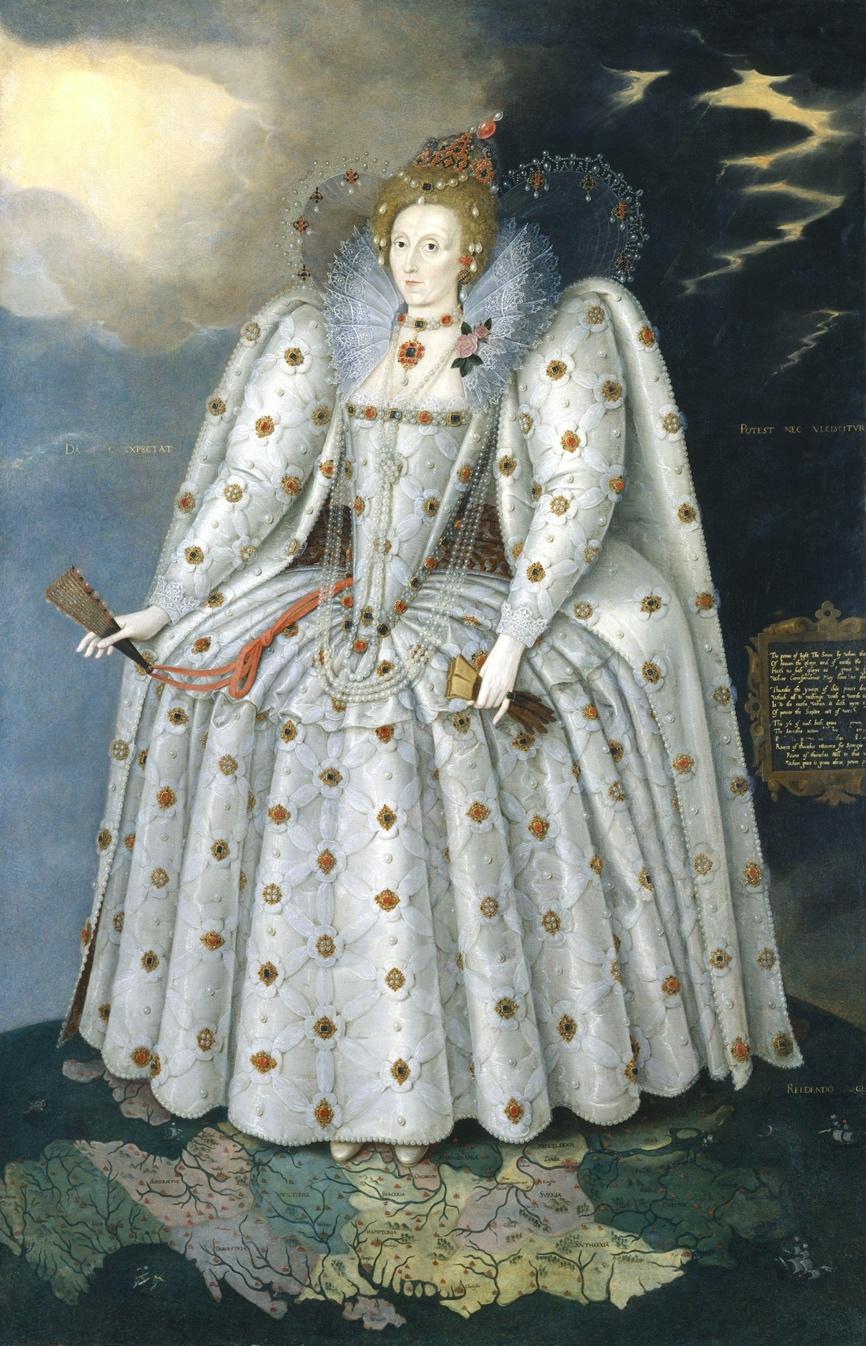
Art Style | Art & Culture International Magazine 107
Figure 3. Marcus Gheeraerts the Younger. Portrait of Elizabeth I. 1592. Technique: Oil on canvas. Measurements: 241.3 cm x 152.4 cm. London, The National Portrait Gallery Copyright: U.S , public domain.
The Portrait of Elizabeth I (Ditchley Portrait), painted in 1592 by the Flemish painter Marcus Gheeraerts the Younger (1561/62-1636),
in
(fig. 3).
The Queen here is represented according to the medieval theory of Monarchy. The sovereigns are two bodies: the ephemeral (mortal) body and the eternal (divine) body. She is the Fidei Defensor (Defender of the Faith), the Head of the Church of England. In this portrait Elizabeth I is the being that decides Nature, the same as God as Creator. She is what separates Good from Evil. Her presence drives away where darkness sets. She ignores Evil she turns her back on the clouds that flood with uncontrolled rains and the skies are cracked by lightning in storms. And, before her face, the Sun opens. The clouds are clear and clean, moving letting the pure light bathe the Earth. With her, Nature is in favor, driving her kingdom beyond her geographical limits to extend throughout the world. She is, at the same time, a symbol of universal leadership, that of a naval power and that of a virtuous model. The white silk, embroidered with pearls, gives off so much light that it becomes a ray of the sun itself.
The atmosphere here is double: transparent in the foreground and contrasting in the background. The reason for the first is that she wanted to make what she had to stand out legible. The reason for the second is that the contrast makes the person of the Queen stand out, accentuating the significance of each side of her. The character of both sides was marked with mottos in Latin. The light atmosphere a combination of blues, silvers, whites and golds has Da (illegible) expectat (She gives and does not wait) written in gold and the dark atmosphere in black and gold has the golden motto Potest nec ulciscitur (She can but does not come). On the bottom right is written Reddendo (By giving back, she increases). Just as relevant as this is the painted text in the bottom right in which she is called “The Prince of Light.” An aspect that was added from this painting to her dramatis personae and that would reach its zenith in the Portrait of the Rainbow (1600-1602, Isaac Oliver/Marcus Gheeraerts the Younger). In these latest portraits, the action is not found in moving bodies, but in psychological gestures in epic atmospheres on large canvases.
A year after the completion of the Ditchley Portrait, in 1599 Caravaggio was commissioned to begin a cycle of three paintings on the life of Saint Matthew. Said cycle would be arranged in a unitary way on the marble walls of the Capella Contarelli of the Church of Saint Louis of the French in Rome. In 1601 he painted the central work, called The vocation of Saint Matthew (fig. 4). The figures are in a completely dark room. Only when Christ enters, pointing to Matthew, is there a ray of light that illuminates the apostle. The light stands out in an environment plunged in darkness, illuminating a man immersed in an ordinary life. It is the moment in which Matthew makes the decision to follow Christ and leave behind everything he was. It is a scene with a gesture language as understandable and familiar as that of Elizabeth I. The difference is that this is a naturalistic interpretation, while the Queen’s was intellectual.
Art Style | Art & Culture International Magazine 108
The atmosphere is dry, harsh and austere. Once again it is applied to show the virtuous model, but in this case it is about making the spectators observe that anyone whoever they are can be called to glory. That it is something that they can make their own and have their own vocation within the divine dictate and in turn, of their representatives on Earth. Large dimensions are used, in which small psychological gestures can be seen as contrasting as the atmosphere. The element of action is found by following the ray of light: they can be observed decision, doubt, surprise, expectation, observation and indifference in a chain. A whole range of emotions that stand out from the darkness, the same with the grandeur of a high relief on an ancient frieze or the intimacy of a meeting in a Roman house from 1600.
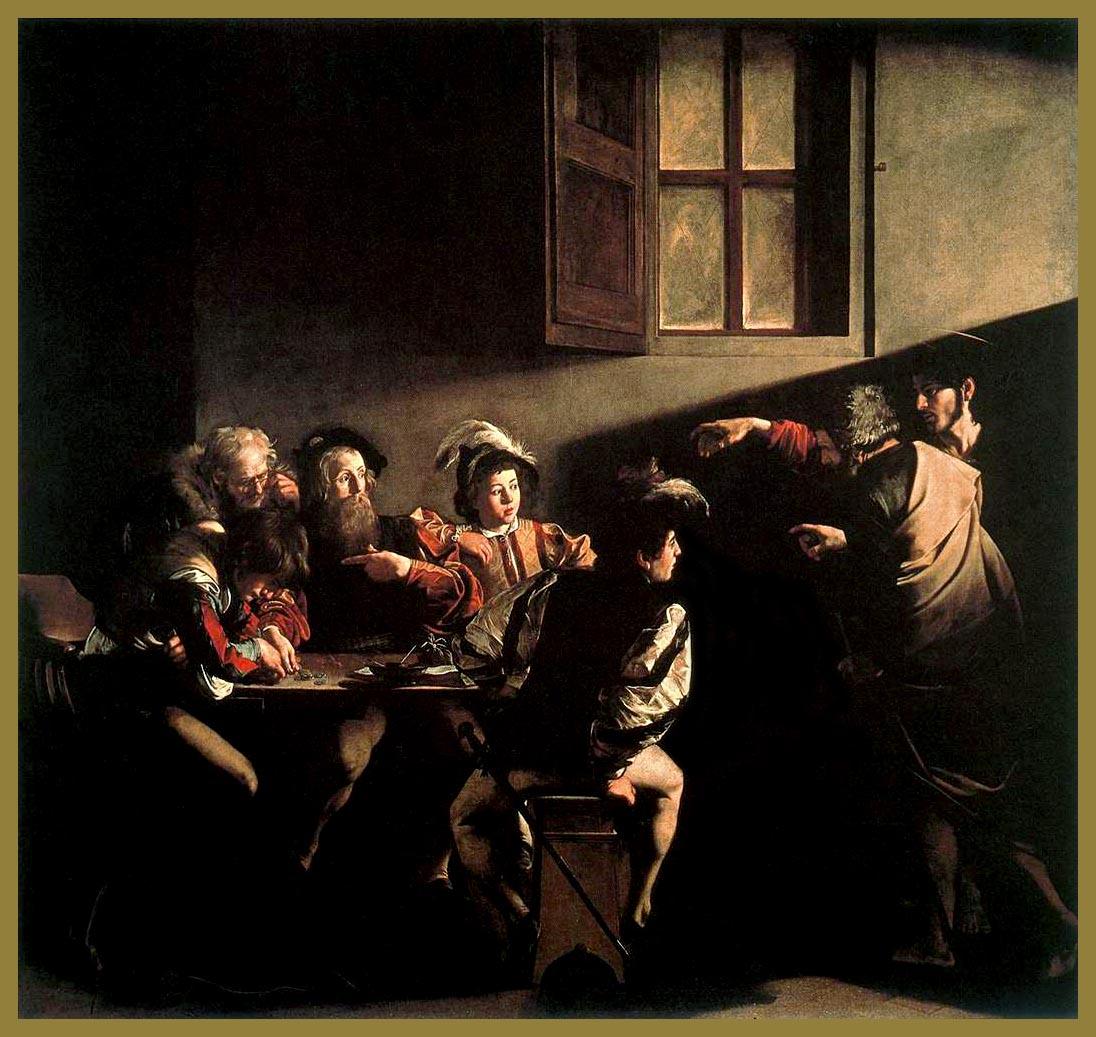
Art Style | Art & Culture International Magazine 109
Figure 4. Michelangelo Merisi di Caravaggio. The vocation of Saint Matthew. 1601. Technique: Oil on canvas. Measurements: 3.38 x 3.48 cm. Rome, Capella Contarelli of the Church of Saint Louis of the French Copyright: U.S , public domain.
The references and comments made so far revolved around pictorial works. But the atmosphere was an element that, in the 17th century, found a new setting. It was Bernini who introduced it to architecture and sculpture. He combined both by creating three-dimensional paintings, as was the case with his approach to the Cappella Cornaro (fig. 5) between 1644 and 1651 in the Church of Santa Maria della Victoria in Rome. He reached his bel composto by turning a reduced space located to the left of the altar into a dramatization of beauty, fullness, dedication and discovery in a woman. The side walls served to place on each side the friezes that represented the members of the Cornaro Family. Friezes in which they appear seated under a dome, while they observe the moment in which some rays of light bathe the person of Teresa de Ávila (1515-1582).
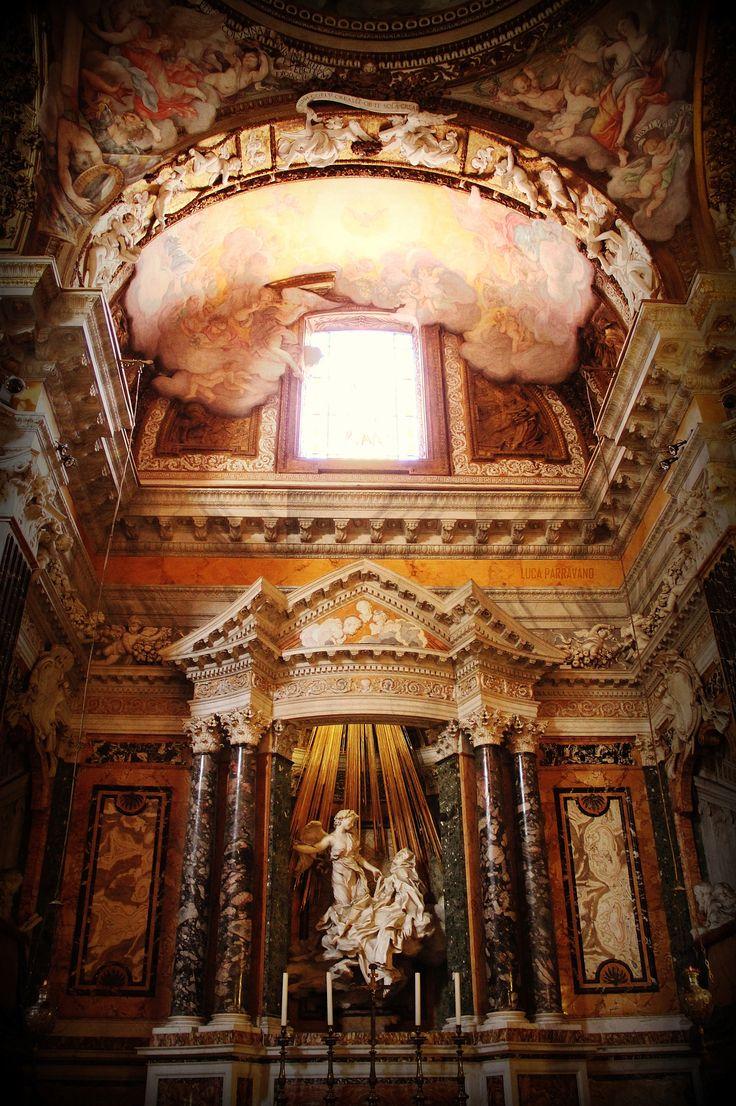
Art Style | Art & Culture International Magazine 110
Figure 5. Gian Lorenzo Bernini. Capella Cornaro, with the sculpture of Teresa of Ávila’s transverberation. 1644-1651. Rome, Church of Saint Mary of Victory Copyright: U.S , Public Domain.
Golden light slides down the white robe folded over her suspended body. An angel has an arrow with the tip of fire in the air, which he makes enter and leave his heart. Teresa of Ávila remains with her body in lethargy. She watches through narrowed eyes, overwhelmed by what she is about to experience. And she opens her mouth to make, with her spirit carried away from her, a sound of wonder. She shows herself as God makes himself discovered in a woman without a major title or status. Grace and Salvation reach everyone, in ways as wonderful as the language of Love.
The atmosphere that Bernini achieved was a combination of grandeur and intimacy. He empowered the extension of the height, reserving the extensive roof for the clouds and the angels. The huge window allows natural light to enter and the majestic circular pediment serves as a screen to channel part of that light. He caused it to reflect off the gilt bronze rods as an aura. Thus, from his superior position, God opens the clouds to let his presence be felt in a constantly moving light. And through one of his angels, he shows Teresa of Ávila the infinity of his Love. The reasons that impel God to do so appear in the declaration of love written between clouds: Nisi coelum creassem ob te solam crearem (if he had not created the honey, I would create it now just for you).
The ingenuity and femininity with which it was raised fit perfectly with the work of Teresa of Ávila. She also had the gift of writing situations visually. Bernini felt inspired by this and tried to adjust the figure of the saint to one of the written paragraphs of her Book of Life (1562-1565). The atmosphere that was typical of her fervent of hers moved her through physical aspects, colors and lighting effects. The central scene in the chapel is an experience that many women and men would have understood in its profane sense. And it was something that, with Trent, could be seen as parallel to what could be achieved with divine love. The colors are warm (red, chestnut, gold) and pure (white), similar to those of your own room. But that in the veined marbles and the golden bronze make it a luxurious space.
Humanity and divinity. Contemplation and burning. Simplicity and abundance. Wit and instinct. Contrasts, as happened in the Portrait of Elizabeth I and in The vocation of Saint Matthew But here it is integrated into the architecture from the composto. However, the atmosphere here recreated by Bernini also showed another facet that was yet to be revealed. This is the ability to show the Truth of a character. The one that the atmosphere can discover the depths of a human being. And that the artist goes into, analyzes and captures that personality, emerging beyond his position in the world.
Art Style | Art & Culture International Magazine 111
From Daily Notes to Metaphor: Velázquez and Goya
The faithful representation of a person was a highly valued aspect. But there were few capable of doing it. When saying “reliable” in an artist, it is about being able to capture his physical appearance in a non-superficial way. He should be able to project the internal energy of a gesture. But also of the spirit that animated him. Individuality was a growing value since the Renaissance, which was evident in portraits (Diane de Poitiers, 1571, by François Clouet) and the effigies themselves (Self-portrait, 1500, Albrecht Dürer). Being able to show spirit became a topic to explore. And with it the atmosphere took a specialization that had infinite repercussions.
Those with a singular gift for it became referents. It is possible to make a magnificent portrait, painting or sculpting in a harmonious, proportionate way. But recreating an atmosphere that projects a state of mind entails being the one to tell a story from silence. The atmosphere is concentrated and analytical. This is what happens in Rembrandt (1606-1669). In his Scholar in Meditation (fig. 6) he shows the reflective spirit of the figure. Not on the man himself, but on the entire room he is in. Soft, nuanced golden light blends into dark shadows. The air blurs the only two people, highlighting the spiral staircase. In this silence his head concentrates on abstractions, intertwining conflicting ideas about existence. And this translates into light transitions, twists and turns, as well as the predominant warmth, which communicate the mind of the scholar. This atmospheric concept was typical of him and of another great Baroque painter, Diego Velázquez (1599-1660). His canvases, with each year, acquired a psychological atmosphere of greater subtlety and elegance. It was a highly appreciated value considering that his portraits were emperors and aristocrats. The images that he made thus enhanced the natural dignity of the Court without falling into pomposity.
Art Style | Art & Culture International Magazine 112
Velázquez made two great trips to the Italian Peninsula. Both served to broaden his pictorial knowledge, taking great interest in the Venetians. (He was a great admirer of Titian and Tintoretto). He extended his stay between 1649 and 1651. It was then that he produced the Portrait of Innocent X
He is seated in an upholstered chair embellished with gold leaf. His aesthetics are noble and excellent, something that the painter represented with the greatest fidelity. He painted the light sliding through the silk, the brightness of the fabric, the different tones produced by the folding of the fabric. Velázquez noticed the soft undulations in the fall of the white tunic …the drama that it generates due to its contrast with the dark red of the background. And the festivity produced by the combination of white and gold.

Art Style | Art & Culture International Magazine 113
Figure 6. Rembrandt Harmenszoon van Rijn. Scholar in meditation. 1632. Technique: Oil on canvas. Measurements: 28 x 34 cm. Paris, Louvre Museum. Copyright: U.S , public domain.
(fig. 7) in 1650. The Pope posed for Velázquez in his robes of red and white silk, embroidered with lace.
The only discordant note is that the face of the person who wears this clothing, who occupies this space, does not match the nobility of the aesthetics. Velázquez does not accentuate or soften anything. He merely represents what he sees in this person: his ruthlessness, ambition, mistrust, and talent for intrigue. Necessary to reach a position like the one he holds. There is nothing particularly constructive in it. The light is direct on the figure of Innocent X, and the atmosphere is revealing. The artist did not wish to criticize the Pope. (The reference he had taken were the portraits of Julius II (1511-1512) and Leo X (1518-1519) by Raphael Sanzio (1483-1520). He Created from the Truth of Innocent X, revealing the nature of the person and the exercise of it in the institution.
Copyright:
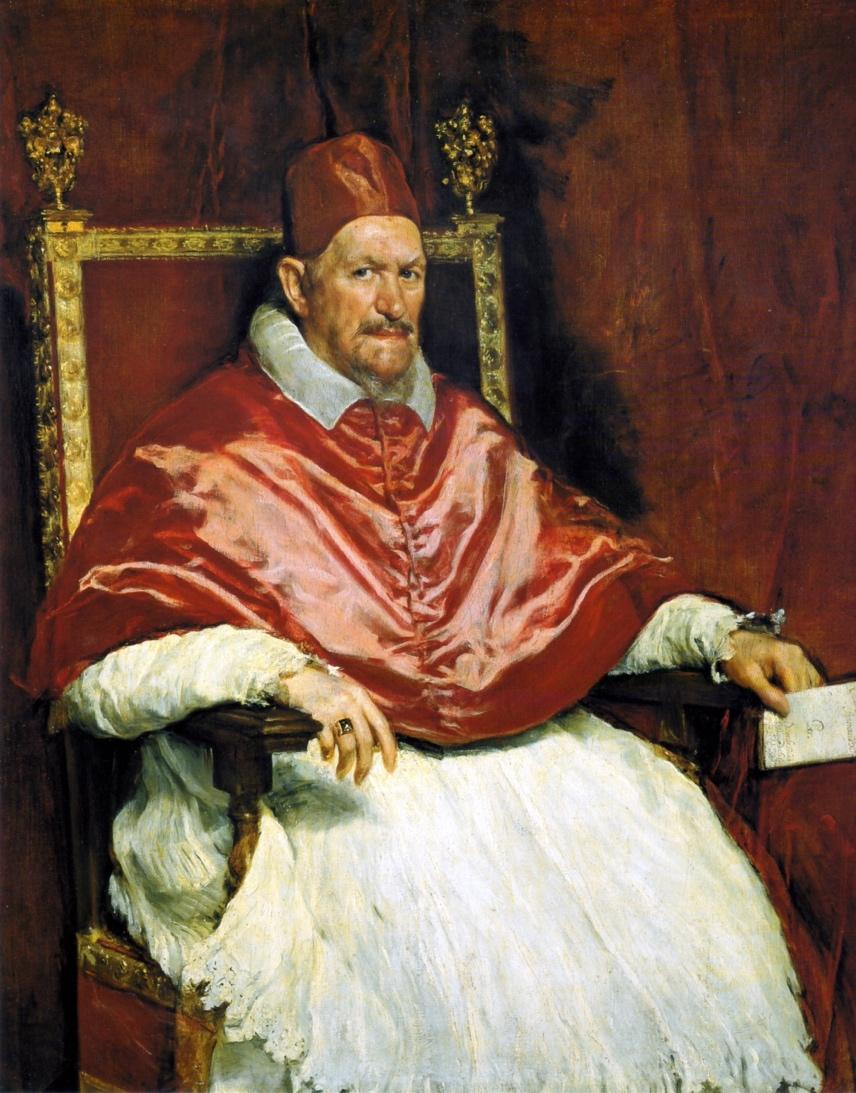
Art Style | Art & Culture International Magazine 114
Figure 7. Diego Velázquez. Portrait of Innocent X. 1650. Technique: Oil on canvas. Measurements: 140 x 120 cm. Rome, Doria Pamphili Gallery
U.S , public domain.
The atmospheres of the two previous works are important because they show to what extent this began to be used to show human nature. But, at the same time, he began to place it in a place beyond social position. It began to display feelings, personalities, and attitudes. It began to reveal pretensions, the vision that people have of themselves and the world. And the artist who brought this to symbolism to a greater extent was Francisco José de Goya y Lucientes (17461828). His works clearly show his intellectual nature: he was an artist of the Enlightenment and a fervent admirer of Velázquez. Where the painter of Felipe IV (1605-1665) had balanced the character of his portraits and his position highlighting above all his dignity , Goya continued in his footsteps.
His aristocratic portraits and of Spanish monarchs for example the Portrait of the Dukes of Osuna and their Children (1788) or the Portrait of Charless IV in Red (1789) can be placed on a par with the portrait works of Thomas Gainsborough (Mr and Mrs William Hallet (1785), Sir Joshua Reynolds (Portrait of The Duchess of Devonshire and her daughter Lady Georgiana Cavendish (1785), Marie-Louise Élisabeth Vigée-Lebrun (Portrait of Charles-Alexandre de Calonne (1784), Portrait of the Queen Marie Antoinette Seated, in a Blue Velvet Dress and with a Book in Her Hand (1788) and Jacques-Louis David (Portrait of Antoine Lavoisier and His Wife, Marie-Anne Pierrette Paulze (1788). Goya worked mostly in prints. Velázquez had already begun to experiment with a technique of stains to try to reflect the effects of light and air, Goya continued with it, in such a way that he managed to capture vaporous effects in the backgrounds, translucent in women’s dresses, iridescent in costumes male bright and bright in jewelry and embroidery. The atmospheres, in short, served to expose the best of the people who posed.
Velázquez had shown the Truth adjusting to the virtue of honesty of spirit, a trait that Renaissance culture and education had inculcated. Due to the protocol of the Spanish Court rigorously regularized, private around the space of the monarch and representative of the imperial power , Velázquez had to take into account the emphatic respect that he was imposed. The naturalness that he included was, in fact, the element that managed to soften said severity to emphasize a natural dignity. Goya was well aware of this. More his environment was that of enlightened circles, where the ethical message mattered a lot. The secular, pragmatic, legislative-representative and scientific values of the Baron de Montesquieu (1689-1755), Voltaire (1694-1778), Immanuel Kant (1724-1804), Jean-Jacques Rousseau (1712-1778), Denis Diderot (1713 -1784) and the project of the Encyclopedia (1751-1772) were in the air. The cultivation of naturalness continued, so that continuity in style was possible. What the change signals is that the atmosphere no longer implied inexorably the exaltation of rank, environment or talent. The atmosphere began to manifest the coherence (or incoherence) between the positions of power and the people who occupied them.
Art Style | Art & Culture International Magazine 115
The Portrait of the Family of Charles IV (fig. 8) is one of Goya’s best works. One of his paintings that best shows what was explained. Taking the reference from the canvas The Family of Phillip IV (also known as The Meninas (1656) by Velázquez, the King’s family appears bathed in a golden light. The headdresses, silks and embroidered gold dazzle in the light, as much as they clearly see the simple, vain, capricious and insignificant faces. When Goya painted this portrait, the French Revolution (1789-1799) had left its mark on Europe and America. And far from even carrying out social, economic or political reforms, the decisions that were taken from the royal cabinet were for personal interests instead of the benefit of the kingdom and the Empire. Goya showed his rejection of the influence of such characters by placing himself in the dark, turning his back on this family. Gestures were used again instinctive, the psychological study and its expression on large canvases, but in 1800 these same characteristics opened up a new perception that heralded the Contemporary Era.
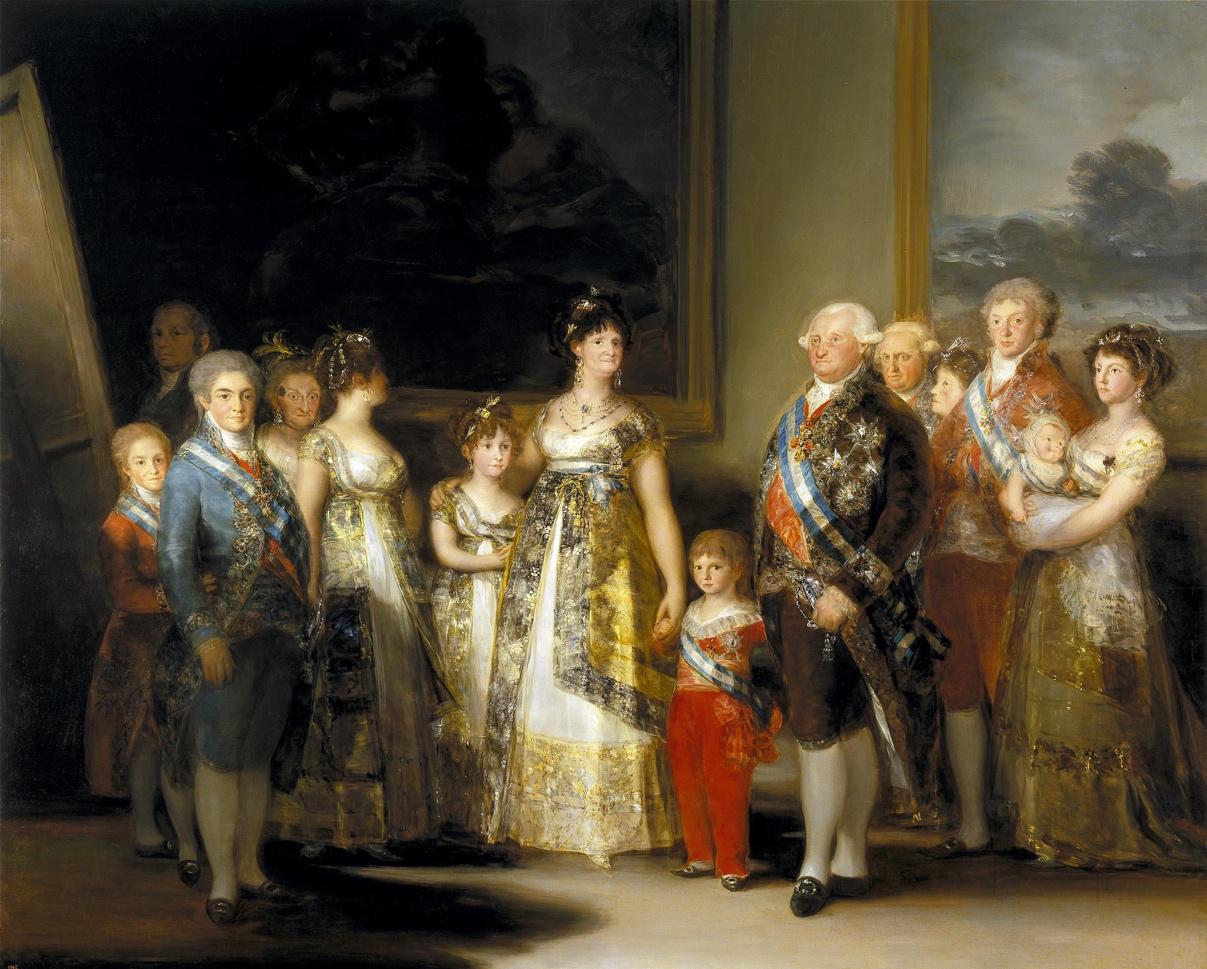
Art Style | Art & Culture International Magazine 116
Figure 8. Francisco José de Goya y Lucientes. The family of Charles IV. 1800. Technique: Oil on canvas. Measurements: 280 x 336 cm. Madrid, Prado Museum. Copyright: U.S , public domain.
Dream and Reality: The Evocative of Romanticism
Goya was the bridge between two centuries. His atmosphere was analytical, until he entered his phase of the Terrible Sublime with the so-called Black Paintings (1819-1823). These are the years in which the incipient Romanticism, born in 1760, had entered a new phase. The atmospheres that until then had served to show individuality with an analytical message, now began a total revolution with Romanticism.
The concept “artist” became independent in its assessment. It was no longer a Count, a Baron, an Archduke, a Viscount, a King, a Viceroy, a Court or the Church that set the tone. Of course, there continued to be an official art directed by, for and from the new bourgeoisie, the aristocracy, royalty and the ecclesiastical state that of the Neoclassicism of the First French Empire (18051814/1815), the Art of the Salons, that of the official portraitists, the painters, architects and sculptors of the Second French Empire (1852-1870), the pompiers, the academicists. But Romanticism proposed a radically new perspective, which was the one that in many aspects led to an evolution equal to that of society. In the 19th century, the Romantics, the Nazarenes, PreRaphaelism, Impressionism, Symbolism, Post-Impressionism and Decadence arose. Essential difference between them: those belonging to official art always sought the pleasure of the image. The seconds the evocation. And of the two, it was the evocative ones who left an indelible artistic imaginary.
If there is an artist with whom to explain the new atmosphere, it is Caspar David Friedrich (1774-1840). His landscapes contain an atmosphere in which the human being is not projected into it. The world is not his imagination. It is Nature that dominates everything, and the human being is immersed in that domain. His paintings are a vivid reflection of the ideas of the Jena Circle, specifically of authors such as Friedrich Hölderlin (1770-1743) and Friedrich Wilhelm Joseph Von Schelling (1775-1854). The atmospheres transfer that infinity, as seen in Monk of him on the seashore (fig. 9).
There are no spaces crowded with figures, no great masses of trees to surround a palace. There are no central figures. Mist floats over the sea, larger than life itself. It is so abstract that only Joseph Mallord William Turner (his Landscape with a River and a Bay in the Background (1845) is an exemplary reference in this case) can be compared in atmospheric sensitivity. You can’t see anything: just feel the humidity that sinks into your bones, the drizzle posing on your hair, the cold that immobilizes your muscles. But, above all, freedom: the wind against the unruly waves, the heavy clouds against the rain. Everything resonates with the human mind as one more aspect among the forces of Nature. Forces that
Art Style | Art & Culture International Magazine 117
coexist with each other, fight with each other, combine, kill each other, are reborn and kill each other again. It is a painting that begins to show more than just individuality in a tangible way. He shows her in her most restless, conscious and introspective facet. In short: he begins to show the human being entirely. With his internal conflicts, his needs, his desires and his resolutions.
The artists who took this exploration to the fullest were the symbolists. The impressionists explored the atmospheres from the decomposition of objects and people from light. But his landscapes, portraits, everyday scenes, and still lifes were reality as it was. Symbolism proposed another kind of atmosphere. Such were more figurative, but the use of light, darkness, colors and textures gave rise to a plastic language. Theme and image were on par. How then could personifications be conceived as Sin (fig. 10)? The female figure is visible in naked white skin, attracting the eye. But her gaze remains in the dark, along with the reptile that covers her. It is an image that invades the viewer. Not because he overwhelms him, but because they are waiting: he just needs to stand before them. Everything attracts him: the light has a single focus among the darkness (ie, the chest). The soft skin of the lady contrasts with the shine of the snake. The only thing different is the hellfire-like red behind both.
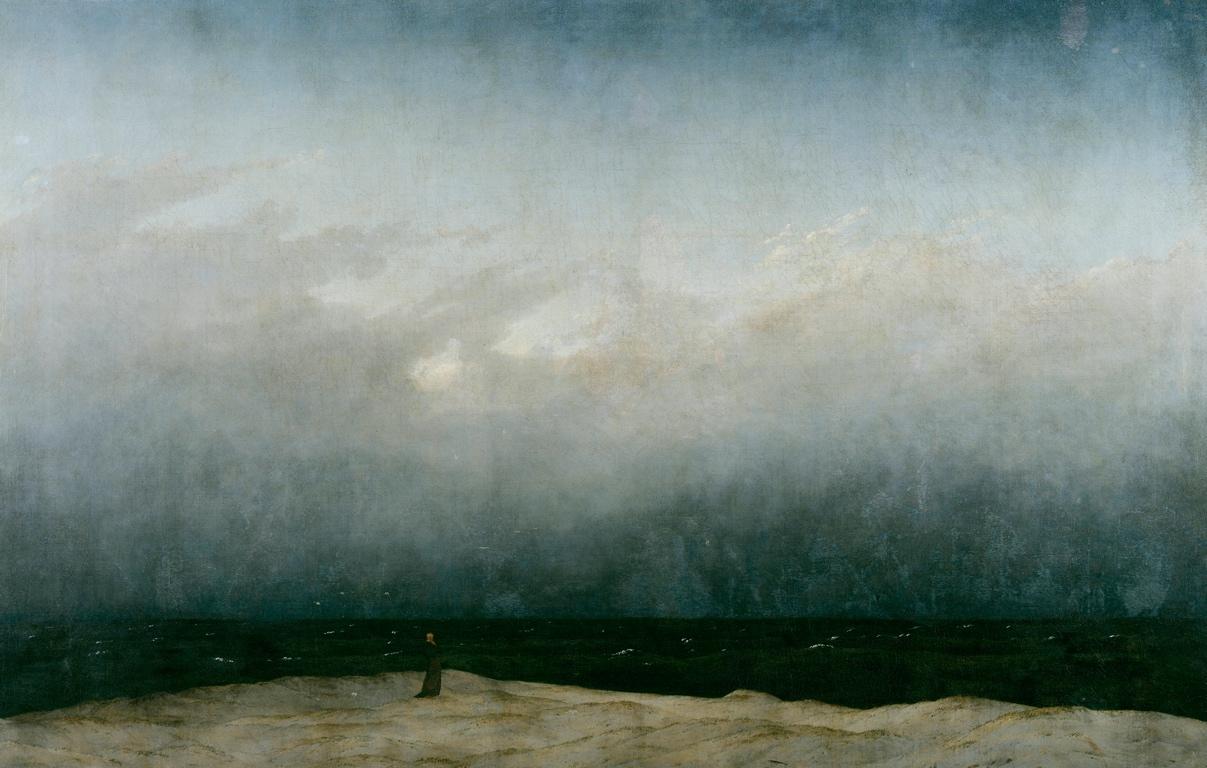
Art Style | Art & Culture International Magazine 118
Figure 9. Caspar David Friedrich. Monk by the sea. 1808-1810. Technique: Oil on canvas. Measurements: 110 x 171.5 cm. Berlin, Alte Nationalgalerie Copyright: U.S , public domain.
There is no pedagogical sense that works of a religious nature could give it. It is about symbolically representing the repressive claustrophobia, the implacable and constant sensation, the perception of danger. It is a sample of the way in which human beings can transform what is natural-sexuality, and female sexuality specifically into something torturing due to conventions. The artist decided to represent such a vision by proudly showing “evil” through shadows, cold lights, female figures without a differential aspect and slimy animals gliding over them. If this image causes fear, it is because of its indefinite atmosphere in the chiaroscuro. As it does not have well-defined lines, the eye cannot identify it, cannot locate it. It is unpredictable and therefore exposes viewers to any unexpected and destabilizing situation.
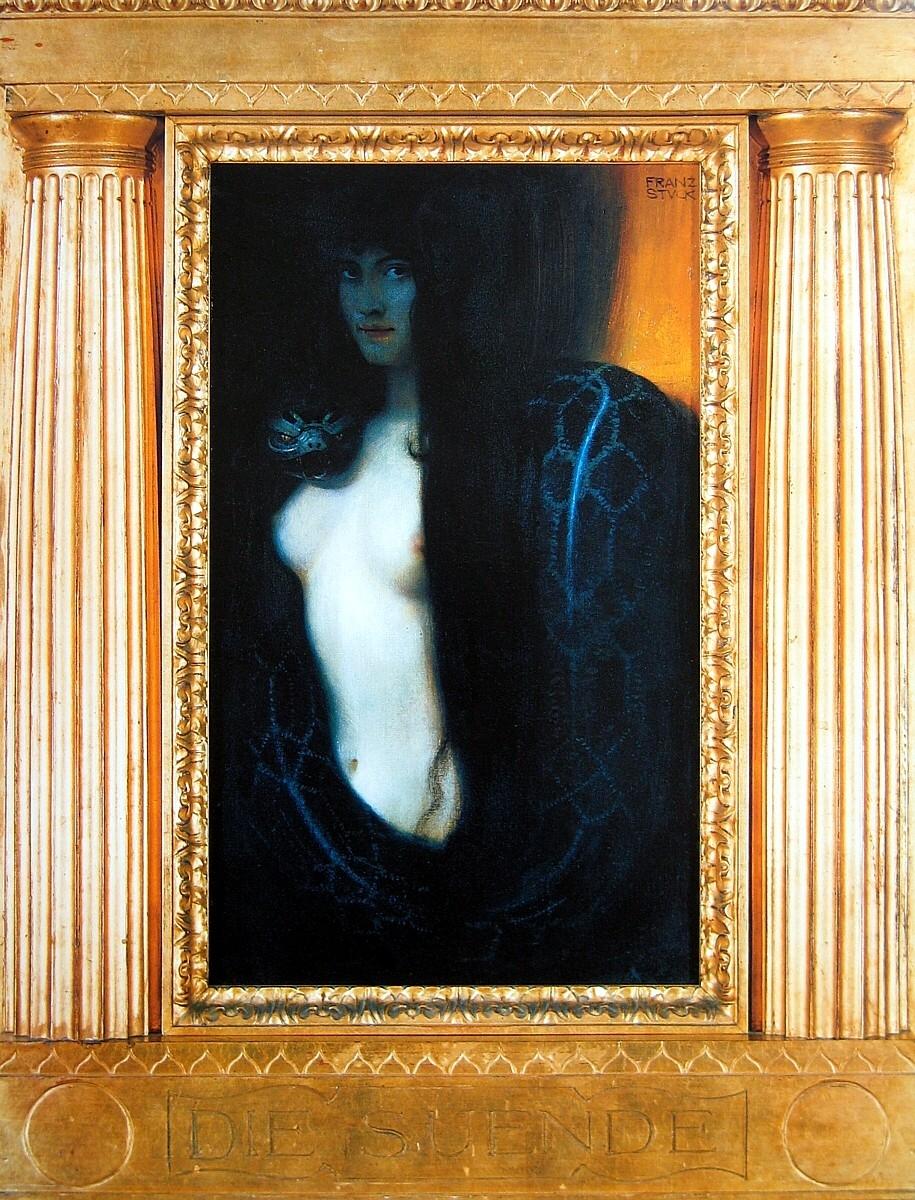
Art Style | Art & Culture International Magazine 119
Figure 10. Franz Von Stuck. The sin. 1893. Technique: Oil on canvas. Measurements: 94.5 x 59.5 cm. Munich, Neue Pinakothek. Copyright: U.S , public domain.
The Spectacle of Tradition: From the Painting to the Theater, from the Theater to the Cinema, from the Cinema to the Operatic Concept of Callas
Three years after Von Stuck exhibited the aforementioned painting, a new art appeared. In 1896 in France the first cinematographic projections appeared. Moving images used simple, imaginative or realistic stories, with a basic technique. The photography, lighting effects, interpretation, setting or camera movements were to be developed. But it soon became the flag of the new styles that were being born. Symbolism saw its end with the First World War (19141918). But the atmospheres that had arisen up to him became a source of perpetual inspiration. The cinema saw the enormous possibilities it offered. Sound had not yet been incorporated as such, so all the narrative weight fell on the image. It is not surprising, therefore, that many of the great films of the 1920s produced atmospheric imagery. Horror cinema was the one that took this issue into account the most, especially in films of expressionist taste. These films were made with the collaboration and work of numerous Expressionist artists (1912-1939). But outside of avant-garde films, it is difficult to find films that were truly conceived as Art and not just as entertainment.
The person who managed to incorporate artistic atmospheres into cinema was Friedrich Wilhelm Murnau (1888-1931). His Journey into the Night (1921), The Haunted Castle – Vogeloed Castle (1921), Nosferatu. A Symphony of Horror (1922), Phantom (1922), The Last One (1924), Faust (1926), Dawn: A Song of Two Humans (1927) and 4 Demons (1928) show to what extent he managed to understand and create such atmospheres. as they had been conceived since the Renaissance. Murnau had studied Art History, Philosophy and Music at the University of Heidelberg, and for this reason had an enormous pictorial culture. Contrary to what happens in many films, especially historical ones, Murnau did not literally copy the atmosphere of the painters, sculptors or architects for his staging and photography. What he did was see how life goes by people waiting for news on a gray day, despair during an illness at night and transfer it with an atmosphere. In that aspect he worked as a painter. That atmosphere was, in turn, one that followed one another and was transformed according to the situation, because Murnau made moving images. In this sense he was a film director. His works can be counted as authentic encyclopedias of the History of Art. The naturalist style, the Biedermeier (1814/1815-1848) and Expressionism are evident in Nosferatu. Rembrandt, Goya and Symbolism in Faust (fig. 11) and Friedrich appears above all in the first scenes of Dawn.
Art Style | Art & Culture International Magazine 120
The cinematographic aesthetic transmits, in essence, dynamism. The assembly is of the utmost importance to give coherence and verve. The performing arts, in this sense, are also guided by a director. But in the case of theater, ballet or opera, they must stick to a script already written in advance. Atmospheres usually help to a great extent to update stories, characters or situations that, if kept literally, would be exaggerated or not very credible. The atmospheres should not be decontextualized in works as maximalist as operas, because then the musical, verbal and interpretive meaning of the same is lost. It was something that artists like María Callas (1923-1977) understood very well. Callas who possessed a singular aesthetic instinct defended that the Truth must be found in the meaning of music. And that the works should be respected just as the composers had conceived them, without lending themselves to superficial modifications made only for the sake of displaying the voice. She was also aware that operas had to be interpreted not with the surface of reality, but with the underlying life. They had to convey the instantaneousness of an emotion, the decisiveness of an action, the way in which the mind mutates as a character is subjected to increasingly pressing situations. These were the reasons why she, as soon as she was able to do so, incorporated film directors such as Luchino Visconti (1906-1976) to work on the opera productions in which she was involved.
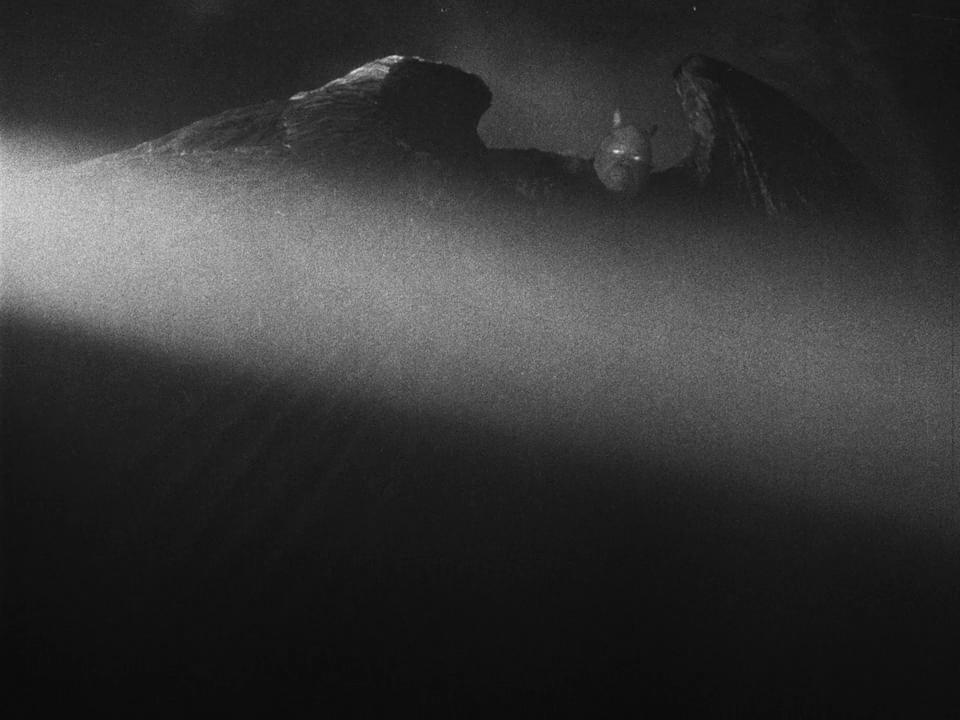
Art Style | Art & Culture International Magazine 121
Figure 11. Directed by: Friedrich Wilhelm Murnau. Photography: Carl Hoffmann. Faust (frame). 1926. Copyright: U.S , Public Domain
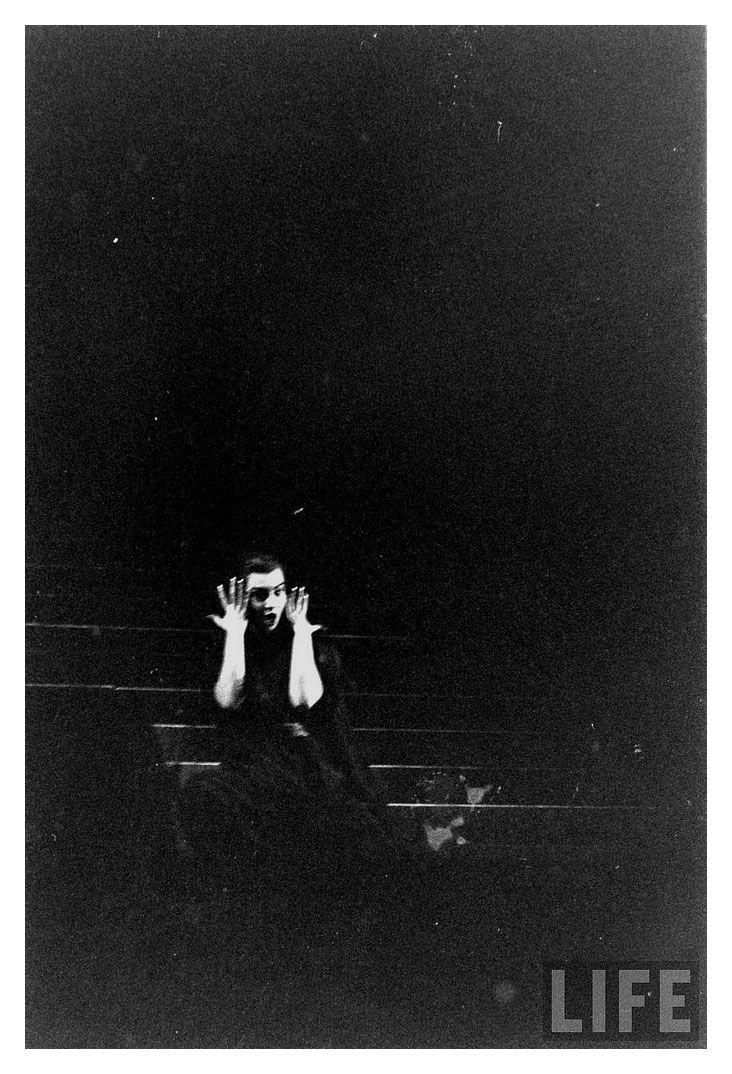
Art Style | Art & Culture International Magazine 122
Figure 12. Direction: Alexis Minotis. Maria Callas as Medea, in the staging of the opera Medea (1797, Luigi Cherubini) at the Epidaurus theater. 1960 Copyright: U.S , public domain.
Visconti intervened in La vestale (1954) with an atmospheric aesthetic inspired by the textures of Cánova , La Traviata (1955), Anna Bolena (1957) with environmental references to Rembrandt’s chiaroscuro and Iphigenia in Tauride (1957) in which took lighting quotes from the paintings of the Venetian Giovanni Battista Tieppolo represented at La Scala. Callas worked both with Viscontian historicism and with the purist viscerality of Alexis Minotis, above all in the productions of Norma and above all Medea in Dallas (1958), Epidaurus (in 1960-1961, fig. 12) and at La Scala (in 1962). The authenticity achieved was only possible after Callas managed to convince him to work on the opera. Minotis did not understand her reasons:
But I don’t know anything about opera, Minotis told her, I don’t even like it. So much the better she replied I don’t want opera directors. I want directors
(Huffington 2002, 132)
This attitude on her part led to a modernization of the opera in terms of its staging. The atmospheres achieved managed to move the public. They were the perfect union of music, drama and word. Unfortunately, not enough recordings of their performances have been obtained to understand this phenomenon. But the photographs that have survived show the extent to which opera without distorting it as a musical and theatrical art brought the dynamism, the immediacy, of the cinematographic sphere. And they also allow us to see how the atmosphere, which was born as an expression of refinement of spirit, maintained that character over the centuries. Artist after artist, from painting to opera, the atmosphere continued (and continues) to be the medium through which Humanity sees its reflection, its nourishment and its projection.
Art Style | Art & Culture International Magazine 123
Conclusion
With Callas this aesthetic path ends. As it has been possible to see and read, aesthetics has prevailed as an aspect in which something more than the spirit of a time resides. Indeed, aesthetics have the power to reflect the zeitgeist. This is one of the bases of this article. But it is also true, as has been seen, that at the same time aesthetics transcends its own temporal limits to be something else. And this something else is the achievement of the human in its very essence. If you want to understand an era, often an image that of a painting, a palace, a dress or a stage says it all. It communicates it, expresses it, because all its aspects are defined by the unique meaning of its character. This may well be that of a film producer, a monarch or a patron. The same can be said of the strong will of the artists, as it happens with the divas. In the creation of a trend, a taste, as has been seen, very different lines are crossed that end up outlining the appearance of existence. None of it undergoes involution, it only becomes the means by which it is transmitted. From illustrations at popular prices of the 17th century to digital photography, from commemorative albums to magazines, from historical recreations to recordings, a mentality, principles, their consecration in the visual and their retransmission flow in all of them. Every work smaller or larger is in that gear and accompanies on a day-to-day basis. Hence its power, its creative and transformative capacity at very different levels and times.
But more than just creating a taste has been involved here. It has been about style, about the impression caused by the observation of a work of art. And in very different spaces: from the interiors of palazzos and aristocratic manors to churches where very different people go every day. From works destined for bourgeois salons to those that were acquired for private collections. From those that were contemplated repeatedly during different generations to those that only lived in just a few weeks and that it is only possible to capture in brief recordings and photographs. He may come to think, far from the current perspective, that a farmer from 1603 might have thought when he saw a painting by Caravaggio. Or of a young seamstress seeing Bernini’s sculpture. The same can be imagined with the public that saw the vast landscapes of Friedrich. Of course the centuries change. But if it is verified that the population felt identified with and liked Caravaggio, in the same way that Bernin’s Teresa despite the censorship became an absolute icon from the moment she showed herself. Friedrich’s painting of the Monk at the Seashore was so formidable that it became part of the royal collections. The fact that today they continue to maintain the same fascination says a lot about themselves and the people who contemplate them. The years that follow do not matter. Human beings will continue to find pleasure, comfort, elevation or inspiration in them, following a path that is as enigmatic as it reveals human nature itself: that of aesthetics.
Art Style | Art & Culture International Magazine 124
Author Biography
Iria-Friné Rivera Vázquez (Vigo, 1988). Patroness of the Luís Seoane Foundation (A Coruña) and the Vicente Risco Foundation (Allariz). She has a degree in Art History, with a specialty in Art of the Modern Era, from the Faculty of Geography and History in Santiago de Compostela. Her Master’s Degree on the Historic City from the Faculty of Geography and History in Santiago was the precedent for her doctoral studies at the Faculty of History and Geography in Santiago de Compostela. She is, in addition to art historian, writer and lecturer. Since 2013, she has been part of the publications and conferences of, among other institutions, the Royal Galician Academy of Fine Arts and the Galician Culture Council. She was part of the exhibitions of the Xunta de Galicia as an advisory curator in 2020 and has published books such as O legado pioneiro de Camilo Díaz Baliño (2021). ORCID ID: 0000-0003-1227-532X Email: iriarivera@gmail.com
Bibliography
Huffington, Arianna. María Callas. The woman behind the legend New York: Cooper Square Press, 2002.
Art Style | Art & Culture International Magazine 125
The Aesthetic Judgment over the Boundary Between Originality and Plagiarism in Korean Contemporary Art
Four Litigation Cases Related to Artistic Plagiarism
Byungkil Choi
Abstract
Marcel Duchamp (1887 - 1968) altered Leonardo da Vinci’s (1452 - 1519) iconic Mona Lisa (c. 15th century) and entitled it L.H.O.O.Q. (1919). By depicting a mustache on the face of a female Mona Lisa drawn on with a pencil, he jeeringly masculinized that artwork, and the painting ’ s new title , when the letters are pronounced in French , may be heard as suggesting Elle a chaud au cul . Such a rema k e is defined by the term s of appropriation, by which the sacred value that the concept of originality occupies can be transformed through processes of destruction , composition, and reinterpretation. Thus owing to the emergence of the concept of the readymade or appropriation, debate s over plagiarism that have taken place only from the viewpoint of the concept of originality meet sudden limitation s . Appropriation prevails in various ways in modern art of the 20th century, and also in Korean contemporary art, but in the legal and court controversy connected with originality and plagiarism there is considered only likeness of the appearance between two artworks. The current law, in Korea, which discusses substantial similarity between, for example, two artworks, dichotomously divides ideas and expressions, focusing only on the latter. In modern art, unlike what preceded it, the ideas, concepts, or thoughts are prioritized over expression itself. Even by imitating and parodying the original artwork, similarities in the form and technique of the artwork are all too common in modern art. This paper introduces four legal disputes related to artistic plagiarism in Korea, discusses related legal cases with modern art theories of the West, and finally presents aesthetic judgments on the boundary between originality and plagiarism.
Art Style | Art & Culture International Magazine 127
In Korea, all kinds of art have been long influenced by art practices and theories of ancient Chinese Dynasties until modern times. Xiehe (479-502), a painter and art theorist during the Southern Dynasties of China, preached imitative painting as a methodology for producing great paintings, including Zhuǎnyímoxie (implying an imitation of the previous artist’s style). Later artists were encouraged by previous artists to build their own creative world while imitating them. Likewise, the introduction of Oriental painting began with learning the teacher’s enhanced and practiced artistic skills.
Since the 1960s, this tradition has been greatly shaken by the emergence of the concept of appropriation from the West, subsequent plagiarism disputes. In fact, since then, debates in Kore an art became heated over artworks submitted to competitions, whose backgrounds are attributed to the excessive use of appropriation. C reativity or originality has become the most important virtue found in artworks since modern times; only the initial artwork deriving from a creative artist is genuine, and its appropriation by other artists has been strictly prohibited. Despite these bans, various aspects of imitation, however, became prevalent throughout the P op A rt movement in the 1960s 1 due to the development of postmodern discourse and mass media. 2 In other words, there is a difference in whether or not the methodology remained in the stage of reinterpreting and recreating the existing image previously, and when it began to purposefully borrow from itself after that.
This expansion of borrowing has been constrained by the concept of copyright, so questions are constantly being raised about how far the exclusive value of art should be tolerated today, and related lawsuits are becoming more freq uent. How do we set up the legal boundary of appropriation from the original in modern art?
Modern artists such as Andy Warhol, Richard Prince, Jeff Koons, and Damien H irst were often involved in copyright infringement lawsuits for using excessive appropriation and parody techniques.
The subsequent influences and phenomena arising from appropriation due to the acceptance of Western art naturally began to affect Korean modern art. At first, they spread to court judgments and the pros and cons of critics focusing on plagiarism controversies over artworks that won competitions, such as the Korea Art Exhibition, which have only appeared since the 1960s. Since the 2000s, there have been four representative cases-Michael Kenna vs Sungpil Kim; Hyunjin Park vs Sookjin Chung; Jongsook Kim vs Inkie Whang; and Mongju Son vs Junghyun Park
Art Style | Art & Culture International Magazine 128 Introduction
These plagiarism challenges between the artists, domestic and foreign, have spread to the courts. The reason there is persistent controversy over plagiarism in the artworld is that the standards for plagiarism are ambiguous. In particular, the boundaries b etween plagiarism and borrowing are often blurred, causing frequent plagiarism disputes around the world. As for Korean modern art, the current copyright law is also based on the concept of traditional art norm s, separating the artists’ ideas and expressio ns, a means b y which most of the con tention over plagiarism cannot be properly resolved. 3
In this paper, focusing on four court cases related to plagiarism of artworks, I analyze the work of both the artists in question and the subsequent written judgment, I also present the limitations or boundaries of creation, borrowing, and plagiarism by substituting aesthetic judgment and/or suggesting anti -plagiarism measures in the discussion and conclusion to follow, as a means to encourage creativity while allowing appropriation in Korean modern art.
The Court Debates over Plagiarism in Korean Contemporary Art Case I: Michael Kenna vs Sungpil Kim
Most of the plagiarism cases in Korea since the 1970s are closely connected with national art contests. In the events of plagiarism controversies, art criticism, initially adopted a non-interventionist posture, such that most resulted in debates between th e artists involved. Controversies arose from a lack of discourse in the contest, where objectivity was guaranteed to some extent. This first legal dispute, which was settled in 2014, involved whether or not British photographer Michael Kenna and Korean photographer Sungpil Kim plagiarized over a photographic work that took a similar composition of Solsum (meaning island full of pine trees), a natural scenery viewed from the same point.
Kenna released Pine Trees Study I (2007, fig. 1) after photographing Solsum in Wolcheon-ri, Samcheok, Gangwon-do, Korea, at the request of Gong Geunhye Gallery. As for Sungpil, with his Waiting for the Morning, from 2010 (fig. 2), which also photographed Solsum, won “The Selected Prize” for the 17th Travel Photo Contest, hosted by Korean Air in 2010. Then, in August 2011, the company broadcast an advertisement video for television and the Internet, employing the caption: “The Wind Is Sol Sol (implying a double meaning, breeziness as well as pine trees), The River Is Sol Sol, The Cloud Is Sol Sol, The Touch Is Sol Sol, The Country Is Only Us.” In response, Kenna’s Korean agency Gong Geunhye Gallery, claimed that Sungpil’s image, Waiting for the Morning, used in the ad constituted a copyright infringement, because it copied Kenna’s photograph, and was an act of unfair competition, since Korean Air used it for commercial advertising without permission.
Art Style | Art & Culture International Magazine 129
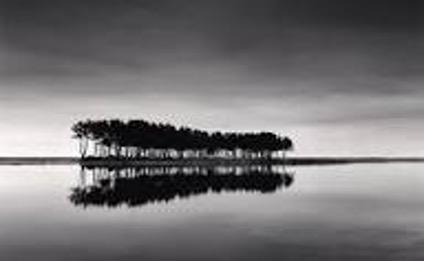

Art Style | Art & Culture International Magazine 130
Figure 1. Michael Kenna, Pine Trees Study 1, 2007, Black and White Photo, 20.1 x 25.2 cm, The Gong Geunhye Gallery Collection.
Figure 2. Sungpil Kim, Waiting for the Morning, 2010, Color Photo, 36.03 x 23.98 cm, The Korean Air Collection.
Regarding his photograph Pine Trees Study I, Kenna explained, “It is a long exposure to the reflection of the pine trees like a mirror in the water. I walked around Solsum for a long time and saw the most beautiful spot, and I filmed there.” Referring to the photograph employed by the Korea Air ad, Kenna said, “The picture is very beautiful and well taken, but it is closely similar to my picture.” And he added, “If you look at the composition of the picture, I put a tripod where I took it and expressed the pine trees with a black silhouette. Copyright is a problem that also can occur to other artists. If Korean Air is a multinational company, it would not have used imitations for advertising.”4 Contrary to Kenna’s claim, however, Sungpil’s photograph in the ad was, in fact, expressed in various colors by combining dynamic clouds and sunlight and completely different from Kenna’s image. Korean Air responded, “There are many artists who filmed Solsum before Kenna, and anyone can film the natural scenery freely, so he cannot claim exclusive right.”5
The first and second courts both refused to accept Kenna’s claim. In the case of photographing the same subject, the difference in time for photographing existing natural objects or landscapes is an idea, and not an issue of copyright protection. In addition, there are differences in composition, date and time of photographing, direction and amount of light.6 Through the comparative analysis of these individual constituent requirements, it was considered that no matter who photographed, similar results were inevitably obtained when targeting fixed natural objects, including such landscapes as Solsum. Therefore, it was judged that wide protection could not be granted because the scope of the creative expression was very limited.7
Case II: Hyunjin Park vs Sookjin Chung
This second case , an example of categorical plagiarism occurring between Korean and Western paintings in Korea, was judged by the Copyright Commission for Deliberation and Conciliation before it went to the court.
In this case, Korean painting artist Hyunjin Park filed a civil complaint with the Copyright Commission fo r Deliberation and Conciliation on the grounds that oil painter Sookjin Chung ’s style plagiarized hers. More specifically, the plaintiff argued that, in May 2001, the defendant displayed artworks for her Solo Exhibition held in Chosun Daily Newspaper Art M useum, mostly featuring the subject-matter of peacocks that were too similar in form and color to Hyunjin ’s work. The plaintiff Park had already show n such work at two solo e xhibitions in Seoul and Jeonju (in April and May 1997 , respectively).
At the Commission ’s meeting, the defendant counterargued that “she saw neither the plaintiff’s solo e xhibitions nor her catalogues. The similarity between the artworks is simply an accidental coincidence.” Because the images by the two artists look so much alike, the defendant’s claims were regarded as doubtful The situation recalls a similar
Art Style | Art & Culture International Magazine 131
case in Korea, when Augustin Cardenas, who had participated in the Outdoor Sculpture Symposium at the 1987 Seoul Olympics, then, held a solo exhibition at Hankook Gallery, accused South Korean sculptress Youngja Youn of plagiarizing his work. As a result, the two artists met at Hankook Gallery, where Youngja shared her work processes and illustrations over the past 30 years. After that, the plagiarism misunderstandings between them were completely resolved. But, there was never an honest conversation between Hyunjin and Sookjin about their work processes, only Sookjin’s unilateral claims that everything was a coincidence.
Thus, the Commission decided as follows: Firstly, the defendant has to pay ₩50,000,000 won to the plaintiff as compensation for damage. Secondly, the defendant has to insert a notice of apology to the representative five presses. Thirdly, the defendant has to discard nine artworks including Being Filled with Azalea Smell (1999) within seven days of mediation’s effective date. However, these decisions have yet to be compiled with
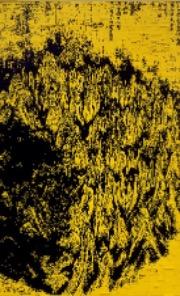
Case III: Jongsook Kim vs Inkie Whang
In this third case, the dispute over plagiarism arose from the use of the same material and expressive style in art of the same genre. The artwork that was borrowed by the disputed works already existed in the late Joseon Dynasty, while the conflict arose between two modern artists. They produced respective artwork by borrowing the image of Geumgangjeondo (1734, fig. 3) created by a Korean painter from the Joseon Dynasty, Gyeomjae Jeong Seon, whose copyright protection period had expired.

Art Style | Art & Culture International Magazine 132
Figure 3. Gyeomjae Jeong Seon, Geumgangjeondo , 1734, Thin Coloring with Indian Ink on Paper, 130.8 x 94.5 cm, The Leeum Art Museum Collection.
Figure 6. Inkie Whang, After Mt. Diamond 02608, 2008, Crystal, Engine Oil on Canvas, 144 x 200 cm, The Private Collection.
Both Jongsook Kim and Inkie Whang borrowed Jeong Seon’s Geumgangjeondo, and attached crystals as main material to the screen. Producing the Artificial Landscape series since 2005, Jongsook’s main interest was to reinterpret landscape painting as landscape of the time. She explains: “The landscape of modern society is not a reproduced image, but based upon substance, number, the signified, etc.”8 In contrast, Inkie converted Geumgangjeondo into a blackand-white computer image and decomposed it into pixels. Then, it was enlarged to the actual size, printed, and moved to one painted screen. It was completed by attaching crystals of the same size as the pixels. This is a modernization of tradition and nature, as a so-called crystal landscape painting. Here, the logic of digital binary, black and white, horizontal and vertical feels mechanical. 9
Thus, the two modern artists used the same material, but their journey to the material was completely different. Nonetheless, in 2015, when Jong-sook decided to hold her 10th anniversary solo exhibition at Shinhan Gallery, Inkie raised suspicions of plagiarism, claiming that Jongsook’s Artificial Landscape-Pink Variation (fig. 4) and White Material (fig. 5) were too similar to Inkie’s After Mt. Diamond 02608 (fig. 6).
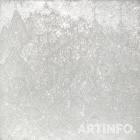
In 2015, Jongsook filed a law suit on the grounds of defamation and obstruction of business, including plagiarism. In 2016, the Goyang Branch of Uijeongbu District Court judged that the defendant is obligated to pay 10 million won in damages to the plaintiff. The court identified the characteristics by directly viewing the two artists’ works. Jongsook’s artwork emphasized the straight and curved lines by attaching artificial crystals along the outer line of Geumgangjeondo. Whereas, Inkie’s employed intaglio that was revealed by attaching round crystals to the black background except for the line. Recognizing the originality of both artists’ works, the court, therefore, determined that this was not a case of plagiarism.10

Art Style | Art & Culture International Magazine 133
Figure 4. Jongsook Park, Artificial Landscape-Pink Variation, 2011, Mixed Media on Canvas, Swarovski, 140 x 140 cm, The Private Collection. Figure 5. Jongsook Park, White Material, 2011, Mixed Media on Canvas, Swarovski, 140 x 140 cm, The Private Collection.
Case IV: Mongju Son vs Junghyun Park
Since 2012, Daegu Gallery announced to art museums and curators, nationwide, the Y Artist Project, a special exhibition-designed to support the creative activities of young artists under 39. On March 2014, Ju nghyu n Park was one of five artists selected . From February 11 to June 1, 2014, she displayed her installations, Comfortable -Uncomfortable and Disturbing , at the 4th and 5th Exhibition Halls. The theme of the two installations was that “excessive comfort can also take away the view of novelty by taking away the tension.” 11 The former expressed the viewer’s physical discomfort using an uneven surface, and the latter evoked the viewer’s mental discomfort using rubber bands. It embodied the inconvenience12 of transmitting information such as personal information through the network, a set of lines that do not look like modern Internet networks. Lines of hundreds of rubber bands gradually filled the showroom, connecting the walls of the “white cube.”13
At that point, Daegu Gallery imprudently posted an article on its website, announcing that “it was plagiarism because it was similar to Mongju Son’s artworks. Inspired by the reaction of the gallery, Mongju argued that Ju nghyu n ’ s Disturbing (fig. 7) appare ntly plagiarized her installation, In A Space (fig. 8). Mongju’s own creative composition to divide into spaces with rubber strips fixed on the wall had been already displayed at the Exhibition Hall on the 2nd floor in a so lo show under the title “Ad ding Color, Adding Experience”, at Gyeonggido Art Museum, starting July 30, 2013. 14 Daegu Gallery ultimately realized that Ju nghyu n ’s artworks only appeared to have been plagiarizing . The reason was that “similarity is a phenomenon being often encountered in modern art, so it is important to check up whether or not it is plagiarism by the artist’s idea, not by only appearance.”15
Nonetheless, on April 16, 2014, Mongju sued Ju nghyu n in Busan District Court, which issued an injunction to prohibit the exhibition of artworks, as well as to require the defendant to pay the plaintiff ₩50,000,000 won in damages by June 12 that year. The court quoted the plaintiff’s claim on February 8, 2017. The judgment was divided into two parts: the charges of copyright infringement, an d of substantial similarity and its basis. The summary of first trial concluded that there existed a substantial similarity between the defend ant’s and the plaintiff’s respective installations 16 Ju nghyu n, however, appealed this judgment in the Daegu District Court, which overruled the decision of the first trial on June 24, 2016.17
Art Style | Art & Culture International Magazine 134
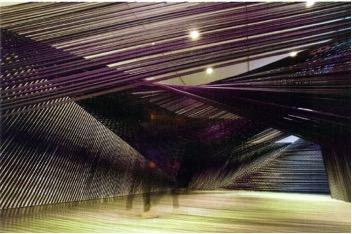
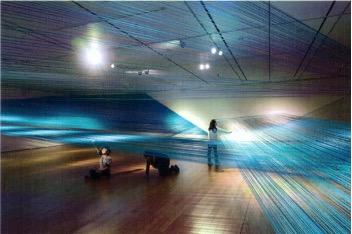
Art Style | Art & Culture International Magazine 135
Figure 7. Junghyun Park, Disturbing, Elastic String, 2014, Variable Installation, The Private Collection.
Figure 8. Mongju Son, In A Space, Rubber Band , 2013, Variable Installation, The Private Collection.
III. Discussion of Four Legal Disputes over Plagiarism Case I: Michael Kenna vs Sungpil Kim
In the 20th century, photography was recognized as an independent art rather than simply copying reality as in the past, and awareness of the need to protect the copyright of photography is also expanding. In photographic art, the choice of subjects was viewed as a decision based on the artist’s idea, and the idea itself cannot be protected by copyright. According to Korea’s Supreme Court precedent, “Photographic works are protected by copyright law only when the individuality and creativity of the photographer is recognized in the process of selecting subjects, setting composition, controlling light direction and amount, camera angle, shutter speed, capturing shutter opportunities, etc.” 18 Eunheui Choi expressed the following opinions on the cases, Michael Kenna vs Sungpil Kim, and Shozo Maruta vs Kobayashi Shinichiro. “The natural scenery is impossible for the photographer to change, so it was hard to say that there were various possibilities for expression. If one artist’s creativity is recognized only with the overall feeling, another artist’s creative freedom can be deprived. Therefore, it is not a copyright infringement unless the work itself is reproduced even if it was taken in a similar atmosphere in the same place.”19
Her views agree with the court rulings related to the cases. The core contents of the judgment is as follows: “Many photo lovers have taken pictures of Solsum in similar conditions to the same place as Kenna’s. The main reason why the photos look similar is that, first, they copied the conditions of Kenna’s photograph, and, second, the similar part of the photograph, the Solsum, is famous.”20
However, if the part corresponding to the idea of a photographer such as a particular place, weather, or angle is not protected by copyright law, such efforts will not be rewarded? In modern times, the remarkable development of mechanical engineering, such as cameras and computers related to photographic art, overshadows the original concept of an image’s creativity. With the development of digital cameras, the creation of composite photographs is becoming easier day by day. Synthetic photographs are problematic in terms of reality, but in Korean copyright law, since this type of work is only an example, it is said that synthetic photographs can be protected by copyright law if they are creative. 21 In addition, portal sites, etc , are increasingly producing thumbnail photos, and using them as link points to enhance the convenience of image searches. Regarding such a phenomenon, the Supreme Court of Korea saw it as being used in accordance with fair practices within a reasonable range, given the strong public interest in providing more complete information to users of search sites.22
Art Style | Art & Culture International Magazine 136
Accordingly, photo critic Pyeongjong Park summarizes the specificity of photo copyright in three ways.23 First, the problem of photo copyright should not be approached as a problem of an individual art genre. For example, conversation images distributed in electronic media such as the Internet are also duplicated pictures. Second, the expansion of digital photography has brought photographic works to near infinity. Commemorative photos taken by elementary school students and photos taken by food bloggers are also artworks, in the sense that they have original sources and are able to be copyrighted. Therefore it is necessary to spread awareness of shared copyright by relativizing the view of approaching photographs exclusively at the level of artwork. Third, when a onetime artwork such as a performance distributed through photographic reproduction is photographed at an informational level, the problem of copyright distribution may emerge.
As such, photographs showing their natural appearance are still under constant controversy over creations and copyrights, and it is expected to remain a challenge in the future. According to Article 4, Subparagraph 6 of the Copyright Act of Korea, photographic works refer to artworks that express thoughts or emotions through certain videos, including those produced by photographs and similar methods.24 The rule of thumb is that copyright protects expression, not idea. For a photographer, it can be more helpful to look at what is depicted within the four corners of a photograph and ask: What choices did the photographer make to create a work, and what subject, concepts and poses belong to the public for anyone to take?
Two cases in the United States and Japan are recognized as similar to this case. First, Louis Sahuc (1942-2021) photographed The Decatur Street Gate (1999, fig. 9), on a foggy morning against the backdrop of St. Louis Cathedral on Decatur Street in Jackson Square, French Quarter, in New Orleans, Louisiana. While Lee Tucker photographed Breaking Mist (2001, fig. 10) with the same background. Accordingly, Sahuc claimed that his copyright was violated. Ultimately, the court denied that there was any copyright infringement. The argument revolved around the difference in the arrangement, angle of the subjects, and lighting. The subject is St. Louis Cathedral, a natural subject because it is an existing one, not created by any photographer. Therefore, it is necessary to examine whether the photographs are similar to each other mainly on the basis of elements other than the similarity of the subject. The two pictures show different lighting angles, and different fog intensity. We have seen examples of court judgments for natural subjects. In contrast, in artificial subjects, the similarity of the subject is also one of the important elements. However, the similarity of the subject by itself does not directly constitute an infringement. We also need to review the similarities of other elements, such as angle and lighting, etc.25
Art Style | Art & Culture International Magazine 137
Second, in the Japanese case, the result was similar to the American court decision regarding the selection of subjects. Shozo Maruta wrote and published an article with Camouflage (1989, fig. 11), involving photographic work based on the theme of the ruins. He later discovered that Kobayashi Shinichiro published a book using similar sentences as well as Haikyo wo Yuku (1996, fig. 12) similar to his photographic work. In response, Shozo filed a lawsuit with the court demanding a ban on publication and compensation for damages.

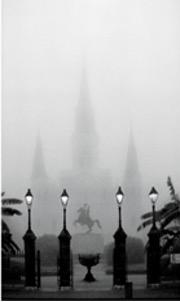
Art Style | Art & Culture International Magazine 138
Figure 9. Louis Sahuc, The Decatur Street Gate, 1999, Black and White Photo, 33.02 x 48.26 cm.
Figure 10. Lee Tucker, Breaking Mist, 2001, Color Photo, 27.94 x 35.56 cm.
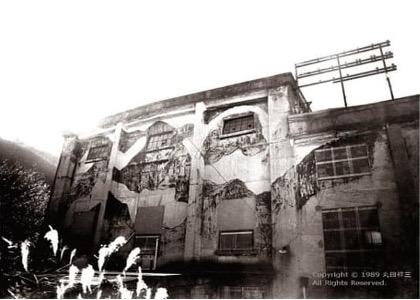

Art Style | Art & Culture International Magazine 139
Figure 11. Shozo Maruta, Camouflage, 1989, Black and White Photo, The Private Collection.
Figure 12. Kobayashi Shinichiro, Haikyo wo Yuku, 1996, Black and White Photo, The Private Collection.
In 2010, the Tokyo District Court ruled, “The choice of subjects is an idea, not an expression itself. The overall impression of the two photos is very different.” In 2011, a similar ruling was made in the appeals court of the High Court of Intellectual Property. “Even if the composition of the subject is similar, the timing, angle, and color of the photograph are different from the essential characteristics that are directed toward the expression of the picture. Therefore, in the picture of Maruta, the subject is an existing building ruins, and the photographer intentionally placed the subject and did not attach the object to be photographed by himself. Therefore, the subject itself cannot be said to have an essential characteristic of expression, and there is an essential characteristic of expression in the way of expression such as shooting time, angle, color, and angle of view.”26
If so, what does copyright really protect when it comes to photographs? Photographers often complain that someone stole their picture, or their idea not by reproducing the actual photograph, but by creating something very similar. The question I raise involves whether the copying is based on inspiration and therefore legal or is too similar and infringing under copyright law. Where and how the line between inspiration and illegal copying is drawn is hard to articulate and can often seem arbitrary. To prove copyright infringement, you need to establish both access to the original image and substantial similarity. It is possible that someone could independently create a similar image, so unless you have proof of access, they can claim independent creation as a defense. If there is access, you still must convince a judge that the two images are of substantial similarity. To show that, you need more than similar subject-matter. You need to show that copyrightable elements are substantially similar. Copyright provides a limited monopoly over a particular work; not all aspects of a photograph are considered protected. So how does the court determine what elements are protected and what are not? How much taking is too much? As often with legal questions, the answer may be: “It depends.”
Here I suggest five questions to consider as follows:27 First, is the subject available for anyone to photograph? Second, is the photograph a “product shot”? Third, are there only a few ways to create a photograph of the subject? Fourth, how much did the photographer orchestrate the elements in the photograph? Fifth, did the photographer use special techniques to create the photograph?
These five questions point out that the cases of Korea, the United States, and Japan similarly do not display the photographer’s right to a specific subject, as well as the criteria for judgment when discussing plagiarism of photographs. As in these three country cases, the court did not recognize the similarity between the two photographs by separately judging factors such as light direction and amount control, shutter chance capture, shutter speed, phenomenon, and printing.
Art Style | Art & Culture International Magazine 140
Case II: Hyunjin Park vs Sookjin Chung
As a matter of fact, the concept of creativity in photography seems too loose compared to that of painting. Comparing the compositions of Hyunjin’s The Secret Garden with Sookjin ’ s Being Filled with Azalea Smell, and expressing them in a photographic term, can result in differences in the artists ’ ideas according to the selection of th e subject. If so, w here will you find the creativity of readymade, which emerged as a genre of art in the 20th century? Given that it is a choice that finds everyday objects through art, that is, the idea itself belongs to creativity. Therefore, some argue that it is not realistic to apply traditional ideas and expressions dichotomously when protecting creativity with copyright law.
Prior to this meeting, I presented an article on this case to Monthly Art Magazine Wolgan Misul (October 2001): I investigated the artworks of the two based on their form and color. Comparing Hyunjin ’ s The Secret G arden (1996, fig. 13) with Sookjin’s Being Filled with Azalea Smell (1999, fig. 14), I concluded that the latter piece remains outside the boundary of simply borrowing the former piece, given that the former was created 3 years before the latter; while both artists chose the peacock as their subject-matter, there is no hint of an attempt by the latter to mimic the former’s form, technique, o r spirituality.28 Nevertheless, it was determined to be an illegal copy, and a case of plagiarism.
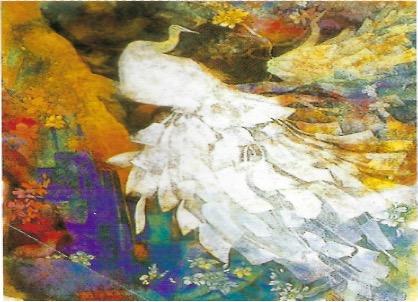
Art Style | Art & Culture International Magazine 141
Figure 13. Hyunjin Park, The Secret Garden , 1996, Thin Coloring with Indian Ink on Paper, 333 x 218 cm, The Private Collection.
British jurist Simon Stokes said in Art and Copyright (2001): “If the object is created with artistic imagery and intent, readymade is fully entitled to legal protection.”29 The artist’s idea itself is sufficiently recognized for the creativity of readymade. Another jurist Henri Desbois asserted, “It’s not just a reproduction of the original work, it contains the artist’s symbols, and if you can also discover intelligence and know-how, it’s creative.” 30 As for the cases that occurred in Korea, current copyright law is based on the traditional art concept that dichotomously separates artists’ ideas and expressions, so it faces the limitation of not being able to properly interpret the plagiarism controversy of modern art. For now, the reality is that the issue of copyright protection in readymade plagiarism lawsuits has to be left to the court’s judgment in each case. So how should the concept of creativity be expanded or reduced, especially in photographic art?
Emerging in the mid-1960s, Postmodernism opposes traditional norm of creativity, ownership, and expression that copyright protection claims. According to this trend, artistic expression, which was once considered the essence of art, is subservient to artistic notions. Yukyung Seo has noted that “the idea of putting artistic ideas above artistic expression is bound to conflict with the current copyright law.” 31 Rather than the dichotomous separation of ideas and expressions, it is recommended that law and art discuss the point and place where ideas are replaced by expressions. Of course, this gradational view not only obscures the boundaries between the two, but also makes it difficult to present clear criteria for judgment.
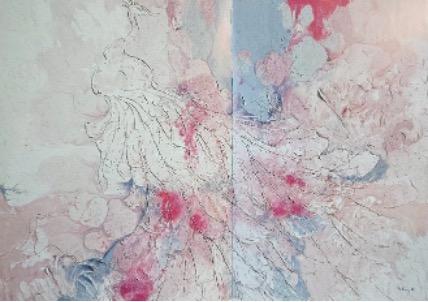
Art Style | Art & Culture International Magazine 142
Figure 14. Sookjin Chung, Being Filled with Azalea Smell , 1999, Acrylic Oil on Canvas, 333 x 218 cm, The Private Collection.
Case III: Jongsook Kim vs Inkie Whang
Art critic Eunyoung Jung spoke of Jongsook’s artworld as follows:
[The] Artificial Landscape series she has been working on primarily takes the form of a spectacle of light. It is an attractive surface layer that combines Swarovski elements with landscape paintings from Joseon Dynasty. However, the surface of the temptation is more like a continuous screen that projects images across time and images, rather than a spectacular of internal separation of materialism. The screen is a medium of light that creates continuous images by constantly blinking and overlaps countless different texts to connect a single narrative. Like a screen that operates through disconnection, continuity, intersection, and overlap, that series casts a shroud of bewilderment and opens a channel of awakening in it.32
Likewise, Inkie is an artist who stands at the intersection of Eastern and Western traditions and modern times. He has been interested in a mixture of disparate things and multiple values through the conflicting experiences of Korean and American culture, curriculum of applied physics and pure art, traditional culture and hippie culture.33
Jongsook pioneered the genre of crystal painting, and it is completely different from Inkie’s digital landscape in terms of work process and concept. As for appropriating the original artwork, the artist’s creative intention is important. Therefore, it cannot be argued that the artist who first created the artwork by borrowing the same image plagiarized the artist who later created it, just because the expression was similar. 34 Inkie said that Jong-sook used the same material as him crystal borrowing the image of Geumgangjeondo, and he raised plagiarism because he saw the color and main characteristics of his artwork as superior. However, the court, which found a significant difference in expressive techniques, did not accept the Inkie’s allegations of plagiarism.
These two artists used the same material, but their respective production technique was completely different. Jongsook opted for an analog method of transferring images to painting and then selectively pasting crystals as if they were painting. The important difference here is to find the problem of how to selectively draw with crystals, that is, the difference in the creative intention or direction of the two artists. Modern art based on subjectivism, and the artist’s intention and philosophy dominate the formation of the artwork. However, I feel that it is not reasonable to discuss plagiarism only in terms of material identity without also discussing artistic philosophy.
Art Style | Art & Culture International Magazine 143
Case IV: Junghyun Park vs Mongju Jeong
Returning to the fourth case, we have to know that the pivotal character of that material, rubber band, is in its changeability. Although an artist makes two equal artworks with same changeable material at the same time and space, can you say they are same? I cannot say “definitely yes.” Despite the character of changeability in material which can change endlessly even in a given condition, yet Busan District Court’s decision was made by ignoring the physicality of that material, and it is thus a kind of nonsense. It is doubtless that the Court’s decision to hastily accept a provisional disposition to ban the exhibition of Junghyun’s Disturbing filed by Mongju without considering this variability in material caused a big problem. Of course, Daegu Gallery’s hasty posting on its website that Junghyun’s artwork, because it was similarly plagiarized to Mongju’s artwork was a catalyst for the court’s hasty acceptance of provisional disposition.35 Anyway, due to the variable nature of this material, there have been several artists who have created artworks with it in the West as well as in Korea, but it should be noted that there has never been a court case until this one.
I find it necessary to discuss the judgm ents announced by the two courts in this judicial case. First, there never existed any litigation case of plagiarism over the artworks using rubber strip until now. What is the reason? R ubber emerged through industrialization in western society. Consider Richard Serra’s Belts (19667, fig. 15), mainly composed of that material, the form was derived from, on the one hand, the intrinsic character of the vulcanized rubber strips and, on the other, minimalist ideas of serial repetition, indeterminate form, and of creating a continuum with the real wo rld of industrial or commercial materials.36 His Belts series was designed to use gravity when is hung on the wall. 37 It illustrates a usage of the character, and natural elasticity of that material.
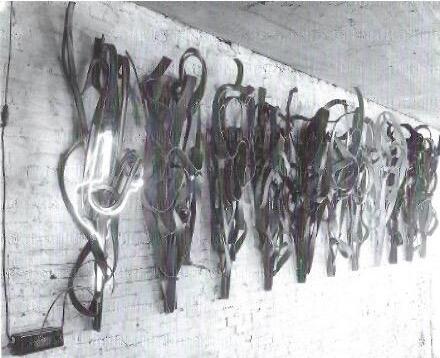
Art Style | Art & Culture International Magazine 144
Figure 15. Richard Serra, Belts , 1966 -7, Eleven vulcanized rubber belts and neon tubing, 213.4 x 731.5 x 50.8 cm, New York, Solomon R. Guggenheim Museum, © 1994 Richard Serra/Artists Rights Society.
Art critic Eunsil Oh noted that the rubber band is not only widely used by contemporary artists, but also common in everyday life. Therefore, given that there are many artists Martha Friedman, Francesc Serra Vila, Megan Geckler, Sabine Reckewell, Eunhye Kang, etc., generally using rubber band as a material between walls as well as walls as material, and creating shadows through lighting, it is even more unreasonable to argue that only Mongju “used a unique material as art material.”38 In fact, she tried to use various materials throughout her solo exhibitions, and it was not until 2014 that she started using rubber bands. Therefore, the first trial court’s judgment that Mongju has been using rubber bands as material since 2003 was really wrong.39 Although Junghyun’s artwork went through an independent development process, the court committed the error of judging that she illegally borrowed and produced the image of Mongju.
Besides, Junghyun’s artwork aimed at mutual communication with the audience throughout the exhibitio n period, i.e., a kind of ever-changing performance. E ven her artwork itself could not remain the same from start to finish. In spite of this artwork is dialectics of time and space, that court reached the first decision, relying as usual upon only the photograph s presented by the two artists,40 for which I argue that the judge decided not by sculpture, but by photo graph . Jeff Koons vs Art Rogers’ copyright lawsuit has also been criticized because the court judged the artworks only by looking at the pictures without actually looking at the work, and from now on, it is urgently requested to correct the mistake of judging only the videos and photos submitted by the parties. Even famous art critics carefully judged the artworks by looking at them several times. It seems unreasonable that a judge who did not major in art or did not receive art classes would evaluate sculpture especially changeable installation only by photograph of it. Thus in the trial of Jongsook Kim vs Inkie Whang has significant implications for future cases what the court directly viewed the artworks of the parties and invited art experts to judge them.
IV. Conclusion: A Proposal of Anti-plagiarism Measures
In order to understand an artist’s artwork, especially of modern art, given that it requires professional knowledge, including history, theory, and practical skills of art, and must be able to review artist-specific expression techniques, philosophy, and original reinterpretation. Because modern art overturned and destroyed the traditions of past art. Not only did it destroy the traditional concept of production, but also it went to the point where the artist’s idea itself was recognized as an artwork. In addition, since the 1960s, the concept of appropriation has been incorporated into modern art, and imitation at all levels has been recognized as creation, and it is moving to a point where it is accepted as a new art trend.
Art Style | Art & Culture International Magazine 145
The current copyright law, discussing substantial similarity between the original artwork and the plagiarized artwork, focuses only on the expression by dividing idea and expression dichotomously. I argue that the idea/expression dichotomy principle is applicable only to formalistic art, but not to subsequent art that values the idea or content of the artwork. The basic characteristic of appropriation in art is that the idea itself replaces the traditional creative process and results. In other words, the concept of an artwork itself is the logic of art. From that point of view, the idea/expression dichotomy principle should be also reconsidered.41 And even the artists born in the same or different era and raised in a similar or different environment can think that their artworld can be similar to that of other artists. So, when an artist encounters an artwork similar to his style, he or she should fully study and review two works before raising suspicions of plagiarism. However, there is virtually no way to prevent indiscriminate plagiarism now. If so, it will be necessary first to present the limitation or boundary between creation and plagiarism to the artists who plagiarize consciously or unconsciously.
Some art critics argue that, when discussing whether or not an artwork is plagiarized, it is rational to see the overall feeling and meaning of that artwork that is judged as expressing the artist’s original creative intention. However, there exists a disadvantage that this argument can only be applied to visual art as a whole. In other words, photographic art is difficult to include. For instance, as for Michael Kenna vs Sungpil Kim, the overall feeling or meaning of the photographic works of the two artists is not easily seen. This is because in photography art, the originality of photography is recognized through countless operating techniques of photographers and cameras even with the same subject. However, as for Hyunjin Park vs Sookjin Chung, the image of a peacock is almost same, but there is only a difference in color. Why is this case recognized as plagiarism? Or should we strengthen the copyright law of photographic art? Wouldn’t zooming in or zooming out the pivotal area when filming the same subject in the same spacetime rather cause a problem of plagiarism?
The basic characteristic of appropriative art is that the idea itself replaces the traditional creative process and results. In other words, the concept of an artwork itself is the logic of art. From this regard, Pierre Bayar encourages people to avoid recognizing ideas like text, 42 and further E. Winkowski suggests three factors: First, use context as a clue to interpret meaning, Second, consider context in relation to the meaning stated by the appropriated artist, and third, acknowledge that new meaning does not end fair use interrogation. 43 In other words, the similarity of appropriated artworks should be approached from the perspective of the subjectivism of the artist who created the new idea, away from the formalism of distinguishing the visual difference that appears on the screen of the two artworks. It means a transition from text-centered thinking to text+contextcentered thinking.
Art Style | Art & Culture International Magazine 146
Thus, it is also worth noting the demand for revision of discriminating methodology in the legal community for this similarity principle. Sangjung Lee proposes to regard freedom of expression recognized by the Constitution as the basis for recognition, to use the fair use system and legal permission system. 44 In addition, Jung-in Lee also encourages the acceptance of the legal permission system.45
If you can’t stop it as the appropriative trend prevails in modern art, it’s also important to find a technique or measure to distinguish it from the original. As the simplest way to determine plagiarism in visual artworks, Sangjo Jong saw that it was possible to determine whether it was substantially similar through the overall feeling and meaning of the artwork.46 What is further here is the discussion of the principle of similarity between the original and plagiarized artworks. There is a 20% processing rule in this principle, which argues that copyright infringement can be avoided by changing the original artwork up to at best 20%. However, this formula is not reliable because plagiarism is not a mathematical formula. Even a small quantity of reproduction can be a copyright infringement if it is plagiarizing the characteristic part of the original. 47 Now, let’s look at Donguk Cho’s suggestion. He, with a scientific tool, guided a way to distinguish between the original and plagiarized artwork. It is to select the curve and straight-line shapes processing method used by two artists as a specific vector. In other words, the composition of the boundary region is divided into 16 types, the entire image is divided into 16x16 sub-images, and a specific vector is extracted through its histogram distribution.48 As a result of this experiment, nonetheless it is possible to distinguish artworks properly when viewed with the eyes, but it can be seen that it is easy to distinguish between the original and plagiarized artworks by analyzing the processing form of straight lines or curves.
In some cases, guidelines for preventing plagiarism have been presented, so it is introduced. The Massachusetts Energy and Environment Administration in the United States ran a baby duck stamp program to preserve wetland habitats and wildlife, presenting guidelines for plagiarism of participating works. Among them, there are some items regarding “what to do” and “what not to do”. What to do is “to copy your own photograph to create a work of art, to buy the rights to use a photograph from the photographer, but remember that you do not obtain the right to copy someone’s art or photograph by simply purchasing a book or magazine containing their images, to copy works that have exceeded the time limits for copyright protection.” And what not to do is “not to copy someone else’s photograph to create a work of art, not to copy a picture that has been printed in any form including book, magazine, etc., not to copy a major part of a photograph and place it in a different setting.”49
Art Style | Art & Culture International Magazine 147
World art is moving by Western, especially the United States and Europe-centered system. Therefore, Korean modern art was also formed by that influence, and it continues to follow that trend. In American culture, it is customary for an artist to ask for a consent in advance if he or she wants to appropriate another artist’s artwork. However, in the East, such culture is not so familiar. So most of the artists in the East wish to appropriate more covertly. To the artists who wish to appropriate, I give an advice to have a unique art philosophy and to appropriate another artist’s artwork.
Author Biography
Byungkil Choi, Honorary Professor, Department of Arts, College of Art and Design, Wonkwang University, Republic of Korea. Major in Aesthetics, PhD thesis: “Eine Untersuchung über das Urteil der klassischen Schönheit bei Winckelmann (1995).” Recent Research: A Study on the Utilization of Color Theories in Kurt Schwitters’ Collages (Journal of the Association of Western Art History, 55, 2021), A Study on the Structural Transformation of Composition and Its Aesthetics in Roy Lichtenstein’s Early Pop Comic Strips 1961-1965 (The Journal of Europe Culture Arts, 23, 2021), Deleuze’s Anti-Platonist
Concepts: Its Possibility as Tool for the Interpretation of Modern Art (Bulletin of Korean Society of Basic Design & Art, 22, 2021), etc.
Email: cebhi@naver.com ORCID ID: 0009-0005-0417-3800
Acknowledgment
This work was supported under the framework of international cooperation program managed by the National Research Foundation of Korea (Project Number: FY2021 NRF-2021K2A9A2A20101532)
Notes
1. Manet’s Olympia is based on Giorgione’s Sleeping Venus, Picasso’s Maidens by Velázquez’s Maidens, and Duchamp’s L.H.O.O.Q. by Da Vinci’s Mona Lisa. In the 1960s, this imitation possessed the image of the mass media, and in the 1980s, the exclusive use itself was used as the main creative method, Jajung Yoon, “How Far Is the “Imitation” Allowed in Modern Art?,” Aesthetics, 30 (May 2001): 334.
2. Heekyoung Cho, “Recent Caselaw from USA and Europe on Appropriation Art and Copyright,” Ewha Law Journal, 23 (2), 2018, 82.
3 Sangjo Jong, “Substantial Similarity Tests as Applied to Artistic and Functional Works,” Seoul Law Journal, 44 (1), 109.
4. Korea Air, accessed October 17, 2022, https://www.yna.co.kr/view/AKR20140114198551005
5 Ibid. Unless otherwise noted, all translations are my own.
6 Eunsil Oh, “A Study of the Plagiarism Cases in Contemporary Art” (PhD diss, Graduate School of Kookmin University, 2016), 101-102
Art Style | Art & Culture International Magazine 148
7. Ibid., 115.
8. Ibid., 143.
9 Ibid., 148
10 Ibid., 148-149
11 Ibid., 120-121
12 In her work, “Inconvenience” is the concept that “they and humans become humble in the face of the inconvenience caused by removing architecture from art, design, and architecture in art, not perfect art, design, and that will be their integration, our communication,” Eunsil Oh, “A Case for the Demolition of Works by Law Decision,” Misulsegye, 54 (April 2017): 134.
13 Ibid., 130.
14. Mongju Son suggested her creative composition as follows: 1) Action to make the wall filled with rubber strip; 2) Action to wall sketch composed of rubber strip; 3) Method to make angular sketch; 4) Format to connect with the walls of exhibition hall; 5) Format to fill only one wall with rubber strips; 6) Format to pull rubber strips tightly between the walls; 7) Format of space splitting seeing through the far space; 8) Format using light and shadow; 9) The rest, Donghyong Lee, “The Suggestive Point on the Dispute about Plagiarism in the Field of Artwork Seen through the Case of Disturbing by Junghyun Park-Focused on the Judgment of Busan Higher Court 2012,” 6. 24. 2017. NA 339, (Co.) Announcement of the Winter Joint Academic Conference by The Korean Culture & Arts Law Society and Law School of Kyungpuk National University, 2022, 1-66.
15 Daegu Gallery, accessed October 16, 2022, http://news.imaeil.com/page/view/2014040507324696635
16 Donghyong Lee summarizes the main reasons as follows: “Because the creative expressions of Mongju Son’s work, such as the placement of rubber bands in the space and the resulting space creation, and the shadow effect of using lighting, are revealed in the works of Junghyun Park in this case, the overall concept and feeling given to the general public are very similar, and the material, rubber band density, and space utilization of Junghyun Park’s work in this case, which Junghyun Park claims to be characteristic, do not overwhelm Mongju Son’s work in this case,” Donghyong Lee, op. cit., 66.
17 Donghyong Lee classified it into ‘similarity with known expressions’, ‘judgment on the characteristics of tools and materials’, ‘judgment on formative judgments such as triangles and rhombus’, and ‘judgment on the general characteristics of installation art’, and analyzed the summary of the appeal trial’s judgment (Ibid., 67-69).
18 The Supreme Court 98Da 43366, Korea.
19 Eunheui Choi, Standard of Creativity in the Copyrightable Photographic Works, Journal of Korea Contents Association, 15 (2015): 98.
20. Junu Park, “Copyright Infringement of Copycat Photographs of Natural Objects,” Copyright, 2014, Summer, 50.
21 Hyunchul Kim, “Photographic Arts and Copyright,” Photographic Arts and Copyright
Discussion Materials, Ministry of Culture, Sports and Tourism, Korea, 2013, 4.
22. Ibid., 9. In Korea, with the revision of the Copyright Act in December 2011, fair use regulations were introduced to determine whether the use of photographic works corresponds to fair use.
23. Pyeongjong Park, “Photography and Copyright,” Photographic Arts and Copyright
Discussion Materials, Ministry of Culture, Sports and Tourism, Korea, 2013, 16.
Art Style | Art & Culture International Magazine 149
24 Eunsil Oh, “A Study of the Plagiarism Cases in Contemporary Art,” op. cit., 104
25. Kodai Kimura, “Photo Copyright: The distance between ‘similar’ and ‘infringement’ under Japanese Copyright Law,” accessed October 12, 2022, https://artlawworldjapan.mystrikingly.com/blog/photograph
26 Eunsil Oh, “A Study of the Plagiarism Cases in Contemporary Art,” op. cit., 110
27. Photo District News, Accessed October 12, 2022, https://pdnonline.com/photography-business/copyright-law/5-questions-to-considerbefore-you-sue-a-copy cat/
28 Byungkil Choi, “The Plagiarism of Artworks are Steal of the Artist’s Spirit,” Wolgan Misul (October 2001): 186 -187.
29. Simon Stokes, Art and Copyright (Bloomsbury Publishing, 2001), 124.
30 Youngok Son, “A Study on the Reality and Limit of Copyright Protection of Parody,” Law & Technology, 8(4), 2012, 35.
31 Art Co Legal, accessed October 12, 2022, https://arteco.legal/69
32 Korean Spirit, accessed October 12, 2022, http://www.ikoreanspirit.com
33 Korean Artist Project, accessed October 12, 2022, http://www.koreanartistproject.com/kor_artist.art?method=artistView&auth_reg_no=55& flag=vr
34 Eunsil Oh, “A Study of the Plagiarism Cases in Contemporary Art,” op. cit., 171-172
35 Ibid., 187
36. Jonathan Fineberg, Art Since 1940-Strategies of Being, Harry N. Abrams, Inc., Publishers, 1995, 318-319.
37 Richard Serra, accessed October 12, 2022, https://en.wikipedia.org/wiki/Richard_Serra
38. Eunsil Oh, “A Case for the Demolition of Works by Law Decision,” op. cit., 132.
39 Ibid., 132.
40 Ibid., 135.
41. A work is a creation that expresses human thoughts or feelings. Therefore, it is said that human thoughts and emotions themselves are not tolerated as works, and must be expressed in some form. However, even in this case, there are exceptions such as the principle of unity (Cf. Donghyong Lee, op. cit., 76-77.), I would like to request the establishment of a new principle for appropriation art. This is because in conceptual art such as appropriation art, the concept or idea itself encompasses the creative process of traditional meaning. In the aforementioned paper, Youngok Son also pointed out that the dichotomous approach of idea/expression does not fit the concept of creation of modern art in which the idea itself becomes a work of art, Youngok Son, op. cit., 37.
42 He saw the idea of material selection as a living genius, not a fixed entity, but constantly moving and changing (Pierre Bayar, Le Plagiat Par Anticipation, tr. Seonhee Paik, Summer Hill, 2010, 97.). Eunsil Oh is a representative example of a plagiarism lawsuit in Korea, Mongju Son vs Junghyun Park is holding up, and the plaintiff Mongju Son quotes Bayar’s view as refuting the claim about the similarity of the material called rubber band used in the installation art of both (Cf. Eunsil Oh, A Study on Plagiarism Dispute of Modern Art: Focused on the Case, Mongju Son vs Junghyun Park, Art Theory and Field, 23, 2017, 185).
Art Style | Art & Culture International Magazine 150
The lawsuit was closed only after going to the appeals court, and Junghyun Park won the case. This researcher would like to review two things about this ruling. One is that the judge judged only by the photos of the two artists in the process of reviewing the works, and did not recognize that it was fundamentally impossible to compare the two, especially in that it was a viewer-participating installation art. Such a view is also in line with Bayar’s view.
43 From the perspective that it is difficult to figure out the power of interpretation of the meaning hidden in an appropriated artwork and the logic of the context, he saw that the court should use the context as an additional assistance to grasp the purpose and characteristics of use factor in the analysis of fair use, cf. E. Winkowski, “A ContextSensitive Inquiry: The Interpretation of Meaning in Cases of Visual Appropriation Art,” The John Marshall Review of Intellectual Property Law, 746, (2013): 763- 767.
44 However, the current Korean copyright law neither stipulates that copyright does not take effect on parody, pastiche, or satire that complies with the rules of expression as in Article 122-5 of the French Copyright Act, and nor have regulations on fair use as in Article 107 of the US Copyright Act, Sangjung Lee, “Appropriation art and Copyright,” Seoul Law, 18 (2010): 339.
45 He refers to the views of Bresler, an American lawyer. In other words, he says that it is difficult to operate the legal permission system that Bresler claims in Korea because the art markets of the two countries are different. However, it was considered possible to modify some of the contents and adjust them to suit the reality of Korea, Jungin Lee, “Infringement of the Appropriation of Portrait in Contemporary Art,” Journal of Modern Art Studies, 16 (2012): 179.
46 Sangjo Jong, op. cit., 122.
47. N. Schaumann, Fair Use and Appropriation Art, Cybaris@, 6(1), 2015, p. 130. If the creative part and the non-creative part of the work are duplicated together, the question is whether to compare the work as a whole to determine whether there is substantial similarity or only the remaining part after separating the parts that cannot be protected by copyright. The U.S. court has developed both methods through precedents, and has applied different methods depending on the nature of the work subject to litigation. The U.S. courts have applied differently depending on the comparison target among the overall approach, the decomposition approach, and the external and internal tests. In Korea, in the case of art works, they are judged in light of the overall composition and overall expression form, or only the creative parts are judged separately (Cf. Mihee Kang, Appropriation Art’s Scope of Permission under Copyright Law, Jeonnam National University, Treatise of Master Degree, 2012, 30-37.). The French courts are considering the sentiment, overall impression and merits of the two artworks being compared. Soogon Park and Taihee Kim, “A Study on Standard for the Determination of Copyright Infringement in French Law,” Kyung Hee Law, 50 (2015), 326.
48 Donguk Cho, “Development of Plagiarism Inspection Supporting System for Protecting Culture Contents Properties,” The 21st Spring Conference of Korea Information Processing Society, 11(1), (2004): 642-633. Donguk Cho, A Survey of Plagiarism Inspection Method for Efficient Protecting of Intellectual Properties and Proposal of Artworks Plagiarism Inspection, Autumn Conference of Korea Contents Society, 1 (2003): 75-76.
49 2023 National Junior Duck Stamp Contest, accessed October 12, 2022, https://www.fws.gov/program/junior-duck-stamp/junior-duck-stamp-contest-information
Art Style | Art & Culture International Magazine 151
Bibliography
Cho, Donguk. “Development of Plagiarism Inspection Supporting System for Protecting Culture Contents Properties,” The 21st Spring Conference of Korea Information Processing Society, 11 (2004): 642-633.
Cho, Heekyoung. “Recent Caselaw from USA and Europe on Appropriation Art and Copyright,” Ewha Law Journal, 23 (2018): 82.
Choi, Byungkil. “The Plagiarism of Artworks are Steal of the Artist’s Spirit,” Wolgan Misul (October 2001): 186 -187.
Choi, Eunheui. “Standard of Creativity in the Copyrightable Photographic Works,” Journal of Korea Contents Association, 15 (2015): 98.
Fineberg, Jonathan. Art Since 1940-Strategies of Being, Harry N. Abrams, Inc., Publishers (1995): 318-319.
Jong, Sangjo. “Substantial Similarity Tests as Applied to Artistic and Functional Works,” Seoul Law Journal, 44 (1), 109.
Kim, Hyunchul. “Photographic Arts and Copyright,” Photographic Arts and Copyright Discussion Materials, Ministry of Culture, Sports and Tourism, Korea, 2013, 4.
Kimura, Kodai. “Photo Copyright: The distance between ‘similar’ and ‘infringement’ under Japanese Copyright Law.” Accessed October 12, 2022.
https://artlawworldjapan.mystrikingly.com/blog/photograph
Lee, Jungin. “Infringement of the Appropriation of Portrait in Contemporary Art,” Journal of Modern Art Studies, 16 (2012): 179.
Lee, Sangjung. “Appropriation art and Copyright,” Seoul Law, 18 (2010): 339.
Park, Junu.“Copyright Infringement of Copycat Photographs of Natural Objects,” Copyright (Summer 2014): 50.
Park, Pyeongjong. “Photography and Copyright,” Photographic Arts and Copyright Discussion Materials, Ministry of Culture, Sports and Tourism, Korea, 2013, 16.
Park, Soogon and Taihee Kim. “A Study on Standard for the Determination of Copyright Infringement in French Law,” Kyung Hee Law, 50 (2015): 326.
Son, Youngok. “A Study on the Reality and Limit of Copyright Protection of Parody,” Law & Technology, 8 (2012): 35.
Stokes, Simon. Art and Copyright Bloomsbury Publishing, 2001.
Winkowski, E. “A Context-Sensitive Inquiry: The Interpretation of Meaning in Cases of Visual Appropriation Art,” The John Marshall Review of Intellectual Property Law, 746, (2013): 763- 767.
Yoon, Jajung. “How Far Is the “Imitation” Allowed in Modern Art?,” Aesthetics, 30, 2001, May, 334.
Art Style | Art & Culture International Magazine 152
Film Festivals as Aesthetic Experiences
Theories of Affect and the Collective
Peter Virginas
Abstract
Film festivals may be distinguished by virtue of their collectively felt atmospheres, and, while oscillating between uniqueness and the generic, they equally provide and require specific moods. Characterized by an intense schedule of film projections as well as observing the elongation of the cinematic by way of meeting and celebrating film-makers, film festival phenomena comprise several elements which play into their atmospheres. The author argues that tracing the becoming of those elements draws us closer to the role of film festivals as well as to our experience thereof. Breaking down the complexity of the film festivals is effected by drawing on similarities with art exhibitions. Drawing on the argument that their prime functionality lies in supporting films as works of art, the study pinpoints how film festivals become aesthetic milieus where common, shared aesthetic experiences are enabled. A collective dimension of experience is to be maintained to the extent that curatorially blended festival programs group certain films or establish connections among them, thereby ‘quasi-synchronically’ orienting festivalgoers. Film festival events reconfigure the position of spectators within the aesthetic dimension. Applying the concepts of affect and percept is relevant to grasp both the pre- and transindividual dimensions which contribute to the experience of film festivals and make up their atmospheres. The event-like character of the film festival, as a temporal organisation feeding on film images and re-enabling affects as various bodies (spectators, film creators and so on), we may well understand its significance on a representational level. Meanwhile, looking through the lens of body studies and Deleuzian affect theory, the experiential domain of the unrepresentable, affective capacities alludes to the formation of the collective and the subjective, as both coming into being. The study ultimately aims to reveal the multidirectional dynamics between film festivals and certain ingrained structures, like spectatorship and cinephilia.
Art Style | Art & Culture International Magazine 155
As sociocultural phenomena, film festivals may be distinguished by virtue of their collectively felt atmospheres, where their mood-inducing effects are related to an intense schedule of film projections. Tracing the elements which make up their fleeting atmospheres, a phenomenologically defined perspective is useful both when arguing for particularities of given film festivals and describing our experience thereof.
By taking film festivals as space-time complexes (deValck and Loist 2009, 1792015) scholarship has been drawing attention to the processes underpinning film festival events, as well as to the composite nature and manifold functions of film festivals As such, to the extent that aesthetic experiences remain essential aspect of participation at film festivals, we may draw an initial parallel with art exhibitions. Specifically, as socially constructed settings, film festivals appear similar to largescale art exhibitions that feature or present a variety of artistic works. Such dynamics, it is argued, engenders modes of experience to capture art-works’ inherent, autonomous significations, while the frame of the collective exhibition, or curatorial concepts constitute further layers of coding (Osborne 2013, 162). To be sure, medium-specific usages of the film are tempting as a conceptual shortcut to contemporary forms of art (as approached by art theorist Peter Osborne). However, apart from homologous recombination, such view appears to reiterate the function of art exhibitions as being dedicated to the forms of art. So, by presenting and validating films as works of art, or as objects with aesthetic values, a prime functionality of film festivals appears to be that of supporting film as form of art.
Not only do festival-phenomena appear as aesthetic milieus in connection with films as works of art but it has been also suggested that film festivals enable common, shared aesthetic experiences (cf. Harbord 2009, 43; Harbord 2016, 72). The fact that film festival programs constitute objects which are experienced in crowded settings may be rather obvious Spectators’ aesthetic experiences are part and parcel of the ‘film festival complexity’ triggered by mediatedness, especially when taking into consideration the enhancement of the cinematic by way of meeting and celebrating film-makers. Moreover, films carry the subjective imprints of their makers, while film festival programs are, in effect, emulating related festival- and film-viewing experiences of the festival programmers themselves Specifically, discursive efforts to repackage the world or worlds thrive
Art Style | Art & Culture International Magazine 156
Introduction
on experiences of others, that is on projections of subjectivities, which in our case are already mediated since film frames are constructed and appear through subjective lenses. Film festivals contextualize everyday, mundane film screenings, and represent the world in its diversity (provided we conceive the world as diversity or in its diversity). By taking into consideration the aforementioned, curatorially blended festival programs whereby connections established among individual films are established and being operated ‘quasi-synchronically’ by diligent festivalgoers, we may provisionally contour a collective dimension of experience.
To the extent that ineffable and transient qualities bumping and sliding into one another on the border of experience may be traced back to a Jamesian pure experience, an interlinking of the social component of the festival event with the film both as a medium and form of art , is to be viewed in terms of the pre and transindividual levels and occurence. In a similar manner, moving from the aesthetic object of the film toward body studies diverges from representation. Notwithstanding a comforting relevance of the discourse of the unrepresentable, in what follows, an approach from affect theory is useful, I suggest, to break from aesthetic receptivity so that the experience of film festivals would complete that which is an unavoidable benchmark in film studies, namely the notion of ‘spectatorship.’
Embodiment, Performance and Perception
The fact that we sense the world with our bodies is a straightforward claim after Merleau-Ponty; the perspective of the body as experience builds upon the everydayness of embodiment, but any essential feature of bodyness should raise further issues (since it includes also that which about we aren’t aware or conscious of). Accordingly, one can refer here to the relationship between the mental and the somatic, as well as to that between the conscious and less conscious features of perception; those, on their turn, engender different levels of experience while re-emphasizing not so much the agential role of affects, but imbuing the emergence of the social and the individual in a simultaneous manner (see for e.g. Massumi 2002; Massumi 2015; Blackman et al. 2008). In our case, we may refer to the fact that (engaged, or undistracted) film viewing means one is having cognitive
Art Style | Art & Culture International Magazine 157
appraisals and bodily reactions; such considerations extend also to investigating the causality of emotions (Plantinga 2009), while it also reassures one’s path of analysis toward the issue of perception in film studies (see for e.g. Elsaesser and Hagener 2010). Accordingly, perception is eventually grasped not just as arising from or within a body but also as simultaneously creating (different) ‘bodies,’ or meanings.
With regard to the cinema, an initial starting point was provided by Adorno, according to whom a spectator’s eyes fixated onto the movie-screen perform the same movements as the eyes of the other viewers; it joins the ‘current’ of all those who are attracted to the spectacle (Adorno 1991, 183‒184). Similarly, we can also refer to the illusory nature of film characters’ perspectives to the extent that those betray the subjective handling of the movie camera, or they come to exist as depending on or enabled by the latter (see for e.g. Sobchack 2009) The perception of the movie image is based on mimicry, and the (function of the) film becomes ideologically inflicted, whereby we can refer to a joining of the aesthetic and sociological aspects of the film, which at the same time designates the spectatorial subject created by the film. Notwithstanding the notion of spectatorship, the film, according to the perspective put forth by the critique of ideology, falls short of its (aesthetic) potentials because of its uninhibited massappeal and production-enabled seriality Consequently, collective subjectification by mass- or popular media has been widely criticized ever since; a cultural studies approach notwithstanding, the performative aspect of art forms, or their performative modalities are significant, especially if we consider specific forms of art as being conducive to expressions or enactments of what is possible, and thereby contributing to a ‘diversification’ of the previously de-individuated/ dedifferentiated common body of the audience (Guattari 1995, 91) In a somewhat similar manner, audience – or spectators’ participation that comes to be regarded as performative in terms of its active potentials may be opposed to aesthetic experience defined by habit and recognition, or being organized by anticipations and retentions, and therefore considered as having passive potential only
The spectator appears in the Guattarian paradigm as a set of elements of subjectivity, or as a psycho-structure with multiple components, which is dependent on a sort of openness, with any perspective of the self appearing only at the starting points and endpoints of aesthetic experience. On the one hand, the outcome constitutes a token of repetition; the unrepeatable (an instance which marks artistic performances and which permeates the spatiotemporal contraction of the film festival-event) and the repetition are being constituted through their
Art Style | Art & Culture International Magazine 158
interrelationship. While this may suggest a dialectical move, or even a thinking in accordance, it also conveys a flexibility of its own, much in the same way as the performative aspect comprises both a repeating occurence and an unrepeatable, unique event. The relationship with the artwork can be thought of as an activity implying reception, transformation and return, all of which pass through countless points and variations, where the efforts of understanding and interpretation on the part of the spectator will always be to some degree a referential repetition, since he or she recreates the film frames while mentally processing it, thinking about, or re-imagining it.
Here we may observe a concentration of many perspectives: any claim to an essence of the movie performance, as it comes into being in the specific setting, rests on multiple objectifications; the film as production targets the ideal spectator, or the impersonal, and therefore a collective. And, a similar claim of objectification marks the perceptual act of the spectator, as well as aspects of desire (even if such concerning desire has been mutated or modified so that it isn’t obvious anymore who or what constitutes its object, or whether it has any object at all…). Here the ‘deterritorializing’ and ‘reterritorializing’ processes applied to grasp the effect of artwork serve to revisit the idea of perception as being the starting point (therefore, the spectator should remain neither starting point nor endpoint for analysis).
Aesthetic Affects
Spectators captivated by the screen or captured by it is another way of saying that the movie performance bears affects and intensities; what is bound to settle the contradiction between its impersonal focusing on multiple poles and the active participation as being part of the aesthetic event concerns both the unusual, habitdisrupting quality as well as a playing into subjective experiences (cf. Guattari 2007, 258‒64) The superimposition of subjective becoming and of ‘being positioned’ may be not so obvious: within the discursive mode of filmic representation the ultimate stake is world-creation, that is ‘worlding’, where we become ‘worlds’ as stipulated by Deleuze and Guattari (2011) to grasp the inner transformation through reception of artworks As the change induced by aesthetic sensation is inducing also a becoming into someone or something else, the appearance of percepts in the filmic context means the human becoming is relaying the former; therefore, considering the differentiated relationship of films
Art Style | Art & Culture International Magazine 159
and spectators, the qualities which are felt (and therefore personal and contextual) may coexist with the affects and percepts beyond subjective experiences In other words, we can think of the context as being initially constituted by a film, but the actual (visual or audio) content of which arrives from outside of that context by virtue of being recorded elsewhere and/or previously – a fact which means that it will be actualized in the form of percepts and, by the way of mediation, their effect will be exerted as affects or will create affects.
The perspective of ‘presentification’1 emphasizes the fact that cognition is subsequent to the act of sensory perception which is, to a degree, always a past event (Manning in Massumi 2015, 149); therefore, being both retroactive and forced to be directed toward the future, perception and the perceivers’ subjectivity are coupled as a follow-up (we may add that such a perspective lays bare the contemporary significance attributed to immersive environments as the Deleuzian ‘power of the false’). As visual perception proceeds with proprioceptive input, movie watching in communal spaces, among a crowd of people moulds the experience of one’s body and other human and non-human bodies.2 The underlying claim is that bodies stay or ‘hang’ together due to the affects, or forces and processes organising them and which may be recognized as such only partially.
Based on one of the most echoed starting points of Deleuzian film philosophy, the characteristic images of contemporary cultures of consumption exert such affective, suggestive influence that they uncouple from what is visually present and directly conveyed by the components of images. The emphasis on or the turning to what lies outside the picture frame concerns the not givens of perception, or the components that aren’t (yet) visual or representable; ultimately, the plane of representation won’t capture the affect-percept couplet. With cinema itself being enmeshed with visibility and spectacle while spatially conditioned, the experiential domain finds its escape route (or its necessary ’lines of flight’) via unrepresentable, affective capacities Aesthetic sensations not only evidence the intertwining of physiological and mental states, but enable a correspondingly intensive becoming which doubles the performative event effected by a work of art. Taking into consideration the emergence of aesthetic sensation, the aesthetic dimension enfolds the corporeal, material and the incorporeal, immaterial, all of which are palpable as different levels of experience but connectable and sliding into one another by way of blocks of affects and percepts.
Art Style | Art & Culture International Magazine 160
In a similar manner, if media images, thanks to their affective charges and intensities do become body-images, they depend on ‘bodies-without-image’, or a condition whereby the mental image of the body becomes problematic precisely because of the inherent mirror-image content (cf. Blackman 2012, 15, 177). In other words, the notion of ‘mirror vision’ views bodies as static entities, the aspect of being ‘without-image’ goes against a representational view of the world and refers to a fundamentally affective mode of existence. With change as a consequence of intensities and force effects, movement is eventually exposed, which, in its turn, requires ‘movement vision’ (cf. Massumi 2002, 48‒57). Obviously, a model is provided here by the diachronical organization of the Deleuzian ‘cinema image’ (i.e. the seriality of movie images, the interval between them, and the cut as synthesis). And, for the same reason, the aforementioned different registers (i.e. the body-image and the body-without-image, ‘mirror vision’ and ‘movement vision’, affect and emotion, subject and object, as well as the dynamics between visceral and proprioceptive intensities) while remaining grouped under a sort of conceptual multiplicity, they denote the ‘doubling’ of the body-subject (Blackman 2012, 16), or bring about cleavages in subjectively felt experiences.
Festival-Body and the Collective
Film screenings and film-viewing experiences, as well as social interactions inbetween and public meetings with film-makers mean the communal context of film festival-events. Thereby we may acknowledge the intertwining of various registers which encompass the particular and the plural, individual ‘body-subjects’ and the ‘festival-body’, where spectator-bodies carry tension. First, it can be easily acknowledged that the above-listed appear relevant in the case of events and experiences involving a multitude of participants. The affect theorist Lisa Blackman has proposed the conceptual variant of ’body subjects’ to account for a particular condition designating human bodies as being involved in communication in affective terms Accordingly, the embodiment of the psychological subject has been envisaged as overlapping planes of the intersubjective and the intercorporeal; thereby experiences appear as mediated through connections with other human and non-human bodies (Blackman 2012, 9, 12-13). Here we may observe also that a default mediation of experience means being embodied within the process of mediation. Amidst a temporally fixed organisation of film images and living bodies (spectators, actors and so on), we may advance from a representational level of film festivals.
Art Style | Art & Culture International Magazine 161
The Deleuzian concept of the body concerns relationships among bodies in terms of intensities, degrees and fluxes; as such, it is relevant for both ‘body-subjects’ and the unity conferred to community, or as form of the collective. On the one hand, any forces meeting each other bring about or create bodies, a claim which hits the composition of bodies of (m)any kind(s). Bodies coming together multiply such relations and create additional bodies (Brown and Stenner 2009, 186). Therefore, an emerging sense of collectivity is considered as doubling the multitude coming together: similarly to the Deleuzian assemblage, such understanding of the collectivity becomes a potential, which is open, pure, with ‘every body connecting to every other such that their very difference becomes indiscernible’ (Brown and Stenner 2009, 194).
A cognitive perspective makes it clear that within the process of perception there is an extraction from the film image so that the latter is transformed subsequently and projected back onto its object; therefore, the processual events encompass both the presently unfolding acts of perception and the corresponding changes of states. Thus, on the other hand, sensations register both objects and tendencies which differ from another in the sense that objects refer to countable, separable and spatially defined elements, while tendencies are being grasped in an inherent multiplicity denoting spatial and temporal inseparability Here, as the affect theorist Paul Massumi argues, it is about a qualitatively different aspect which is ‘tendential’ to the extent that, while encompassing an activation of tendencies together at once, it sets the stage for the actual unfolding of a single tendency; thereby, it accounts for pluralities which fill the moment of experience ultimately making it unitary (for the moment) but only to disappear (Massumi 2015, 185-189)
This logic of operation underscores the virtual multiplicity as qualitatively different perspective which accounts for ‘becomings’ and the collective in qualitative terms; it also draws the attention to the transient character of unity based on pluralities. The notion of the collective can have a tendential character because the unity of its elements may appear only virtually, i.e. in the light of the multiplicity. Tendency, on its turn, may refer to the common movement and encounter of bodies within the event whereby the intensity of affects are indicative as their attractive force, or as the folding out of oneself and thus generating belonging, in parallel with the notion of ‘becoming’ understood in the sense of change or transformation; such belonging is to be conceived as not yet bodily felt, but enveloped within the relational setting of the event; in other words, an opening that is set free from any relationship of the participating elements
Art Style | Art & Culture International Magazine 162
The eventness of gathering a multitude of people carries ‘bodies’ in several understandings so that we may go beyond the crowd-essence in spite of its Adornonian relevance for matters of culture. Notwithstanding mass-psychology, or the obviousness of the crowd-effect, ‘bodyness’ is sought not in terms of physical bodies within and creating the multitude, and neither referring to body as extensity, but rather taking affective, incorporeal and transcorporeal transitions as carriers. Considered in such terms, if (any) collective determination is considered necessary also for the production of the subjectivity, then, the collectivity cannot be reduced to experience of the communal ’we’. Therefore, community ideas generally derived from the necessities of social coexistence also imply that a collectivity is formed as an effect, or will be organised around something in a Durkheimian way, and thereby is endowed with or differentiated through a force of its own (such as, for e.g. cohesion). Here one may remind the notion of the ‘quasi-object’ as introduced by Michel Serres (1982) in order to serve as common focus for the dispersed multiplicity to emerge as a collective (Brown and Stenner ibid.). Similarly to the insight that the collective may have multiple appearances, the multiplicity is applied both beyond/above the individual, i.e. on the social level and before the emerging of the personal, on the side pre-verbal intensities; in other words, it follows the logic of affects rather than those of designated sets (Guattari 1995, 9). In this way the ‘transversal’ character of the collective appears as valid for communal and individual or personal levels, while simultaneously enables speaking about subjectivity as both emerging in a shared manner (and so applicable at group levels), while also as having multiple components on the level of a single individual. Accordingly, due to the ways in which it is produced, we may refer also to a collective determination of subjectivity, where the Guattarian insight could be regarded as a double-edged sword with regard to exposing both the workings of the discursive and the limited potential to subvert power positions in active, that is discursive ways. And, as a consequence, one may rightly cut through the notion of the bounded and walled psychological subject, as well as re-assess its causal determination (so far captured by crowd- or mass psychology, which, on its turn correlates the affective overspill of the individual with a de-differentiating melt into a group, or the multitude, see Massumi 2015, 206). Instead, the common embeddedness of subjects and objects is a point of entry having ceased to be static, and which means that situated, and thereby individuated contents and the ‘transindividual’ dimension (the latter understood as ‘correlated differentiation,’ see Massumi ibid.) may simultaneously be grasped
Art Style | Art & Culture International Magazine 163
While taking interpersonal relations, or separation into individuals or groups is helpful to designate a functional sociality, when viewed through the lens of transindividual becoming, the processes of formation of cultural or social forms entail a ‘pure’ sociality which refers to the potential to formation, or the potential as power that enables the ‘becoming’ of any sociality whatsoever (Massumi ibid.). Thus, the Deleuzo-Guattarian thought of a ‘community to come’ is bound to appear, but which shouldn’t be mistaken for a ready-formed collective consisting of particular components or individuals, or with empirical variants of the social (cf. Massumi 2002, 253). We need to carefully observe that we are always at the beginning of that activity in the course of which the ‘incoming’ can be thought; this openness is not to be conflated with a specific own quality of the collective. Likewise, it doesn’t draw the temporal plane where the collective will eventually become resilient to change. The openness as correlated with the undefinable enables for the relation to emerge into existence, but which, on its turn, will determine the elements of the relation
In accordance with the above, the concept of the ‘time event’ in relation to film festival phenomena (Harbord 2009, 2016) underlines a qualitative change also in the sense of organizing experience and subsequently creating subjectivities The emergence and disappearance of references, or ‘anchoring points’ can be interpreted and approximated through differential movements and sensations. As such, differential relationships might as well be interpenetrating though they shouldn’t be confused with the subjective dimension of the experience of change. We may remind that film festivals bring about changes by virtue of their wellversed functionalities (like for e.g., the mediation of films as works of art), and such changes concern spectatorship and cinephilia, to the extent that those are ingrained structures developed and maintained by the film festivals themselves.
Author Biography
Peter Virginas holds a PhD in Philosophy from Babes-Bolyai University, Romania and an MA from Central European University, Hungary. His research interests lie in film festivals and contemporary cultures of consumption. He works as a researcher at the Romanian Institute for Research on National Minorities. Email: peter.virginas@gmail.com
ORCID ID 0000-0001-7565-5472
Art Style | Art & Culture International Magazine 164
Notes
1 Further evidence for a spectatorship operating on the basis of hypotheses could be provided through neuroscientific findings on perceptual best-guessing (see for e.g. Seth 2021).
2 It should be noted that ‘bodies’ which are not considered works of art get also configured along their affecting capacities since they are shaped by planes of composition. Nonetheless, viewing the human as expressive, or an artistic expression shouldn’t be regarded as an instant claim for affects, but rather as suggesting a step back so as to conceive percepts as organizing the human frame of perception, and only thereby turning to affective contours and tonalities which are endowed with aesthetic qualities.
Bibliography
Adorno, T. W. “Transparencies on Film.” In The Culture Industry: Selected Essays on Mass Culture, 178–186. Translated by Thomas Y. Levin. London: Routledge, 1991.
Blackman, Lisa et al. “Creating Subjectivities ” Subjectivity, no. 22 (2008): 1–27. Blackman, Lisa. Immaterial Bodies: Affect, Embodiment, Emotion. London: Sage, 2012.
Brown, Steven D. and Stenner, Paul. Psychology without Foundations: History, Philosophy and Psychosocial Theory. London: Sage, 2009.
Deleuze, Gilles and Guattari, Félix. What is Philosophy? Translated by Graham Burchell and Hugh Tomlinson. London: Verso Books, 1994.
Devalck, Marijke and Loist, Skadi. “Film Festival Studies: An Overview of a Burgeoning Field.” In The Festival Circuit (Film Festival Yearbook, 1), edited by Iordanova, Dina and Rhyne, Ragan, 179‒215. St Andrews: St Andrews Film Studies, 2009.
Elsaesser, Thomas and Hagener, Malte. Film Theory: An Introduction through the Senses. London: Routledge, 2010.
Guattari, Félix. Chaosmosis: An Ethico-Aesthetic Paradigm. Translated by Paul Bains, Julian Prefanis. Bloomington: Indiana University Press, 1995.
Guattari, Félix. Chaosophy: texts and interviews 1972–1977. Translated by David L. Sweet et al. Los Angeles: Semiotext(e), 2007.
Harbord, Janet. “Film Festivals ‒ Time-Event”. In The Festival Circuit (Film Festival Yearbook, 1), edited by Iordanova, Dina and Rhyne, Ragan, 40‒46. St Andrews: St Andrews Film Studies, 2009.
Harbord, Janet. “Contingency, Time, and Event. An Archaeological Approach to the Film Festival ” In Film Festivals: History, Theory, Method, Practice, edited by DeValck, Marijke and Kredell, Brendan and Loist, Skadi, 69‒82. London: Routledge, 2016.
Art Style | Art & Culture International Magazine 165
Massumi, Brian. Parables for the Virtual. Movement, Affect, Sensation. Durham: Duke University Press, 2002.
Massumi, Brian. The Politics of Affect. Cambridge: Polity Press, 2015.
Osborne, Peter. Anywhere or Not at All: Philosophy of Contemporary Art. London: Verso, 2013.
Plantinga, Carl. “Spectatorship.” In The Routledge Companion to Philosophy and Film, edited by Livingston, Paisley and Plantinga, Carl, 249–258. London: Routledge, 2009.
Plantinga, Carl. “Emotion and Affect.” In The Routledge Companion to Philosophy and Film, edited by Livingston, Paisley and Plantinga, Carl, 87–97. London: Routledge, 2009.
Serres, Michel. The Parasite. Translated by Lawrence R. Schehr. Baltimore: Johns Hopkins University Press, 1982.
Seth, Anik K. Being You. A New Science of Consciousness. Dutton, 2021. Sobchack, Vivian. “Phenomenology.” In The Routledge Companion to Philosophy and Film Livingstone, edited by Livingston, Paisley and Plantinga, Carl, 435–445. London: Routledge, 2009.
Art Style | Art & Culture International Magazine 166
Evolution of Visual Culture
Yakup Uzun
Abstract
The field of visual culture, which examines how visual media such as art, film and television shape culture and are shaped by culture, has grown significantly in recent years. This discipline is known as visual culture. Although visual culture had its roots in the early 20th century, it wasn’t until the second half of the century that it became a separate study. Since that time, the study of visual culture has developed to incorporate ideas from other academic disciplines, including sociology, psychology, anthropology, and art history. We can now investigate how images, media, and cultural narratives affect how we see ourselves and the world around us thanks to the study of visual culture. We can better understand the intricate connections between representation, power, and identity by looking at how visual media create meaning. Moreover, in the digital age, when the growth of new media platforms and technology is transforming the way people interact with and consume visual content, visual culture is becoming more and more significant. We can investigate how digital technologies alter our daily lives and consider how they affect our social and cultural behaviors via the lens of visual culture. This entails looking at how visual media influence our identities as well as how they promote social and political change. Understanding the intricate connections between media, culture, and society requires the study of visual culture. We may learn more about how media and technology shape our daily lives and affect how we connect with others by examining the historical development and contemporary significance of visual culture. This study therefore aids in our understanding of how media and technology impact our daily lives, identities, and behaviors by offering an overview of the historical evolution and contemporary significance of visual culture.
Art Style | Art & Culture International Magazine 169
Visual culture is the study of how visual media, including art, film, television, and advertising, influence cultural norms and values.This covers not only the media’s content but also how it is created, consumed, and distributed in society (Petchesky 2021, 361). Visual culture has several facets, one of which is the influence of images on how we view the world. For example, images can convey meaning and our emotions and can have a covert or overt impact on our beliefs and actions (Ümer 2017, 1535).
But it’s crucial to keep in mind that the cultural and historical processes that determine how images are created mean that they are not always objective. A significant part of how we perceive and comprehend the world around us has been shaped by visual culture, which has a long and fascinating history.
The way we depict and communicate through images has changed and adapted throughout history, from prehistoric cave drawings to contemporary digital media. To better comprehend the function that images play in society, it is crucial to conduct a critical analysis of visual culture and take into account the settings in which they are created and used. The way we perceive and comprehend the world and our role in it is potentially shaped by visual culture, which is strongly related to questions of power, depiction, and representation.
The ability of visual culture to transmit ideas and convey meaning via the use of visual components like shape and color is one of its most important traits. This may be observed in the way that political messaging, product advertisements, and cultural narratives are all presented through visual media. Because the pictures and media we see can frequently be utilized to alter our perceptions and beliefs in subtle and unconscious ways, it is necessary to approach visual culture critically. This is especially true in marketing, when carefully constructed visuals are used to appeal to our emotions and desires in order to convince us to purchase items. We can gain a better understanding of how visual culture affects our ideas and behaviors by looking at the circumstances in which images are created and consumed. In this study we will look at visual culture and see how it influences our attitudes and perceptions. Our overall goal is to provide a comprehensive analysis of the development of visual culture and its impact on society.
Art Style | Art & Culture International Magazine 170
Introduction
Exploring the Concept of Visual Culture
Visual culture is the way in which images and visual media shape and are shaped by a society’s values, beliefs and practices. It encompasses many subjects, including art, film, television, internet media. By exploring visual culture, we can gain an insight into the ways in which visual media both reflect and shape our understanding of the world around us. Walter Benjamin was one of the first thinkers to explore how visual images shape our perception of the world. In his essay “The Work of Art in the Age of Mechanical Reproduction” (1936), Benjamin argued that the proliferation of mass-produced images fundamentally changed the nature of art and challenged the traditional arts (Benjamin 1936, 223).
The concept of visual culture was also introduced by Berger (1972) in his book Ways of Seeing. In this work, Berger argued that the ways we perceive and understand visual media are shaped by the cultural, historical and social structures in which they are produced and consumed. He wrote as follows: “Seeing comes before words. The child looks and recognizes before speaking. But there is another sense in which seeing precedes words. It is seeing that determines our place in the world that surrounds us; we explain this world with words, but words can never eliminate the fact that we are surrounded by it” (Berger 1972, 7).
Visual culture, in the words of Mirzoeff, is the process through which visual media, such as television, movies, and social media, both shape and are formed by cultural norms and values. In this context, “visual culture” refers to the creation and consumption of visual media as well as the various cultural contexts in which they are viewed and understood (Mirzoeff 2010, 327). According to Dikovitskaya, “a cultural area of meaning production and communication through visual representation” is visual culture (Dikovitskaya 2005). In general, the study of visual culture aids in our understanding of the many ways that culture both influences and is influenced by visual media.
Art Style | Art & Culture International Magazine 171
The Emergence of Visuality in History
Early on in the history of humanity, the first creatures to walk the world used visual expressions. Humanity began to develop tools and make the leap from hominid to human about four million years ago. In addition to providing protection, stones and sticks also helped create connections with novel forms. The representations from millions of years ago can be seen in the paintings and patterns carved on rocks and cave walls. The various explanations for why these pictures were carved into the rocks and into caverns have been researched. According to cultural researcher David Lewis-Williams, they were likely employed in religious events and used as a means of communication with the spirit world: “There is more to the drawings and engravings found on the cave walls at Altamira, Lascaux, and other locations. They are a part of an intricate system of representation and communication “ (Lewis-Williams 1981, 23). Hence, it is likely that early people created images on rocks and cave walls to represent their ideas, emotions, and experiences. People began to develop ways to store visual information as they continued to evolve as a species. The creation of writing was the earliest of these techniques. Writing and visuals came to work together as a whole. For instance, the ancient Egyptians created the hieroglyphic system, a written language that expressed concepts using pictures as symbols. Moreover, hieroglyphs were utilized to document and commemorate the accomplishments of their gods and rulers. The employment of pictorial symbols in hieroglyphs demonstrates the significance of visual culture in Egyptian society. Ikram cites Egyptian hieroglyphs’ detailed and sophisticated design as proof of the ancient Egyptians’ commitment to aesthetics and their conviction in the value of visual communication (Ikram 2005, 45).
On the other hand, the ancient Greeks possessed an artistic perspective and a highly established system of writing and communication. In the private sphere, friezes and mosaic embellishments were utilized, while in the public sphere, sculptures and reliefs. Of course, the Greeks’ conceptions of visuality went beyond mere aesthetics. The visual was seen as a potent tool for communicating thoughts and comprehending reality in ancient Greece. Plato claims that the power of sight is the most illuminating of all the senses and the most comprehensive and accurate transmitter of truth in his dialogue “Theaetetus” (Plato 2021, 155d). During the period of classical Greek civilization, Greeks used visual imagery to depict various subjects such as mythological stories and the narration of daily practices. Beard argues that the visuality of Greek culture was closely linked to the notion of the
Art Style | Art & Culture International Magazine 172
ideal human form and that the human body served as a model for artistic representations of gods and heroes (Beard 2007, 78). Visuality was used not only as a representative of communication and art, but also for propaganda purposes. In Roman civilization, visuality was used to glorify the monarchy and create the image of a powerful empire. In Roman Art, the focus was especially on emphasizing splendor and power (Pollini 2012, 67). Also, to send signals to the society, political and cultural expressions were used on coins and medals. The journey that began with cave paintings left its mark on artistic traditions and had a significant impact on the development of human history and civilization.
Medieval Visuality: Illuminated Manuscripts and Church Architecture
From the fifth through the fourteenth centuries, the Middle Ages span a large time frame. Significant cultural, social, and political changes occurred during this time. Not only did the artwork created represent the architecture, but also the character of civilization. The majority of the artworks created during this time period came from the church and other religious institutions because the church predominated and religion was at the heart of life during that time.
The church, which was recognized to have been the primary patron of art and architecture during this time, had a great impact on the images utilized in church settings (Gürkan and Ergene 2022, 122). For instance, illuminated manuscripts are copies of the Bible and other sacred texts that were prepared for use in churches and monasteries and embellished with images. Another significant element of medieval churches is their stained glass windows, which serve the church’s mission by illuminating passages from the Bible and other sacred texts. Stained glass, in Ruskin’s words, “leads the intellect into a condition of contemplation and the soul into ideas of God,” making it the “most ideal form of sacred art” (Ruskin 1849, 11). The Church persuaded the populace that praying in front of religious icons would result in blessings and health by iconicizing them. Despite religion’s predominance, everyday activities and historical events were also portrayed. These artifacts assisted in transmitting historical information and preserving cultural customs.
Art Style | Art & Culture International Magazine 173
Thomas Aquinas claimed that reason is a need of religion and that it is through reason that we can better comprehend the mysteries of God, in contrast to his fellow clergymen who considered faith and reason as different and distinct worlds. He also thought that reason might be utilized to support Christian views logically and to defend the fundamentals of the religion. The importance of vision and how reality is perceived have both been greatly influenced by the Catholic theologian and philosopher St. Thomas Aquinas. Aquinas analyzes the nature of vision and its function in the acquisition of knowledge in his “Summa Theologica.” The act of seeing, in Aquinas’ view, entails the receiving of light by the sight and its interpretation by the mind. Aquinas contends that our ability to detect the characteristics of objects in the outside world, such as their color, shape, and size, makes vision the most significant of the senses (Aquinas 2012).
The church and monarchs employed iconography to convey their authority and position during the Middle Ages. In paintings meant to evoke admiration for the monarch’s greatness and majesty, kings in particular were frequently shown as larger and more imposing figures. These representations were meant to support societal hierarchy and the notion that God is the supreme authority by acting as symbols of power and legitimacy. Ultimately, how medieval kings were portrayed had a significant impact on how the populace saw them and how they used their authority.
Renaissance painting benefited from the impact of medieval visual culture. The growth of the Western world during this time was aided by the rediscovery of ancient Greek philosophical writings and the exchange of cultures with the Islamic world through the Crusades. The Ottoman Empire’s interactions with the Byzantine Empire in particular helped the West learn about Eastern civilization and affected its cultural development. The Renaissance’s cultural and creative advancements had their roots in the medieval era, which is still a major impact on Western art today. We’ll look at the Renaissance’s revival of themes and methods that were influenced by ancient Greek and Roman art in the part after this one. We will also talk about the long-lasting effects of printing press development and Renaissance book manufacturing on Western visual culture.
Art Style | Art & Culture International Magazine 174
The Visual Revolution of the Renaissance
The Renaissance, often referred to as a “rebirth,” was a time of intellectual and cultural renewal in Europe from the 14th through the 17th centuries. It reignited interest in ancient Greek and Roman art and literature. With a focus on individuals, the Renaissance saw significant invention and originality in the arts and sciences. People were able to investigate their surroundings with the aid of artists like Raphael, Michelangelo, and Leonardo da Vinci during this time. These painters stressed realism in their realistic paintings and sculptures, giving viewers a captivating visual experience. The rising emphasis on individual reason and the declining importance of the Church throughout the Renaissance were two major factors in the growth of rationalism. The shift in the way people are portrayed as independent thinkers may be seen in visual culture. In his Meditations on First Philosophy, René Descartes, one of the thinkers who best illustrated this turn toward rationalism, claimed that the only certain knowledge comes from within the self through reason. Descartes underlined the significance of employing reason and logic, rather than the senses or preconceptions, to arrive at the truth when he said, “I think, therefore I am” (Descartes 2013, 7). A rejection of authority and a shift toward a more scientific approach to knowing are implied by this emphasis on human reason. One of the key individuals who expressed the development of rationality was Desiderius Erasmus. According to Erasmus, attaining knowledge requires cultivating one’s awareness of reality, particularly one’s capacity for vision (Holloway 1965).
Since artists and thinkers attempted to comprehend and study the world around them via the act of looking, this emphasis on the visual arts continued to influence the cultural development of the Renaissance. People’s perspectives on the world around them and how to interpret it changed as a result of developments during the Renaissance. The printing press, which was invented during this time, was crucial to the Renaissance’s visual culture as well as the spread of knowledge. With the invention of the printing press, books could be produced in large quantities, allowing more people to think and understand the world through visuals.
Throughout the Renaissance, picture books were made more widely available to the public, thanks in large part to the printing press. These publications used woodcut pictures that the printing press could replicate in bulk (Tredinnick-Kirby and Poling 2021, 112). These picture books were widely accessible, which greatly aided in the spread of reading among the populace and popularized visual
Art Style | Art & Culture International Magazine 175
storytelling. The widespread creation of maps is an instructive example of the printing press’s influence on visual culture throughout the Renaissance. Before the invention of the printing press, maps were carefully produced by hand and expensive to publish.
Yet, with the development of mass-produced maps made possible by the printing press, geographic knowledge was made more widely available and more reasonably priced for individuals, which helped them create their worldviews (Tredinnick-Kirby and Poling 2021, 112). The camera obscura played a role in the rise of visual culture in the Renaissance. This tool was utilized in conjunction with the printing press even though it wasn’t intended for it. Kepler made significant contributions to the camera obscura’s development. His mathematical calculations and knowledge of optics improved its precision and effectiveness (Oskay 2011, 34). As a result, the Keplerian telescope was developed, enabling celestial body observation. The “pinhole camera” is another name for the camera obscura. It resembles a chamber or box with a hole in the wall. The opposite wall or surface is left with an inverted representation of the scene outside after light travels through this hole. In order to create a more accurate depiction of reality, painters also used the camera obscura as a drawing tool by tracing the inverted image on paper or canvas (Çelebi 2013). Also, according to Çelebi, “ a very essential tool in the evolution of perspective and the scientific study of optics” was the camera obscura (Çelebi 2013, 2). The camera obscura is thought to have been a crucial tool for Renaissance artists because it allowed them to precisely represent their surroundings. Before the invention of the camera obscura, painters had to rely on their own ability and observation to sketch and paint, which frequently resulted in exaggerated depictions of the outside world. The camera obscura allowed artists to trace the inverted image and meticulously represent their subjects.
The advancement of reason and the use of images to represent the outside world was significantly aided by the invention of the camera obscura and the Keplerian telescope. The development of modern photography was made possible by the camera obscura. The Renaissance witnessed a number of additional visual technologies that had a significant impact on visual culture in addition to the printing press and the camera obscura. One of these was the advancement of linear perspective, which made it possible to depict three-dimensional space more accurately and realistically on a two-dimensional surface. This method, which was invented by artists like Filippo Brunelleschi and Leon Battista Alberti, had a significant impact on how art was produced and viewed during this time.
Art Style | Art & Culture International Magazine 176
The invention of moveable type printing during the Renaissance had a profound effect on visual culture since it allowed for the mass production of written works and vastly improved the diffusion of knowledge and ideas. The way information was shared was transformed by this technology. The use of the golden ratio in art and the development of anatomical depictions during the Renaissance were two more visual advances that helped to shape modern visual culture and lay the groundwork for its creation (Parsa 2004, 123).
Enlightenment and the Rise of Visuality
The 18th century saw the rise of the era of enlightenment, a cultural movement that emphasized reason, individualism, and distrust of established institutions and ways of thinking. New means of visual representation and communication emerged during this time in terms of visual culture, and they were crucial in the dissemination of enlightened ideas. Images like paintings, engravings, and prints proliferated during the age of enlightenment. Pictures were utilized to influence public opinion and transmit thoughts about the world in addition to information.
The development of salons, social gatherings where intellectuals and artists could share ideas, is particularly notable for the Age of Enlightenment. In areas including literature, politics, and science, many notable individuals made significant contributions during this time of enormous intellectual and philosophical development. The “Age of Reason,” also known as the Age of Enlightenment, was a cultural movement that valued individualism and reason over tradition and superstition. Martin Jay asserts that the Age of Enlightenment was a pivotal time in the development of modernity, marked by the emergence of a fresh, logical, and secular viewpoint that rejected traditional authorities and praised individualism (Jay 2006).
According to Nicholas Mirzoeff, the Enlightenment was characterized by the creation of visual media that portrayed social issues and the widespread dissemination of scientific and philosophical ideas, which served as examples of a visual culture that used images to communicate complex concepts and engage in political, social, and intellectual debates (Mirzoeff 1999, 9).
The use of art and design to convey political statements was a significant component of the Enlightenment’s visual culture. For instance, many prints and paintings extolling the values of liberty and equality were produced during the
Art Style | Art & Culture International Magazine 177
French Revolution. Similar to this, the abolitionist movement made use of artifacts from this time to further the notion that everyone, regardless of race or socioeconomic standing, is deserving of respect and decency. The Age of Enlightenment addressed key concerns like racism and colonialism while emphasizing individual rights and equality. Several thinkers throughout the Enlightenment had virulently racist and discriminatory beliefs, while Europeans continued to subjugate and abuse people of color.
The focus placed on the capacity of the individual to think for oneself was a key element of the Enlightenment. This viewpoint is consistent with Jean-Jacques Rousseau’s assertion that humans are good by nature and that society is the root of all evil (Rousseau 2012, 3). The visual culture of the time echoed Rousseau’s ideas, and paintings and other works of art showed individuals who engaged in critical analysis. The emphasis placed on scientific inquiry and the pursuit of truth throughout the Age of Enlightenment was another significant feature. The Enlightenment era is reflected in Immanuel Kant’s position that reason is the key to comprehending the universe and that knowledge comes from experience (Kant 1998, 5). Ultimately, the Age of Enlightenment significantly influenced visual culture and influenced how individuals perceive and comprehend their environment. The development of photography, which had a tremendous influence on visual culture, also represented this transformation. The invention of photography caused a profound change in how people perceived and interacted with their surroundings.
The Impact of Photography on Visual Culture
The first permanent photograph was made in 1826 by Joseph Nicéphore Niépce, who is generally credited with developing photography. Nonetheless, the development of photography has been a complicated process that has involved numerous personalities and technological advancements. The camera obscura, a device that employed a small hole to project an inverted picture onto a surface, was one of the earliest pioneers of photography. Several innovators started experimenting with methods to capture and fix images on a photosensitive surface in the early 19th century. The first ever image was made by one of these inventors, Niépce, in 1826 using a technique called heliography. Its name is “View from the Window at Le Gras” (Niepce 1826).
Art Style | Art & Culture International Magazine 178
The development of photography significantly influenced visual culture, influencing how we record and interpret the world around us. The evolution of photography has been aided by numerous individuals, including William Henry Fox Talbot, Louis Daguerre, and George Eastman. Susan Sontag claims in her book On Photography that “Photographs serve as proof. What we have heard about, but disputed, looks verified when we are shown a photograph of it” (Sontag 1977, 3). This claim implies that photography has altered how people perceive reality by making it possible to collect and disseminate information in ways that were previously impractical. In his essay “The Photographic Message,” Roland Barthes asserts that images serve as a kind of communication and frequently convey cultural values and beliefs (Barthes 1977, 16). The proliferation of photography, according to Ariella Azoulay’s argument in her article “The Photographic Condition,” means that images are utilized to further a variety of political and economic goals (Azoulay 2011).
Given that images and photographs are essential to the development of power, a photograph is a communication without a code; we cannot include it in a system of signs that can dispute or confirm its meaning (Barthes 1977, 37). This discourse claims that images can be interpreted in various ways and used to forward an ideological agenda. In addition to these features, photos have the power to oppose authority and promote social change. According to Çakır (2014), a worldwide mass culture that is predominantly fueled by pictures has emerged as a result of the widespread usage of visual media in modern times (123). We are constantly surrounded by visual information in this mass culture, such as ads and social media. How we interpret these visuals is fundamentally based on the act of seeing. Photography has a significant role in recording, preserving, and sharing the world around us since it records this reality in a specific way and enables us to understand it.
Art Style | Art & Culture International Magazine 179
The Role of Cinema in Shaping Visual Culture
Prior to the advancement of technology like the camera obscura, cinema was first created in the late nineteenth century. These early innovators opened the path for innovators like the Lumière brothers and Edison to produce the first moving images. You can think of the change from photography to cinema as a change from still images to moving images. As a result of this change, cinema provided a fresh perspective on how to represent and experience the world through moving visuals. The world could be efficiently mapped and re-represented thanks to cinema’s ability to capture and project movement, which led to the creation of a “dynamic cartography” (Castro 2009, 9). This dynamic cartography has the ability to both represent and record reality as well as to mold it. The advent of cinema represented a fundamental shift in visual culture because it provided a new way to view the world through moving pictures. Due to the widespread production and distribution of moving images made possible by the advent of cinema in the late nineteenth century, this signified a fundamental shift in visual culture (Mirzoeff 1999, 3). This new medium had a significant impact on how people perceived and interacted with their environment, as well as how social life and information were communicated.
It didn’t take long for cinema to establish itself as a significant type of popular entertainment, resulting in the opening of cinemas in cities and towns all over the world. It made it possible to discover various viewpoints and to interchange cultures. The visual culture and how we depict, perceive, and react to the world have been altered by cinema (Heywood and Sandywell 2017, 3). From its origin, cinema has changed in many ways from how it tells stories to how audiences interact with it and has continued to have an impact on visual culture. In addition, it has greatly influenced the development of human imagination and other visual arts like painting and photography. Film has the power to influence and reflect society values, ideas, and attitudes because it is a form of visual culture. The ability to “speak to us in the language of our culture” and to “generate visual metaphors for complicated cultural events” are two things that cinema has, according to Mitchell (1995), who wrote about them in his essay “Interdisciplinarity and Visual Culture” in The Art Bulletin (540). With the employment of creative techniques and visual narrative, cinema shapes and reflects societal ideals. Cinema has grown to be a significant force in modern visual culture as a result of being able to adapt to shifting cultural and technological environments and progress continuously as a result.
Art Style | Art & Culture International Magazine 180
Television: A Visual Medium for Mass Communication
The transition from cinema to television can be understood within the context of visual culture as largely a transition from a shared watching experience to a more personalised and personal experience. With television offering a personalized watching experience in the convenience of our homes, this move represents a fundamental transformation in how we consume visual information (Boberg 2021, 45). The production and distribution of movies and television shows have undergone advances as a result of this shift. The rise of streaming platforms has given viewers access to a wide range of programming whenever and wherever they want, emphasizing the very individualized character of television viewing. The transition from film to television had a significant impact on visual culture, affected how we consume media, and changed how movies and television shows are made and broadcast. According to Hilmes and Jacobs (2021), television has had a tremendous impact on visual culture, serving as a platform for the construction of meaning and interpretation as well as a route for the creation and distribution of images (3). In addition to transforming the way we consume visual material, television has had a significant impact on how society views itself and understands itself. For instance, watching television can evoke strong feelings in viewers, which can affect how people talk about things online (Nian, Hu and Chen 2021). Particularly television commercials have the power to affect people’ purchase choices. Thus, manufacturers develop commercials by taking into account the emotional reactions that their advertisements may generate in order to effectively reach and engage their target consumers.
The borders between news and entertainment are becoming more hazy as a result of the influence of digital platforms on accessibility and engagement of news and entertainment (Garca-Perdomo 2021). Advertising uses a range of techniques to grab viewers’ attention and promote particular items or ideas, having a significant impact on visual culture. These tactics might include everything from the use of memorable phrases and eye-catching images to the presence of celebrities and stirring speeches. It’s vital to approach television and advertising critically and fully comprehend how they can affect our thinking since they affect how we see and understand the world around us. Nonetheless, as they frequently depict reality, it should be acknowledged that television and advertising also have the ability to influence society and morals. As a result, negative ideals and irrational expectations for people may be reinforced. Consequently, it’s crucial to be aware of and take action to lessen the negative effects that television and advertising have on society.
Art Style | Art & Culture International Magazine 181
Globalization and Visual Culture in the Digital Age
It is argued that visual culture has been significantly impacted by globalization. Because of this and the growing interconnectedness of the world, photographs are now widely used. Particularly with the growth of social media and other digital communication channels, it is now much easier to communicate photographs and other visual content across national boundaries, which encourages the appropriation of various cultures. Important problems regarding how power is shaped and how different cultures represent things around the world are brought up by the globalization of seeing. Other cultural traditions and ways of seeing may become distinct or disappear when specific visual languages predominate. It is crucial to consider how the globalization of vision affects how we perceive and comprehend the world, and to work toward a more diverse visual culture (Pauwels 2019, 256). According to Nicholas Mirzoeff, power dynamics influence visual culture and it serves as a tool for social control (Mirzoeff 1999, 3). This approach is in line with dominant powers’ emphasis on the creation of meaning through visuals. According to Seppä (2004), visual culture might be connected to Foucault’s idea of the “aesthetics of the self.” According to him, Foucault’s theories about the construction of the self speak to how visual culture affects how we perceive ourselves and our place in the universe (Seppä 2004, 4). For instance, pictures and media content continuously bombard us with signals about how we should consume, behave, and look in postmodern visual culture. These messages frequently rest on distorted perceptions of reality. They have the ability to affect how we view both ourselves and other people. We might be able to resist the shaping influence of visual culture on our thoughts if we engage with visual culture critically and acknowledge how these messages are formed.
Art Style | Art & Culture International Magazine 182
Online Visual Culture: From Social Media to Virtual Art Galleries
With the rise of social media and online image and video sharing, visual culture has expanded quickly in the internet age. Individuals can use their internet profiles to display themselves to the public whatever they want, which separates their online and real identities (Bagayeva 2022, 40). Visuals that are original and distinctive can be produced using internet technologies. Using these technologies, artists and designers can produce engaging interactive content for audiences, including virtual exhibitions and other interactive content (Baran 2020, 10). Art galleries and exhibitions can be produced using virtual reality technology, which advances the growth of visual culture. While these interactions provide viewers the chance to move around in a virtual space and interact with the works of art on exhibit, they also let viewers experience the works of art from different perspectives. In addition, online communities and platforms have been developed as a result of internet technology, allowing artists to share and discuss their work while also promoting visual culture. The democratization of visual culture has also been made possible via the internet. Now that anyone with internet access may develop and share their own visual content, a wide range of viewpoints and aesthetic preferences are possible. Also, as a result of this, new visual communication formats were developed, like GIFs and memes, which are now fundamental components of internet culture.
The creation and dissemination of a wide range of visual media have been made possible by the internet, which has greatly increased the breadth and accessibility of visual culture. With immersive and engaging experiences that influence how users view and engage with their surroundings, the digital gaming industry has grown to play a significant role in visual culture. “Calm Pictures. The propagation of digital images has an unnoticed visual culture “Rothöhler (2021) describes how the proliferation and dissemination of images in modern society is facilitated by digital games. According to Rothöhler, the networks to which they are connected as well as the devices on which they are played have an impact on the visual culture of digital games. Also, according to Rothöhler, technology like virtual reality have an impact on how the visual culture of video games is developed. In general, the fusion of virtual reality and internet technologies has made it possible to produce unique and immersive visual experiences. By creating audienceengaging content, artists and designers using these technologies contribute to visual culture.
Art Style | Art & Culture International Magazine 183
The Role of NFTs and Metaverse in the Evolving Landscape of Visual Culture in the Digital Age
Because they reflect the ownership and trade of digital artwork, NFTs have recently gained popularity (Nadini et al 2021). NFT tools enable people to invest in digital art and for artists to monetise their creations. NFTs are being used in the art world, however this raises concerns about ownership, genuine production, and the blockchain technology that underpins NFTs. NFTs are a wonderful instrument for artists to obtain attention and make money, according to some, while others claim that their use further commodifies art and diminishes its value. Ultimately, NFTs play a complex function in visual culture, and as they gain popularity in the art world, it’s probable that people will continue to disagree over how they affect it. The distinction between reality and virtuality is blurred through metaverse networks, which have gained popularity and significance in visual culture. It is debatable if the interactive, immersive metaverse, which is referred to as a virtual shared place, can be experienced as a sort of reality (Murray 2020, 17). The ability to create and manipulate virtual surroundings as well as the depiction of identities through avatars means that the Metaverse has the capacity to both influence and be influenced by visual culture (Murray 2020, 20).
Conclusion
As new platforms and technology have evolved in recent years, changing how we produce, distribute, and consume images, visual culture has experienced a considerable change. From the oldest forms of visual communication to the most recent advancements in virtual and augmented reality, we have had the opportunity to examine the major advances and trends influencing the evolution of visual culture in this review article. The widespread use of digital media and the rise of social media platforms, which have completely changed how we interact with images, have been two of the biggest transformations for visual culture. This is due to the ease with which people can now instantaneously snap and share pictures and videos wherever they are. With the development of technologies like virtual and augmented reality, which provide new ways to engage with and understand images, visuality will also become increasingly more prominent in our lives. Ultimately, technological, social, and cultural elements have all played a part in the creation of visual culture, which will probably continue to change and adapt in the future. It will be intriguing to see how new platforms and technology affect how we produce, distribute, and consume visual information. As a result, visual culture will develop and alter over time.
Art Style | Art & Culture International Magazine 184
Author Biography
Yakup Uzun is a journalism graduate student. He continues his education at Trabzon University. He graduated from Akdeniz University, Department of Journalism.
E-mail: yakup_uzun22@trabzon.edu.tr
Bibliography
Aquinas, Thomas. Summa Theologica. New York: Cosimo Classics, 2012.
Azoulay, Ariella. “The Photographic Condition ” Journal of Visual Culture 10, (2011): 5-23.
Bagayeva, Elissa. “Figurative and visual transformation of personality in the Internet space”. Polish Psychological Bulletin, 2022, 40-46.
Baran, Hüseyin. “Görselleştirmenin Tarihi ve Dijital Uzamın Tuvalleri.” Journal of International Social Research 13, (2020).
Barthes, Roland. The photographic message. New York: Hill and wang, 1977. The rhetoric of the image. New York: Hill and wang, 1977.
Beard, Mary. The Parthenon. Profile Books, 2007.
Benjamin, Walter. The work of art in the age of mechanical reproduction. New York: Schocken Books, 1936.
Berger, John. Ways of Seeing. London, England: British Broadcasting Corporation and Penguin Books, 1972.
Boberg, Charles. Accent in North American film and television. Cambridge University Press, 2021.
Castro, Teresa. “Cinema’s mapping impulse: Questioning visual culture ” The Cartographic Journal 46, (2009): 9-15.
Çakır, Mukadder. Görsel Kültür ve Küresel Kitle Kültürü. Ütopya Yayınevi, 2014.
Çelebi, Nimet. “Camera Obscura ve Fotoğrafın Keşfi,” 2013.
Dikovitskaya, Margarita. Visual culture: The study of the visual after the cultural turn. Cambridge: MIT Press, 2005.
García-Perdomo, Víctor. “Re-digitizing television news: The relationship between TV, online media and audiences.” Digital journalism 9, (2021): 136-54.
Gürkan, Hasan, ve İlkim Ergene. “The Free Individual in a Tale of Democracy: Hegemony and Dystopia in Visual Narratives,” 2022.
Heywood, Ian, ve Barry Sandywell. The handbook of visual culture. Bloomsbury Publishing, 2017.
Hilmes, Michele, ve Jason Jacobs. The television history book. Bloomsbury Publishing, 2021.
Holloway, Maurice R. “‘On Copia of Words and Ideas,’ Desiderius Erasmus, trans., with introd. by Donald B. King and H. David Rix.”Modern Schoolman 42, (1965).
Ikram, Salima. Death and burial in ancient Egypt. London, UK: British Museum Press, 2005.
Jay, Martin. “The dialectic of enlightenment ” Visual culture: Critical concepts in media and cultural studies, 2006, 65-75.
Art Style | Art & Culture International Magazine 185
Kant, Immanuel. Critique of pure reason. Cambridge University Press, 1998. Lewis-Williams, J. David. “Believing and seeing ”Symbolic Meanings in Southern, 1981.
Mirzoeff, Nicholas. An introduction to visual culture. Psychology Press, 1999. . “Visual culture." In The Sage handbook of cultural analysis, 327-44. London, UK: Sage Publications, 2010.
Mitchell, William JT. “Interdisciplinarity and visual culture ” The Art Bulletin 77, (1995): 540.
Murray, Janet H. “Virtual/reality: how to tell the difference ”Journal of Visual Culture 19, (2020): 11-27.
Nadini, Matthieu, Laura Alessandretti, Flavio Di Giacinto, Mauro Martino, Luca Maria Aiello, ve Andrea Baronchelli. “Mapping the NFT revolution: market trends, trade networks, and visual features.” Scientific reports 11, (2021): 1-11.
Nian, Tingting, Yuheng Hu, ve Cheng Chen. “Examining the impact of televisionprogram-induced emotions on online word-of-mouth toward television advertising.”Information Systems Research 32, (2021): 605-32.
Niepce, J. N. “View from the Window at Le Gras”. Access 30 December 2022. https://www.museeniepce.com/en/collections/view-from-the-window-at-le-gras/.
Oskay, Haluk Arda. “Fotoğrafın Tartışılan Gerçekliği ve Gerçeküstücülük”. Ulakbilge Sosyal Bilimler Dergisi 2, (2011).
Parsa, Alev Fatoş. “İmgenin Gücü: Görsel Kültürün Yükselişi ” Medyada Yeni Yaklaşımlar, 2004.
Pauwels, Luc. “Exposing globalization: Visual approaches to researching global interconnectivity in the urban everyday.” International Sociology 34, (2019): 256-80.
Petchesky, Rosalind Pollack. “Fetal Images: The Power of Visual Culture in the Politics of Reproduction ” In The Medicalization of Obstetrics, 361-90. Routledge, 2021.
Platon. Theaetetus. Editor J Smith. New York: Oxford University Press., 2021.
Pollini, John. From republic to empire: rhetoric, religion, and power in the visual culture of ancient Rome. C. 48. University of Oklahoma Press, 2012.
Rousseau, J. J. The social contract. Penguin Books, 2012.
Ruskin, John. The Stones of Venice. London, England: Smith, Elder & Co, 1849.
Seppä, Anita. “Foucault, Enlightenment and the Aesthetics of the Self ” Contemporary Aesthetics (Journal Archive) 2, (2004): 4.
Sides, John, Lynn Vavreck, ve Christopher Warshaw. “The effect of television advertising in united states elections ”American Political Science Review 116, (2022): 702-18.
Susan, Sontag. On Photography. New York: Farrar, Straus and Giroux, 1977.
Tredinnick-Kirby, Zena, ve Linda Hoeptner Poling. “Encounters with Feminist Art and Feminist Art Criticism ” Visual Culture & Gender 16 (2021): 32-40.
Ümer, Engin. “Görsel Kültür ve Resim Sanatında İmge ” İdil Sanat ve Dil Dergisi 6, (2017): 1535-53.
Art Style | Art & Culture International Magazine 186

The Art Style Magazine’s Scientific Committee
Dominique Berthet is a University Professor He teaches aesthetic s and art critic ism at the University of the French Antilles (UA) Founder and head of CEREAP (Center for Studies and Research in Aesthetic and Plastic Arts). Founder and director of the magazine Recherches en Esthétique. Member of CRILLASH (Center for Interdisciplinary Research in Literature, Languages, Arts, and Humanities, EA 4095) Associate Researcher at ACTE Institute (Université Paris 1 Panthéon-Sorbonne) Art critic, member of AICA-France (International Association of Art Critics) Ex hibition curator His research focuses on contemporary and comparative aesthetics, contemporary art, Caribbean art, and Surrealism. He has directed more than 50 volumes, published more than 110 articles and ten books among which: Hélénon, “Lieux de peinture” (Monograph), (preface Édouard Glissant), HC Éditions, 2006; André Breton, l’éloge de la renc ontre Antilles, Amérique, Océanie, HC Éditions, 2008; Ernest Breleur (Monograph), HC Éditions, 2008; Pour une critique d’art engagée, L’Harmattan, 2013.
Gary Bratchford runs photography projects, writes, and teaches photography at the University of Central Lancashire (UCLan), where he is a Senior Lecturer He is also the President of the International Sociological Associations’ Visual Soc iology Research Group and co-editor of the Journal Visual Studies. Gary’s teaching and research focus around notions of power, politics, visibility and space. Gary’s photographic practice centres on collaborative and participatory visual practices, including socially engaged, process-based community projects He participated in many international conferences and forums, published in conference proceedings, and sev eral international academic journals. Among his publications in these fields are the recent articles Socially Engaged Photography and Wellbeing: Reflections on a Case Study in the Northwest of England (2019) Visualising the invisible: a guided walk around the Pendleton Housing Estate, Salford, UK
Hans-Dieter Huber, artist, filmmaker, scientist. 1997 to 1999 professor HGB Leipzig; 19992019 Professor of Contemporary Art History, Aesthetics and Art Theory at the State Academy of Fine Arts Stuttgart 2006-2011 Head of the International Master Program “Conservation of New Media and Digital Information” at the State Academy of Fine Arts Stuttgart 2007 Senior Fellow at the International Research Center for Cultural Studies in Vienna. 2006-2009 Professor at the Post Graduate Program “Image, Body, Medium” at HfG Karlsruhe. Since 2013 Member of the Scientific Advisory Board of the International Institute for Subjective Experience and Research (ISER) at the MSH Medical School Hamburg. Since 2015 member of the scientific board of Society for Interdisciplinary Image Science (GIB). Since 2016 Deputy Chairman of the Württembergischer Kunstverein Stuttgart. From 2017-2020 Member of the Board of Trustees of the Adolf Hölzel Foundation, Stuttgart
Lars C Grabbe, Dr phil., is Professor for Theory of Perception, Communication and Media at the MSD – Münster School of Design at the University of Applied Sciences Münster He is managing editor of the Yearbook of Moving Image Studies (YoMIS) and the book series Bewegtbilder/Moving Images of the publishing house Büchner-Verlag, founder member of the Image Science Colloquium at the Christian-Albrechts-University in Kiel (Germany) as well as the Research Group Moving Image Science Kiel | Münster (Germany) He is working as scientific advisor and extended board member for the German Society for Interdisciplinary Image Science (GiB). Furthermore, he is a member of the International Society for Intermedial Studies, the German Society for Semiotics (DGS) and the German Society for Media Studies (GfM). His research focus lies in phenosemiotics, media theory, and media philosophy, image science, perception studies and psychology of perception, communication theory, aesthetics, semiotics, film studies and history of media as well as theory of embodiment and cognition
Marc Jimenez is a professor emeritus of aesthetics at University Paris 1 Panthéon-Sorbonne, where he taught aesthetics and sciences of art. With a PhD in literature and a PhD in philosophy, he translated from German into French T.W. Adorno’s Aesthetics, August Wilhelm Schlegel’s philosophical Doctrines of Art, and Peter Bürger’s Prose of the Modern Age. Since 1986, when he succeeded Mikel Dufrenne, he directed the aesthetics collection Klincksieck Editions Collection d'Esthétique, Les Belles Lettres. Professor Marc Jimenez is a specialist in contemporary German philosophy, and his work contributed, in the early 1970s, to research on Critical Theory and the Frankfurt School. He is also a member of the International Association of Art Critics, participates in many conferences in France and abroad, and has been a regular contributor to art magazines. Recent publications: La critique : crise de l'art ou consensus culturel ? (Klincksieck, 1995), Qu'est-ce que l'esthétique ? (Gallimard, 1997), La querelle de l'art contemporain (Gallimard, 2005), Fragments pour un discours esthétique. Entretiens avec Dominique Berthet (Klincksieck, 2014), Art et technosciences. Bioart, neuroesthétique (Klincksieck, 2016), Rien qu'un fou, rien qu'un poète. Une lecture des derniers poèmes de Nietzsche (encre marine, 2016).
Omar Cerrillo Garnica is a Mexican researcher (SNI-1) and professor in Cultural Sociology. He got a PhD in Social and Political Sciences and a Master’s Degree in Sociology at Iberoamerican University in Mexico City, graduated with honors. Since 2007 is professor at Instituto Tecnológico y de Estudios Superiores de Monterrey, in 2019 becomes Director of Humanities School at Campus Cuernavaca. He is specialized in social analysis of art, music and culture. He also developed a successful community engagement social service program through arts and sports. As a researcher, he has worked in politics in music –rock, Mexican folk genres–, cultural policies, digital culture, and cyberactivism. He has participated in many academic events in Mexico and other countries, with articles and book chapters published in Mexico, Brazil, Chile, and France.
Pamela C. Scorzin is an art, design, and media theorist and Professor of Art History and Visual Culture Studies at Dortmund University of Applied Sciences and Arts, Department of Design (Germany), since 2019, vice-dean. Born 1965 in Vicenza (Italy), she studied European Art History, Philosophy, English and American Literatures, and History in Stuttgart and Heidelberg (Germany), obtaining her M.A. in 1992 and her Ph.D. in 1994. She was an assistant professor in the Department of Architecture at Darmstadt University of Technology from 1995 to 2000. After completing her habilitation in the history and theory of modern art there in 2001, she was a visiting professor in Art History, Media and Visual Culture Studies in Siegen, Stuttgart, and Frankfurt am Main. Since 2008 Professor of Art History in the Department of Design at the Dortmund University of Applied Sciences and Arts; since 2020 Vice-Dean. Since 2005, she is a member of the German section of AICA. She has published (in German, English, French, and Polish) on art-historical and cultural-historical topics from the seventeenth to the twenty-first century. She lives and works in Dortmund, Milan, and Los Angeles.
Waldenyr Caldas is a full professor in Sociology of Communication and Culture at the University São Paulo. He was a visiting professor at University La Sapienza di Roma and the Joseph Fourier University in Grenoble, France. Professor Caldas has been a professor since 1996 as well as the vice-director (1997-2001) and Director (2001-2005) of ECA - School of Communications and Arts, University of São Paulo. In his academic career, he obtained all academic titles until the highest level as a full professor at the University of São Paulo. Currently, he is a representative of the University of São Paulo, together with the FrancoBrazilian Committee of the Agreement “Lévi-Strauss Chairs,” and a member of the International Relations Committee of the University of São Paulo. Its scientific production records many books published and several essays published in magazines and national and international collections.
Art Style | Art & Culture International Magazine
Art Style Magazine is an open access, biannual, and peer–reviewed magazine
Submission
Art Style Magazine publishes both themed issues and issues with a variety of themes. If you are interested in publishing in the current themed edition, check out the call for papers for details on the upcoming editions. You are also welcome to contribute an extended essay or scholarly article on one of our past issues’ themes or a new subject. You just need to follow our Author Guidelines and submit your essay or scholarly article for evaluation. We will get back to you with acceptance or nonacceptance feedback after the reviewers have evaluated your contribution. If your submission is accepted, we will inform you about the publication schedule.
Peer-Review Process
Papers submitted to Art Style Magazine are subject to strict peer review and published in the online issue when two external reviewers have approved them. Deadlines and publication dates are designated in each respective issue’s planning stages. We will get back to authors with acceptance or nonacceptance feedback after the reviewers have evaluated the contributions, and we will inform them about the publication schedule.
Plagiarism
Papers submitted to Art Style Magazine are automatically checked for plagiarism; if a paper is plagiarized, it will not be accepted. All published articles go through the plagiarism scanner and must meet the ethical standards of academic conduct. If plagiarism is discovered in a published article, the plagiarized piece will be removed, and the author will no longer be able to publish in this magazine.
Research Publishing Ethics
Art Style Magazine outlines the best practice principles for publications. We defend the best practices in our publications and follow top institutions’ directions on teaching, science, and research worldwide. With this practice, we wish to remember the fundamental values of recognition of merit and the originality of researchers and authors. Therefore, we present here the central notions of good conduct and research publishing ethics, based on the Committee on Publication Ethics (COPE), the United States National Science Foundation’s policies and procedures, the European Science Foundation’s code of conduct, and the FAPESP São Paulo Research Foundation’s code of good scientific practice.
License and Publishing Agreement
Authors are required to sign a License and Publishing Agreement, when a paper is accepted for publication, retaining copyright while allowing the Art Style Magazine to publish under the terms of that agreement. Authors of Art Style Magazine are invited to accept and agree to be bound by the terms and conditions of Creative Commons Attribution License (CC BY-NC-SA 4.0).
Author Guidelines
Language: American or British English Everything written should be proofread.
The extended essay should be submitted to editorial@artstyle.international
Required structure
Required structure of the extended essay: title; abstract (approx. 300 words); introduction; body of the essay; conclusion; author biography (at least 150 words), endnotes, bibliography (only authors cited in the text should be referred to in the bibliography). Please, use The Chicago Manual of Style system, in Microsoft Word format (.docx). The extended essay must be of a word count of minimum 3,000 and maximum 5,500 (excluding figures, endnotes and bibliography). Page setup A4 (210 by 297 mm), default settings (based on the normal Microsoft Word template). Title: Times New Roman 16 pt, flush left. Sub-title: Times New Roman 14 pt, flush left. Sub-section Heading: Times New Roman 14 pt, flush left. Text body: Times New Roman 11 pt. Line spacing: 1.15, justified. Quotations: more extended quotations should be single-spaced and separated from the text. Also, we accept scholarly articles with a limit of 8000 words (including endnotes and bibliography). Page setup A4 (210 by 297 mm), default settings (based on the normal Microsoft Word template).
Figures: images are required color or monochrome in RGB color mode. Please, set the resolution of images destined for web pages to 72dpi, and save images in jpg or png format only. Resolution: between 1500 and 2500 pixels wide. Don’t enlarge a small image to avoid pixelated images. The related images to incorporate into your paper should have permission from the image owner or use pictures in the public domain. You can choose royalty-free photos with a Creative Commons or similar license. Otherwise, you can create some images of your own The editorial team will evaluate the images and choose the most appropriate. The author is responsible for the images used in the article, attending to the recommendations indicated in this guide, besides using the image under Creative Commons Attribution License (CC BY-NC-SA 4.0).
Captions for figures
Works of art can be cited using this format:
Figure 1: Artist’s name, Title, Date, Medium, and support. City, Collection. License information.
But include the publication citation for where the artwork’s image was found unless you have viewed the artwork in person. Any image that is being reproduced publicly should consider adding copyright information, i.e., who owns the right to an image or if it is under a Creative Commons Attribution License.
Before you submit your essay, please ensure your paper is ready for submission. Essays and articles submissions that do not meet these recommendations will be returned.
For more information, please see: The Chicago Manual of Style and Magazine’s Author Guidelines
Terms & Conditions
Publishing in Art Style Magazine is free of charge for anyone, there are no article processing charges or other publication fees. Art Style Magazine is independent and supports the Open Access Movement. Art Style Magazine is following what is recommended in international guidelines of the Berlin Declaration on Open Access to Knowledge in the Sciences and Humanities
This magazine is available under the Creative Commons Attribution License (CC BY-NCSA 4.0) All authors (have) permitted the publication under this license There is no copyright transfer towards Art Style Magazine, the authors hold the copyright and publishing rights without restrictions. Papers submitted to Art Style Magazine are automatically checked for plagiarism; if a paper is plagiarized, it will not be accepted. All published articles go through the plagiarism scanner and must meet the ethical standards of academic conduct. If plagiarism is discovered in a published article, the plagiarized piece will be removed, and the author will no longer be able to publish in this magazine. The editors of Art Style Magazine cannot be held responsible for errors or any consequences arising from the use of information contained in essays published on the Art Style Maganize’s website. Authors agree to the terms and conditions and assure that their submissions are free of third parties’ rights. The views and opinions expressed in the essays are those of the author and do not reflect the views of Art Style Magazine. The authors of Art Style Magazine’s essays are responsible for its content. Images from other sources should be fully acknowledged in the caption. The Art Style Magazine website provides links to third-party websites. However, the magazine is not responsible for the contents of those linked sites, nor for any link contained in the linked site content of external Internet sites.
Editor-in-Chief and Creative Director
Christiane Wagner is the editor-in-chief, founder, and creative director of the Art Style, Art & Culture International Magazine, and a member of the College Art Association of America in New York. She has been a visiting research professor at the University of São Paulo. She was a research visiting professor of aesthetics and science of communication, UNICAMP (Fellowship CAPES 2014–2018, qualification for a professorship, Habilitation, Venia Legendi). Both universities (USP and UNICAMP) are ranked as the best universities in Latin America. She was awarded a doctoral degree (Promotion 2014) in Germany in the science of art and aesthetics, recognized by the Hessian Ministry of Science and Art. She has a Ph.D. in science of art and aesthetics from Université Paris 1 Panthéon-Sorbonne with highest honors (mention très honorable/summa cum laude). Also, she holds a Ph.D. in design and architecture (with highest honors) and a master’s degree in science of communication (with highest honors) from the University of São Paulo. She gave lectures and participated in panel discussions at the Stuttgart State Academy of Art and Design, Germany; L’École des Arts de la Sorbonne – Université Paris 1 Panthéon-Sorbonne; Universität Wien; Contemporary Art Museum of the University of São Paulo (MAC USP); Institut für Kunstgeschichte, FAU – Friedrich Alexander Universität, Erlangen Nürnberg; The City University of New York (CUNY), New York City College of Technology (City Tech); University of Hertfordshire, London, and in many international conferences. Prof. Dr. Christiane Wagner is a scientific advisor of the São Paulo Research Foundation FAPESP in cooperation agreements with national and international research funding agencies including the UK Research Councils, the Agence Nationale de Recherche (ANR) in France, the Deutsche Forschungsgemeinschaft (DFG) in Germany, and the European Commission.
Senior Editor
Martina Sauer studied art history, philosophy and classical archaeology at the University of Heidelberg, Germany (mid-term), Paris, France (Socrates fellowship) and Munich, Germany (graduation) and obtained the PhD in science of art from the University of Basel, Switzerland. After her PhD on affective affects and effects of abstract modern art and their consequences, she followed this idea in research and class at the universities and academies of Witten-Herdecke, Weimar, Bremen, Basel, Zürich and currently at Academy Mode & Design Hamburg and Düsseldorf. Martina is advisory board member and co-leader of the section image of German Society of Semiotics and the Society of Interdisciplinary Image Science and senior editor of Art Style, Art & Culture International Magazine.
Co - editor
Associate Editors


Dimitra Laurence Larochelle Dimitra Laurence Larochelle is Associate Professor at the Université Sorbonne Nouvelle (Paris, France). She has a PhD in Cultural Studies (Université Sorbonne Nouvelle – Paris 3) and three master degrees in Sociology (Université Paris Descartes), in Communication (Université Panthéon-Assas) and in Anthropology (Université Paris 8 Vincennes, Saint-Denis). She is the co-author of the book Video mapping: heritage in lights and she coordinates the research project entitled “Online fatphobia. Representations, discourses and practices. The case of Instagram.” Additionally, she is secretary of the Research Committee 14 (Sociology of Communication, Knowledge and Culture) of the International Sociological Association (2023 – 2027) and Youth Representative at the United Nations for the International Sociological Association.
Katarina Andjelkovic, Atelier AG Andjelkovic, with a PhD, M. Arch. Eng., is a theorist, practicing architect, researcher and a painter. Katarina’s research, writing and teaching is transdisciplinary and crosses architecture, visual arts and film. She served as a Visiting Professor at the University of Oklahoma (the US), at the Institute of Form Theory and History in Oslo, Institute of Urbanism and Landscape in Oslo, the University of Belgrade, and guest-lectured at TU Delft, AHO Oslo, FAUP Porto, DIA Anhalt Dessau, SMT New York, ITU Istanbul. She has lectured at conferences in more than twenty-six countries in Europe, the UK, the US and Canada; has published her research widely in international journals (Web of Science); won numerous awards for her architecture design and urban design competitions. Katarina won the Belgrade Chamber of Commerce Award for Best Master Thesis defended at Universities in Serbia in all disciplines. Katarina has published two monographs; a book chapter and several journal articles with Intellect.
Natasha Marzliak, Adjunct Professor of History and Aesthetics of Art at the Federal University of Amazonas (UFAM). Doctorate in Visual Arts - Multimedia and Art at UNICAMP, with a research exchange in Cinema and Audiovisual at Université Paris 1 Panthéon-Sorbonne. Master in Visual Arts - Audiovisual Culture and Media. Bachelor of Fine Arts and Bachelor’s Degree in Art Education. As a complementary training, she holds a Diploma of Advanced Studies in French Language from Université Paul Valéry - Montpellier III and has studied subjects such as French Language, Culture and Civilization in France, Cinema, History of Art and Literature. She works in the areas of Aesthetics, Art History, Visual Culture and Visual Arts, with an emphasis on the intersections of contemporary art with cinema, video and new technologies.
Tobias Held, Ph.D. is a german Designer and Design- and Media researcher. Currently he is working as a research associate at the Westphalian University of Applied Sciences in Gelsenkirchen and as a lecturer at the Mu nster School of Design. He holds a Ph.D. in Art and Design from the Bauhaus University Weimar, a Master of Arts from the University of Applied Sciences Mu nster and a Bachelor’s degree from the University of Applied Sciences in Dessau. He works in the areas of Design- and Mediatheory, Design research and cultural and technical history with a focus on topics about perception, communication and technics. His main topic is the media theory of video telephony.
Art Style Maganize’s website: artstyle.international
Art Style | Art & Culture International Magazine editorial@artstyle.international
+1 347 352 8564 New York
+55 11 3230 6423 São Paulo
The magazine is a product of Art Style Communication & Editions. Founded in 1995, the Art Style Company operates worldwide in the fields of design, architecture, communication, arts, aesthetics, and culture.
ISSN 2596-1810 (online)
ISSN 2596-1802 (print)
Theodor Herzi, 49 | 05014 020 São Paulo, SP | CNPJ 00.445.976/0001-78
Christiane Wagner is the lead designer, editor, and registered journalist in charge: MTB 0073952/SP
© 1995 Art Style Communication & Editions
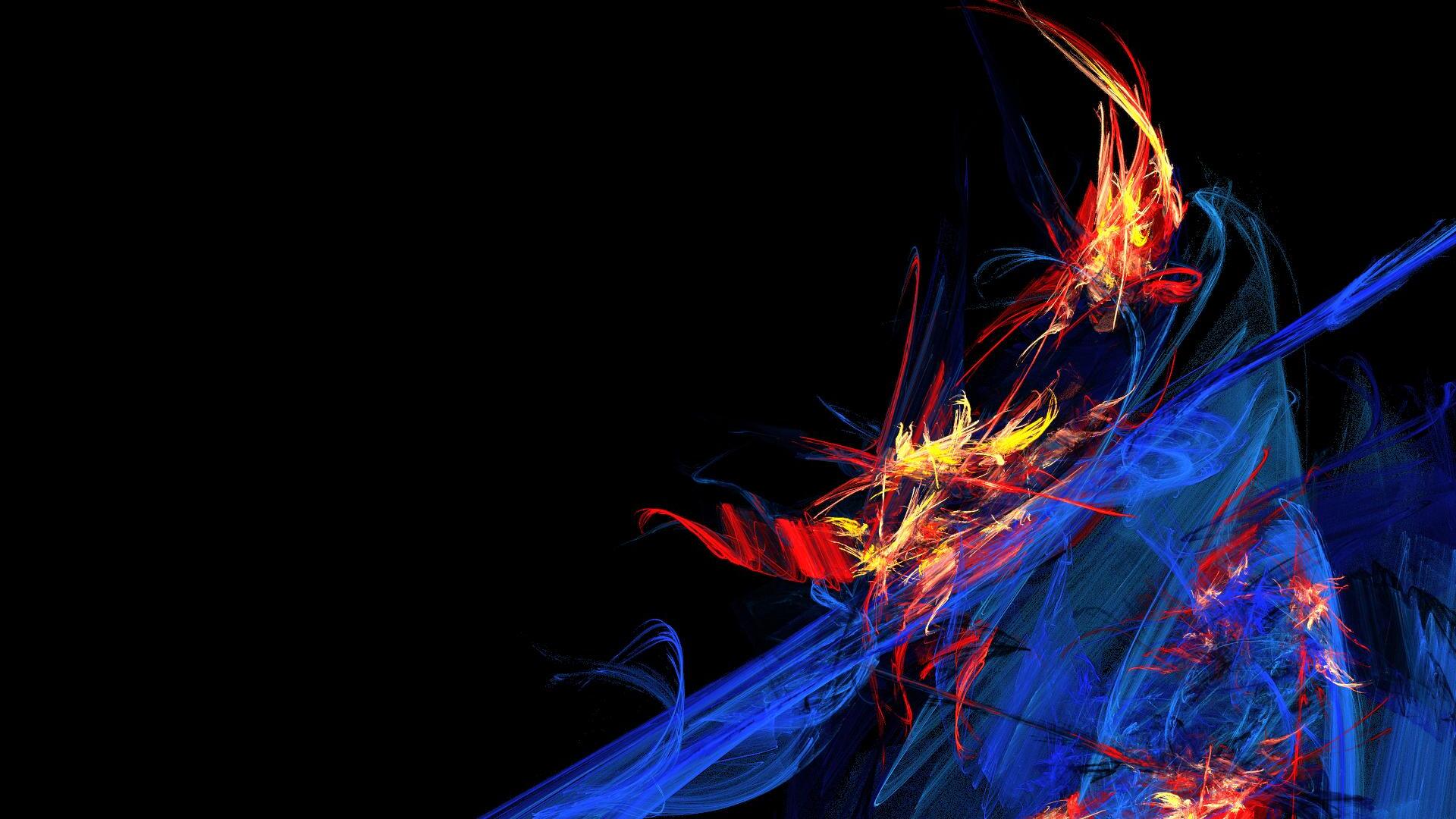

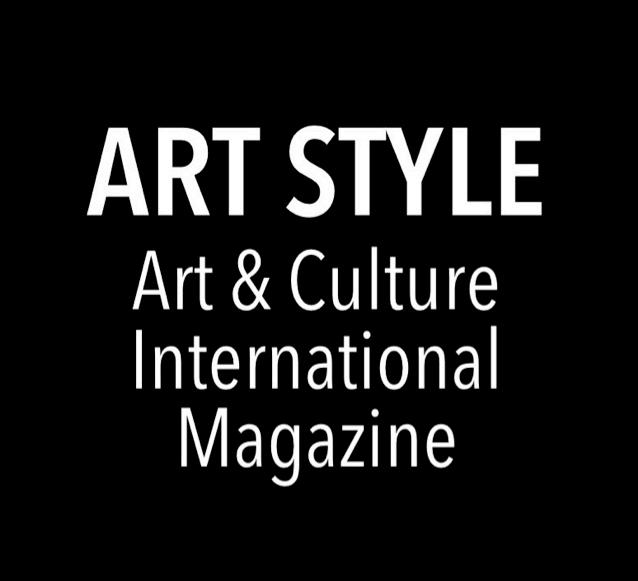

artstyle.international Volume 1 2 | Issue 1 2 | September 20 2 3













































































